This annual report details the Ministry of Personnel, Public Grievances and Pensions’ activities and achievements from April 2021 to March 2022. It covers major initiatives, personnel policies, cadre management, training programs, international cooperation, and the functioning of various departments and subordinate organizations. Key highlights include efforts to enhance governance, streamline public services, promote digital initiatives like e-governance and the iGOT Karmayogi platform, and address public grievances. The report also details financial management, legal frameworks, and the use of Hindi in official work. It emphasizes the Ministry’s commitment to transparency, accountability, and citizen-centric service delivery.
SOURCE PDF LINK :
Click to access AR%202021-22%20English.pdf
Click to view full document content
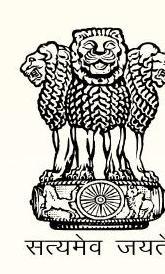
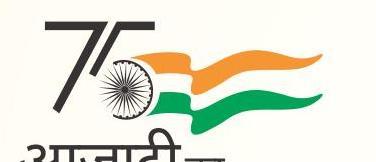
ANNUAL REPORT 2021-22
MINISTRY OF PERSONNEL, PUBLIC GRIEVANCES AND PENSIONS GOVERNMENT OF INDIA
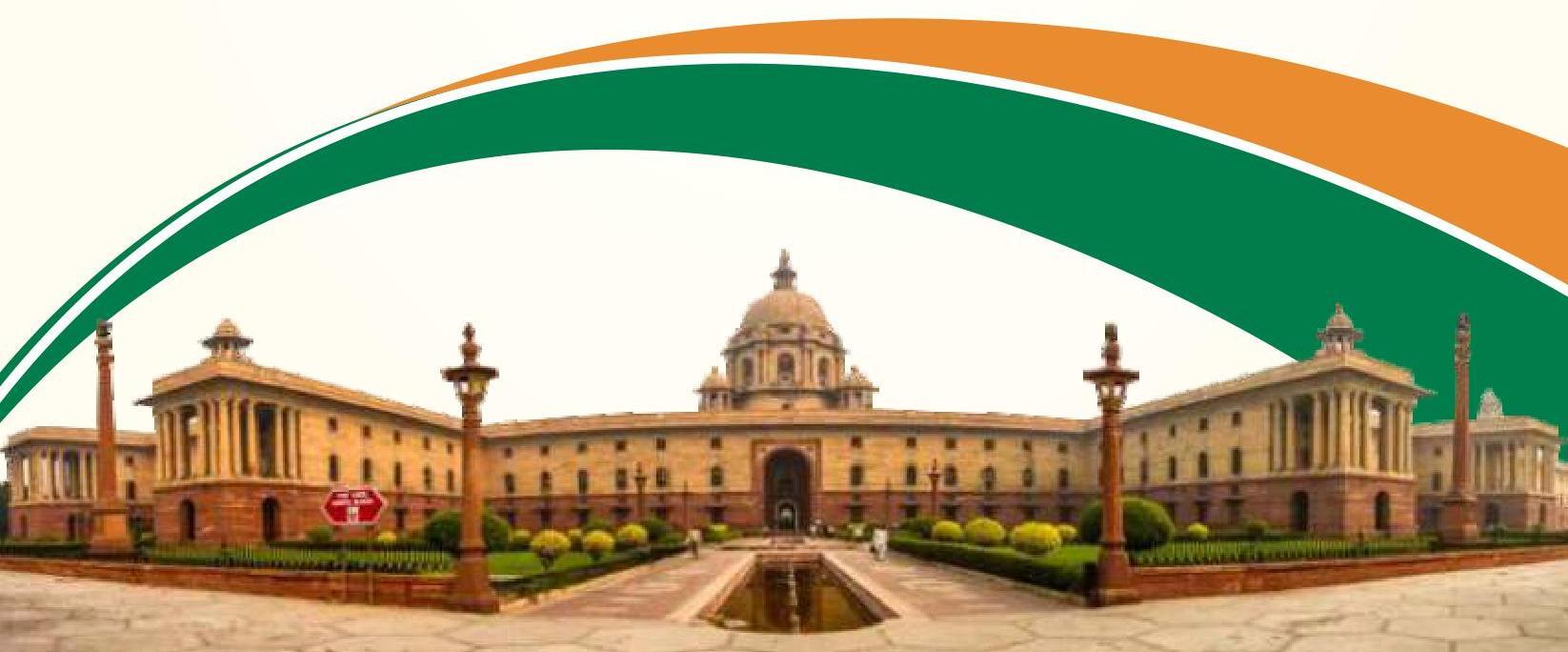
.
ANNUAL REPORT
2021-22
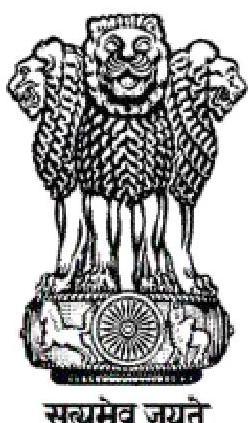
Ministry of Personnel, Public Grievances and Pensions
Government of India
.
CONTENTS
List of chapters Page Nos.
Vision and Mission ….. (i)
Executive Summary ….. (ii)
DEPARTMENT OF PERSONNEL AND TRAINING
1 Overview ….. 01
2 Major Initiatives/Achievements/Events during the year ….. 07
3 Personnel Policies ….. 17
4 Reservation in the Central Government Services ….. 33
5 Cadre Management ….. 38
a) Indian Administrative Service (IAS) ….. 38
b) Central Secretariat Service (CSS) ….. 45
c) Central Secretariat Stenographers’ Service (CSSS) ….. 49
d) Central Secretariat Clerical Service (CSCS) ….. 52
e) State Reorganization Division ….. 53
6 Senior Appointments under Government of India ….. 56
7 Training Policy and Programmes ….. 61
8 Training Institutions ….. 71
9 Mission Karmayogi & e-HRMS ….. 112
10 Administrative Vigilance Division ….. 121
11 International Cooperation ….. 128
12 Central Bureau of Investigation ….. 131
13 Joint Consultative Machinery ….. 154
14 Administrative Tribunals ….. 155
15 Staff Welfare ….. 160
16 Right to Information ….. 168
17 Proactive Disclosure ….. 172
18 Grievance Redressal Mechanism \& Citizens’ Charter ….. 176
19 Progressive Use of Hindi in Official Works ….. 178
20 Financial Management ….. 184
| 21 | DEPARTMENT OF ADMINISTRATIVE REFORMS AND PUBLIC GRIEVANCES | 190 |
|---|---|---|
| 22 | Administrative Reforms | 198 |
| 23 | Public Grievances | 207 |
| 24 | Organisation and Methods Division | 215 |
| 25 | E-Governance | 221 |
| 26 | International Exchange & Cooperation (IE\&C) | 229 |
| 27 | Documentation and Dissemination Division (D\&D) | 233 |
| 28 | Hindi Section | 240 |
| 29 | DEPARTMENT OF PENSIONS AND PENSIONERS’ WELFARE’ ANNEXURES | 241 |
| 30 | Department of Personnel and Training | |
| Annexure-I – Incumbency Position of Under Secretary level Officers and above in DoPT | 259 | |
| Annexure-II – Disposed Disciplinary Proceedings Cases | 263 | |
| Annexure-III – Disposed Sanction of Prosecution Cases | 264 | |
| 31 | Department of Administrative Reforms and Public Grievances | |
| Annexure-IV – National Awards for e-Governance 2020-21 | 269 | |
| Annexure-V – 24th National e-Governance Conference, 2022 (Hyderabad Declaration) | 272 | |
| Annexure-VI – Organisational Chart of DARPG | 275 | |
| Annexure-VII – Incumbency position of Under Secretary level officers and above in DARPG | 276 | |
| Annexure-VIII – Prevention of Sexual Harassment of Women at Workplace | 277 | |
| Annexure-IX – Welfare of SC, ST, OBC and Person with Disability (PWD) | 278 | |
| 32 | Department of Pensions and Pensioners’ Welfare | |
| Annexure-X- Organisation Chart | 279 | |
| Annexure-XI – Incumbency Position of Group ‘A’ officers in D/o PPW | 280 |
Ministry of Personnel, Public Grievances and Pensions Department of Personnel & Training
Vision
To create an enabling environment for the development and management of Human Resources of the Government for efficient, effective, accountable, responsive and transparent and ethical governance.
Mission
Development and management of government personnel by attracting the best talent, providing excellent career advancement opportunities, encouraging competence and innovation, adopting a dynamic framework of personnel policies and procedures, ensuring capacity building at all levels, inculcating and supporting a culture of transparency, accountability and zero tolerance of corruption in public affairs, and institutionalizing a system of continuous and constructive engagement with stakeholders to make the public services in India more efficient, effective, accountable and responsive.
.
The Ministry of Personnel, Public Grievances and Pensions is the nodal Ministry responsible for personnel matters, especially in respect of issues concerning recruitment, training, career development, staff welfare, and the post-retirement dispensation. The Ministry also works towards the promotion of responsive, people-oriented, and modern administration.
The Ministry comprises three Departments:
(i) Department of Personnel and Training (DoP&T)
(ii) Department of Administrative Reforms and Public Grievances (DARPG)
(iii) Department of Pensions and Pensioners’ Welfare (DPPW)
DEPARTMENT OF PERSONNEL AND TRAINING (DOPT)
Various wings of DoP\&T are as under:
- Establishment Officer (EO) Wing
- Services \& Vigilance (S\&V) Wing
- Establishment (Estt.) Wing
- Training (Trg.) Wing
- Administration Wing
The Establishment Officer Wing deals with the matter relating to senior appointments under the Government of India requiring approval of the ACC.
The Services \& Vigilance Wing handles matters relating to Administration of Rules on all the service matters in respect of All India Services and acts as the nodal agency in the arena of vigilance and anti-corruption. This wing in addition to governing the implementation of the RTI Act, also handles the administrative matters relating to the Administrative Tribunals and Central Information Commission. This wing also handles the work related to Cadre Restructuring in respect of the other Central Services.
The Establishment Wing is responsible for framing and revising rules and regulations regarding service conditions of the employees and personnel policies of the Central Government employees other than All India Service Officers. This wing handles the work related to Reservation Policy of the Government, Joint Consultative Machinery (JCM) and Civil Services Officers’ Institute (CSOI). This wing also looks after the work related to the allocation of State cadre employees consequent upon the reorganization of the States and Redeployment and Retraining of surplus Staff of various Central Government Organisations.
The Training Wing acts as the nodal agency for training of Government functionaries and is primarily responsible for formulating policies regarding training.
Administration Wing deals with the matters related to Cadre Management of the Central Secretariat Service, Central Secretariat Stenographers’ Service and the Central Secretariat Clerical Service. This wing also handles the administrative matters relating to the State Reorganization, and Welfare Activities for benefit of the employees of the Government except for CSOI.
The Department of Personnel and Training also handles the administrative work relating to the following Institutions: –
- Union Public Service Commission
- Central Vigilance Commission
- Lokpal
- Central Administrative Tribunals
- Central Information Commission
- Central Bureau of Investigation
- $\quad$ Staff Selection Commission
- Public Enterprises Selection Board
- Lal Bahadur Shastri National Academy of Administration
- Institute of Secretariat Training and Management
- Capacity Building Commission
- National RecruitmentAgency
- Karmayogi Bharat – Special Purpose Vehicle
DEPARTMENT OF ADMINISTRATIVE REFORMS & PUBLIC GRIEVANCES
The Department of Administrative Reforms and Public Grievances is the nodal agency of the Government of India for administrative reforms as well as redressal of public grievances relating to the States in general and those pertaining to the Central Government agencies in particular. The Department endeavours to document and disseminate successful governance practices by way of audio-visual media and publications. The Department also undertakes activities in the field of international exchange and cooperation to promote public service reforms. There are 7 Divisions in the Department namely Administrative Reforms, Organization \& Methods, e-Governance, Documentation \& Dissemination, International Cooperation, Administration \& Coordination and Public Grievances.
DEPARTMENT OF PENSIONS AND PENSIONERS’ WELFARE
The Department of Pension \& Pensioners’ Welfare was set up in 1985 as part of the Ministry of Personnel, Public Grievances and Pensions to formulate policy and coordination of matters relating to retirement benefits of Central Government employees (except Defence, Railway and Post \& Telecommunication).
OVERVIEW
1.0 The Ministry of Personnel, Public Grievances and Pensions acts as the formulator of policies pertaining to recruitment, regulation of service conditions, and deputation of personnel besides advising all organizations of the Central Government on issues pertaining to personnel management. The Organizational chart of the Department is on the next page.
Major Initiatives/Achievements/ Events during the year (Chapter 2)
1.1 Major Initiatives/Achievements during the period of April 2021 – March 2022 have been brought out in Chapter 2.
Personnel Policies (Chapter 3)
1.2 The Department is responsible for framing rules and regulations governing service conditions including recruitment rules, promotions and seniority, Flexible Complementing Scheme, Leave Travel Concession, deputation and Leave of employees. Personnel are recruited for the Central Government by the Union Public Service Commission through competitive examinations conducted by them for appointments to higher civil services and through the Staff Selection Commission of non-gazetted staff in Group ‘B’ & ‘C’ categories.
Reservation (Chapter 4)
1.3 In order to achieve the objective of upliftment and welfare of the Scheduled Castes and Scheduled Tribes, Other Backward Classes and Persons with Disabilities and Economically Weaker Sections (EWS); the Department frames policies to provide reservation to these groups in various Central Government services
and for monitoring its implementation.
Cadre Management (Chapter 5)
1.4 This Department is responsible for the management of the cadres of All India Services (AIS) (IAS, IPS, and IFoS) and all three Secretariat Services namely Central Secretariat Services (CSS), Central Secretariat Stenographers’ Services (CSSS) and Central Secretariat Clerical Services (CSCS). In addition, this Department frames and revises Rules and Regulations regarding conditions of the All India Services, such as Indian Police Service (IPS) and Indian Forest Service (IFS), in consultation with the Ministry of Home Affairs and Ministry of Environment, Forest and Climate Change respectively. This Department is also responsible for the cadre review of 66 existing Central Group ‘A’ Services/ Cadres periodically.
Senior Appointments under the Government of India (Chapter 6)
1.5 The Department deals with appointments at senior level and personnel policies of the Government of India. All proposals for senior appointments under the Government of India, which require the approval of the Appointments Committee of the Cabinet (ACC), are processed by the Department. These include board-level appointments to Central Public Sector Undertakings and appointments under the Central Staffing Scheme for posts of Joint Secretary, Director, and Deputy Secretary in Ministries /Departments. In addition, all appointments by promotion, which require the approval of the ACC, are also processed by the Department.
Organisation Chart for Department of Personnel & Training
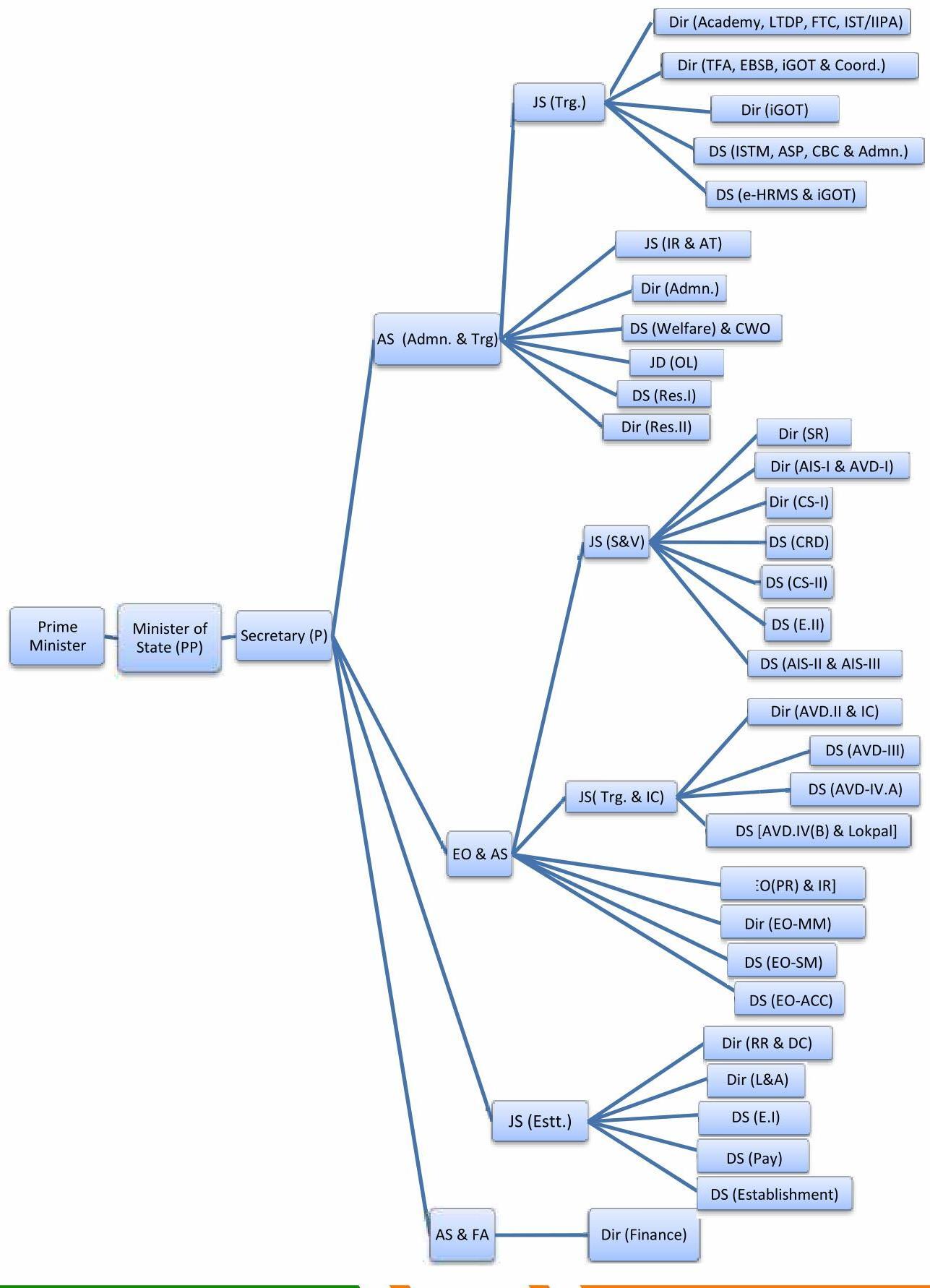
| Abbreviations Used in the Organization Chart | |
|---|---|
| ACC | Appointments Committee of Cabinet |
| AVD | Administrative Vigilance Division |
| ADMIN | Administration |
| AIS | All India Services |
| AS | Additional Secretary |
| B&A | Budget \& Accounts |
| CS | Central Secretariat |
| CPC | Central Pay Commission |
| CRD | Cadre Review Division |
| CWO | Chief Welfare Officer |
| DFFT | Domestic Funding of Foreign Training |
| DS | Deputy Secretary |
| DIR | Director |
| E | Establishment |
| EO | Establishment Officer |
| IR | Information Rights |
| JS | Joint Secretary |
| JCA | Joint Consultative Machinery and Arbitration |
| LTTP | Long Term Training Programme |
| L\&A | Leave and Allowances |
| MOS | Minister of State |
| MM | Middle Management |
| PR | Personal Records |
| PIIA | Pathways for an Inclusive India Administration |
| PESB | Public Enterprises Selection Board |
| PP | Personnel \& Pension |
| RES | Reservation |
| R\&R and DC | Redeployments \& Retraining and Departmental Council |
| S\&V | Services \& Vigilance |
| S | Services |
| SM | Senior Management |
| SR | State Reorganization |
| TRG | Training |
| V | Vigilance |
Training Policy and Programmes (Chapter 7)
1.6 The Department is the nodal Department to impart training to the government functionaries. The Training Wing of the Department formulates policies and implements its training programmes by identifying areas of training, designing training programmes, development of trainers and training capabilities and administering policies in training. Major training activities undertaken during the year are (i) In-service training of AIS/CSS/CSSS officers (ii) Mid-Career Training of IAS Officers (iii) Domestic Funding of Foreign Training (iv) Post Graduate Programmes in Public Policy / Sustainable Development/Management (v) State Category Training Programme (SCTP); (vi) Trainer Development Programme (TDP); (vii) Intensive Training Programme (ITP); (viii) 12Day Induction Training Programme (12-Day ITP); (ix) Comprehensive Online Modified Modules for Induction Training (COMMIT); (x) Augmentation of the Capacity of Training Institutions (ACTI); (xi) e-governance initiatives; (xii) Integrated Government Online Training Programme (i-GOT); and (xiii) National Programme for Civil Services Capacity Building (NPCSCB)- Mission Karmayogi.
Training Institutions (Chapter 8)
1.7 Lal Bahadur Shastri National Academy of Administration (LBSNAA), Mussourie, Uttarakhand and Institute of Secretariat Training and Management (ISTM), New Delhi are two premier training institutions, attached to this Department. These institutes cater to the needs of human resource development by imparting training to all officers of Central Government and AIS at regular intervals for their career progression. The Department also supports the Indian Institute of Public Administration (IIPA) which is an autonomous organisation, in undertaking advance training programmes for administrators as well as
researchers on issues relating to public administration.
Mission Karmayogi & e-HRMS (Chapter 9)
1.8 National Programme for Civil Services Capacity Building (NPCSCB) – Mission Karmayogi has been approved by the Government on 02/09/2020. The programme aims to inculcate behavioral and functional competencies needed by a government official at any position and equip his/her with all knowledge needed to best discharge his/her duties. It will create equitable access to world class learning to all government officials, across various cadres and geographies.
The program democratizes professional growth of a government official and will enable an official to chart his/her own career trajectory. An official can pursue competencies which align to his/her personal interests or professional aspirations, build demonstrable expertise in the said competencies and request a career progression which aligns to those competencies.
Administrative Vigilance Division (Chapter 10)
1.9 The Department is the nodal agency responsible for the formulation and implementation of vigilance and anticorruption policies of the Government. Administrative Vigilance Wing in the Department oversees government programme for maintenance of discipline and eradication of corruption from public service. The Central Vigilance Commission (CVC) advises the Central Government on all vigilance matters. The jurisdiction of the Commission extends to all the organisations to which the executive powers of the Union of India extend.
International Cooperation (Chapter 11)
1.10 The Department of Personnel and Training is the nodal Department for formation of policies for anti-corruption in Government of India. To deal with international cooperation on these aspects an International Cooperation Cell was created in this Department. The primary tasks of this Cell emanate from the follow up to the ratification of the United Nations Convention Against Corruption (UNCAC) and the other consequential international collaborative efforts, on global platforms. This Cell acts in conjunction with specialized agencies like the Central Bureau of Investigation, the Enforcement Directorate and the other line Ministries entrusted with the specific ancillary tasks within their respective administrative domain, viz. corporate governance, extradition matters, prevention of money laundering, mutual legal assistance treaties etc.
Central Bureau of Investigation (Chapter 12)
1.11 Central Bureau of Investigation (CBI) was set up by the Government of India by a Resolution dated April 1, 1963, to not only investigate cases of bribery and corruption but also the cases of violation of central fiscal laws, major frauds relating to Government of India Departments, Public Joint Stock Companies, passport frauds and serious crimes committed by organized gangs and professional criminals. CBI was further strengthened by the addition of Economic Offences Wing by the Government of India by Resolution dated February 2, 1964.
Joint Consultative Machinery (Chapter 13)
1.12 The Government provides for a Joint Consultative Machinery for joint consultation at three levels between the Central Government and its employees for promoting harmonious relations and securing the optimum level of co-operation between the Central Government and
its employees in matters of common concern. The objective is to increase the efficiency of public services along with the well-being of the employees. The three tiers are:
a) National Council – at the apex level, functioning under the Department of Personnel and Training.
b) Department Councils – functioning at the level of the Ministries / Departments.
c) Office Councils – functioning at offices/organisations under various Ministries / Departments.
The Scheme has proved to be an effective forum for amicable settlement of grievances of the Central Government employees relating to their service matters etc.
Administrative Tribunal (Chapter 14)
1.13 In order to provide speedy and inexpensive justice delivery system to the employees who feel aggrieved by Government decisions, the Government set up the Central Administrative Tribunal (CAT) in 1985, which now deals with all cases relating to service matters. The CAT has 19 regular benches, 17 of which operate at the Principal seats of High Courts and the remaining two are at Jaipur and Lucknow.
Staff Welfare (Chapter 15)
1.14 The Central Government being the largest single employer in the country discharges its responsibility for looking after the welfare of employees through various welfare measures. The Department also extends support to various staff welfare measures. The DoPT is the nodal Department for registered societies set up for the welfare of the Government employees and their families. In addition, the Department lays down policies for Departmental
Canteens and supports the Resident Welfare Associations.
Right to Information (Chapter 16)
1.15 The Department has brought out a comprehensive law to ensure the right to information to the citizens of India in almost entire matters of governance at all levels from the Central Government to the local selfgovernment. The Law (RTI Act, 2005) has provided a mechanism where the Central Information Commission, being the apex body at the Centre, facilitates its citizenry in accessing information in a time-bound, hassle-free and affordable manner.
Grievance Redressal Mechanism & Citizens’ Charter (Chapter 17)
1.16 The Department has identified some of the core services being offered by its various divisions and their standards for the purpose in its first Citizen Charter. This has been undertaken by a Task Force in consultation with the Stakeholders. While identifying the services, the focus has been on measurable and verifiable services and their standards. The charter contains a Grievance Redress Mechanism related to the services mentioned in the Citizens’/Clients’ Charter. The Charter also provides links for other grievances which are not related to the Citizens’/Clients’ Charter. Timelines have been prescribed for final disposal of the complaint arising out of the Citizens’/Client’s Charter.
Progressive Use of Hindi (Chapter 18)
1.17 The Department is fully committed to promoting the use of Hindi as the official language, in official matters and motivate compliance of the provisions of the Official Language Act, 1963, and the rules framed thereunder. The Department also ensures that the spirit of various orders and guidelines issued by the Department of Official Language is appropriately enforced for implementation of the official language policy of the Union. The Department has an Official Language Division which monitors the implementation of the Official Language policy in the Department.
Financial Management (Chapter 19)
1.18 For carrying out the work allocated to the Ministry of Personnel, Public Grievances and Pensions, an allocation of Rs. 112.37 crore was made in the Central Sector Scheme Outlay for the year 2020-21 against the total allocation of Rs. 1780.00 crore at the Revised Estimate 2020-21 stage. The corresponding figures for RE 2021-22 are Rs. 149.00 crore as Central Sector Scheme Outlay against a total allocation of Rs. 1950.00 crore (RE 202122). The requirements and priorities of its attached and subordinate offices were kept in view while making budgetary allocation to them by this Department. No PAC/ C\&AG Para is pending in the Ministry.
CHAPTER
Measures taken to contain the spread of 2nd wave of COVID-19 epidemic
2.1 Issued appropriate advisories regarding preventive steps to be taken immediately to contain the spread of COVID-19.
2.2 Mandatory use of AAROGYA SETU App for employees to attend office.
2.3 Operation of Departmental Coordination Unit for essential services related to Department.
2.4 Regular sanitization/disinfection of all the office Rooms area and surface, as well as corridors of this Department.
2.5 Purchasing of Face Mask, Surgical Gloves, Face Shields, PPE Kit, Rubber Gloves, UV File Sanitizer Machine, oximeter, automatic thermo temperature Machine, automatic hand sanitizer machine, hand-rub sanitizer and floor sanitizing liquid etc for use of this Department.
2.64 Oxygen Concentrations were purchased for emergency use of employees and their dependents.
2.7 Constitution of Surveillance Team for containment of Covid-19 in DoPT.
2.8 Organized periodical RT-PCR Tests for employees of this Department in association with NCDC.
2.9 A WhatsApp (We Care) Group has been created for regular counselling and providing necessary assistance to the employees of DoPT those are found Covid-19 Positive.
2.10 A WhatsApp Group was also created for other employees of this Department for their help and emergency needs.
2.11 Provision of Glass Partition has been made for workstations and plastic sheet partition to separate the driver seat in official Cars.
2.12 Proper arrangements made to ensure that employees are socially distanced while sitting at their work place.
2.13 Maintenance of record of Covid-19 Positive employees of this Department and regularly interacting with them through phone call.
2.14 Covid Vaccination Drive has been started for employees of this Department at work place i.e. North Block in association with MHA.
2.15 iGOT COVID-19 courses are being provided on DIKSHA platform of M/o Education to provide training to the COVID frontline workers to efficiently handle the Covid-19 pandemic.
2.16 On iGOT DIKSHA platform there are total 123 courses in five different languages (viz. English, Hindi, Marathi, Gujarati, and Bengali). Out of these 115 courses have been approved by respective Ministries/Departments/Organizations (MDOs) and more than 60 courses have been made live on the iGOT platform. In the first phase around 14 lakh users were trained on the portal. A total of around 20 lakhs course enrolments were done in 12 languages and 15 lakhs certificates were issued. In the second phase as on 9th January, 2022 a total of 63543 participants are registered. 43704 courses have been completed and 43692 certificates have been issued.
Anti Terrorism Day
2.17 On the occasion of Anti Terrorism Day, Secretary (P) led the pledge taken by employees of Department of Personnel and Training (DoPT), Government of India. Pledge was taken by employees through online mode and COVID appropriate behaviour was ensured.
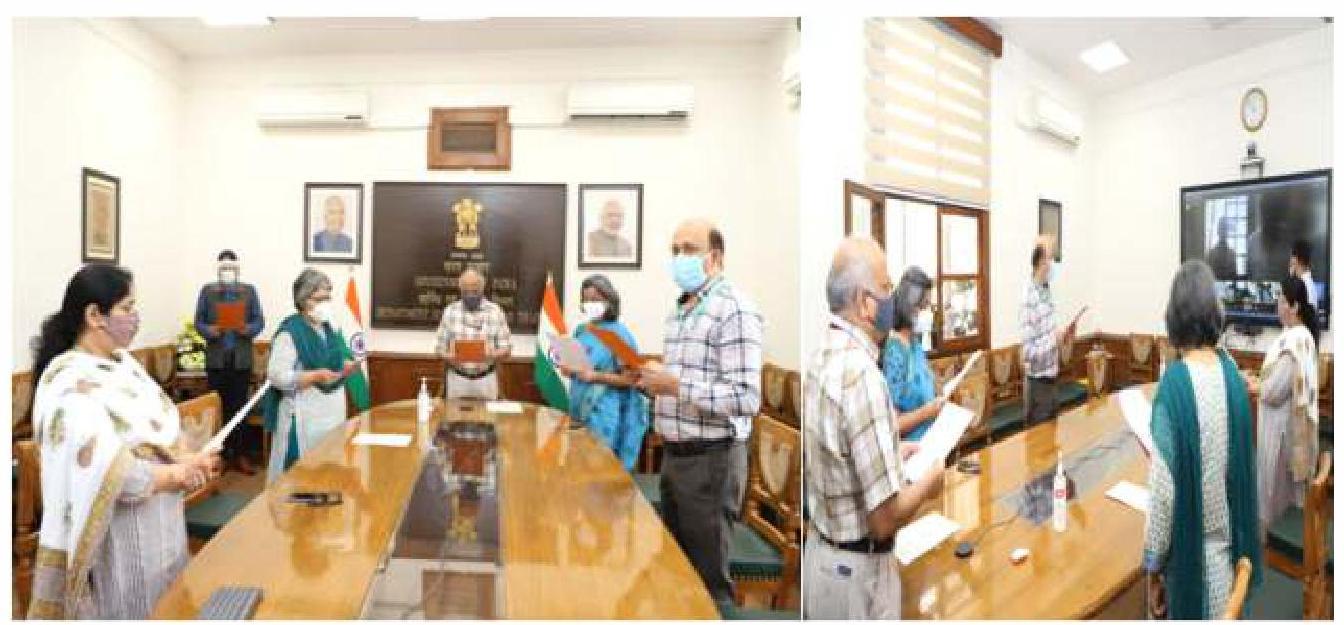
Celebration of Anti-Terrorism Day on 21st May 2021
COVID-19 Vaccination
2.18 Arrangements were made for the employees and family members of the Personnel and Training Department in the departmental canteen located in the North Block.
Hon’ble Minister of State for Personnel Dr Jitendra Singh reviewed the facilities available at the vaccination site and encouraged the serving medical personnel.
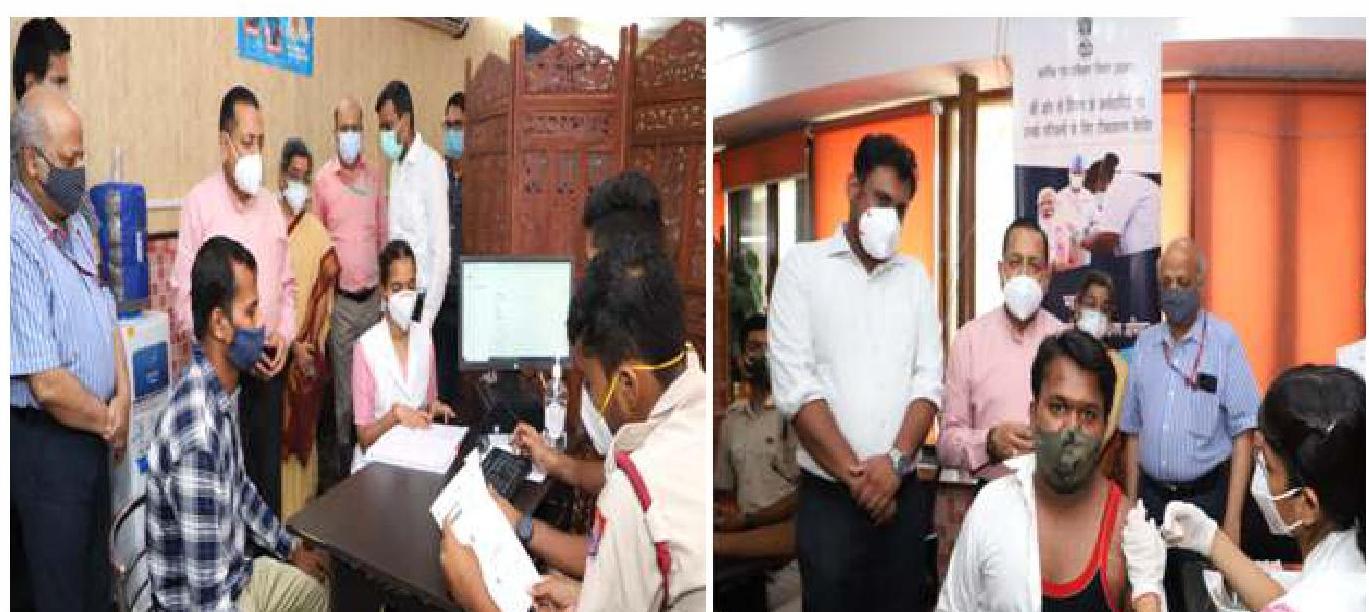
COVID Vaccination drive held at North Block on 15th June 2021
Celebration of International Yoga Day
2.19 The officers and employees of the department under the leadership of Dr. Jitendra Singh Hon’ble Minister of State for Personnel practiced Yoga with families at their respective residences on the occasion of International Day of Yoga.

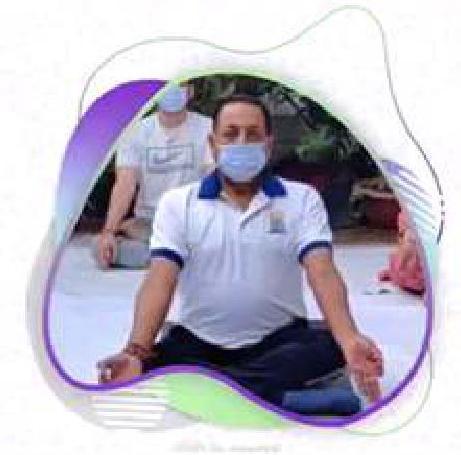
2.20 Officers/ Officials of DoPT cheered for the Indian atheletes participating in the Olympics.
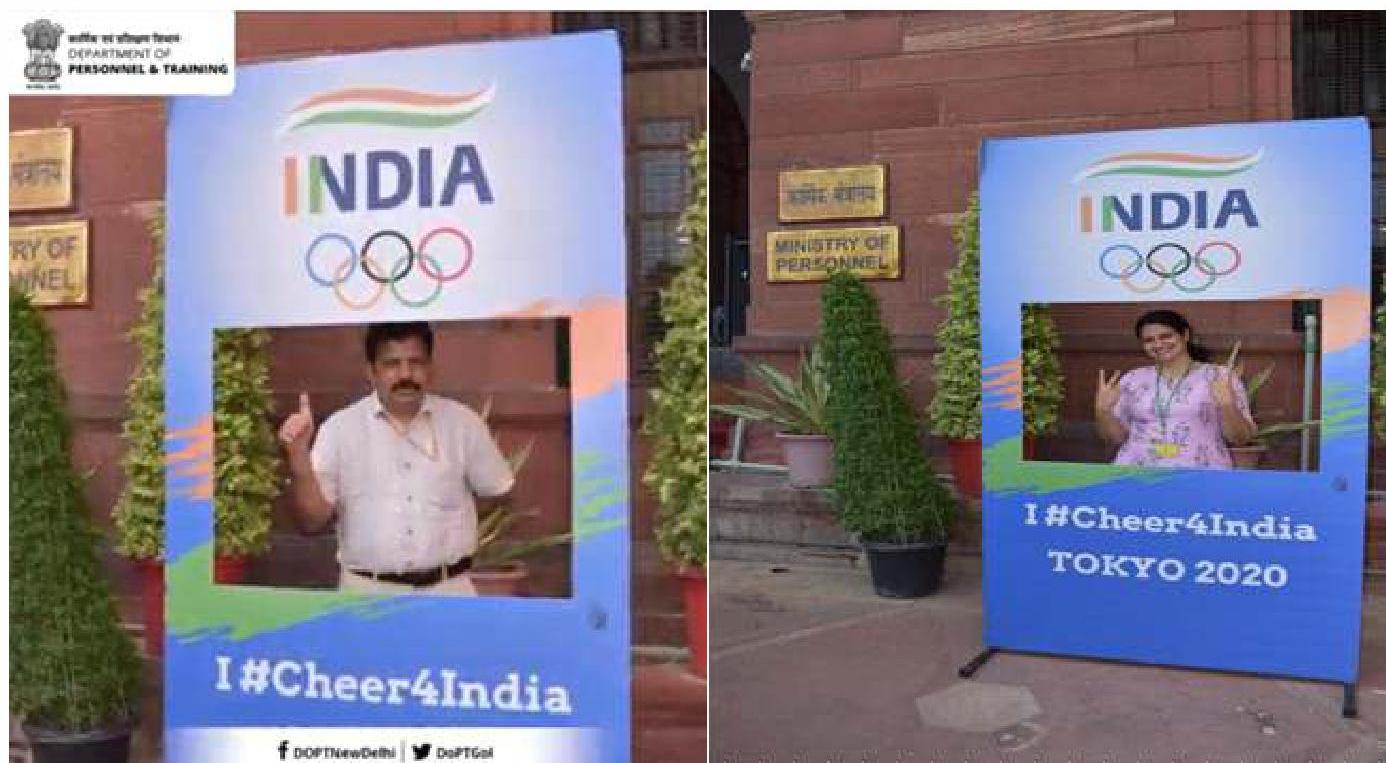
Cheer for India campaign held at North Block on 23rd June 2021
Azadi Ka Amrit Mahotsav
2.21 Employees of DoPT, on 13th August 2021 commemorated Azadi Ka Amrit Mahotsav by singing together the
National Anthem of India, evoking a feeling of pride and unity.
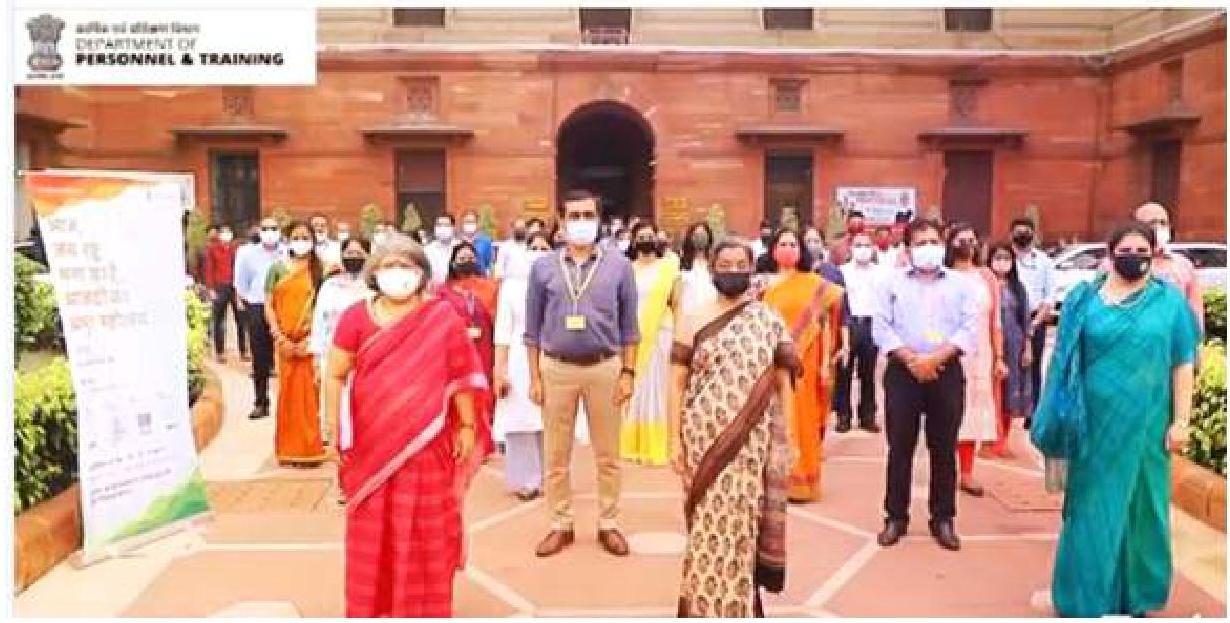
2.22 A 2-Day ‘Digital Exhibition’ on the life of Netaji Subhash Chandra Bose was organized on 24th September 2021, at the
North Block, New Delhi with the cooperation of Bureau of Outreach & Communications.
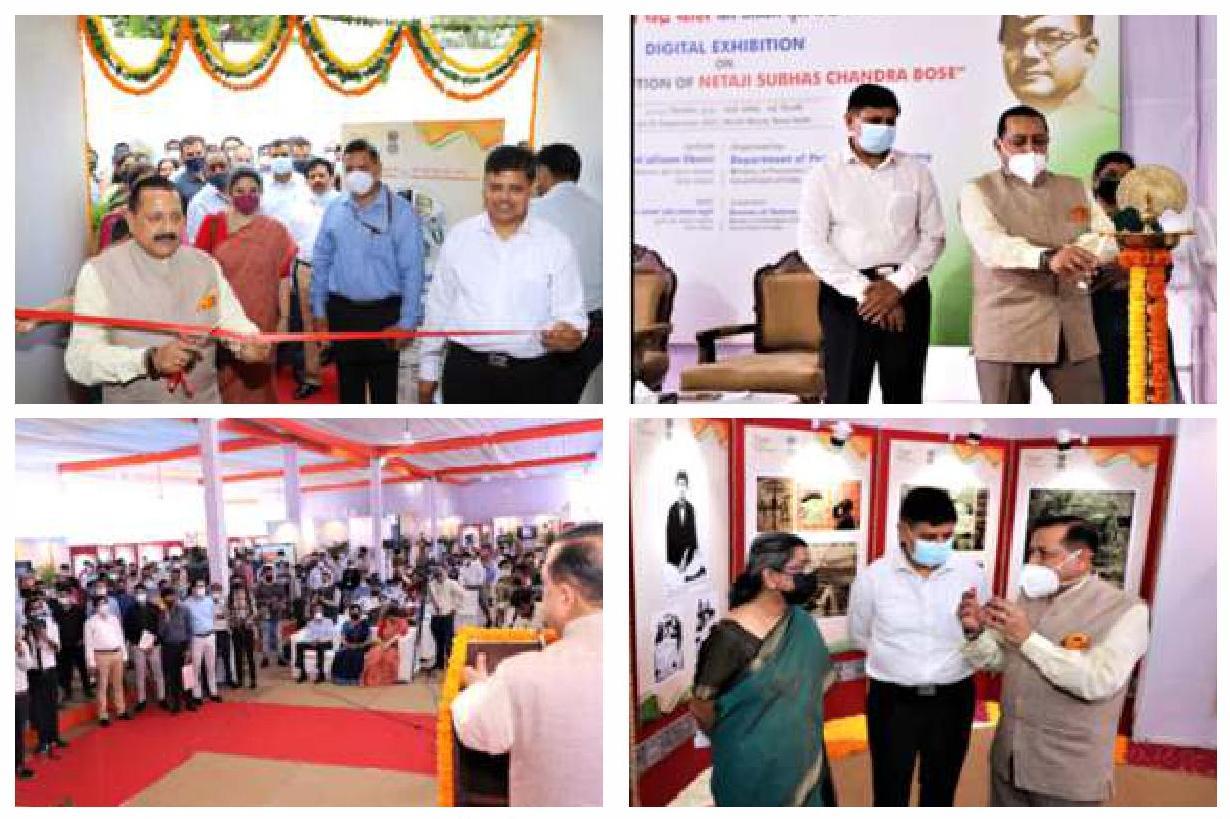
Dr Jitendra Singh, Hon’ble MoS (PP) inaugurating the Digital Exhibition on the life of Netaji Subhash Chandra Bose
Azadi Ka Amrit Mahotsav
2.23 A COVID-19 vaccination drive was organized on 25th September 2021 i.e. the second day of the “Digital Exhibition on the
Life & contribution of Netaji Shubash Chandra Bose” at North Block, New Delhi.
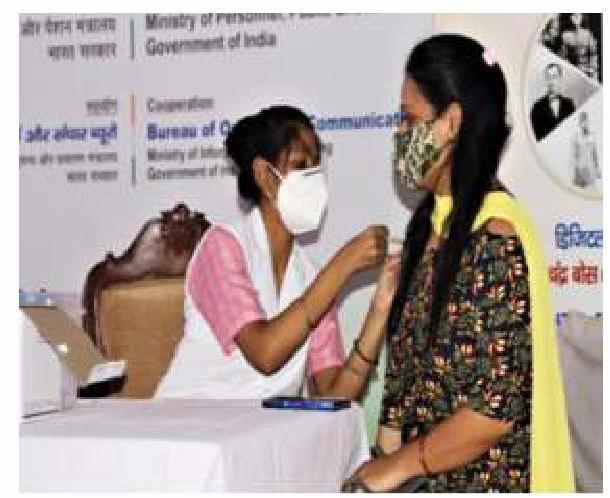
National Unity Day
2.24 On the occasion of National Unity Day, an essay competition was organized
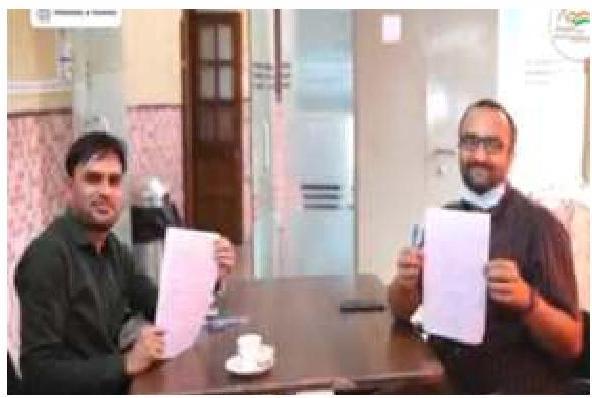
2.25 A slogan writing competition for the employees of DoPT was organized
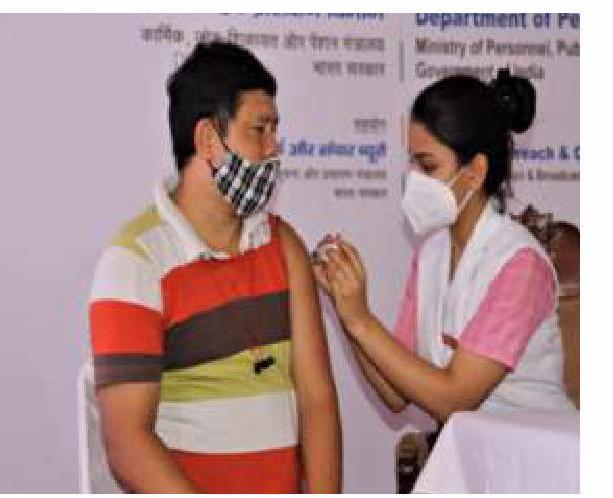
on 28th October, 2021 for officers and employees at DOPT, North Block.
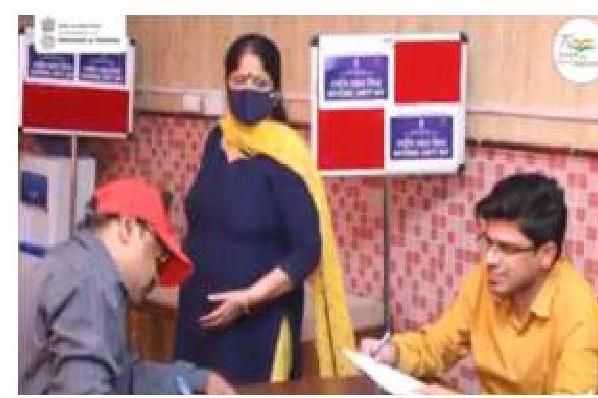
on 28th October 2021 on the occasion of Vigilance Awareness Week.
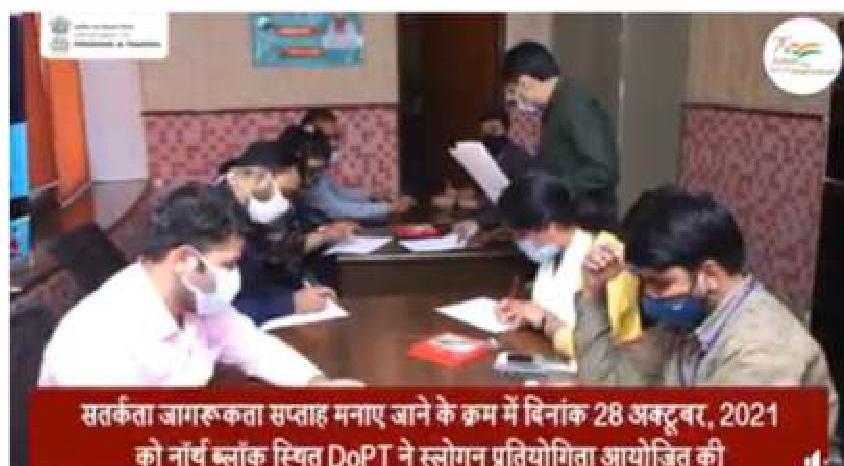
2.26 Armed Forces Flag Day was commemorated on 7th December 2021 at DoPT, North Block, New Delhi. On this
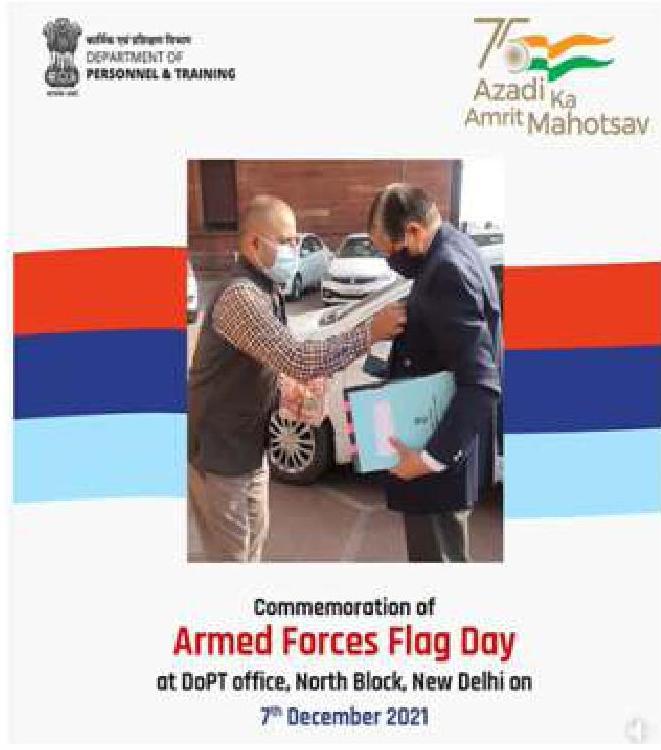
occasion DoPT officials raised donations at all the entry and exit gates of the North Block.
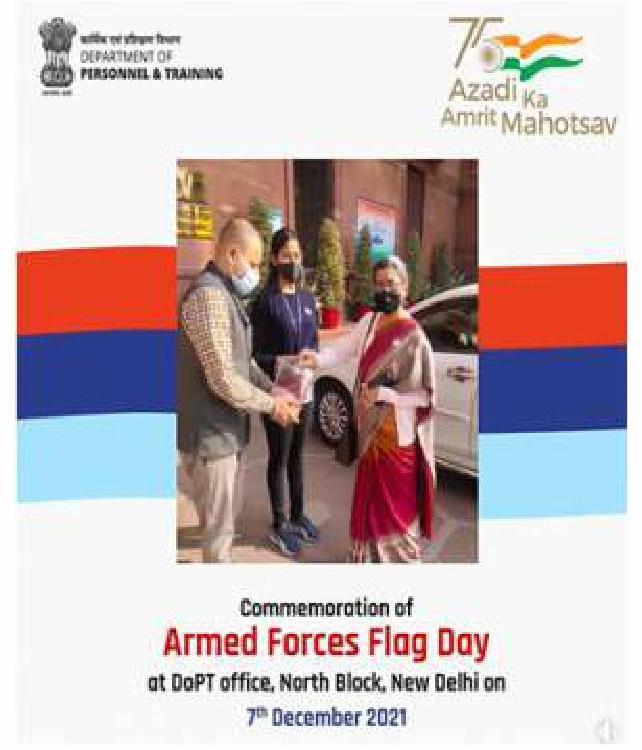
to review the efforts made by the Department to contain COVID-19.
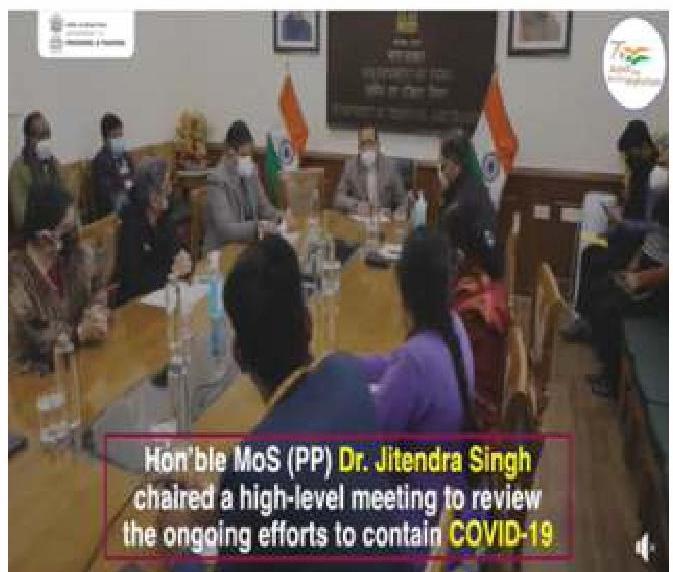
International Women’s Day
2.28 A webinar of one hour duration workshop on “Legal Rights of Women” to commemorate the International Women’s Day 2022
on 8th March 2022. Officers/ officials of this Department attended the workshop through video conferencing.
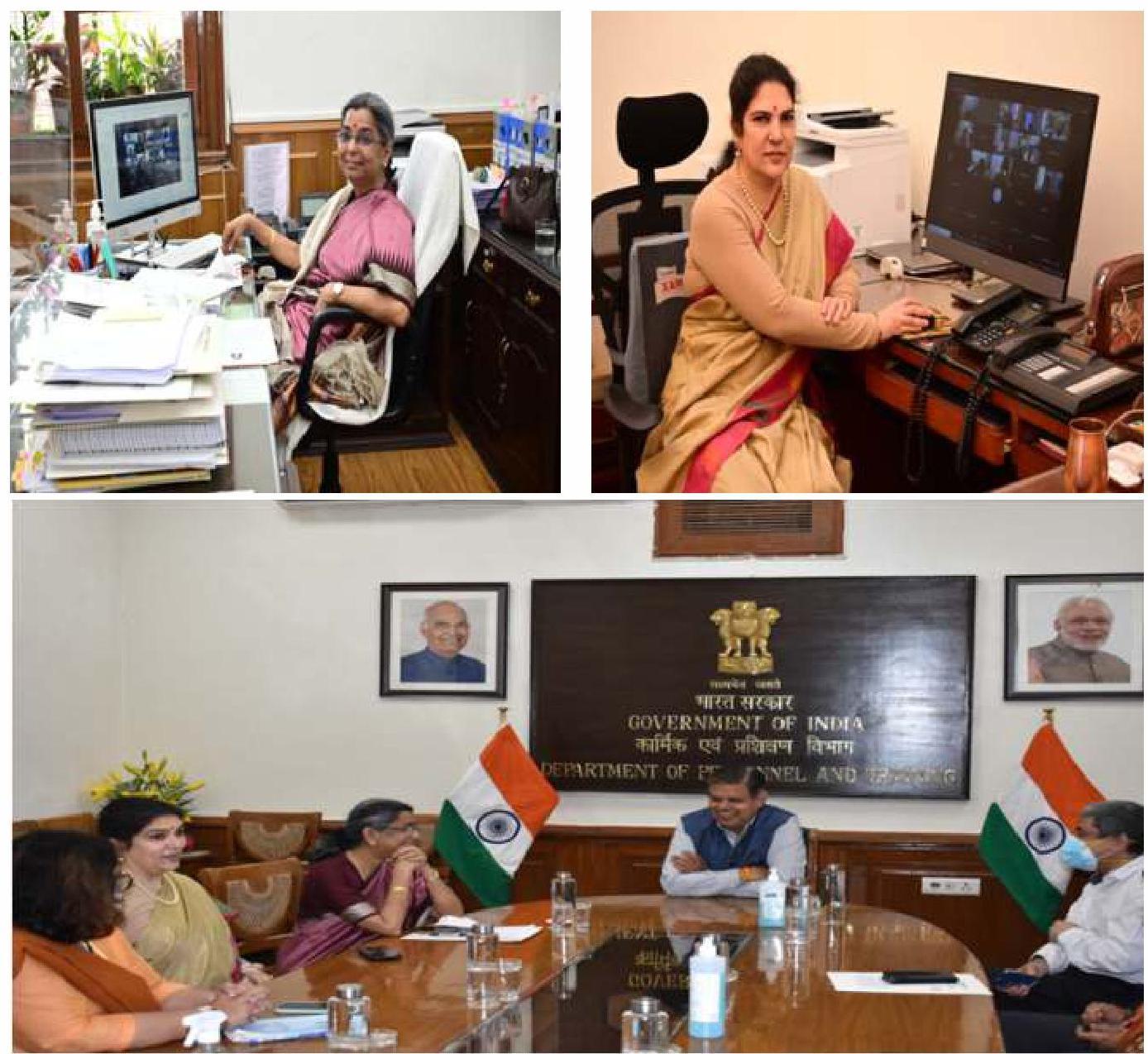
Sh. Pradip Kumar Tripathi, Secretary (P) meeting with the officials on the occasion of International Women’s Day
National Program for Civil Services Capacity Building (NPCSCB) – Mission Karmayogi
2.29 Union Cabinet on 2nd September 2020 approved the National Program for Civil Services Capacity Building (NPCSCB) Mission Karmayogi. Under NPCSCB, DoPT is taking steps to calibrate all civil services tasks to a Framework of Roles, Activities and Competencies (FRAC) to identify the behavioural, functional and domain
needs of each individual position in the government. An online learning platform (iGOT-Karmayogi) is also being developed that will allow the Departments to provide training resources and opportunities to their employees. NPCSCB has an overall budget of Rs. 510.86 Crore (including Taxes) to be spent over a period of 5 years (2020-2025). This includes technical assistance from the World Bank Group to the tune of 50 million USD in the form of loan.
2.30 The NPCSCB has the following Institutional Framework:
i. Prime Minister’s Public Human Resource Council
ii. Cabinet Secretariat Coordination Unit
iii. Capacity Building Commission
iv. Special Purpose Vehicle (SPV) under Section 8 of the Companies Act, 2013
- Achievements of Mission Karmayogi in 2021-22
i) Capacity Building Commission (CBC), an attached office of DoPT has been established on 01/04/2021. The composition of CBC is as under:
a. Shri Adil Zainulbhai, Chairperson
b. Shri R. Balasubramaniam, Member (HR)
c. Shri Praveen Pardeshi, Member (Admin)
d. Shri Hemang Jani, Secretary - The CBC has started functioning with requisite budget allocation and manpower at its new office located at Jawahar Vyapar Bhawan, New Delhi. Order for delegation of financial power for CBC has been issued with the approval of IFD. IFA has also been established in CBC.
- The core purpose of the Commission is to build credibility and shape a uniform approach to capacity building on a collaborative and co-sharing basis. CBC inter-alia is mandated to perform the following key functions:
a Preparing an Annual State of Civil Services Report
b Facilitating the creation of Annual Capacity Building Plans for Ministries and Departments
c Organising a global HR Summit
d Evolving a harmonious, de-siloed approach to capacity building initiatives
e Undertaking an audit of Human Resources available in Government. - Key activities taken up by the CBC are:
(a) The First Round Table for Central Training Institutions (CTIs) was organized by Capacity Building Commission (CBC) on 12th October 2021. The roundtable was attended by top management of 23 CTIs. The objective of the workshop was to kickstart collaboration activities amongst CTIs.
(b) CBC is currently in the process of pilot testing the Draft Functional Evaluation Framework for CTIs. The framework aims to introduce minimum standards as a means for continuous improvement of CTIs.
(c) CBC is looking to partner with competent Indian institutions with enhanced capabilities for faculty training so as to run faculty development programmes for CTIs.
(d) CBC is engaged in the facilitation of Annual Capacity Building Plans (CBPs) for 8 pilot Ministries and Departments – Ministry of Civil Aviation; Ministry of Food Processing Industries; Ministry of Social Justice & Empowerment; Ministry of Labour \& Employment; Department of Defence, Ministry of Defence; Logistics Division, Ministry of Commerce; Department of Expenditure, Ministry of Finance.
(e) The Commission is piloting with various citizen-facing agencies like Railways, Dept. of Post, Ministry of Youth Affairs (MoYA), BSNL, and UT Police Forces to co-develop short, self-paced digital modules focused on building behavioural competencies. The objective of this exercise is to help citizenfacing staff in Ministries/Departments to be proactive \& customer-oriented.
(f) CBC is preparing to launch an engagement survey covering 3.1 million civil servants (group A + B + C) to understand their outlook towards the current training \& capacity building ecosystem, their experience, and motivation levels.
(I) The experimental digital platform of the programme iGOT-Karmayogi has become functional on which various types of learning courses are being uploaded by the central and
other training institutions. 50 Ministries /Departments/CTIs have already been onboarded on iGOT platform along with 123 live courses for learners’ consumption. The Mission Karmayogi platform has gone live.
(iii) Outreach/ Briefing sessions were organized for content onboarding on iGOT Karmayogi platform in various identified Ministries/Departments implementing Flagship Schemes.
(iv) It has been decided to conduct a pilot exercise to test the Learner- on – boarding readiness in which 13 Ministries /Departments with an approx. user base of 6000+ employees have been shortlisted with the following criteria:
i. Ministries/Department which are onboarded both on e-HRMS and iGOT Karmayogi platform.
ii. Ministries/Departments which have created and on-boarded their content/courses on iGOT Karmayogi platform.
(v.) Helpdesk in the form of L1, L2 and L3 to deal with various issues pertaining to iGOT Karmayogi platform at different levels and troubleshoot them is being made functional.
(vi.) A Task Force was set up on 23.06.2021 to guide operationalization of the SPV. The subgroups under the SPV Task Force have given multiple recommendations as under which are being broadly examined by DoPT:
(a) Governance Working Group
(b) Technology Working Group
(c) Operations Working Group
(d) Content Working Group
(e) HR Working Group
(f) Finance Working Group
(vii) A Special Purpose Vehicle (SPV) has been incorporated on 31.01.2022 in the name of ‘Karmayogi Bharat’ under Section 8 of the Companies Act, 2013 as a 100% Government owned not for profit Company under
National Programme for Civil Services Capacity Building (NPCSCB)-Mission Karmayogi with the approval of the Government circulated vide O.M. No. F-16017/16/2020-iGOT dt. 21.01.2022. Certificate of Incorporation, PAN and TAN of the company has been obtained and the logo has also been finalized.
(viii) iGOT Karmayogi platform has been migrated and hosted on NIC cloud. Migration of courses and contents is under process.
(ix) A High-level Steering Committee under the Chairmanship of Secretary (P) has been constituted on 6th September, 2021 to have regular strategic discussions, progress review and providing guidance for project implementation with stakeholders of Mission Karmayogi.
(x) A Digital Learning Lab has been inaugurated on 27/08/2021 which will support the Ministries and Departments in development of their e-Content learning courses through its specialized manpower and infrastructure.
(xi) A Working Group under the Chairmanship of Joint Secretary (Training), DoPT for detailed deliberation on online courses/modules on Geographic Information System (GIS) under Mission Karmayogi has been constituted which will help use GIS for decision making which may in turn increase Country’s GDP by 2-3\%.
(xii) iGOT COVID-19 courses are being provided on DIKSHA platform of M/o Education to provide training to the COVID frontline workers to efficiently handle the Covid-19 pandemic. There are total 123 courses in five different languages (viz. English, Hindi, Marathi, Gujarati, Bengali). Out of these 115 courses have been approved by respective Ministries / Departments/Organizations (MDOs) and more that 60 courses have been made live on the iGOT platform. In the first phase around 14 lakh users were
trained on the portal. A total of around 20 lakhs course enrolments were done in 12 languages and 15 lakhs certificates were issued. In the second phase as on 9th January, 2022 a total of 63543 participants were registered. 43704 courses have been completed and 43692 certificates have been issued.
(xiii) A full day workshop on Mission Karmayogi- the Path Ahead was organized on 23rd December, 2021 at Bhim Auditorium, Dr. Ambedkar International Centre, New Delhi, as part of Azadi ka Amrit Mahotsav- Good Governance Week celebration. During the workshop, Pilot demo of the iGOT platform was given along with deliberation sessions on various themes spread over the day.
(xiv) Two Brainstorming Sessions on Mission Karmayogi were held under the Chairmanship of the Hon’ble MoS (PP) Dr. Jitendra Singh with Lal Bahadur Shastri National Academy of Administration (LBSNAA), Capacity Building Commission (CBC), Institute of Secretariat Training and Management (ISTM), Indian Institute of Public Administration (IIPA), National Centre for Good Governance (NCGG) and Training Division, DoPT on 13.09.2021 and 28.12.2021 respectively.
Smart Performance Appraisal Report Recording Window (SPARROW):
2.31 SPARROW is an online system based on the comprehensive performance appraisal dossier maintained for IAS officers. The system aims at bringing greater transparency in the recording of performance appraisals of the officers, eliminating loss of Performance Appraisal Reports (PARs) during transition, ensuring better monitoring and timely completion of PARs and providing easy and real time access to the PARs by authorized stakeholders. This system is not only user friendly but can be accessed uninterruptedly through an internet enabled computer system
from anywhere, anytime, which reduces the delays in processing of PARs by officer concerned. The system was launched with effect from 01.04.2014 and was initially linked to the intra-IAS database enabling the PAR form to be pre-populated with the existing information. Subsequently the responsibility to update the requisite details in respect of officers was passed on to the Employee Master Data (EMD) manager of the respective Ministry or Department / State Cadre. In order to make the system hassle-free and more user-friendly, the system has been enabled with eSign (electronic Signature), an Aadhaar based authentication service.
2.32 For ensuring recording of PAR in a timely manner by all the authorities, autoforwarding of PARs has been implemented videAIS(PAR)Amendment Rules, 2019.
2.33 As on 11.05.2022, the total number of the electronically generated PARs for the Assessment Year 2020-21 is 9202 and that of 2021-22 is 8553.
Immovable Property Returns(IPR) Module
2.34 As per Rule 16(2) of AIS (Conduct) Rules, 1968, IAS officers are required to submit IPRs every year as on 1st January and latest by 31st January of the year, in respect of the preceding year. Since the year 2011, the IPRs of the officers are being uploaded on the Department’s website. Subsequently, an IPR Module has been been introduced for filing the IPRs online by the officers w.e.f. 1.1.2017, the navigation tab of which has been provided in the menu on Home Page of SPARROW. The officers can access the Module by using the login ID and password, which are already provided to them for accessing the SPARROW and after filing the return; they are required to authenticate it by using either DSC or eSign.
CHAPTER
PERSONNEL POLICIES
- Matters relating to framing and amendment of recruitment rules/service rules for Group “A” and “B” posts
- Framing of policy relating to the procedure for Departmental Promotion Committee(s)
- Policy on seniority
- General policy matters relating to:-
(a) Flexible complementing scheme,
(b) Modified Assured Career Progression Scheme,
(c) Lateral entry in Central Government,
(d) Leave travel concession,
(e) Deputation,
(f) Leave,
(g) Pay & allowances,
(h) Holiday policy,
(i) Age relaxation and
(j) Other matters concerning service conditions. - Administration of UPSC and SSC including exams except for the Civil Service Examination
- Policy matters of PESB
- Policy on Character verification before an appointment
- Disagreement cases with UPSC from various Ministries except on appointment cases
- UPSC (Exemption from Consultation) Regulations
- Policy on APAR.
- Commercial employment after retirement
- Policy on
(a) Retirement, extension, re-employment,
(b) Posting and transfers, Conduct and CCARules,
(c) Sealed Cover procedure,
(d) Status of Women in Central Government,
(e) Temporary Service Rules, etc.
(f) Lien, Probation, Confirmation,
(g) Daily Wage Casual Labourers
Establishment (A-IV) Section
3.0 Reimbursement of cancellation /reschedule charges for air/train tickets booked for the purpose of LTC and relaxation of LTC advance due to COVID19 pandemic.
During Nation-wide Lockdown on account of Covid-19 pandemic in the months of March May, 2020, all domestic flights within India were cancelled but certain airlines had charged the cancellation charges against the pre-booked air tickets. Many airlines had not refunded the ticket amount for the air tickets booked in advance for the LTC journey scheduled during the lockdown period. These airlines had kept the booking amount with them in the form of ‘credit shell’ and had given the option to the passengers to travel within a year. This had caused undue hardships to the Government employees as the LTC advance along with penal interest, is required to be returned if the journey is not undertaken. In view of the financial hardships caused to Government servants, the Government had decided (i) to delegate to the Ministries /Departments the power to reimburse the cancellation/ reschedule charges of air/train tickets, as a one-time relaxation, to such Government servants who had booked advance air/train tickets for the purpose of LTC journey during the Lockdown period from 21.03.2020 to 31.05.2020 but were not able to perform the journey due to cancellation/rescheduling of flights/trains during that period. (ii) In cases where the airlines had kept the refund amount in ‘Credit Shell’, Ministries/Departments may extend the period of repayment of LTC advance taken by the Government servant for LTC journey scheduled during the lockdown period (March-May, 2020), till 30.11.2021 or till such time the amount in ‘Credit Shell’ is utilised by the Government servant to perform LTC journey, whichever is earlier. Also, penal interest may not be charged on amount taken by the Government servant on LTC journey scheduled during the lockdown period.
(iii) In cases where the Government servants had drawn LTC advance as well as leave encashment so as to perform the LTC journey, but could not perform journey during the lockdown period and later intended to opt for Special Cash Package Scheme in lieu of LTC in accordance with Department of Expenditure’s OM No. 12(2)/2020-E.II(A) dated 12.10.2020, they were also allowed to avail the facility of the Scheme. The LTC advance and leave encashment which had remained unsettled due to non-performance of the journey, was to be adjusted as per the provisions of the Special Cash Package Scheme.
(Reference DoPT’s O.M. No. 31011/1/2020-Estt.A-IV dated 07.01.2021, 05.02.2021 and 23.11.2021)
3.1 In the Fundamental Rules, 1922, in rule 56, in clause (d), for fifth proviso, the following shall be substituted, namely:-
“Provided also that the Central Government may, if it considers necessary in public interest so to do, give extension in service to the Defence Secretary, Foreign Secretary, Home Secretary, Director of Intelligence Bureau, Secretary of Research and Analysis Wing and Director of Central Bureau of Investigation appointed under the Delhi Special Police Establishment Act, 1946 (25 of 1946) and Director of Enforcement in the Directorate of Enforcement appointed under the Central Vigilance Commission Act, 2003 (45 of 2003) in the Central Government for such period or periods as it may deem proper on a case-tocase basis for reasons to be recorded in writing, subject to the condition that the total term of such Secretaries or Directors, as the case may be, who are given such extension in service under this rule, does not exceed two years or the period provided in the respective Act or rules made thereunder, under which their appointments are made.”
(Reference Notification G.S.R. 795(E) dated 15.11.2021 and subsequent modification vide Notification G.S.R.804(E) dated 17.11.2021) [F.No.25012/01/2021-Estt.A-IV]
Establishment (A-III) Section
3.2 Official dealings between the Administration and Members of Parliament and State Legislatures Observances of proper procedure.
The Members of Parliament and State Legislatures, as the accredited representatives of the people, occupy a very important place in our democratic set-up. In connection with their duties, they often find it necessary to seek information from the Ministries/Departments of the Government of India or the State Governments, or make suggestions for their consideration or ask for interviews with the officers. Ministry of Personnel, Public Grievances and Pensions have issued guidelines concerning official dealings between Administration and Members of Parliament and State Legislatures and reiterates these guidelines from time to time.
(Reference DoPT O.M. No. 11013/4/2018-Estt.A-III dated 15.03.2021)
3.3 Aid to processing of departmental proceedings under the CCS (CCA) Rules, 1965 – Simplification by way of preparing a Flow Chart regarding procedure to be adopted in disciplinary proceedings
It was observed that the Disciplinary Authorities, while processing the disciplinary cases under the Central Civil Services (Classification, Control and Appeal) Rules, 1965, sometimes fail to appreciate the vital procedural requirements/timelines provided under the said Rules, albeit unintentionally, which are required to be mandatorily followed to ensure justice and bringing the cases to logical conclusions. Non-conformity to the requirements as per the established rules also leads to intervention by the Courts on the ground of denial of proper opportunity to the Charged Officers for defending themselves appropriately and, consequently setting aside of disciplinary proceedings. Often, procedural lapses have also been noticed regularly in
various cases referred to this Department for advice. Thus, a Flow Chart has been made to indicate the various steps involved in the disciplinary cases in a simple form for better understanding of Rules in their application by the Disciplinary Authorities.
(Reference DoPT O.M. No.43020/14/2021
Estt. A-III dated 08.11.2021)
3.4 Guidelines for preventive measures to contain spread of COVID-19.
With a view to contain the spread of Novel Coronavirus (COVID-19), guidelines / advisories on preventive measures were issued from time to time, which included installation of Thermal Scanners and mandatory placing of hand sanitizers at the entry of Government buildings; cleaning and frequent sanitization of work-place; maintenance of social distancing; conducting meetings through video conferencing; facility to Work from Home for 50% of the staff initially and subsequently revising the percentage as per the gravity of spread of COVID-19; observing staggered timings; suspension of Biometric Attendance; curtailing of entry of outsiders/visitors; preparation of roster for attendance of employees; exemption from attending office by pregnant women employees and persons with disabilities; completion of disciplinary proceeding through Video Conferencing; closure of Departmental Canteen; effective use of ‘Aarogya Setu’ app for breaking the chain of transmission of COVID-19; commencement of meeting with messages on Covid-19 related precautions; vaccination of Government servants; etc.
(Reference DoPT O.M. No’s. 11013/9/2014Estt. A-III dated 06.04.2021, 19.04.2021, 22.04.2021, 03.05.2021, 06.05.2021, 12.05.2021, 28.05.2021, 14.06.2021, 01.11.2021, 16.11.2021, 03.01.2022, 31.01.2022 and 06.02.2022)
Establishment (Leave) Section
3.5 An O.M. was issued regarding Treatment / regularization of hospitalization/quarantine period during
COVID-19 Pandemic (O.M. No.
13020/1/2019-Estt.(L) dated 07.06.2021).
Establishment (Allowance) Section
3.6 As per O.M. issued on 1.7.2021 regarding relaxation of condition laid down in para 2(b) of this Department’s OM No.A27012/02/2017- Estt.(AL) dated 17th July, 2018, the Children Education Allowance (CEA) claims may also be considered through a self-certification made from the concerned employees or through printout of e-mail/SMS of result/report card/fee payment, in addition to the prescribed modes of claims only for the academic years ending March, 2020 and March, 2021. (O.M. No. A-27012/02/2017Estt.(AL) dated 01.07.2021).
3.7 Notification No.A-37013/01/2018Estt.(AL) published in the Gazette of India on 23.11.2021 stipulate that unless the President by special order otherwise directs, one third of any fees in excess of Rs.5000/- paid to a Government servant in a financial year shall be credited to the Consolidated Fund of India. Earlier ceiling limit of Rs. 1500 in this regard in SR 12 has been revised to Rs. 5000.
Establishment (Pay) Section
3.8 After the recommendations of the 7th CPC were implemented, the restrictions on treating an appointment as on deputation/foreign service provided in Para 3.4 of deputation guidelines issued vide OM No. 6/8/2009-Estt.(Pay-II) dated 17.06.2010 have been amended vide OM . No. 2/9/2018Estt.(Pay-II) dated 12.04.2021 According to the amended provisions, no appointment on deputation/foreign service shall be made from/to Central Government/an organization where the scale of pay and DA pattern in the parent cadre post and ex-cadre post are dissimilar, if the basic pay in the parent cadre increased by one increment plus dearness allowance(s) including interim relief if any, admissible to a person in the parent cadre post exceeds the basic pay plus dearness allowance(s) including interim relief, if any, at
the maximum of the pay level in the pay matrix/pay scale of the ex-cadre post.
3.9 On receipt of queries from various Ministries/Departments, detailed clarifications have been issued vide OM No. 2/12/2016Estt.(Pay-II) dated 21.01.2021 on method of protection of pay in cases of deputation under Central Staffing Scheme in terms of Rule 12 of Central Civil Services (Revised Pay) Rules, 2016 (7th CPC).
3.10 Following implementation of the recommendations of the 7th Central Pay Commission, the provisions of Para 5 of consolidated guidelines on deputation issued vide OM No. 6/8/2009-Estt.(Pay-II) dated 17.06.2010 regarding pay fixation on deputation from Central Government to Central Government and in foreign service/reverse foreign service have been amended vide OM No. 2/10/2018-Estt.(PayII) dated 2.3.2021.
3.11 Clarifications with regard to the admissibility of Deputation (Duty) Allowance in terms of Note 2 and Note 3 below para 4(d) of OM No. 2/11/2017-Estt.(Pay-II) dated 24.11.2017 in cases where the basic pay in parent cadre has been upgraded on account of NFU, ACP, NFSG, etc. in the 7th CPC context have been issued vide OM No. 2/11/2017-Estt.(Pay-II) dated 15.03.2021.
Establishment (RR) Section
3.12 RRFAMS
3.12.1 The Recruitment Rules Formulation, Amendment Monitoring System (RRFAMS) Portal, was formally launched on 25.12.2016 by Hon’ble Minister of State in the Ministry of Personnel, Public Grievances and Pensions, as a major reform/ measure to automate the process of framing/amendment of Recruitment Rules (RRs) for Group ‘A’ and ‘B’ posts. Resultantly, the earlier system of sending physical files has been dispensed with. At present, the modules relating to approval by Department of Personnel & Training and Union Public Service
Commission, in the process of framing /amendment of Recruitment Rules for Group ‘A’ and ‘B’ posts have been operationalised on the RRFAMS portal.
3.12.2 As on 31.12.2021, over 2350 proposals for framing/amendment of RRs were received on the RRFAMS portal, out of which over 1300 proposals have been approved by DoPT. To further facilitate user Ministries / Departments in operation of the RRFAMS portal, a user guide was published in September 2020, on the RRFAMS portal. The launching of RRFAMS portal has significantly improved the timelines for framing the RRs, besides streamlining the process and the average time taken in the process of approval of the draft RRs has reduced significantly.
3.13 Lateral Recruitment
3.13.1 It was decided to undertake lateral recruitment at the level of Joint Secretary, Director and Deputy Secretary in the Central Government for making appointment of persons for specific assignment keeping in view their specialised knowledge and expertise in the domain area. The selection process for making appointment was entrusted to Union Public Service Commission.
3.13.2 In September 2019, 8 candidates were appointed as Joint Secretaries in the Ministries/Departments of Civil Aviation, Commerce, Economic Affairs, Environment, Forest and Climate Change, Financial Services, New and Renewable Energy, Road Transport and Highways and Shipping. At present, 7 Joint Secretaries are in position in these Ministries /Departments.
3.13.3 Further in 2021, 3 posts of Joint Secretaries, 27 posts of Director and 13 posts of Deputy Secretary, to be filled on lateral recruitment basis, were advertised by the UPSC during February and March, 2021. After completing the selection process in Sept.-Oct.21, the UPSC recommended 3 candidates for appointment as Joint
Secretaries, 19 candidates for Director and 9 candidates for Deputy Secretary. 30 out of 31 candidates recommended for appointment under lateral recruitment candidates have since been appointed in the respective Departments/ Ministries.
Establishment D
Modified Assured Career Progression Scheme benefits- issues arising out of Order dated 05.03.2020 in SLP (C) No. 21803/2014 Uol Vs. M.V. Mohanan Nair & Ors. and advisory issued to all Ministries/ Departments to implement the decisions.
3.14 The Hon’ble Apex court in it’s Order dated 5.3.2020 in SLP No. 21803/2014 of Uol Vs. M.V. Mohanan Nair \& Ors had inter-alia directed that some anomalies, which were brought before the Joint Committee, constituted in Department of Personnel \& Training (DoP\&T) to examine the MACP Scheme, as indicated in paras 47 to 50 of the Order dated 05.03.2020, be considered as deemed appropriate, and a decision taken in accordance with law. These issues include grant of Grade Pay of Promotional Posts, option to choose either ACP or MACP Scheme, whichever is more beneficial, date of effect of MACP Scheme, counting of service as Casual Labour, stepping up of pay, etc. Accordingly, these issues were examined in consultation with Department of Expenditure and Office Memorandum No.22034/4/2020Estt.(D) dated 05.04.2021, was issued in compliance of the Order dated 05.03.2020 of Hon’ble Apex Court, in SLP (C) No. 21803/2014 Uol Vs M.V. Mohanan Nair \& Ors., conveying the decisions taken on the issues, to all the Ministries/Departments for taking further action.
Cases pending or decided by Hon’ble High Courts/ Central Administrative Tribunals regarding preponement of effective date of Modified Assured Career Progression Scheme – Order of the Hon’ble Supreme Court of India dated 28.04.2021 in CA No. 1579/21 (SLP (C) No. 15572/2019) of Union of India vs R.K. Sharma \& others.
3.15 Office Memorandum No.35034/3/2015Estt.(D) dated 13.07.2021 has been issued conveying that the Hon’ble Apex Court in it’s Order dated 28.04.2021 in Civil Appeal No. 1579/2021[arising out of SLP (C ) No. 15572/2019] of Union of India v/s R.K. Sharma & Others has held that benefits under the MACPS cannot be claimed w.e.f. 1.1.2006. All Ministries/Departments have been advised to dispose off all pending grievances seeking grant of benefits wef 1.1.2006 under the MACP scheme and also to defend the various pending cases or to take immediate suitable action for appealing against such judgements which are contrary to the existing policy, as upheld by the Hon’ble Apex Court in the aforesaid case.
Judgement of the Hon’ble Supreme Court of India in Civil Appeal No. 8833-8835 of 2019 of K. Meghachandra Singh \& Ors. Vs Ningam Siro \& Ors – revised instructions relating to seniority of direct recruits and promotes and inter-se seniority thereof.
3.16 Office Memorandum No. 20011/2/2019-Estt.(D) dated 13.08.2021 has been issued prescribing modified instructions relating to determination of inter-se seniority between Promotees and Direct Recruits, as laid down by the Hon’ble Supreme Court of India, in its Order dated 19.11.2019 in K. Meghachadra Singh case (Civil Appeal No. 8833-8835 of 2019). Further, DoPT’s O.M. No. 20011/I/2012-Estt.(D) dated 4.3.2014, issued in pursuance of Order dated 27.11.2012 in N.R. Parmar case, is treated as non-est/withdrawn w.e.f 19.11.2019.
Consolidated instructions on compassionate appointment Replacement of Para 13.
3.17 Office Memorandum No. 43019/9/2019-Estt.(D) dated 23.08.2021 has been issued wherein the procedure, as provided in Para 13 of consolidated instructions on compassionate appointment issued vide this Department’s O.M. No. 14014/2/2012-Estt.(D) dated 16.01.2013, has
been reviewed and revised in consultation with the major stakeholder Ministries /Departments, in compliance of Order dated 26.09.2019 in O.A. No. 202/00756/2017 of Deepanshu Raje v/s Union of India \& Ors, to bring in more transparency and probity in the system in processing the claim of Compassionate Appointment.
RECRUITMENT AGENCIES
3.18 The Union Public Service Commission (UPSC) and the Staff Selection Commission (SSC) are the two designated recruitment agencies administered by the Department of Personnel and Training. While the UPSC is a Constitutional body set up under Article 315 of the Constitution, the Staff Selection Commission has been set up by Resolution of the Government and it has the status of an attached office of the Department of Personnel and Training. Both these agencies enjoy the reputation for selecting candidates for the Government services in a fair, objective, and impartial manner. The candidates for the various examinations come from a variety of social environment and having studied in different disciplines
3.19 UNION PUBLIC SERVICE COMMISSION*
3.19.1 The Union Public Service Commission comprises a Chairman and ten Members. The UPSC makes recruitment for All India Service Group ‘A’ Central Civil Services / posts, and Group ‘B’ Gazetted posts in Ministries/ Departments of the Central Government. The Commission also conducts the examination for recruitment of Commissioned officers in the Defence forces. Some Union Territories (UTs) also avail the services of the Union Public Service Commission for recruitment to the posts under the UT.
3.19.2 The functions of the Commission are as specified in Article 320 of the Constitution. By the exercise of powers conferred by the proviso to Article 320 (3) of the Constitution the President has made the UPSC
(Exemption from Consultation) Regulations, 1958 as amended from time to time, as respects the All India Services and also as respects other services and posts in connection with the affairs of the Union specifying the matters in which it shall not be necessary for the UPSC to be consulted.
3.19.3 Examination
- During the year 2020-21, the Commission conducted a total of 14 examinations under the method of Recruitment by Examinations, i.e. 10 examinations for selection to Civil Services/Posts and 04 for Defence Services, against which a total of $25,03,345$ applications were received and processed. 6,127 candidates were interviewed for Civil Services/Posts and 16,360 candidates were interviewed for Defence Services/Posts. The interviews for Defence Services were conducted by Services Selection Board (SSB) of Ministry of Defence. A total of 3,986 candidates were recommended for appointment to various posts; 2516 candidates (including 2,313 through main list +203 candidates through Reserve List) for Civil Services/Posts and 1,470 candidates for Defence Services/Posts.
- Against 1,338 posts reserved for SC, ST, OBC and EWS candidates to be filled up under the method of Recruitment by Examinations, the Commission recommended 1,115 candidates, including 73 SC, ST, OBC and EWS candidates, who were recommended against the post reserved for them but at General Standard in cases where Reserve List is operated. The final status will be known after allocation of service upon applying the Reserve List Rule. In addition to above, 38 candidates were recommended at General Standard, against the unreserved posts.
- Under the method of Recruitment by Examination, the offer of appointment is made by the Ministry/Department concerned. A delay in the issues of offer of appointment was reported in 107 cases.
- 04 cases of malpractices committed by the candidates were reported to the Commission relating to suppression of information, submission of fabricated/ tampered documents, using unfair means etc. The Commission took serious note of such cases and after following due process, imposed penalties on the delinquent candidates, ranging from cancellation of their candidature to their debarment for a period of 10 years from future Examinations/Selections conducted by the Commission.
5. Changes implemented during the year 2020-21
- NOTE: The UPSC has finalised details of the activities undertaken during 2020-21 only.
A. Combined Geo-Scientist Examination, 2021
The following changes were made in the Rules of Combined Geo-Scientist Examination, 2021 (Category-II Posts in the Central Ground Water Board, Department of Water Resources, River Development & Ganga Rejuvenation, Ministry of Jal Shakti):
i. The posts of Scientist ‘B’ (Chemical) and Scientist ‘B’ (Geophysics) have been included in the Scheme of Examination with common Scheme / Syllabi for similar posts under GSI as approved by the Ministry of Mines.
ii. The post of Jr. Hydrogeologist (Scientist ‘B’) is renamed as Scientist ‘B’ (Hydrogeology).
B. Combined Medical Service Examination, 2020
(I) For Junior Time Scale Posts in Central Health Services, the upper age limit has been enhanced from 32 years to 35 years. For rest of the participating services of this examination, there is no change in this regard.
(II) Services under CMSE have been categorised as Under:
Category-I
(a) Junior Scale Posts in Central Health Service.
Category-II
(a) Assistant Divisional Medical Officer in the Railways.
(b) Assistant Medical Officer in Indian Ordnance Factories Health Service.
(c) General Duty Medical Officer in New Delhi Municipal Council.
(d) General Duty Medical Officer Gr-II in East Delhi Municipal Corporation, North Delhi Municipal Corporation and South Delhi Municipal Corporation.
C. Civil Services Examination, 2021
The Commission decided to operate a new centre at Leh (Ladakh) for Civil Services (Preliminary) Examination, 2021.
3.19.4 Direct Recruitment by Selection
- The Commission received 147 requisitions for 1,746 posts from various Ministries/ Departments. After adding the cases carried forward from the previous year, a total of 328 requisitions for 3,266 posts were processed during the year. Of these, 38 requisitions for 702 posts were deemed as closed for want of clarifications from the Ministries/Departments concerned, or withdrawn at the pre-advertisement stage by them.
- A total of 1,044 posts against 109 requisitions were advertised during the year and 91,381 applications were received. The recruitment process was cancelled in respect of four requisitions for four posts, subsequent to the publication of advertisements.
- During the year, a total of 30,278 applications were finalized including applications received in the preceding year; 1,463 candidates were called for interview and 1,073 candidates actually appeared for interview. 228 candidates were recommended against 272 posts
requisitioned in 82 cases. The Applicant to Post Ratio was 111 and the Recommendation to Post Ratio was 0.84. - Computer Based Recruitment Tests were conducted in four cases, where the number of applicants was disproportionately high vis-à-vis the number of vacancies.
- The process of selection to 44 posts became infructuous due to non-availability of suitable candidates. Most of these posts required specialized medical or engineering qualifications.
- As against 117 reserved posts, a total of 88 candidates (24 SC, 16 ST, 42 OBC and six EWS) were recommended. Thus 75.2 percent of the posts for reserved category were filled up. Besides, 4 SC, 29 OBC and 1 EWS candidates were recommended for selection at General Standard against unreserved posts.
- The Commission recommended 7 candidates against 13 posts reserved for Persons with Benchmark Disabilities.
- A delay in issue of offer letters of appointment was reported in 41 cases by the Ministry/Department concerned to the candidates recommended by the Commission. In certain cases, the Ministry/Department concerned did not provide information regarding the issuance of the offer letters of appointment to the recommended candidates.
3.19.5 Appointments
(a) The Commission considered the service records of 7,637 officers and made recommendations regarding the suitability of candidates/officials for promotion, deputation, absorption etc. in respect of 4,804 officer’s i.e.
(I) 4,670 officers for promotion in Central Services, and
(ii) 134 officers for appointment on Deputation (ISTC)/Absorption.
(b) Advice letters were issued to the Ministries/Departments concerned in 374 Promotion cases and in 84 Deputation cases (including 08 infructuous cases).
3.19.6 Recruitment Rules
(a) During the Year 2020-21, proposals relating to amendment and formulation of Recruitment Rules covering 240 posts [including 8 Service Rules and 17 One Time Mode proposals] were advised by the Commission.
(b) Advice of the Commission on proposals for framing / amendment/One Time Mode of RRs covering 171 posts were issued online on RRFAMS (Recruitment Rules Formulation, Amendment Monitoring System). The proposals pertaining to Service Rules and certain Union Territories continue to be received under Single Window System.
3.19.7 Disciplinary Cases
(a) During the year 2020-21, 633 disciplinary proposals were received at Single Window System, out of which 485 proposals were accepted and 148 proposals were returned due to deficiencies in documents.
(b) In addition, 5 proposals were of common proceedings with two charged officers’ cases in each proposal and 12 cases were received directly through post. Thus a total of 502 cases were received in the Commission in the year 2020-21. 386 cases were brought forward from previous year, i.e., 2019-20. Out of the total 888 cases, advice of the Commission was tendered in 433 cases and 54 cases were returned on account of procedural deficiencies, leaving a balance of 401 cases at the close of the year.
(c) At the beginning of the year 2020-21, in a total of 521 Advice Letters of previous years issued by the Commission, the Final Orders were awaited from Ministries/ Departments and State Governments. During the year 2020-21, reminders were issued in respect of these pending Orders. Subsequently, Orders were received in 328 cases. Further, out of 433 Advice Letters issued during 2020-21, Orders were received in 209 cases. Thus, a total of 537 orders were received in the Commission during 2020-21.
(d) Out of these 537 cases, Orders issued by the Government in a total of 533 cases were in accordance with the advice of the Commission. In four cases where advice of the Commission was issued during years from 2017-18 to 2019-20, the Orders received during the year 2020-21 from the Government were found to be in disagreement with the advice of the Commission.
3.19.8 Miscellaneous
(a) A total of 5,194 RTI Applications and 412 RTI Appeals were received during the year 2020-21. RTI applications and appeals were disposed off within the time limit prescribed under the RTI Act, 2005.
(b) 94th Foundation day of the Commission was celebrated on 1.10.2020.
(c) During the year 2020-21, Commission agreed to exempt four out of seven proposals received from the Government seeking exemption from its consultation.
(d) 78th & 79th issues of Half Yearly Newsletters of Public Service Commissions containing, inter-alia, incumbency statement of UPSC and 29 State Public Service Commissions, appointment/ retirement of Chairmen
/Members, Examinations/ Recruitment held, DPCs/ SCMs held, visit by dignitaries, etc were brought out.
(e) During 2020-21, 19 officials received typing training and 1 stenographer received stenography training under Hindi Teaching Scheme. Three workshops were organized for the officers/employees of the Commission to encourage use of Hindi in daily work.
3.20 THE STAFF SELECTION COMMISSION
A. INTRODUCTION
3.20.1 The Staff Selection Commission is one of the largest recruiting agency in India in terms of the number of candidates who apply for various posts in the Central Government.
The Staff Selection Commission is mandated to make recruitment to Group ‘B’ (NonGazetted) and Group ‘C’ (Non-Technical) Posts in the Government of India. The Commission has also been assigned the responsibility of recruitment to Group ‘B’ (Gazetted) Posts of Assistant Accounts Officer and Assistant Audit Officer for the Indian Audit and Accounts Department.
B. EXAMINATIONS CONDUCTED BY THE COMMISSION
3.20.2 The Commission is mandated to conduct the following Examinations:
(I) Combined Graduate Level Examination;
(II) Combined Higher Secondary (10+2) Level Examination;
(III) Junior Engineers (Civil, Mechanical, Electrical and Quantity Surveying & Contracts) Examination;
(IV) Sub Inspectors in Delhi Police, and Central Armed Police Forces Examination; ASI in CISF Examination;
(V) Junior Hindi Translator, Junior Translator, Senior Hindi Translator Examination;
(vi) Stenographer’s Grade ‘C’ \& ‘D’ Examination; and
(vii) Multi-Tasking (Non-Technical) Staff Examination.
3.20.3 Non-mandated Examinations: In addition to the above, the Commission also conducts non-mandated Examinations on the specific directions of the Government Such Examinations are conducted on Memorandum of Understanding basis.
3.20.4 Departmental Examinations: Besides, the Commission also conducts three Limited Departmental Competitive Examinations in a year for promotion from (i) Multi-Tasking Staff (MTS) to Lower Division Clerk (LDC) Grade, (ii) Lower Division Clerk (LDC) to Upper Division Clerk (UDC) Grade and (iii) Stenographer Grade ‘D’ to Stenographer Grade ‘C’.
3.20.5 Selection Posts: The Commission makes recruitment to isolated posts (not covered by the open competitive examination) where the number of vacancies is small and the essential qualification vary from Matriculation to Graduate \& Post Graduate degree, specific to the job requirement for different Group ‘B’ (Nongazetted) and Group ‘C’ posts in different Ministries/ Departments and Attached and Subordinate Offices. In addition, the Commission also makes recruitment to Constitutional/ Statutory Bodies, including the NHRC (Constituted under Protection of Human Rights Act, 1993), NCSC (Constituted under Article 338 of the Constitution), NCST (Constituted under Article 338A of the Constitution), National Commission for Minorities (Constituted under NCM Act, 1992) etc. for such similar/analogous posts for which the educational qualification is same, and terms and conditions of service, classification of posts, pay structure etc are similar to the Central Government, provided recruitment to such posts can be made through any of the existing mandated
examinations of SSC, without the SSC being required to conduct a separate examination.
3.20.6 During the year 2020-21 (upto 31.12.2021), a total of $88,84,069$ candidates had registered for appearing in various Competitive Examinations to be conducted by the Commission.
C. MEASURES ADOPTED IN THE EXAMINATION SYSTEM
3.20.7 Introduction of Computer Based Mode (CBM) of Examination for conduct of various examinations by the Staff Selection Commission.
In June 2016, the Commission adopted the Computer Based Mode for the conduct of its Objective Type Multiple Choice Examinations. Earlier these examinations were conducted in the conventional Optical Mark Reader (OMR) Based Mode. The Computer Based Mode of examination has the following strategic advantages:-
(i) The Computer Based Mode of Examination is more effective and with adequate safeguards in place, the said modality is more reliable, efficient and robust.
(ii) Human intervention is minimal which reduces the chances of the examination being compromised.
(iii) There is greater flexibility and higher confidentiality in the administration and management of Question Papers.
(iv) Complete automation leads to greater accuracy and faster processing of results.
(v) There is better data management, analysis and report generation.
3.20.8 Recruitment to Selection Posts
As a sequel to the Government’s decision to dispense with interviews for all Group “B’ and ‘C’ posts with effect from 01.01.2016, the Staff Selection Commission has adopted the Computer Based Mode of Examinations for
Selection Posts also. These examinations are conducted at three EQ Levels viz. the (i) Matriculation Level, (ii) Higher Secondary (10+2) Level and (iii) Graduate & above Level.
3.20.9 Measures for the benefit of Persons with Disabilities (Divyangjan)
The Commission has been extending the facility of Scribes for its written examinations/Computer Based Mode of examinations, and Passage Reader for Skill Test, along with the compensatory time of 20 minutes per hour, to Visually Handicapped (VH) candidates, candidates afflicted by cerebral palsy and candidates afflicted by locomotor disability ( $40 %$ or more) wherein the dominant writing extremity is affected to the extent of slowing the performance of the candidates.
With the passage of the rights of Persons with Disabilities Act 2016, the Commission now extends facilities to PwD (Divyangjan) candidates as per guidelines issued by Department of Empowerment of Persons with Disabilities. The Commission has taken due precaution, to ensure that a separate set of questions are administered in quantitative aptitude and general intelligence to VH candidates, which do not have components of maps, graphs, statistical data, diagram and figures.
The Commission makes a concerted effort to provide disabled – friendly examination venues, for candidates afflicted with disabilities, during various examinations conducted by it. Instructions are issued to the Venue Supervisors for making necessary arrangements for Divyangjan, preferably on the ground floor, with easy, safe and trouble free accessibility to the venues concerned. In case, adequate number of rooms or computer labs is not available on the ground floor, Divyangjan are accommodated in the venues which are easily accessible and where lift facilities are available. The Commission makes concerted efforts to ensure that the Divyangjan are not subjected to any undue
inconvenience while taking their examinations.
3.20.10 Transparency in Governance
As a premier Recruiting Agency, the Commission maintains a high standard of integrity, discipline and efficiency in the conduct of its examinations to ensure merit based selection.
The Commission also maintains transparency in its processes. The Commission has put in place a robust grievance redressal mechanism wherein references received through CPGRAMS, RTI or any other mode of communication are addressed on priority with due weightage assigned to the quality of replies.
3.20.11 Candidates registering with the Commission
Total number of candidates registered for various Examinations of the Commission during 2021-22 as on 31.12.2021 is as under:
| S 1. No. |
Name of Examination | Date of Examination |
Registered candidates |
|---|---|---|---|
| 1. | Constable (GD) in CAPFs, NIA, SSF and Rifleman in Assam Rifles Examination 2021 |
16.11 .2021 to 15.12 .2021 |
$71,74,579$ |
| 2. | Selection Post: Phase-IX/2021 | 02.02 .2022 to 11.02 .2022 |
$17,09,490$ |
| Total | $88,84,069$ |
Candidates selected by the Commission
3.20.12 During the Financial Year 2021-22 (upto 31.12.2021) the Commission has recommended 25,115 candidates to various User Ministries / Departments. Details in this regard are given in the table below:-
| S 1. No. |
Name of Examination | Date of Declaration of Result |
Candidates Selected |
|---|---|---|---|
| 1. | Combined Graduate Level Examination 2018 |
01.04 .2021 | 11,103 |
| 2. | Sub- Inspector in Delhi Police, CAPFs and ASI in CISF Examination, 2018 |
20.04 .2021 | 1,570 |
| 3. | Combined Higher Secondary (10+2) Level Examination 2018 |
30.09 .2021 | 5,645 |
| 4. | Junior Hindi Translator, Junior Translator and Senior Hindi Translator Examination, 2020 |
29.10 .2021* | 182 |
| 5. | Constable (Executive) Male and Female in Delhi Police Examination, 2020 |
15.12 .2021 | 5,690 |
| 6. | Selection Posts (as on 31-12-2021) | 925 | |
| Total | $\mathbf{2 5 , 1 1 5}$ |
3.20.13 Progressive use of Hindi in Commission’s work
During the period under review, provision of section 3(3) of Official Language Act, 1963 and Official Language Rule, 1976 were duly complied with. All the notices of various examinations published during the period were issued bilingually and the emphasis was laid on increasing the original correspondence in Hindi with three regions namely $A, B$ and $C$ as per target prescribed by the Department of Official Language
During 2021-22 three Regional/ Sub Regional Offices of Staff Selection Commission namely Prayagraj (Region-A), Chandigarh (RegionB) and Guwahati (Region-C) were awarded the Rajbhasha Shield under the scheme of commendable work in Official Language Hindi for the year 2020-21. Further, Nine officials were awarded under the scheme of Original work in Hindi for the year 2020-21. Confidential-1/1 Section of this Commission was awarded Rajbhasha Running Shield for the year 2020-21.
During 2021-22 three Regional/ Sub Regional Offices of Staff Selection Commission namely Prayagraj (Region-A), Chandigarh (RegionB) and Guwahati (Region-C) were awarded the Rajbhasha Shield under the scheme of commendable work in Official Language Hindi for the year 2020-21. Further, Nine officials were awarded under the scheme of Original work in Hindi for the year 2020-21. Confidential-1/1 Section of this Commission was awarded Rajbhasha Running Shield for the year 2020-21.
In order to encourage the progressive use of Hindi in the Official work and to create interest among officers/officials for its usage, Hindi Software supported by Unicode compliance is being used. All Regional / Sub Regional offices of the Commission along with Headquarter are using this Hindi Software/Fonts. The Hindi Fortnight event was organized from 14th September, 2021 to 28th September, 2021. During the fortnight
various competitions like Hindi Typing, Hindi Story Writing, Noting and Drafting, Hindi Dictation, Hindi Essay and Debate competitions were organized. These winners were awarded by the Staff Selection Commission )HQ) in a function on 22nd October, 2021. During the year 2021-22, two Hindi workshops were also organized on 02.08.2021 and 18.11.2021. Twenty five Officers/Officials participated in these workshops. The North Eastern Regional Office of the Commission published an Annual Magazine named ‘Ishaan Alok’ during the year.
*NOTE: the awards for the year 2020-21 were given during the year 2021-22.
3.20.14 Activities under Azadi Ka Amrut Mahotsav and other important measures
The Commission and its Regional Offices have uploaded Azadi Ka Amrut Mahotsav logo on its websites, have displayed boards / logo at prominent places in the office premises and are also using the logo on its stationery items. The Regional / Sub-Regional Offices are conducting publicity / awareness campaigns through electronic / print media, have involved Computer Seva Kendras (CSCs) to disseminate more information regarding the Commission’s recruitment examinations. Further, the Commission as part of the cleanliness drive has generated a revenue of Rs. 1,22,104/- and has freed an office space of 2260 square feet at its Headquarters.
3.21 NATIONAL RECRUITMENT AGENCY
A. Introduction
3.21.1 National Recruitment Agency (NRA) has been set up as an autonomous body as a society under Department of Personnel & Training (DoPT). NRA will initially conduct Common Eligibility Test (CET) for three levels, viz. graduate, 12th pass and 10th pass to screen/shortlist candidates for those nontechnical jobs for which recruitment is presently carried out through the Staff
Selection Commission (SSC), the Railway Recruitment Boards (RRBs) and the Institute of Banking Personnel Selection (IBPS). The Vision, Mission & Objectives of NRA are as under:
B. Vision
3.21.2 The Vision of National Recruitment Agency (NRA) is to digitally transform the entry level examinations while inspiring confidence and winning the trust of aspirants, who are in pursuit of a meaningful profession in the service of the nation.
C. Mission
3.21.3 The Mission of NRA will be to create a collaborative recruitment platform for multiple recruitment agencies to assess candidates in a unified, swift, transparent and reliable recruitment process.
D. Objectives
3.21.4 The objectives of NRA are as follows:
(a) To mitigate the hardship faced by candidates who have to appear for multiple examinations conducted by multiple agencies, where similar eligibility conditions have been prescribed.
(b) To bring in savings to the candidates towards multiple application fees and travelling cost to appear in these examinations.
(c) To improve access to rural candidates by setting up a test centre in every district, particularly in the 117 (revised to 112) Aspirational Districts.
(d) To facilitate candidates to schedule tests and choose centre of their choice.
(e) To reduce the time taken in the selection process.
(f) To facilitate employment generation- In the longer run, the Common Eligibility Test (CET) score could be shared with
other recruiting agencies in the Central Government, State Governments/Union Territories, Public Sector Undertaking and Private Sector on MOU/Cost sharing basis, for appointment in their organizations. This would help such organizations in saving costs and time spent on recruitment.
3.21.5 Currently, candidates have to appear for various examinations at Tier-I level conducted by multiple recruitment agencies for posts with similar eligibility conditions. NRA will be playing a major role in mitigating the hardships faced by these candidates by bringing in savings towards multiple application fees, travelling and other costs incurred for appearing in the Tier-I level recruitment examinations
3.21.6 Further, NRA will enable access to rural candidates by setting up test centers in every district, subject to adequate number of candidates. It is also proposed to cover all the aspirational districts in order to expand the services to aspirants. For the present, the score obtained by candidates in CET will be shared with the SSC, RRB \& IBPS for their next level (Tier-II onwards) examinations for selection to various Government jobs.
3.22 Public Enterprises Selection Board
3.22.1 The Public Enterprises Selection Board (PESB) is a high powered body constituted by Government of India Resolution dated 3. 3. 1987 which was subsequently amended from time to time. The latest amendment was made vide notification dated 30. 12.2021 whereby candidates from State Public Sector Enterprises (SPSEs) and Private Sector has been made eligible to apply for Board Level posts of CPSEs. The PESB has been set up with the objective of evolving a sound managerial policy for the Central Public Sector Enterprises (CPSE) and in particular to advise Government on
appointment to top management posts. The PESB is headed by a Part – time Chairperson with three Members.
3.22.2 The P.E.S.B shall not be a mere Interview Board and it shall, also, constitute itself into a Search Committee to look out for and identify suitable persons who can be appointed to Level-I and Level II posts in PSEs.
3.22.3 The policy of Government is to appoint through a fair and objective selection procedure outstanding professional managers to Level-I and Level-II posts and posts at any other level, as may be decided by the Government from time to time. Government have also recognized the need to develop a cadre of professional managers within the public sector. Hence unless markedly better candidates are available from outside, internal candidates, employed in the PSE, will be preferred for appointment to Board level posts. However, if internal candidates are not avaiable, preference will be given to candidates working in other PSEs, either in the same area of business or in other areas. Mobility of managerial personnel among PSEs within the same sector or group, failing which mobility within the public sector as a whole will be encouraged, subject to certain limitations. However, in special cases, recruitment may be made from the organised services under the Central Government. Such cases would be where, because of special circumstances, it is necessary to place a member of an organised service in a PSE or where, because of the nature of the enterprise or its poor health, it would be difficult to attract good professional managers on a tenure basis.
3.22.4 Under special circumstances, the appointment to a particular post or posts in a PSE may be made other than through P.E.S.B. with the prior and specific approval of the Govt.
3.22.5 For sick and potentially sick PSEs, the Administrative Ministry / Department
concerned, in consultation with P.E.S.B could take a decision at any stage in the process of recruitment to the post of Chairman, Managing Director or Chairman-cumManaging Director of the PSE, to take a person on deputation from any of the All India or Group “A” Central Services without insisting on the rule of immediate absorption.
Constitution of the Board
3.22.6 The P.E.S.B. shall consist of a parttime or full-time Chairperson and three fulltime Members. The Chairperson and Members shall be persons who have had a long and distinguished career in management of public or private corporations or public administration and have a proven record of achievements, preferably, in the field of personnel, finance, production or marketing. The three full -time Members of P.E.S. B. shall be:
3.22.8 A distinguished person with experience in selection of Top Management personnel.
3.22.9 A distinguished serving or former Civil servant with experience in management of PSEs or in areas of finance, industry or economic affairs.
3.22.10 The specific functions assigned to the PESB include the following:
I. To be responsible for the selection and placement of personnel in the posts of Chairman, Managing Director or Chairman-cum-Managing Director (Level-I), and Functional Director (LevelII) in PSEs as well as in posts at any other level as may be specified by the Government;
ii. To advise the Government on matters relating to appointments, confirmation or extension of tenure and termination of services of the personnel of the abovementioned levels;
iii. To advise the Government on the desired structure at the Board level, and
for senior management personnel, for each PSE or group of PSEs;
iv. To advise the Government on a suitable performance appraisal system for both the PSEs and the managerial personnel in such enterprises;
v. To build a data bank containing data relating to the performance of PSEs and its officers;
vi. To advise the Government on formulation and enforcement of a code of conduct and ethics for managerial personnel in PSEs;
VII. To advise the Government on evolving suitable training and development programs for management personnel in PSEs.
3.22.11 Action taken by PESB during the year 2021-22 from April, 2021 to March, 2022.
The achievements made during the period under report are as follows:-
| S I. No. |
||||
|---|---|---|---|---|
| Selection process | No of Advertisements issued: |
No. of selection meetings held |
No. of posts where recommendations were made |
|
| 114 | 131 | 123 | ||
| 1 | Joint Appraisal for non- extension/ non- confirmation of tenure. |
1 (One) | ||
| 2 | Meeting for creation of posts/ bifurcation of Board |
The post of CMD, ITDC was bifurcated into Chairman and Managing Director by circulation |
||
| 3 | Meetings for Creation/ Categorization/ Re-categorizationof CPSEs. |
(I) 1 (One) post of MD, Air India Asset Holding Limited (AIAHL), and categorization of the CPSE as schedule B was approved by circulation. (II) 1 (One) Re-categorization of Instrumentation Ltd. from Schedule B to Schedule C has been approved. |
3.22.12 The Government of India vide its resolution dated 30.12.2021 has allowed candidates from State Public Sector Enterprises and the private sector subject to fulfilling the eligibility criteria to be considered as non-internal candidates along with the candidates of other public sector enterprises, for a period of 5 years with from 10.06.2021.
Further, vide Resolution dated 30.12.2021, the Govt. of India has also notified quorum for conducting Selection Meeting.
CHAPTER
RESERVATION IN THE CENTRAL GOVERNMENT SERVICES
MANDATE
Based on the policy decision taken by the concerned nodal Ministries/Departments, DoPT issues instructions on the matters regarding reservation in posts and services in Central Government for the following:-
- Scheduled Castes, Scheduled Tribes & Other Backward Classes;
- Economically Weaker Sections who are not covered under the scheme of reservation for SCs, STs and OBCs;
- Persons with Benchmark Disabilities;
- Ex-servicemen.
4.0 The Government has taken several steps for the upliftment and welfare of the Scheduled Castes (SCs), the Scheduled Tribes (ST) and Other Backward Classes (OBCs). One such welfare measure, as per Constitutional provisions, is to give them reservation in services under the State. Persons with Benchmark Disabilities (PwDs), Ex-servicemen and Economically Weaker Sections (EWS), also get the benefit of reservation in services.
RESERVATION FOR SCs, STs AND OBCs:
4.1 Clause (4) of Article 16 of the Constitution of India enables the State to make provision for reservation in appointments or posts in favour of any backward class of citizens which, in the opinion of the State, is not adequately represented in the services under the State. Clause (4A) of the same Article enables the State to provide reservation for the members of the SC and ST in the matters of promotions. Article 335 provides that the claims of the members of the SC and the ST shall be taken into consideration, consistently with the maintenance of efficiency of administration, in the making of appointments to services and posts in connection with the affairs of the Union or of a State.
4.2 In consonance with the powers given by the Constitution, the Government has issued various instructions, from time to time, providing for reservation in services for the members of the SCs, the STs and the OBCs. Such members of OBC, who fall in creamy layer, however, do not get the benefit of reservation. The income limit for determining the creamy layer status amongst the OBCs to exclude the socially advanced persons/sections is presently Rs.8.0 lakh per annum.
4.3 Reservation to SCs, STs, OBCs and EWS, in case of direct recruitment, is available in all groups of posts. When direct recruitment is made on all India basis by open competition, reservation for SCs, STs and OBCs is $15 %, 7.5 \%$ and $27 \%$ respectively, and when direct recruitment is made on all India basis otherwise than by open competition, it is $16.66 \%, 7.5 \%$ and $25.84 \%$, respectively.
4.4 In case of direct recruitment to Group $C$ and the erstwhile Group D posts, normally attracting candidates from a locality or a region, percentage of reservation for SCs and STs is generally fixed in proportion to the population of SCs and STs in the respective States/UTs. Reservation for OBCs, in such cases, is
fixed keeping in view their proportion in the population of the State/UT subject to the maximum at $27 %$. Further it is subject to the condition that total reservation for SCs, STs and OBCs does not exceed the limit of $50 \%$, prescribed by the Nine Judges Constitutional Bench of the Hon’ble Supreme Court in the Indira Sawhney Judgment.
4.5 Relaxations and concessions are given to SC and ST candidates with a view to increasing their representation in services. They get relaxation in upper age limit and exemption from payment of fees. They also get unlimited number of chances within the relaxed age limit prescribed for appearing in the competitive examinations.
4.6 Likewise, the OBC candidate get concession like relaxation in upper age Limit upto three years, relaxation in number of chances up to nine within the relaxed age limit for appearing in the Civil Services Examination etc. The SC/ST/OBC candidates appointed on their ‘own merit’ are
adjusted against unreserved vacancies.
4.7 In case of promotion, the reservation is provided to SCs and STs only which is $15 \%$ and $7.5 \%$ respectively. Further, SC and ST candidates appointed by promotion on their own merit and seniority and not owing to reservation or relaxation of qualifications will be adjusted against unreserved points of reservation roster, irrespective of the fact whether the promotion is made by selection method or non-selection method. However, the Office Memorandum, dated 13.8.1997, providing ‘reservation in promotions’ and the Office Memorandum, dated 10.8.2010, relating to ‘promotion of SCs/STs on own merit’ are under challenge and presently subjudice before the Hon’ble Supreme Court.
4.8 As per data received from 72 Ministries/ Departments, updated information on representation of SCs, STs and OBCs in the posts and services of the Central Government, as on 01.01.2021, is as under:-
| Group | Total Number of Employees |
SC | ST | OBC | |||
|---|---|---|---|---|---|---|---|
| Number | $\%$ | Number | $\%$ | Number | $\%$ | ||
| A | 77429 | 10072 | 13.01 | 4558 | 5.89 | 12817 | 16.55 |
| B | 147860 | 24802 | 16.77 | 10480 | 7.09 | 24668 | 16.68 |
| C (excluding Safai Karamchari) |
1608901 | 279284 | 17.36 | 126084 | 7.84 | 369202 | 22.95 |
| C (Safai Karamchari) |
44632 | 14534 | 32.56 | 3148 | 7.05 | 8655 | 19.39 |
| Total | 1878822 | 328692 | 17.49 | 144270 | 7.68 | 415342 | 22.11 |
4.9 Quantum of reservation for the SCs, STs and OBCs in any grade/cadre is determined on the basis of number of posts in the grade/cadre. However, in small cadres having less than 14 posts, where it is not possible to give reservation to all the three categories on the basis of this principle, reservation is provided by rotation by way of
L-Shaped 14-Point rosters prescribed by Department of Personnel and Training Office Memorandum No.36012/2/96-Estt.(Res.), dated 2.7.1997, issued by DoPT.
4.10 As per the guidelines or instructions issued by DoPT, all Ministries/Departments are required to appoint/nominate Liaison Officers at the least the rank of Deputy
Secretary and setting up of special Reservation cell for enforcement of orders of reservation in posts and services of the Central Government. The Liaison Officer has been assigned the duty of ensuring proper implementation of reservation orders, conducting annual inspection of reservation register/roster registers maintained in the Ministries/Departments /Offices, reporting the case of negligence or lapses in the matter of following reservation and other orders relating to scheduled castes, Scheduled Tribes, Other Backward Classes and PwD coming to light through inspections carried out by him/her to the concerned secretary/Additional Secretary/Head of Department etc. In offices under the control of Head of Department also, a Liaison Officer is nominated for the work relating to the representation of SC & ST. The duties of Liaison Officers for offices under such Heads of Departments are similar to those of Liaison Officer of the Ministry/Department in respect of offices under their charge.
4.11 Instructions have been issued on 13th February, 2014 wherever a Selection Committee/Board exists or has to be constituted for making recruitment to 10 or more vacancies in any level of posts or services, it is mandatory to have one member belonging to SC/ST, one member belong to OBC and one member belonging to Minority Community in such Committees/Boards. One of the members of the Selection Committee/Board, whether from the general category or from the minority community or from SC/ST/OBC, should be a lady failing which a lady member should be co-opted on the Committee / Board. It is also to be ensured that where the number of vacancies against which selection is to be made is less than 10, no effort should be spared in finding a Scheduled Caste/Scheduled Tribe/Other Backward Class Officer, a Minority Community officer and a lady officer
for inclusion in such Committees/Boards.
4.12 Reservation for ex-servicemen and Persons with Benchmark Disabilities is termed as “horizontal” reservation and reservation for SCs, STs and OBCs is termed as “vertical” reservation. Guidelines have been issued vide Para No. 9 of OM No. 36035/2/2017-Estt.(Res) dated 15.01.2018 which are available on the website of this Department(at dopt.gov.in >>Notifications>>OMs \& Orders>> Estt.(Reservation)>>Persons with Disabilities) explaining how the “horizontal” reservation is to be adjusted against the “vertical” reservation.
RESERVATION FOR PERSONS WITH BENCHMARK DISABILITIES:
4.13 With enactment of ‘The Right of Persons with Disabilities Act, 2016’ and notification of ‘The Rights of Persons with Disabilities Rules, 2017’ issued by the Department of Empowerment of Persons with Disabilities, the Department of Personnel and Training issued instructions, vide OM No. 36035/2/2017-Estt.(Res), dated 15.01.2018, providing reservation to Persons with Benchmark Disabilities in the posts/services of the Central Government in direct recruitment as follows:-
In case of direct recruitment, four per cent of the total number of vacancies to be filled up by direct recruitment, in the cadre strength in each group of posts i.e. Groups A, B and C shall be reserved for persons with benchmark disabilities.
Against the posts identified for each disability, of which, one per cent each shall be reserved for persons with benchmark disabilities under clauses (a), (b) and (c) and one per cent, under clauses (d) and (e), namely:-
(a) blindness and low vision;
(b) deaf and hard of hearing;
(C) locomotor disability including cerebral palsy, leprosy cured, dwarfism, acid attack victims and muscular dystrophy;
(d) autism, intellectual disability, specific learning disability and mental illness;
(e) multiple disabilities from amongst persons under clauses (a) to (d) including deaf-blindness,
4.14 As per, data received from 72 Ministries/Departments, updated information on representation of Persons with Benchmark Disabilities in the posts and services of the Central Government services, as on 01.01.2021, is as under:-
| Group | Number of Persons with Benchmark Disabilities | ||||
|---|---|---|---|---|---|
| A* | B** | C*** | D&E**** | Total | |
| A | 55 | 81 | 570 | 13 | 719 |
| B | 178 | 296 | 1665 | 19 | 2158 |
| C (Excluding Safai Karmchari) |
2529 | 3130 | 12574 | 11 | 18244 |
| C (Safai Karmchari) | 124 | 232 | 356 | 32 | 744 |
| Total | 2886 | 3739 | 15165 | 75 | 21865 |
- ‘A’ (blindness and low vision)’,
** ‘B’ (deaf and hard of hearing)’,
*** ‘C’ (locomotor disabilities including cerebral palsy, leprosy cured, dwarfism, acid attack victims and muscular dystrophy)’ and
**** ‘D\&E’ (D: autism, intellectual disability, specific learning disability and mental illness \& E: multiple Disabilities from amongst persons under clauses (A) to (D) including deaf-blindness)’.
4.15 As per OM dated 08.10.2018, a Government employee who is a care-giver of dependent daughter/s on / parents/spouse/brother/sister with Specified Disability, as certified by the certifying authority as a Persons with Benchmark Disability, as defined under Section 2(r) of the Rights of Persons with Disabilities Act, 2016 may be exempted from the routine exercise of transfer/rotational transfer subject to the administrative constraints.
4.16 Orders have been issued by DoP\&T for exemption of Persons with Benchmark Disabilities from payment of examination and application fee prescribed for competition examination held by SSC/UPSC.
RESERVATION FOR ECONIMICALLY WEAKER SECTIONS (EWSs) WHO ARE NOT COVERED UNDER THE SCHEME OF RESERVATION FOR SCs, STs AND OBCs.
4.17 In pursuance of insertion of clauses (15(6) and 16(6) in the Constitution by One Hundred and Third Amendment Act, 2019 and in order to enable the Economically Weaker Sections (EWSs) who are not covered under the scheme of reservation for SCs, STs and OBCs, Office Memoranda, dated 19.01.2019 and 31.01.2019, have been issued for providing $10 %$ reservation to them in direct recruitment in civil posts and services in the Government of India.
RESERVATION FOR EX-SERVICEMEN:
4.18 Reservation for ex-servicemen is available in terms of the Ex-servicemen (Re-employment in Central Civil Services and Posts) Rules, 1979, as amended from time to time. As per these Rules, ten percent of the vacancies in the posts upto of the level of Assistant Commandant in paramilitary forces, ten percent of the vacancies in Group ‘C’ posts, and twenty per cent of the vacancies in Group ‘D’ posts are
reserved for ex-servicemen to be filled by direct recruitment in any year. The DG (Resettlement), Ministry of Defence monitors the implementation of guidelines for resettlement of ex-servicemen.
4.19 As per Office Memorandum dated 14.08.2014, if an ex-serviceman applies for various vacancies before joining any civil employment, he/she can avail of the benefit of reservation as ex-serviceman for any subsequent employment, which are filled through direct recruitment and wherever reservation is applicable to the exservicemen. However, to avail of this benefit, an ex-serviceman, as soon as (s)he joins any civil employment, should give selfdeclaration/undertaking to the concerned employer about date-wise details of application for various vacancies for which
(s)he had applied for before joining the initial civil employment. These Orders took effect from the date of the Office Memorandum i.e. 14th August 2014.
4.20 Definition of Ex-servicemen has been amended to cover the commissioned officers who have been released from after completion of the initial period of their engagement. However, such release should not be by way of dismissal or discharge on account of misconduct or inefficiency.
4.21 An OM No. 36034/2/2017-Estt.(Res.) , dated 31.12.2021 was issued by this Department regarding “Nomination of Liaison Officer for implementation of orders of reservations relating to Ex-Servicemen in the posts and services of the Central Government”.
MANDATE
The Services Division is responsible for Cadre Management of All India Services (IAS, IPS and IFS) which includes framing and revising rules and regulations regarding service conditions of the employees, in consultation with the Ministry of Home Affairs and Ministry of Environment and Forests. Matters relating to framing and amendment of recruitment rules, clarification related to rules etc., are examined and processed in this Division.
Some of the important issues/initiatives taken during the year include:
5.0 Amendments in AIS Rules
(i) Amendment in IAS (Pay) Rules, 2016 so as to make filing of Immovable Property Return mandatory for appointment in next level of pay matrix was notified on 30.12.2021.
(ii) Amendment in IPS (Pay) Rules, 2016 so as to make filing of Immovable Property Return mandatory for appointment in
next level of pay matrix was notified on 30.12.2021.
(iii) Amendment in IFS (Pay) Rules, 2016 so as to make filing of Immovable Property Return mandatory for appointment in next level of pay matrix was notified on 30.12.2021.
(iv) Amendment in Rule 11 of AIS (Conduct) Rules, 1968, after following the due legislative process.
Cadre strength of IAS
5.1 The Total Authorized Cadre Strength of the IAS as on 01.01.2021 was 6746 and the number of officers in position was 5231. The corresponding figures are 6789 and 5317 as on 01.01.2022 respectively. The authorized cadre strength and the number of officers in position in different years since 1951 is as given below:
| Year | Authorized cadre strength | Number of officers in position (As on 1st January) |
|---|---|---|
| 1951 (At the time of the initial constitution of the service) |
1232 | 957 (Including 336 officers of the Indian Civil Service) |
| 1961 | 1862 | 1722 (Including 215 officers of the Indian Civil Service) |
| 1971 | 3203 | 2754 (Including 88 officers of the Indian Civil Service) |
| 1981 | 4599 | 3883 |
|---|---|---|
| 1991 | 5334 | 4881 |
| 2001 | 5159 | 5118 |
| 2002 | 5159 | 5051 |
| 2003 | 5159 | 4871 |
| 2004 | 5159 | 4791 |
| 2005 | 5261 | 4788 |
| 2006 | 5337 | 4790 |
| 2007 | 5422 | 4731 |
| 2008 | 5460 | 4761 |
| 2009 | 5671 | 4572 |
| 2010 | 5689 | 4534 |
| 2011 | 6077 | 4456 |
| 2012 | 6154 | 4377 |
| 2013 | 6217 | 4737 |
| 2014 | 6270 | 4619 |
| 2015 | 6375 | 4802 |
| 2016 | 6396 | 4926 |
| 2017 | 6500 | 5004 |
| 2018 | 6553 | 5104 |
| 2019 | 6699 | 5205 |
| 2020 | 6715 | 5205 |
| 2021 | 6746 | 5231 |
| 2022 | 6789 | 5317 |
5.2 There is a provision for quinquennial cadre review in respect of every cadre of the three All India Services under the relevant Cadre Rules
5.3 In the calendar year 2021, notifications have been issued revising the strength and composition of the following cadres participating in the All India Services:
| Indian Administrative Service | |
|---|---|
| 1. | Bihar |
| 2. | Odisha |
| 3. | Uttarakhand |
| 4. | Jharkhand |
Commercial Employment
5.4 As per Rule 26 of the All India Services (Death-Cum-Retirement Benefits) Rules, 1958 a pensioner shall not accept any commercial employment before the expiry of one year from the date of his retirement, except with the previous sanction of the Central Government by submitting an application in Schedule ‘L’.
During the year 2021, Permission of the Central Government was granted to 01 (one) retired IAS officer for accepting post retirement commercial employment under the above said rule by the Competent Authority, i.e. Prime Minister.
Resignation of AIS Officers
5.5 The issue of resignation of AIS officers is governed by Rule 5 of AIS (DCRB) Rules, 1958. Rule 5 of AIS (DCRB) Rules, 1958 provides that no retirement benefits may be granted to a person who has been dismissed or removed from the service or who has resigned from the service.
5.6 During the current year 2021, 02 (two) IAS officers have tendered resignation. Out of the two cases, one resignation was withdrawn by the member of service and one resignation has been notified by this Department.
Instructions issued under AIS Rules by AIS-II Section
5.7 During the calendar year 2021, the following instructions have been issued.
(I) A policy guideline has been issued to all the States / UTs vide letter dated 10th March, 2021 regarding Proforma Promotion to those IAS officers who are posted out of State Cadre and no junior officer is eligible to be considered for promotion in the State Cadre.
(II) A policy decision has been issued to all the States / UTs vide letter dated 10th March, 2021 on the matter of pay fixation of AIS officers working on Central Deputation.
(iii) With the objective to incentivise AIS officers performing in sport events, an instruction has been issued vide letter dated 03.08.2021 which provides for Special increments in the form of Personal Pay for achieving excellence in tournaments of national or international importance.
(iv) A guideline has been issued vide letter dated 13.08.2021 to grant incentives to the All India Service officers for acquiring fresh higher qualification.
(v) A policy decision has been issued vide letter dated 12.04.2021 to extend provisions regarding additional monetary incentives called Special allowances for officers belonging to North East cadres of AIS to the AIS officers working in UT of Ladakh.
Instructions issued under AIS Rules by AIS-III Section
5.8 During the calendar year 2021, the following instructions have been issued:-
(i) Instruction dated 08.03.2021 was issued regarding any relaxation or condonation of delay in submission of representation in any particular case, under the rules and provisions of AIS (PAR) rules, 2007.
(ii) Instructions dated 17.03.2021 was issued for extension of timelines for submission of summary of the Medical Report in respect of AIS officers for the PAR period 2020-2021.
(iii) Instruction dated 29.04.2021 was issued for extension of timelines for recording of PAR for the year 2020-21 in respect of AIS officers by the reporting / reviewing / accepting authority.
(iv) Instruction dated 16.06.2021 was issued for further extension of timelines for recording of PAR including to delink the summary of Medical Report along with PAR for the year 2020-21.
Data regarding Service Allocation on the basis of Civil Services Examination – 2019. 5.9 In 2020-21, the Union Public Service Commission conducted the Civil Services Examination (CSE) – 2020 for recruitment to 24 participating services (as mentioned below) out of which 19 are Group ‘A’ Services and the remaining 5 are Group ‘B’ Services. 5.10 In CSE-2020, after completion of 2nd iteration of service allocation, 678 candidates, out of the advertised 836 vacancies, have been allocated services in the following 24 participating services.
| S.No | Service/Category | U.R | O.B.C | E.W.S | S.C | S.T | Total |
| — | — | — | — | — | — | — | — |
| 1. | Indian Administrative Service | 72 | 48 | 18 | 27 | 13 | 178 |
| 2. | Indian Police Service | 14 | 10 | 3 | 5 | 3 | 35 |
| 3. | Indian Foreign Service | 80 | 52 | 20 | 28 | 13 | 193 |
| 4. | Indian Audit and Accounts Service, Group ‘A’ | 8 | 5 | 2 | 2 | 1 | 18 |
| 5. | Indian Civil Accounts Service, Group ‘A’ | 2 | 3 | 5 | 2 | 1 | 13 |
| 6. | Indian Corporate Law Service, Group ‘A’ | 2 | 3 | 2 | 1 | 1 | 9 |
| 7. | Indian Defence Accounts Service, Group ‘A’ | 9 | 6 | 2 | 4 | 2 | 23 |
| 8. | Indian Defence Estates Service, Group ‘A’ | 5 | 2 | 1 | 1 | 1 | 10 |
| 9. | Indian Information Service, Junior Grade Group ‘A’ | 2 | 3 | 2 | 5 | 2 | 14 |
| 10. | Indian Ordnance Factories Service, Group ‘A’ (Asstt. Works Manager-Non-technical). | 0 | 0 | 0 | 0 | 0 | 0 |
| 11. | Indian Postal Service, Group ‘A’ | 5 | 11 | 3 | 5 | 3 | 27 |
| 12. | Indian P&T Accounts and Finance Services, Group ‘A’ | 1 | 5 | 2 | 1 | 0 | 9 |
| 13. | Indian Railway Accounts Service, Group ‘A’ | 0 | 0 | 0 | 0 | 0 | 0 |
| 14. | Indian Railway Personnel Service, Group ‘A’ | 0 | 0 | 0 | 0 | 0 | 0 |
| 15. | Indian Railway Traffic Service, Group ‘A’ | 0 | 0 | 0 | 0 | 0 | 0 |
| 16. | Indian Revenue Service (Customs \& Central Excise) Group ‘A’ | 16 | 10 | 4 | 6 | 3 | 39 |
| 17. | Indian Revenue Service (Income Tax) Group ‘A’ | 30 | 20 | 7 | 11 | 4 | 72 |
| 18. | Indian Trade Service, Group ‘A’ (Gr.III) | 2 | 1 | 1 | 1 | 0 | 5 |
| 19. | Post of Assistant Security Officer, Group ‘A’ in Railway Protection Force | 0 | 2 | 2 | 2 | 1 | 7 |
| 20. | Armed Forces Headquarters Civil Service, Group ‘B’
(Section Officer’s Grade) | 0 | 0 | 0 | 1 | 0 | 1 |
| 21. | Delhi, Andaman and Nicobar Islands, Lakshadweep, Daman \& Diu and Dadra \& Nagar Haveli Civil Service, Group ‘B’ | 5 | 4 | 2 | 1 | 0 | 12 |
| 22. | Delhi, Andaman and Nicobar Islands, Lakshadweep, Daman & Diu and Dadra \& Nagar Haveli Police Service, Group ‘B’ | 0 | 3 | 3 | 4 | 2 | 12 |
|---|---|---|---|---|---|---|---|
| 23. | Pondicherry Civil Service, Group ‘B’ | 0 | 0 | 0 | 1 | 0 | 1 |
| 24. | Pondicherry Police Service, Group ‘B’ | 0 | 0 | 0 | 0 | 0 | 0 |
| Total | 253 | 188 | 79 | 108 | 50 | 678 |
5.11 Cadre Allocation of candidates selected for IAS through CSE – 2020 is under process as on 31.03.2022:
| S.No | Cadre/ Jt Cadre | CSE – 2020 |
|---|---|---|
| 1. | AGMUT* | 14 |
| 2. | Andhra Pradesh | 8 |
| 3. | Assam Meghalaya | 9 |
| 4. | Bihar | 10 |
| 5. | Chhattisgarh | 3 |
| 6. | Gujarat | 9 |
| 7. | Haryana | 8 |
| 8. | Himachal Pradesh | 3 |
| 9. | Jharkhand | 6 |
| 10. | Karnataka | 8 |
| 11. | Kerala | 8 |
| 12. | Madhya Pradesh | 8 |
| 13. | Maharashtra | 10 |
| 14. | Manipur | 1 |
| 15. | Nagaland | 0 |
| 16. | Odisha | 7 |
| 17. | Punjab | 5 |
| 18. | Rajasthan | 6 |
| 19. | Sikkim | 1 |
| 20. | Tamil Nadu | 13 |
| 21. | Telangana | 7 |
| 22. | Tripura | 5 |
| 23. | Uttar Pradesh | 15 |
| 24. | Uttarakhand | 3 |
|---|---|---|
| 25. | West Bengal | 13 |
| Total | 180 | |
| * Including Jammu & Kashmir Cadre |
Completion of CSE – 2020 Personality Test / Interview and Medical Examination in view of the Covid-19 situation
5.12 Personality Test/Interview of the 2052 candidates recommended by UPSC in the Main List of CSE (Mains) -2020 was scheduled from 02.08.2021 to 22.09.2021; and their Medical Examination was conducted between 03.08.2021 to 24.09.2021(on the next working day of their Interview), while observing full precautions against Covid-19.
AIS-I (Promotion Desk)
5.13 During 2021, this Department made concerted efforts to make appointment from SCS/Non-SCS category to IAS. As a first step towards that, all the proposals for determination of vacancies received from cadres/segments were finalized. As on 01.01.2021, against 2064 posts earmarked for being filled through Promotion/Selection to AS, a total of 1444 officers were in position. Against the shortfall of 620, this Department
has made 162 appointments till 31.12.2021. Further another 64 appointments are in the process of being notified.
Inter-cadre deputation/ transfer during 2021
5.14 Inter cadre deputation:-
Inter cadre deputation is available to the officers only after completion of nine years of service in his or her cadre and before reaching pay at Level 14 of the Pay Matrix in his or her home cadre. The total allowable period of inter-cadre deputation in the entire career of the officer shall be five years.
During the period from January 2021 to December 2021, ACC approval has been obtained on Inter cadre deputation, Extension of inter cadre deputation and premature repatriation, in the following number of cases:-
| TYPE OF CASE | NUMBER |
|---|---|
| Inter cadre deputation | 13 |
| Extension on inter cadre deputation | 12 |
| Premature repatriation | 1 |
5.15 Inter cadre transfer:-
During the period from January 2021 to December 2021, approval of the Competent Authority has been obtained for 24 number ofcases of Inter cadre transfer on grounds of marriage.
5.16 Cadre Review of Central Group ‘A’ Civil Services:
(A) The Department of Personnel \& Training is the nodal agency of the Govt. of India for personnel management policies.
One of the major function envisaged for the Department of Personnel \& Training is periodical review of Central Group ‘A’ Civil Services. Cadre review encompasses several key elements of cadre management such as manpower projection, recruitment planning, training, deputation, etc. It helps to realign a service to the ever changing organizational needs and maintain congruence between functional needs and legitimate aspirations of the officers.
(B) Cadre Review Division facilitates the review of 66 existing Central Group ‘A’ Services/cadres in consultation with Department of Expenditure and acts as Secretariat to Cadre Review Committee headed by Cabinet Secretary.
(C) In 2021, the achievements of the Department in this regard are as under:
(i) With the objective to get all the pending cadre reviews completed in the year 2021, a calendar for cadre review of Central Group ‘A’ Services was issued. For conducting cadre review of Group ‘B’ and ‘C’ cadres, too, directions were issued to the Cadre Controlling Authorities.
(ii) Cadre review of Indian Corporate Law Service, Indian Railway Protection Force Service, Indian Railway Health Service and Medical cadre of CAPFs, Cadre review of Indian Corporate Law Service, Indian Railway Protection Force Service, Indian Railway Health Service and Medical cadre of CAPFs, NSG and Assam Rifles were considered and recommended by Cadre Review Committee for obtaining approval of the Cabinet.
(iii) The proposals of cadre review of Survey of India and Indian Radio Regulatory Service were also considered by the Cadre Review Committee and directions for formulation of better manpower planning issued.
(iv) Approval of the Cabinet was obtained on cadre review of Indian Cost Accounts Service.
(v) The proposals of cadre review of Central Health Service, Indian Ordnance Factories Health Service, Central Engineering Service (Roads), Indian Skill Development Service, Indian Revenue Service (Customs and Indirect Taxes), Indian Civil Accounts Service and Indian Foreign Service are under process at various stages.
D. For dissemination of information and for increasing transparency, this Division updates status of cadre review proposals on monthly basis on the website of DOPT for information of all concerned including Cadre Controlling Authorities (CCAs), who are further requested to move the proposal for cadre review, if due.
CENTRAL SECRETARIAT SERVICE (CSS)
MANDATE
5.17 CS-I Division is responsible for the cadre management of the Central Secretariat Service (CSS) comprising the grades, starting from the entry grade of Assistant Section Officer, Section Officer, Grade-I (Under Secretary), Selection Grade (Deputy Secretary) and Senior Selection Grade (Director). The responsibility involves, inter alia, Cadre management of CSS officers, viz. recruitment, promotion, posting, training and transfer etc., policy making, framing CSS Rules and Regulations, encadrement of posts in CSS & CSSS, meeting the manpower requirement of Ministries/Departments which have CSS posts therein.
5.18 The details of the grades comprising CSS are as under:-
| Grade and Classification | Pay Scale and Grade Pay | Sanctioned Strength as on date |
|---|---|---|
| Senior Selection Grade (Director);Group ‘A’ (Gazetted) |
Level 13 -Rs. 118500-214100; | 782 |
| Selection Grade (Deputy Secretary); Group ‘A’ (Gazetted) |
Level 12- Rs. 78800-209200; | |
| Grade-I (Under Secretary); Group ‘A’ (Gazetted) |
Level 11- Rs. 67700-208700; | 1871 |
| Section Officers’ Grade Group ‘B’ (Gazetted) |
Level 8 – Rs. 47600-151100; | 3638 |
| Level 10- Rs. 56100-177500 (after 4 years of approved service) |
||
| Assistants Section Officers’ Grade Group ‘B’ (Non-Gazetted) |
Level 7 – Rs. 44900-142400″. | 6717 |
| Total | 13008 |
The strength of Deputy Secretary/Director is operated on combined basis with inter se flexibility. CSS officers empanelled as Joint Secretaries under Central Staffing Scheme are also given in situ promotion as Joint Secretary in SAG grade at their current places of posting till they are placed under the Central Staffing Scheme, with such in-situ promotions restricted to 40 in number. In the combined strength the ceiling for Director Grade is 220. Any unfilled post at Dir/ JS (insitu) is operated at the level of DS. This also includes 75 posts of DS level of Central Staffing Scheme, temporarily diverted to CSS.
5.19 Cadre management of the grades of Under Secretary and above of CSS is
centrally administered in the CS-I Division and that of the grades of Assistant Section Officer and Section Officer is partly centralized. Functions such as conduct of DPC for promotions, cadre clearance for deputations, acceptance of resignation, voluntary retirement, disciplinary powers etc. are carried out by the respective Ministries/Departments (also known as cadre units) in so far as the grades of Assistant Section Officer and Section Officer are concerned. However, issue of zone of consideration for promotions, calculation of vacancies, maintenance of reservation roster and issue of promotion orders for these grades is done centrally by the CS.I Division.
Major developments during the year
(i) Appointment as JS (in-situ):-14 Officers belonging to SSGSL 2012, 2013 and 2015 were appointed as JS (in-situ) vide order No. 21/02/2018-CS.I(D) dated 09.07.2021 and 27.08.2021 subsequent to their empanelment for holding the post of Joint Secretary or equivalent at the centre.
(ii) The sub cadre-unit of Ministry of Statistics and Programme Implementation (MoSPI) was bifurcated from Ministry of Home Affairs vide 21/10/2020-CS.I (P) dated 28.10.2021 in view of the problems being faced by MOSPI in cadre Management.
(iii) Orders were issued granting of 02 increment to DS/Sr. PPS on promotion from US/PPS vide OM No. 18/03/2008 CS.I (P) dated 22.06.2021 in consultation with Department of Expenditure.
(iv) Encadrement of 105 posts in National Medical Commission (NMC) and 64 posts in M/o Co-operation in CSS/CSSS vide order no. 24/06/2021-CS.I (P) dated 06.09.2021 and 24/07/2021-CS.I (P) dated 08.12.2021 respectively.
(v) Posts kept reserved under 3rd Cadre Restructuring of CSS were allocated to different Ministries/Departments vide Order No. 21/10/2019-CS.I (P) (pt.) dated 04.06.2021 and Order No. 19/01/2018-CS.I (P) dated 08.09.2021.
(vi) Issue of Common Seniority List (CSL):-
(a) Revised provisional Common Seniority List (CSL) of Section Officers Grade of CSS for the year 2013 has been issued vide 11/1/2021-CS.I (S) dated 03.11.2021.
(b) Final CSL of Recruitment Year 2010,2011 and 2012 of Assistant Section Officers have been issued vide OM No. 7/4/2016-CS.I (A) (pt.) dated 09.09.2021, 7/9/2017-CS.I (A) dated
28.10.2021 and 07/17/2017-CS.I (A) dated 02.11.2021 respectively.
(vii) Issue of Draft inter-se seniority of DR ASO:- Draft inter-se seniority of DR ASO for the Recruitment Years 2013, 2014, 2015, 2016 and 2017 was issued vide OM. No. 7/1/2018-CS.I (A) dated 09.11.2021, OM. No. 7/2/2018-CS.I (A) dated 16.11.2021, OM. No. 7/3/2018 CS.I (A) dated 26.11.2021, OM. No. 7/14/2021-CS.I (A) dated15.12.2021 and OM. No. 7/15/2021-CS.I (A) dated 22.12.2021 respectively.
5.20 Promotions
5.20.1 Director Grade:- 2 Deputy Secretaries were promoted as Director on ad-hoc basis vide order no. 4/6/2018-CS.I (D) (Pt) dated 08.01.2021.
5.20.2 Deputy Secretary Grade:- 5 Under Secretaries were promoted as Deputy Secretaries on ad-hoc basis vide Order dated 08.01.2021 (4 officers) and dated 4.2.2021 (one officer). Period of ad-hoc promotion in respect of 472 and 19 Deputy Secretaries was extended upto 30.06.2022 vide OM No. 4/05/2013-CS.I (D) dated 02.07.2021 and 08.07.2021respectively.
5.20.3 Under Secretary Grade: 34 Section Officers were promoted as Under Secretary on ad-hoc basis vide OM No. 05/10/2020-CS.I (U) dated 02.03.2020 Period of ad-hoc promotion in respect of 1015 Under Secretaries was extended upto 30.06.2022 vide OM No. 5/08/2013-CS.I (U) dated 02.07.2021
5.20.4 Section Officer Grade : Period of ad hoc promotion in respect of 1162 Section Officers was extended upto 30.06.2022 vide OM No. 6/14/2015-CS.I (S) dated 29.06.2021.
5.21 Transfer on promotion:- Subsequent to promotion of officers in December 2020 in various grades 149 Director, 170 Deputy Secretaries & 283 Under Secretaries were posted to various Ministries/Departments.
5.22 Appointment of DR ASOs
5.22.1 Nine hundred fifty four (954) Direct Recruit Assistant Section Officers (ASOs) were nominated by Staff Selection Commission (SSC) based on Combined Graduate Level Examination (CGLE) 2018. On completion of pre-appointment formalities 935 ASOs were offered appointment, out of which 909 ASOs have been appointed and allocated to various Ministries/Departments.
5.22.2 Conceptualized, planned, developed and implemented online platform for completing pre-appointment formalities in respect of DR ASOs in collaboration with NIC. This ensured real time processing of preappointment formalities of the DR ASOs of CGLE 2018 saving time and manpower and also leading to real- time availability of data. This has been done for the first time in CSS.
5.22.3 One hundred eighty-four (184) vacancies were determined in ASO grade for the Recruitment Year (RY) 2019. Accordingly, $75 %$ of these vacancies i.e 138 tentative vacancies in ASO (DR) grade were communicated to Staff Selection Commission (SSC) on 23.08.2021 for filling up through CGLE 2019.
5.22.4 The Foundational Training of ASOs was revamped from the existing 12 weeks to 104 weeks to ensure development of behaviour, functional and domain competencies in the evolving scenario of the govt machinery. The revamped training programme was inaugurated by MOS (PP) on 20.09.2021.
5.22.5 Subsequent to declaration of results of SOLDCE 2015 by UPSC after the settlement of protracted litigation, 440 officers were appointed as Section Officers. Subsequently UPSC was also requested to hold SO LDCE 2016 & 2017 and the same has been held on 12.12.2021.
5.23 Annual Performance Appraisal Report of CSS officers:
CS.I Division is the custodian of APARs of Under Secretary and above level officers of Central Secretariat Service (CSS). From the reporting year 2018-19 online recording of APAR on SPARROW portal was implemented in all grades of CSS. As on 31.12. 2021 a total number of 14928 APARS were generated online for the reporting year 2020-21 in respect of CSS Officers.
5.24 Web based cadre management of CSS
A web-based cadre management system has been developed for effective and efficient cadre management of CSS to facilitate timely and better quality of decision making for activities such as postings, training, promotions etc. The System is continuously being improved. Vigilance information system has been strengthened and Ministry/Departments have been advised to update the vigilance status of Officers on quarterly basis.
5.25 Cadre Training Plan for CSS
A comprehensive Cadre Training Plan (CTP) is in place for CSS officers. The training programmes under CSS (CTP) are mandatory and promotion linked.
5.26 ISTM is the nodal agency for training of CSS officers, including foundational training for Direct Recruit Assistant Section Officers. During the year 2020-21, ISTM has so far conducted 20 training programmes under the CSS-CTP. The table below gives the levelwise details:
| S.NO | Training Programme |
Eligible officers |
Duration (in weeks) |
Number of training courses held/initiated |
Officers nominated during the year |
|---|---|---|---|---|---|
| $\mathbf{1}$ | Assistant DR | Direct Recruit ASOs |
104 | 01 | 884 |
| $\mathbf{2}$ | Level A | UDCs with 8 years of approved service |
4 | 06 | 251 |
| $\mathbf{3}$ | Level B | ASOs with 6 years of approved service |
5 | 11 | 715 |
| $\mathbf{4}$ | Level D^ | Sos with 6 years of approved service |
6 | $05^{\wedge}$ | 305 |
| $\mathbf{5}$ | Level E* | Uss with 4 years of approved service |
6 | $00^{*}$ | 00 |
| $\mathbf{6}$ | Level F* | Dss with 4 years of approved service |
3 | 00 | 00 |
| $\mathbf{2 3}$ | $\mathbf{2 1 5 5}$ |
${ }^{\wedge}$ The duration of Level D training programmes curtailed from 12 weeks to 6 weeks in view of the inability of the states to conduct the state attachment in offline mode due to ongoing Covid pandemic.
- Could not be held due to ongoing Covid-19 pandemic.
5.27 MANDATE OF CS-II DIVISION
CS-II Division is responsible for the cadre management of the Central Secretariat Stenographers Service (CSSS) comprising the grades, starting from the entry grade of Stenographer Grade ‘D’. Personal Assistant (PA), Personal Private Secretary (PPS), Senior Principal Private Secretary (Sr. PPS), Principal Staff Officer (PSO) and Central Secretariat Clerical Service (CSCS) comprising the grades of JSA& SSA.
The responsibility involves, inter alia, cadre management of CSSS officers, viz. recruitment, promotion, posting, training and transfer etc., policy making, framing CSSS Rules and Regulations, meeting the manpower requirement of Ministries/Departments which have CSSS posts therein. The creation of posts in the personal staff of the Union Council of Ministers is also the responsibility of this Division.
The responsibility of (CSCS) cadre involves imparting advice to Cadre Authorities on individual cases of promotion confirmation, seniority and other related service matters. Fixation of Zones of promotions for various grades in CSCS. Allocation and transfers of personnel to other cadres under the zoning schemes and inter-cadre transfers.
Central Secreariat Stenographers’ Service (CSSS):
5.28 The details of the grades comprising CSSS are as under:-
| Grade | Level in Pay Matrix | Sanctioned strength as on 31.12.2021 |
|---|---|---|
| Principal Staff Officer (PSO) | Level-13, Rs.118500-214100 | $160+184^{*}$ |
| Senior Principal Private Secretary (Sr. PPS) | Level-12, Rs. 78800-209200 | |
| Principal Private Secretary (PPS) | Level-11, Rs.67700-208700 | $792+486^{*}$ |
| Private Secretary (PS) NFSG Granted after 4 Years of regular service at Level-10 | Level-10, Rs.56100-177500 | 2147 |
| Level-8, Rs.47600-151100 | ||
| Personal Assistant (PA) | Level-7,Rs.44900-142400 | 1658 |
| Stenographer Grade ‘D’ NFSG granted after 5 Years of service to the $30 %$ of Grade ‘D’ officials at Level 6 | Level-6, Rs.35400-112400 | $1676^{* *}$ |
| Level-4, Rs.25500-81100 |
*Since the 3rd cadre review of CSSS cadre has addressed the problems arising out of stagnation in various grades of CSSS, sanctioned strength after cadre review are subject to condition that vacancies arising out of retirement, death or VRS of incumbents promoted to the newly created additional posts in the grade of Sr. PPS/PSO, PPS would be downgraded to Stenographer Grade ‘D’.
** The posts to be downgraded over the next few years will increase the sanctioned strength of Stenographer Grade ‘D’ level over that period of time.
5.29 Cadre management of the grades of PSO, Sr.PPS and PPS is centrally administered by CS-II Division.
5.30 The other three grades viz. PS, PA & Stenographer Grade ‘D’ are decentralized into 53 cadre units. The Division coordinates the process of filling up the vacancies in these grades. Accordingly, as provided in CSSS Rules, 2010 and CSSS Regulations, 2010, the CS-II Division prescribes the zone of promotion in respect of vacancies to be filled up through seniority quota on the basis of
seniority-cum-fitness. In respect of vacancies to be filled up through direct recruitment in Stenographer Grade ‘D’ as well as Limited Departmental Competitive examination in the grade of PA, the vacancies are reported by this Division to the recruiting agency, namely, Staff Selection Commission (SSC). For PS Grade Limited Departmental Competitive Examination, the vacancies are reported to the Union Public Service Commission(UPSC) which conducts the examination and nominates the successful candidates to the Division for further appointment.
5.31 Major achievements during the year 2021-2022
Promotion / Appointments
(a) Principal Private Secretary (PPS): Promotion of 3 PSs to the grade of PPS on ad-hoc basis was made in March, 2021.
(b) Private Secretary (PS): Promotion of 5 PAs to the grade of PS on ad-hoc basis was made in March, 2021
(c) Personal Assistant: Promotion of 3 Stenographer Grade ‘D’ to the grade of PA on ad-hoc basis was made on 3.2.2021 & 5.3.2021.
(d) Stenographer Grade ‘D’: SSC recommended 272 candidates for appointment as Stenographers Grade ‘D’ of CSSS on the basis of Stenographer Grade ‘C’ \& ‘D’ Examination, 2018. After exercising pre appointment formalities, 250 candidates have been appointed in the Ministries/Department of Government of India, candidatures of 20 candidates have been cancelled due to want of willingness and 2 are under process.
(e) Continuation of ad hoc promotion in the grade of Senior PPS, PPS, PS and PA.
A. Extension of ad hoc Promotion upto 31.12.2021
Sr. PPS to PSO: Extension of ad hoc promotion (made during 14th \& 15th December, 2020) was made i.r.o. 35 officers in July, 2021.
PPS to Sr. PPS: Extension of ad hoc promotion was issued i.r.o. 67 officers on 16.7.2021.
PS to PPS: Extension of tenure of ad hoc promotion for 819 officers (who were promoted During December, 2018 to May,
2019 and during January to March, 2021) in July, 2021.
PS to PPS: Extension of tenure of ad hoc promotion for 819 officers (who were promoted During December, 2018 to May, 2019 and during January to March, 2021) in July, 2021.
PA to PS: Extension of ad hoc promotion i.r.o. 753 officers have been issued on 30.6.2021.
Steno ‘D’ to PA: Extension of adhoc promotion i.r.o. 4 officers was issued on 22.6.2021.
B. Recruitment
250 officials were finally recruited through Stenographer Grade ‘C’ \& ‘D’ Examination, 2018 conducted by SSC and allocated amongst 52 Cadre Units.
C. Personal staff of Union Ministers
This Division has given approval for relaxation of eligibility criteria and creation of posts in respect of 23 personnel for appointment in the personal staff of Union Ministers in various Ministries.
D. File Review
543 files were reviewd out of which 481 files were weeded out and 62 files have been retained.
E. Training :
| Programme conducted by ISTM | Batches | Number of officials/officers nominated |
|---|---|---|
| Stenographers Direct Recruit (Foundational) (Stenographer Grade D) |
4 | 252 |
| Level-I (Stenographer Grade D to PA) | 17 | 650 |
| Level-II (PA to PS) | 2 | 79 |
F. Post Abolition/Downgrading:
(a) 655 posts in the SSA grade have been abolished in pursuant to the recommendation of the 1st Cadre Review held in 2003:
(b) 63 posts in the Grade of Sr. PPS and 63 posts in the grade of PPS were downgraded to Stenographer Grade ‘D’ on 8.3.2021.
G. Granting of NFSG
(a) officials at the grade of Steno’D’ have been identified for granting NFSG.
(b) 294 officials at the Grade of SSA have been identified for granting NFSG.
H. Issuance of Common Seniority List
(a) Final Common Seniority List at SSA Grade for SLY 2010 to SLY 2016 was issued on 16.6.2021.
(b) Draft CSL for JSA Grade from SLY 2012 to 2016 was issued on 23.8.2011.
For effective management, curbing delays and bringing transparency, a system, called SPARROW, has been developed by DoP&T and introduced for all the grades of CSSS/ CSCS w.e.f. 01.04.2020.
5.31 Cadre Training Plan: – With a view to ensure that the officials are suitably trained before they are promoted to the new higher grade officials have been regularly nominated to the various training programmes under Cadre Training Programme (CTP) as per the calendar of ISTM. Level-II training for PAs, Which was earlier non-mandatory, has been made mandatory vide O.M. dated 31.07.2014. The revised training policy for CSSS was published vide OM No. T-25017/1/2015-Trg (ISTM Section) dated 4.7.2016. Induction Training has been made mandatory for Stenographer Grade ‘D’ before they join the allotted cadre unit.
During the year 2021-22, training programmes conducted by ISTM under CSSS/ CTP are as under: –
| S.No. | Training Programme |
Eligible officers | Duration | Number of training courses in 2020-21 upto 31.12.2021 | Officers nominated in 2020-21 upto 31.12.2021 |
|---|---|---|---|---|---|
| 1. | Foundation training of Stenographer Grade ‘D’ | Induction training course for Stenographer Grade ‘D’ | 8 weeks | S.No. | S.No. |
| 2. | Level-I | Stenographer Grde ‘D’ with seven years of regular service |
3 weeks | 17 | 650 |
| 3. | Level-II | Personal Assistants with 3 years of regular service | 2 weeks | 2 | 79 |
| 4. | Level-III | PS with 4 years of regular service | 3 weeks | – | – |
| 5. | Level-IV | Sr. PPS with four years of service | 4 weeks with 1 week foreign component | – | – |
| 6. | Level-V | 3 Week | – | – | |
| 7. | Total | 19 | 729 |
5.32 Annual Performance Appraisal Report (APAR) of CSSS officers:-
For effective management, curbing delays and bringing transparency, a system, called SPARROW has been developed by DoP&T and introduced for all the grades of CSSS/CSCS w.e.f. 1.4.2020.
5.33 PROBITY PORTAL: Details of CSSS officers reviewed and retired under FR 56(j) or Rule 48 of CCS (Pension) Rules, 1972 is regularly uploaded on probity portal by CS-I Division
CENTRAL SECRETARIAT CLERICAL SERVICE (CSCS):-
5.34 CSCS comprises the following grades: –
| Grade | Classification | Level in Pay Matrix | Sanctioned strength as on 31.12 .2021 |
|---|---|---|---|
| Senior Secretariat Assistant (SSA) |
Group ‘C’ (Non-Gazetted) |
Level-4 Rs. 25500-81100 |
1142 |
| Junior Secretariat Assistant (JSA) |
Group ‘C’ (Non-Gazetted) |
Level-2 Rs. 19900-63200 |
791 |
| Total | 1913 |
5.35 The Central Secretariat Clerical Service (CSCS) is decentralized into 42 cadre units. This Division coordinates the process of filling up the vacancies in the grade of Senior Secretariat Assistant as reported by the cadre units. Accordingly, as provided in CSCS Rules and extant instructions, the CS-II Division prescribes the zone of promotion in respect of vacancies to be filled up in Senior Secretariat Assistant grade through seniority quota on the basis of seniority-cum-fitness. In respect of vacancies to be filled up through Limited Department Competitive Examination, the vacancies are reported, after compiling the
inputs received from participating Ministries/Department, to the recruiting agency namely, Staff Selection Commission (SSC). In addition, CS-II Division prescribes the range of seniority for promotion under Seniority Quota to the Assistant Section Officer of CSS.
5.36 CS-II Division also coordinates the filling up of vacancies in the Junior Secretariat Assistant/ Senior Secretariat Assistant grades respectively of CSCS through Limited Departmental Examination for eligible Group C staff (Level-1, (Rs. 18000-56900) and Level-2 (Rs. 19900 to 63200).
5.37 Matters relating to personal staff of the members of the Union Council of Ministers.
The followings posts were created in the personal staff of the members of the Union Council of Ministers.
| Post | Level in Pay Matrix | Case Approved |
|---|---|---|
| Officer on Special Duty | Level-13, Rs.123100-215900 | 8 |
| Level-12, Rs.78800-209200 | 8 | |
| Additional Private Secretary | Level-11, Rs.67700-208700 | 3 |
| Assistant Private Secretary | Level-8, Rs. 47600-151100 | 1 |
| Total | 20 |
STATE REORGANISATION DIVISION
5.38 The State Reorganisation (SR) Division in the Department of Personnel & Training is entrusted with the task of allocation of the State Governments’ employees (other than All India Services) between the successor States.
5.39 Andhra Pradesh and Telangana
(i) Allocation process is complete in respect of all the identified allocable categories. Now only a few individuals remain unallocated on account of ‘interim stay’ granted by the Hon’ble High Court.
(ii) Aggrieved by the final allocation, employees of some State cadres have filed cases in the Hon’ble High Court for Telangana and Hon’ble High Court for Andhra Pradesh for revision of the final allocation. Details of the number of court cases pending in various Courts/ Supreme Court are as under:-
| No. of court cases pending in High Courts / Supreme Court as on 01.04.2021 |
205 |
|---|---|
| Cases disposed of during the year | 83 |
| Cases filed during the year | 19 |
| Total No. of court cases pending in High Courts / Supreme Court as on 31.03.2022 |
141 |
5.40 Uttar Pradesh / Uttarakhand
A large number of Court Cases were filed by the employees who had been allocated to a successor State agains their option/domicile. However, as ondate only 91 Court cases are pending before the concerned High Court(s)/ Supreme Court in respect of such employees of Uttar Pradesh / Uttarakhand.
Details of court cases pending in the Courts are as under:-
| No. of pending court cases in High Courts / Supreme Court as on 01.04.2021 |
96 |
|---|---|
| Court cases disposed of during the year | 17 |
| Court cases filed during the year | 0 |
| Total No. of court cases pending in High Courts/ Supreme Court as on 31.03.2022 |
79 |
5.41 Madhya Pradesh / Chhattisgarh
Final allocation of State cadre employees has been completed in these States. The Advisory Committee was wound up on 01.04.2019. As per decision taken in the last meeting of the Advisory Committee, consequent upon winding up of the Advisory Committee, to deal with representation/Courts’ Order, if any, which may arise in future in allocation matters, the following mechanism is being followed:-
(I) The representations of aggrieved employees will be considered by the Central Govt./State Governments, on a case-to-case basis in compliance of Court’s directions, if, the Hon’ble Courts pass any specific directions to this effect
(II) If any issue regarding allocation of employees of erstwhile State of Madhya Pradesh arises in future, it will be considered by the Central Govt. in consultation with both the Successor State Governments.
The number of pending court cases filed against their final allocation by the aggrieved employees is given below:-
| No. of Court cases pending in various High Courts/ Supreme Court as on 01.04.2021 |
98 |
|---|---|
| Cases disposed of during the year | 17 |
| Cases filed during the year | 3 |
| Total No. of pending Court cases in various High Courts/ Supreme Court as on 31.03.2022 |
84 |
5.42 Bihar/Jharkhand
Final allocation of State cadre employees has been completed in these States. The Advisory Committee was wound up on 26.04.2019. As per decision taken in the last meeting of the Advisory Committee, consequent upon winding up of the Advisory Committee, to deal with representation/Courts’ Order, if any, which may arise in future in allocation matters, the following mechanism is being followed:-
The number of pending court cases filed by the aggrieved employees against final allocation and on other issues is given below:-
(i) The representations of aggrieved employees will be considered by the Central Govt./State Governments, on a case-to-case basis in compliance of Court’s directions, if, the Hon’ble Courts pass any specific directions to this effect.
(ii) If any issue regarding allocation of employees of erstwhile State of Madhya Pradesh arises in future, it will be considered by the Central Govt. in consultation with both the Successor State Governments of Bihar and Jharkhand.
| No. of pending Court cases in various High Courts/ Supreme Court as on 01.04.2021 |
12 |
|---|---|
| Court Cases disposed of during the year | 4 |
| Court Cases filed during the year | 0 |
| Total No. of pending Court cases in various High Courts/ Supreme Court as on 31.03.2022 |
8 |
Retraining and Redeployment and Departmental Council (R&R and DC) Division
REDEPLOYMENT OF SURPLUS STAFF
5.43 The Central Government employees declared surplus along with their posts from the Ministries, Departments, Offices of the Government of India, are taken on surplus rolls and redeployed in suitable vacancies by this Department under extant rules. The scheme for redeployment of personnel declared surplus has been in operation since 1966 and has undergone various modifications and improvements. Salient Provisions of the Revised Scheme for Redeployment- 1989 are:-
- Surplus employees enjoy first priority for absorption against the vacancies meant for direct recruitment;
- The need of interview etc. in appointments to the posts requiring recommendations of UPSC are decided by the Commission. However, normally, appointments to other posts including Group-C posts are not subject to any test, interview, fresh medical examination or age limit;
- Prescribed educational qualifications may also be relaxed by DoPT, if necessary for redeployment;
- The provisions of relevant recruitment rules would be deemed to have been amended to the extent required for redeployment;
- A redeployed surplus employee enjoys protection of pay;
- Past service, however, does not count for seniority and promotion;
- There is no time limit for redeployment and a surplus employee can remain on surplus roll until he is redeployed or retired.
5.44 In order to make the Scheme of redeployment of surplus staff more effective, pro-active measures have been adopted to ensure that the prior claim of surplus staff is considered before any action for fresh recruitment is initiated by the Ministries /Departments /Offices of the Government of India covered under the scheme. Whenever no suitable surplus employee is available on the surplus roll of this Department, No Objection Certificate (NOC) is issued against the vacancies for Direct Recruitment reported by various Ministries /Departments /Organization to enable them to proceed further.
5.45 Details of activities from 01.04.2021 to 31.03.2022 in respect of surplus employees are listed below:-
| S.No | Details of Activities | No. of Surplus Employee(s) |
|---|---|---|
| 1. | Surplus employees available for redeployment as on 01.04 .2021 |
107 |
| 2. | Surplus employees taken on surplus roll | Nil |
| 3. | Surplus employees nominated for redeployment | 01 |
| 4. | Surplus employees retired on SVRS/ superannuation | 12 |
| 5. | Surplus employees available for redeployment as on 01.04 .2022 |
94 |
| 6. | Number of NOCs issued during the period | 1027 |
Departmental Council
5.46 Functioning of the Departmental Council Division is a vital part of the Joint Consultative Machinery which is formed with the very important purpose of promotion of harmonious relations and ensuring cooperation between Government and its employees.
5.47 This division is concerned with the recognition of Service Associations
formed by employees of different services working in Central Secretariat. At present, the following two Associations are recognised under the CCS(Recognition of Service Associations) Rules, 1993: –
(I) Central Government Staff Car Drivers’ Association; and
(II) Central Secretariat MTS Association.
CHAPTER
SENIOR APPOINTMENTS UNDER THE GOVERNMENT OF INDIA
6.0 The Department of Personnel & Training (DoPT) is not only responsible for the personnel policy of the Government of India but also looks after appointments at senior levels in the Government. For this purpose, the Establishment Officer in the Department is the Secretary to the Appointments Committee of the Cabinet (ACC). All proposals for senior appointments under the Government of India requiring approval of the ACC, as per the Government of India (Transaction of Business Rules) 1961 are processed through the Establishment Officer. These include Board level appointments in Public Sector Undertakings and appointment to posts at the level of Joint Secretary. In addition, all appointments by promotion, which require approval of the ACC, are also processed through the Establishment Officer.
6.1 The Establishment Officer is the Member Secretary of the Civil Services Board (CSB) chaired by the Cabinet Secretary. The Establishment Officer also assists the Screening Committee chaired by the Cabinet Secretary for considering cases of Foreign Assignments for All India Service (AIS) officers under Rule 6 (2)(ii) of the AIS (Cadre) Rules 1954 and para 2.1 of the Consolidated Deputation Guidelines (CDG) for members of the organized Group A and Group B Services of the Central Government (Officers of JS level \& above).
THE CENTRAL STAFFING SCHEME
6.2 The Central Staffing Scheme provides a systematic arrangement for the selection and appointment of officers to senior administrative posts at the Centre, excluding posts which are specifically encadred for the organized Group ‘A’ services or filled by .
recruitment through the Union Public Service Commission, by borrowing from the All India Services and participating Group ‘A’ servicesThe raison d’être of such a scheme is the Centre’s need for fresh inputs at senior levels in policy formulation and programme implementation from diverse sources viz. the All-India Services and the participating organized Group ‘A’ Services. The officer’s serve for specified periods on deputation and return to their respective cadres at the end of their tenure. This two-way movement is of mutual benefit to the service cadres and the Government of India.
PLACEMENT AT MIDDLE \& SENIOR MANAGEMENT LEVELS
6.3404 Officers have been appointed under the Central Staffing Scheme during the year 2021-22 (for the period from 01.01.2021 to 31.12.2021), of which 77 officers are at Secretary/Equivalent level, 66 officers at Additional Secretary/Equivalent level, 68 officers at Joint Secretary/Equivalent level and 194 officers at Director and below levels. Out of these, all the above appointment at the Middle \& Senior management levels 210 officers belong to IAS and 194 officers are from the other All India Services including IPS and IFoS and the organized Group ‘A’ Services of the Government of India. These appointments include 73 women officers.
6.420 meetings of various Experts Panels have been held during the year 2021-22 (upto 31.12.2021) for assessment of officers belonging to 25 different batches of participating services for empanelment for holding the posts of Joint Secretary /equivalent at the Centre. The cases of 575 officers of various services have been considered by the CSB (upto 31.12.2021)
NUMBER OF APPOINTMENTS MADE UNDER CENTRAL STAFFING SCHEME DURING THE LAST FIVE YEARS
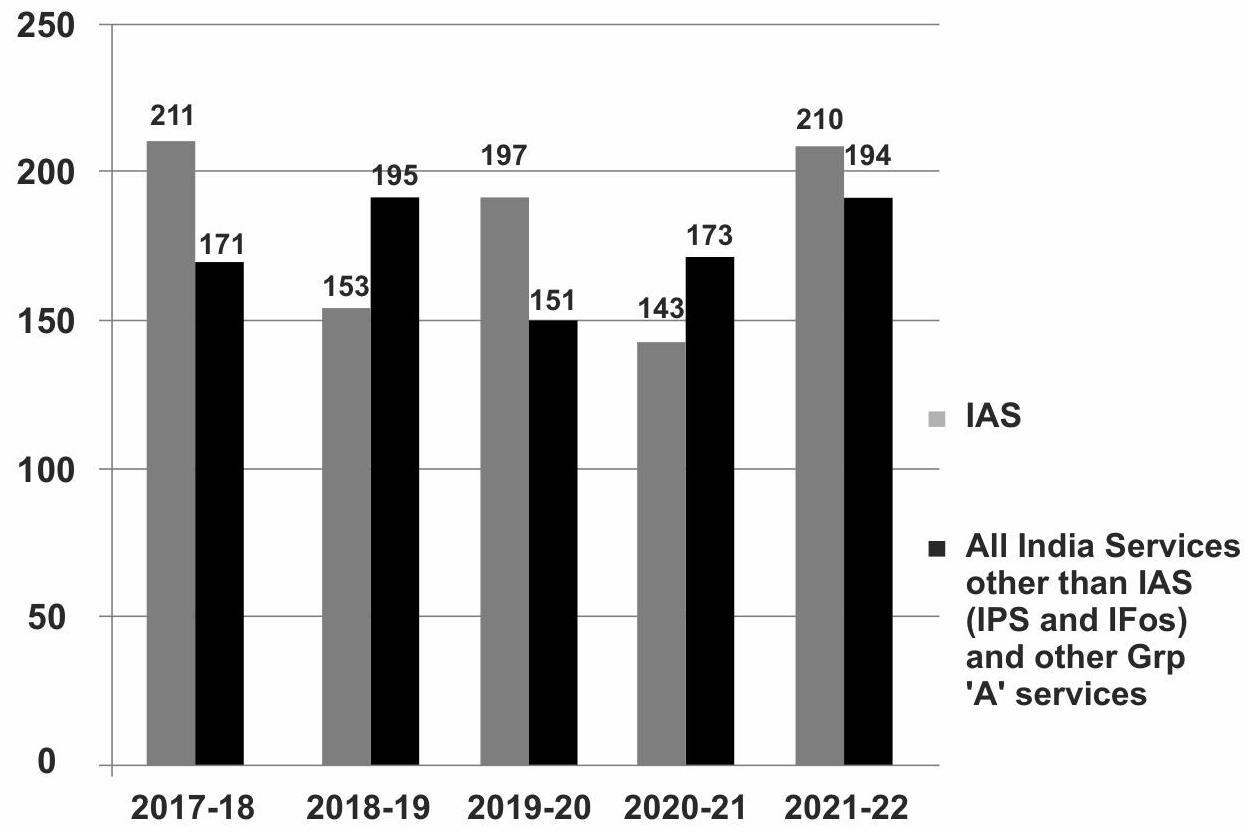
Figures for 2017-18 are up to 30/11/2018, for 2018-19 are up to 31/3/2019, for 2019-20 are up to 31/12/2019, for 2020-21 are up to 31/12/2020 and for 2021-22 are up to 31/12/2021
CENTRAL DEPUTATION RESERVE
6.5 The Establishment Officers (EO) Division in the Department of Personnel & Training maintains an electronic database of the IAS officers \& of Group ‘A’ service officers working at the Centre under the Central Staffing Scheme. These records are maintained on the basis of orders/letters/notifications issued by the DOPT, various Central Ministries/Departments and the State Governments. The maintenance/ updation
of this database is significant, as it helps in providing readily available digitized information in respect of all officers and also processing of cases for foreign appointments/assignments and training etc.
6.6 The Central Deputation Reserve statement in respect of Indian Administrative Service summarizes the state wise number of officers that are on central deputation vis-avis senior duty posts. It also indicates the number of officers presently on central deputation from each cadre.
CENTRAL DEPUTATION RESERVE FIGURES AS ON (01/01/2022).
| Sr. | Cadre | Total Authorized Strength | Central Deputation Reserve | No. of Officers at Centre | Col. 5 as Percentage of Col. 4 |
|---|---|---|---|---|---|
| (1) | (2) | (3) | (4) | (5) | (6) |
| 1. | A G M U T | 403 | 87 | 41 | 47 |
| 2. | Andhra Pradesh | 239 | 52 | 10 | 19 |
| 3. | Assam Meghalya | 263 | 57 | 19 | 33 |
| 4. | Bihar | 342 | 74 | 28 | 37 |
| 5. | Chhattisgarh | 193 | 42 | 12 | 28 |
| 6. | Gujarat | 313 | 68 | 14 | 20 |
| 7. | Haryana | 215 | 46 | 12 | 26 |
| 8. | Himachal Pradesh | 147 | 32 | 12 | 37 |
| 9. | Jammu & Kashmir | 137 | 30 | 8 | 26 |
| 10. | Jharkhand | 215 | 46 | 13 | 28 |
| 11. | Karnataka | 314 | 68 | 17 | 25 |
| 12. | Kerala | 231 | 50 | 18 | 36 |
| 13. | Madhya Pradesh | 439 | 95 | 24 | 25 |
| 14. | Maharashtra | 415 | 90 | 24 | 26 |
| 15. | Manipur | 115 | 25 | 12 | 48 |
| 16. | Nagaland | 94 | 20 | 8 | 40 |
| 17. | Odisha | 237 | 51 | 24 | 47 |
| 18. | Punjab | 231 | 50 | 15 | 30 |
| 19. | Rajasthan | 313 | 68 | 15 | 22 |
| 20. | Sikkim | 48 | 10 | 5 | 50 |
| 21. | Tamil Nadu | 376 | 81 | 23 | 28 |
| 22. | Telangana | 208 | 45 | 7 | 15 |
| 23. | Tripura | 102 | 22 | 14 | 63 |
| 24. | Uttar Pradesh | 621 | 134 | 30 | 22 |
| 25. | Uttarakhand | 120 | 26 | 5 | 19 |
| 26. | West Bengal | 378 | 82 | 8 | 09 |
| Total | 6709 | 1451 | 418 | 28 |
6.7 In addition to the appointments under the Central Staffing Scheme, 501 appointments as Chairman/ CMDs /MDs/Deputy Governor/Chairman/Vice Chairman /Members/Executive Directors
/Officers Employee Directors/Workmen Employee Directors/ Functional Directors/ Non Official Directors were made on the Boards of Public Sector Undertakings and Banks/Financial Institutions during the period
01.04.2021 to 20.12.2021. During the same period, 57 appointments were made at the level of Chairman/Financial Commissioner/General Managers/ equivalent Members/Additional Members/ Director General in the Railway Board/Zonal Railways/RCT and Promotion/empanelment was carried out for appointments to Higher Administrative Grade Rs. 67,000-79,000/and Rs. 75,500-80,000/- in various Group ‘A’ Services under the Ministry of Railways.
Besides, proposals in respect of 227 Officers were also approved during the above period for additional charge/current charge/extension of tenure/non-extension of tenure/ad-hoc/rejection/termination of services of GM/DG/VC/CMDs/MDs, Functional Directors, Non-Official Directors in PSUs/Banks/Financial Institutions, and the Ministry of Railways. Out of these 785 appointments/Additional charge arrangements, 43 are female officers.
NUMBER OF APPOINTMENTS TO THE POST OF CHAIRMAN-CUM-MANAGING DIRECTOR/ MANAGING DIRECTOR ETC IN PSUs/ BANKs
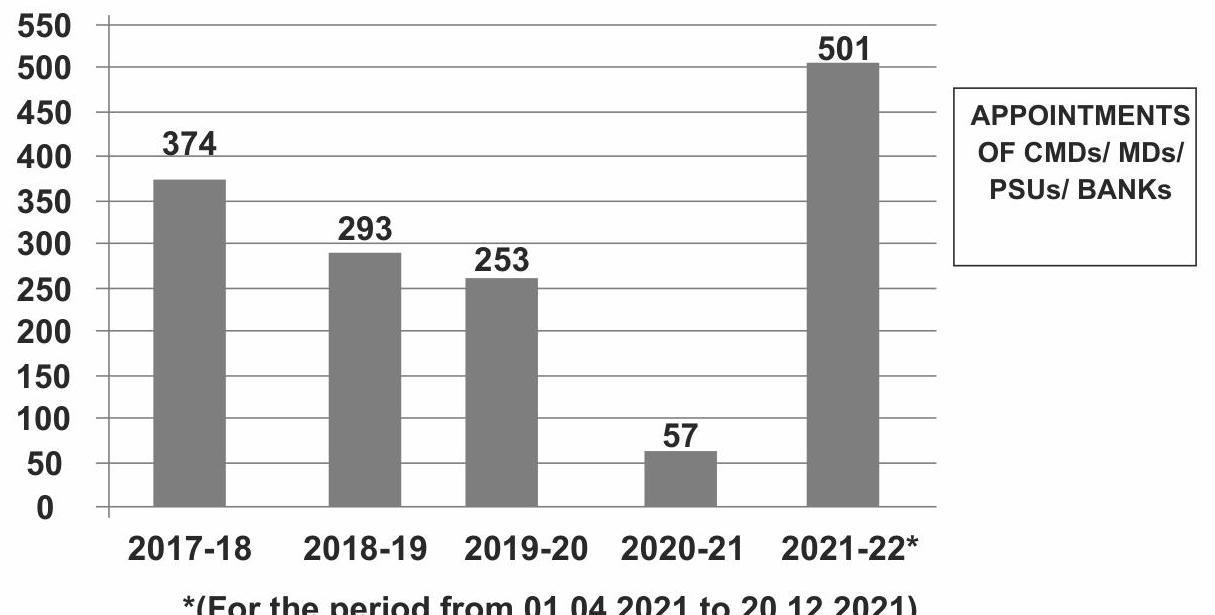
*(For the period from 01.04.2021 to 20.12.2021)
6.8 During the period 2021 (01.04.2021 to 31.12.2021) 159 Member/Chairman/ Chief Executive Officer/Advisor were approved for appointment in various Autonomous Bodies, Administrative Tribunals, Labour Courts, Regulatory Bodies etc. Out of these, 23 were women officers.
6.9 A total of 1081 officers were approved for empanelment for promotion to posts of and above the level of Joint Secretary in various organized Central Services which are not included in the Central Staffing Scheme. Out of these 185 are women officers.
6.10 The Election Commission of India has been provided the names of 64 IAS officers falling within allotment year 1990-2014. Out of
which, 08 officers have been appointed by the ECI as Election Observers for General Election to the States Legislative Assembly of Bihar, 2020.
Chief Vigilance Officer
6.11 During the year 2021-22 (upto 31.12.2021), 20 officers have been appointed as Chief Vigilance Officers (CVOs) in various organizations and 26 officers have been given additional charge of the vacant posts of CVOs in various organizations. During the same period, 09 CVOs have been granted extension of tenure after completion of initial tenure and 04 cases of premature repatriation have been finalized.
REPRESENTATION OF WOMEN
6.12 While taking up empanelment of officers to Joint Secretary rank, it is ensured that women get adequate representation.
6.13 A total of 73 women were appointed under Central Staffing Scheme during the period 2021-2022 including 42 women at Secretary/Addl. Secy./ Joint Secy. levels.
6.14 The appointments/ additional charge/ Extension of tenure /service as CMDs/MDs, Executive Directors, Functional Directors, Non-official Directors in PSUs/Banks, Financial Institutions, Railway Claims Tribunal (Indian Railways) include 43 female officers.
6.15 A total of 208 women officer were appointed as Member / Chairperson / CEO, etc. in various Autonomous Bodies, Administrative Tribunals, Labour Courts, Regulatory Bodies and promoted to posts of joint Secretary level and above in various organised central services excluding appointments under the Central Staffing Scheme.
6.1622 women were approved for appointment as Member/Chairperson/CEO etc. in various Autonomous Bodies, Administrative Tribunals, Labor Courts, Regulatory Bodies etc.
CHAPTER
TRAINING POLICY AND PROGRAMMES
MANDATE
7.0 The Training Division of the Department of Personnel &Training is the nodal agency for training of government functionaries and is primarily responsible for formulating policies with regard to training. It also implements certain components of training directly. In the implementation of its mandate, the Division has set the following objectives:
Administering Policy matters in training
Identification of functional areas of training
Designing and implementing training programs for officers involved in the priority development sectors
Development of trainers and training capability
7.1 The goal of the Training Division is to attain “Training for All” which means that training would be imparted to all rungs of Civil Services starting from the lowest and cutting-edge to the highest in policy making.
Major Activities
(1) Post Graduate Programmes in Public Policy/SustainableDevelopment/ Management
(2) Mid Career Training of IAS Officers
(3) Training Support under Training For All (TFA) Scheme through the following components:
State Category Training Programme (SCTP)
Trainers’ Development Programme (TDP)
Intensive Training Programme
Induction Training Programme
Comprehensive Online Modified Modules on Induction Training (COMMIT)
Faculty Development Scheme (FDS)
Augmentation of Capacity of Training Institutions (ACTI)
Integrated Government Online Training (iGOT)
(4) Domestic Funding of Foreign Training (Overseas Training Programmes)
(5) In-service Training of IAS Officers
(6) Advanced Professional Programme in Public Administration (APPPA)
(7) Posting of Probationary IAS Officers as Assistant Secretary in Government of India
(8) National Programme for Civil Services Capacity Building (NPCSCB) – Mission Karmayogi
(9) e-Human Resource Management= System (e-HRMS)
Long-Term Domestic Post Graduate programmes in Public Policy and Management
7.2 Training Division, DoP\&T are conducting the following 4 Long Term Domestic Training Programmes (LTDP) in Public Policy/ Management/ Sustainable Development-
(i) Post Graduate Programme in Public Policy and Management (PG-PPM) at the Centre for Public Policy, Indian Institute of Management, Bangalore
(ii) One year Diploma Programme in Public Policy and Sustainable Development (PP & SD) or Two year M.A. (Public Policy and Sustainable Development) Degree Programme at the TERI School of Advance Studies, New Delhi
(iii) Post Graduate Diploma Programme in Public Policy and Management (PGD PPM) at Management Development Institute, Gurugram
(iv) One year Advanced Management Programme in Public Policy (MPPP) at Indian School of Business, Hyderabad/ Mohali
7.2.1 These programmes were envisaged to enhance the competence of Mid-Career Civil Servants in Public Policy and Management by
(I) Broadening awareness of the latest trends in policy approaches,
(ii) Developing technical, analytical and leadership skills for public policy,
(iii) Providing opportunity in specialization and
(iv) Exposing them to alternative systems of public management in other countries.
During 2021-22, $6^{\text {th }}$ Batch of One year Advanced Management Programmer in Public Policy (AMPPP) was commenced on $20^{\text {th }}$ August, 2021 at Indian School of Business- Hyderabad/ Mohali, which is being attended by 14 participants. 13th Batch of Programme in Public Policy \& Sustainable Development (PP \& SD) was commenced on $4^{\text {th }}$ October, 2021 at TERI School of Advance Studies- New Delhi, which was attended by 5 participants.
Mid-Career Interaction between Armed Forces and Civil Services Officers
7.3 Mid-Career interactions between Armed Forces and Civil Services Officers are being organized at the Central Training Institutes/State Administrative Training Institutes and Defence Institutions in various various parts of the country with the objective to benefit both the Armed Forces and Civil Services Officers by way of mutual learning
from each other’s strength and also by imbibing the best points of each other’s work culture, ethos and customs. This, in the long run, is expected to help the participating officers to combat future challenges to national security in a better manner.
During the current financial year 2021-22, 4 programmes have been planned Yashwantrao Chavan Academy of Development Administration (DoP\&T), Maritime Warfare Centre- Kochi (NAVY), College of Air Warfare- Secunderabad (AirForce) and 11 Inf Division- Ahmedabad (Army) on the themes ‘Cyber Security and Crime’, ‘Management of IS Situation during Conventional and Sub-Conventional threat/ strike’, ‘Perception Management as a tool of National Security’, and ‘Projection of National Power- Requirement of a Synergized effort. Out of these, one programme has already been conducted at Yashwantrao Chavan Academy of Development AdministrationPune, which was attended by 27 participants. The Second MCIP scheduled at College of Air Warfare- Secunderabad (Air-Force) has been cancelled due to situation of arise out of Covid-19 pandemic. The remaining two programmes will be conducted in the upcoming months.
Training Support under Central Sector Scheme “Training For All (TFA)”
7.4 ‘Training for All’ (TFA), is a Central Sector Scheme sponsored by Department of Personnel \& Training and it has been in operation since 1992. The objective of the Scheme is capacity building of all the Government officials at National and State levels through training interventions to fulfill the mandate of National Training Policy (NTP) to provide training for all viz. developing management skills and knowledge in different areas for senior and middle level officers of State Governments / State Public Sector Undertakings and State Autonomous Bodies; development of a cadre of professional trainers and resource persons in the country;
improving functional knowledge, skill and attitudinal orientation of the frontline functionaries; imparting training, including training on soft skills, to the newly recruited cutting edge level functionaries of the State Governments in order to strengthen the public service delivery mechanism; providing opportunity to trainers / faculties to undergo short-term training programmes in the institutions of excellence within the country to supplement their knowledge and skills: augmenting the existing training mechanism with online module-based training coupled with certification to government servants; and providing financial support to the State ATIs for augmenting infrastructure.
7.5 In order to achieve the objectives envisaged in the NTP, various training programmes are sponsored and training related activities are undertaken under the following components during the Financial Year 2020-21:
State Category Training Programme (SCTP)
Trainers’ Development Programme (TDP)
Intensive Training Programme
$>12$ – Days Induction Training Programme
Comprehensive Online Modified Modules on Induction Training (COMMIT)
Faculty Development Scheme (FDS)
Augmentation of Capacity of Training Institutions (ACTI)
State Category Training Programme (SCTP)
7.6 Under this component, support is provided to State / Union Territory (UT) Administrative Training Institutes (ATIs) by way of sponsoring training programmes in the areas accorded priority by the Central Government. The programmes are designed for senior and middle level officials of State / UT Governments / State Public Sector Undertakings and State Autonomous Bodies to develop management skills and knowledge in different areas and also to sensitize about new and important issues facing our society. The courses cover a large variety of subjects
under broad thematic groups such as Ethics in Administration, Disaster Management, Right to Information, Gender Issues, Decentralized Planning, Role & Responsibilities of DDOs, Financial Management, Environment \& Climate Change, e-Governance, Cyber Security, Leadership \& Team Building, Disaster Management \& Climate Change, Legal Literacy for Government Servants, Training in Administrative Vigilance, Public Private Partnership, Revenue Resource Mobilization through VAT/GST/IT etc.
During the year 2021-22, this Department planned to sponsor 719 SCTP courses at an expenditure of $₹ 8,08,87,000 /-$ to various State / UT ATIs on several thematic subjects. As of 31.12.2021, 577 SCTP Courses have been sponsored by this Department.
Trainers Development Programme (TDP)
7.7 Recognizing the importance of trainers in the training function, the TDP was started in the early 1990s. Over a period of time, indigenous mechanisms were evolved for developing a cadre of professional trainers and resource persons in the country to create a cascading and multiplier effect by developing the Central / State / UT employees as Master Trainers and Recognized Trainers of various “Training of Trainers (ToT)” packages. The programme has gone a long way in embedding the Systematic Approach to Training (SAT) into the process of designing and imparting effective training to government officials. Under the component, financial assistance is provided to State / UT ATIs \& selected Central Training Institutes (CTIs) to develop a cadre of professional trainers and resource persons in various ToT packages.
The following ToT programmes are sponsored under the TDP component which are conducted by various training institutions across the country:
- Training Needs Analysis (TNA)
- Design of Training (DOT)
- Direct Trainer Skills (DTS)
- Evaluation of Training (EoT)
- Management of Training (MoT)
- Experiential Learning Tools (ELT)
- Mentoring Skills
- Facilitation Skills
- Introduction to SAT courses
During the year 2021-22, this Department planned to sponsor 97 TDP courses at expenditure of ₹1, 91, 12,000/- to various Central / State Training Institutions. As of 31.12.2021, 84 TDP Courses have been sponsored by this Department.
Intensive Training Programme
7.8 Intensive training programme for frontline functionaries of State/UT Governments was initiated during the year 2008-09 on the advice of the erstwhile Planning Commission to replicate the robust models of training of frontline functionaries developed through externally aided projects during the $X$ Plan Period. The focus of this programme is on demand-driven training of frontline personnel and is conducted in close coordination with line Departments by the ATIs. The Programme is undertaken to provide saturation training of frontline personnel manning the public service delivery chain, in sectors identified by States, in specific geographical area of a State. This programme aims to impact upon functional knowledge, skills and attitudinal orientation of the frontline functionaries through appropriately designed training interventions to make public service delivery effective.
The intensive training programme is being implemented in most parts of the country approximately 99,250 officials have so far been trained since its inception. Some of the sectors covered under the Programme include – Water and Sanitation, Public Health, Public Distribution System, Revenue, Integrated Child Development Services, School Education, Dairy Development, Registration, Social Welfare, Tribal Welfare, Police, Citizen Centric Delivery and Right to Public Services Act etc. As of 31.12.2021, during the financial year 2021-22, this Department has released ₹2,08,07,280/- to
cover around 17,000 employees of the State Governments of Telangana and Tripura for providing training under Intensive Training Programme.
12-Days Induction Training Programme
7.9 National Training Policy (NTP) stipulates inter alia that all civil servants, especially the front-line staff, will be provided with training, including training on soft skills, to equip them with the competencies for their current or future jobs at the time of their entry into service and at appropriate intervals in the course of their careers, so as to improve customer orientation as well as quality of service delivery to the citizens. As per the mandate, the 12-Days Induction Training Programme (ITP) was launched for the newly recruited Group-B (non-gazetted) & Group-C cutting edge level State Government functionaries during the Financial Year 2014-15 by this Department with a view to develop generic and domain specific competencies in cutting edge level functionaries for strengthening capabilities to improve the public service delivery mechanism.
The programme is implemented in the districts selected by the State ATIs according to their preference, where the newly recruited State Government frontline functionaries are available in large numbers. The programme covers those sectors/departments which have the maximum citizen interaction and are directly involved in the public delivery system. The Induction Training Programme includes training in 5-Days generic modules, 2-Days NGO \& field visit and Blood Donation Camp and 5-Days domain specific modules.
The Programme has been implemented in around 410 districts all over the country, except the States of Arunachal Pradesh and Bihar and the UTs (other than J\&K). As of 31.12.2021, during the financial year 2020-21, this Department has sponsored 12-Days Induction Training Programme in several districts of States of Maharashtra and Himachal Pradesh to cover 1,120 newly recruited frontline functionaries of these State
Governments at an expenditure of ₹2,01,60,000/-.
Comprehensive Online Modified Modules on Induction Training (COMMIT)
7.10 A Blended Training Programme called COMMIT was conceptualized and launched in 2017 in the backdrop of the mandate of the National Training Policy, which stipulates that all civil servants from lowest level functionaries to the highest level will be provided training at the time of their entry into civil service and mandates that priority will be given to the training of front-line staff, including training on soft skills, so as to improve customer orientation as well as quality service delivery to the citizen. This programme supplements the existing 12-Day Induction Training Programme (12-Day ITP) in developing Generic & Domain specific competencies in the frontline functionaries. This programme has the potential to cover more than 3 lakh officials every year.
The programme is of 28 hours duration which includes e-Modules for 20 hours and face-toface classroom training for 8 hours The 20 hours e-training would be imparted through specifically developed 12 Generic and 3 Domain specific e-Modules. The modules on soft skills would be delivered as e-Modules and through face-to-face training, whereas the domain modules would be covered through e-Modules only. The programme is implemented through State Administrative Training Institutes (ATIs).
The blended course allows officers and faculty to take advantage of flexibility and convenience of an online course while retaining the benefits of the face-to-face classroom experience. The COMMIT is strategically aligned with the mission and goals of the 12-Days ITP to develop skills and attitude towards improving service delivery keeping the citizen at the core. The advantage of such a blended programme is requirement of limited classroom space; to infuse new opportunities to officers who have
had limited or no training to build the requisite skills, knowledge and attitude; and offer the convenience of online learning combined with the social and instructional interaction that may not lend themselves to online delivery (e.g. motivational talk, understanding of the vision and proctoring assessments).
COMMIT programme has so far been implemented in 15 States covering around 1.85 lakh employees of these State Governments.
As of 31.12.2021, during the financial year 2021-22, this Department has released ₹91,50,000/- to cover 6,000 frontline functionaries of the State Governments of Madhya Pradesh and Andhra Pradesh for providing training under COMMIT.
English version of the COMMIT Modules has already been onboarded onto the iGOT Platform. Further, these Modules have already been got translated to Telugu and Hindi languages and the same are being onboarded onto the iGOT Platform.
Faculty Development Scheme (FDS)
7.11 This Department has been implementing the Faculty Development Scheme with a view to broadening and honing the knowledge and skill base of the trainers/faculty members working in the training institutes. All Master Trainers/Recognized Trainers (MTs/RTs) developed by this Department under Trainers Development Programme (TDP), faculty members working in Central Training Institutions (CTIs) and State Administrative Training Institutions (ATIs) for conducting domestic trainings are eligible for support under the Scheme. The trainers / faculty are sponsored to undergo training in domestic short duration programmes / correspondence courses conducted by premier Intuitions.
Augmentation of Capacity of Training Institutions (ACTI):
7.12 Under the Augmentation of Capacity of Training Institutions (ACTI) component, support is provided to the State / UT ATIs for augmenting infrastructure in the form of
hardware, software and courseware, networking of training institutions and consolidating the training ware. The Training Institutes are also supported and encouraged for developing case studies, e-learning packages, training films, organizing workshops, special programmes, seminars etc. The funds are released to those ATIs who seek financial assistance for up-gradation of their training capacity.
Under this component of the Scheme, assistance to the tune of around ₹13.75 cr. has so far been provided to several State Administrative Training Institutes (ATIs) since the FY 2014-15.
Keeping in view the changes taking place in technology etc. and the requirements commensurate with the same, this Department has actively been considering revisiting the guidelines governing the assistance under the component.
Overseas Training Programmes
7.13 Department of Personnel and Training has been nominating officers for training programs abroad. In the past, these programs were funded by bilateral or multilateral assistance. However, over the years, this assistance had come down. Keeping in view the importance and befits of providing international exposure to the officers, a scheme of Domestic Funding of Foreign Training (DFFT) was started in 2001. This covers both long-term and short-term training in various universities/institutes in several countries. A scheme of “Partial Funding of Foreign Study” was also started in 2002-03 as another component of the scheme of DFFT. Under this scheme, Government of India provides limited financial assistance to such officers who secure admission on their own in reputed universities and in programs relevant to their present or future job context.
During the financial year 2021-22, restrictions were imposed on foreign training conducted by CCAs/CTIs due to the outbreak of COVID19 pandemic and in view of safety measures and financial austerity. Hence, the DFFT
programs for the year 2021-22 could not be conducted. 4 officer has been nominated for Knowledge Co-Creation Program of Japan International Cooperation Agency (JICA) held in Japan under the Technical Cooperation Program of the Government of Japan and 3 officers have been nominated for one year Masters Degree Course in School of Government and law under Young Leaders Program (YLP) at the National Graduate Institute for Policy Studies, (GRIPS) Tokyo, Japan from October 2021 – September 2022. These programmes at Japan are fully funded by the Govt. of Japan.
One-week In-Service Training (IST) Programme for Officers of All India Services, those working under Central Staffing Scheme and Officers of Central Secretariat Service (CSS) and Central Secretariat Stenographers Service (CSSS).
7.14 The Training Division sponsors ‘InService Training Programme’ of ‘one-week duration’ in various ATIs/CTIs/ Premier Training Institutes in the country by inviting proposals from them on relevant themes. During the year (2021-22), 19 programmes (Physical/Offline mode) are being offered at 16 training institutions and 8 programs (Online mode) are being offered at 8 training institutions. These programmes provide middle and senior management level officers an opportunity to update their skills in areas of their choice-in sectors they are currently working in, or in areas they are expected to work in the near future, or in areas they want to specialize in. These programs also provide a valuable platform for horizontal and vertical knowledge sharing.
The primary objective of the IST program is to sensitize the participants to national concerns and the values enshrined in the Constitution; to provide for exchange of experience and adequate discussions on issues of values, ethics and attitudes; to make the participants more confident to face problems in their work areas and attempt solutions; and to train the participants to look at problems in an
integrated manner and develop a systematic approach.
In the past, these programs have been offered in diverse and broad thematic areas: such as Administrative Law, Agricultural & Rural Development, Climate Change (preparedness), Competition Law (policy formulation), Corruption (eradication strategy), Education (reforms \& challenges), E-governance (opportunities \& challenges), Environment \& Natural Resource (management), Environmental Impact Assessment (development projects), Ethics (Public Governance and Administration), Financial Markets (regulation), Fiscal Policy (Macroeconomic Management), Governance (IT management and improving through accountability), Infrastructure (Finance), Innovations (public service), Land Acquisition (rehabilitation \& resettlement), Leadership, Participatory Management (Community Mobilization), PPP (negotiating strategies and urban development), Procurement (procedure \& contracting), Project Analysis /Appraisal (risk analysis/management), Public Policy (management/governance), Quantitative Methods (management), Service Delivery (management), Social Policy (Governance), Social Sector (financing/marketing), Urban Development, WTO (basic/advance course), Citizen Centric, Cyber Crime, Stress Management, etc.
Advanced Professional Programme in Public Administration (APPPA) at Indian Institute of Public Administration, New Delhi
7.15 The Training Division has been sponsoring a ten-month Advanced Professional Programme in Public Administration (APPPA) at the Indian Institute of Public Administration (IIPA), New Delhi every year since 1975-76.
The objectives of this programme are to prepare the participants to make greater contribution to better governance, develop attitudes that focus on citizen services and also to strengthen leadership qualities in the civil service. It provides an opportunity to the
participants to analyze major contemporary issues in Governance, learn about recent developments in the social sciences and their application in administration; review their experiences by making a critical analysis of environmental and other factors, apply relevant concepts, skills and techniques relating to policy, behavioral and administrative sciences and to demonstrate their creative and analytical abilities individually and in groups. It also seeks to develop interpersonal skills and sensitiveness to the needs of the people with a view to making administration more responsive and result oriented.
The course covers classroom studies relating to various facets of administration viz, Social, Political, Economic, Legal and Administrative Systems, Organizational Behavior, Social Science and Research Methods, Operational Research, Information Technology in Management and Financial Management. Participants are also required to conduct rural and urban field studies and prepare a project report and dissertation. They are expected to select an area for specialization relevant to their present and likely future assignments from following fields of study: Advanced Information Technology and MIS, Comparative Development Experience, Project Management, Constitutional Law, Disaster Management, Economics of Regulation, Inter Governmental Relations, Management Systems, Organizational Needs Analysis, Public Expenditure Management, Public Organizational Theory, TQM, Finance, Personnel, Corporate or Public Sector Management, General Administration, Planning and Rural Development etc.
An officer with at least 10 years of Group ‘A’ (class-I) service and at least of the rank of Director/Deputy Secretary in the Government of India or holding an equivalent post is eligible for APPPA course. The Programme is also open for senior officers (Group ‘A’) from State Services.
This 10-month programme includes three semesters, rural and urban field visits in India
and a two-week foreign study tour. In the $44^{\text {th }}$ APPPA Programme, the participants visited USA & Czech Republic and South Africa \& Spain in two groups. 40 participants attended this programme. In $45^{\text {th }}$ and $46^{\text {th }}$ APPPA courses, participants did not visit foreign study tour due to COVID-19 pandemic. The $47^{\text {th }}$ APPPA programme in this series commenced from July 1, 2021 and is scheduled to end on April 29, 2022. 31 participants are attending this programme.
Indian Institute of Public Administration
7.16 Indian Institute of Public Administration (IIPA), New Delhi is an autonomous Research and Training Institute of national importance under Department of Personnel \& Training (DoPT), Government of India. IIPA was established on 29th March 1954 and the first Prime Minister of India Pt. Jawahar Lal Nehru was the first President of IIPA.
For the period under Report, the Hon’ble Vice President of India Shri M Venkaish Naidu, is the President of IIPA and Hon’ble Union Minister of State, Ministry of Personnel, Public Grievance and Pensions. Government of India, Dr. Jitendra Singh, is the Chairman of IIPA Executive Council, Shri Surendra Nath Tripathi, IAS (R), Former Secretary, Ministry of Parliamentary Affairs, Govt. of India is the present Director-General of IIPA. IIPA Executive Council includes, among others, the CEO, NITI Aayog, Secretary (P), DoPT, Secretary (Expenditure) and Director, LBSNAA, Mussoorie.
The activities of IIPA include research, training, publication and dissemination of information in the field of Public Administration \& Governance. Every year IIPA conducts more than 50 research projects which consists of evaluation of government schemes, policy advisory and policy analysis for different Ministries / Departments of Government of India, State Governments and International Organizations .During COVID19 pandemic, IIPA conducted the maximum number of research projects for different qualitative upswing with specific governance
areas of concern. IIPA faculty completed around 20 research studies for various Central Ministries and State Governments till December 2021. This has been a wonderful achievement in this time of global crisis.
IIPA conducts over 100 training programmes every year for officers of Government of India, State Governments, PSUs, Defence Forces and Foreign Governments. Due to COVID 19 situation, face-to-face training did not happen in the first 4-5 months of Financial Year 202122. But after that IIPA has been conducting offline training for Indian Revenue Service (Customs \& Indirect Taxes), Newly Appointed AGMs of FCI, Judicial Officers of UP State, Foundation Training Programme of Department of Science \& Technology etc. IIPA has conducted 76 online/offline training programme till December 2021.
The $47^{\text {th }}$ Advanced Professional Programme in Public Administration (APPPA) commenced on 1st July 2021. Hon’ble Union Minister Dr Jitendra Singh interacted with the participants on 2nd July 2021. It was the first Mid-career programme to have successfully started online and will be carried out in both online/offline mode throughout its 10-month duration. Total Thirty-one (31) participants are participating, majority of them being from all tri- services of armed forces and others from ITS, Indian Postal Service, Military Engineer Services (MES) and Ministry of Environment, Forest and Climate Change (MoEF) and other Civilian Officers.
In F.Y. 2021-22, IIPA conducted webinar on different topics of national importance from May 2020. Till December 2021, IIPA conducted more than 30 webinars which includes topics on Post Covid 19 governance reforms, digital transformation, leadership, farmers’ welfare, agriculture markets etc.
The Institute disseminates information, analyses viewpoints and knowledge related to public administration, governance, policy and public administration, governance, policy and development through its regular publications viz., monthly digital edition of IIPA Newsletter,
quarterly editions of Indian Journal of Public Administration (IJPA) in association with Sage Publications, quarterly editions of Nagarlok, Documentation in Public Administration (DPA), biannual editions of Lok Prashashan (Hindi Journal) and quarterly editions of IIPA Digest. IJPA Nagarlok and Lok Prakashan all three are is also listed in the UGC- Care List of Journals.
Even during Covid 19 and amidst Lockdown, IIPA has prepared commendable Digital Infrastructure and it has now VC equipped eight Lecture Halls for conducting online programmes. In fact, IIPA prepared all the Digital Material also during Lockdown for APPPA and other Online Programmes. IIPA is ready for 2nd APPPA beginning January of each year looking into its popularity and usefulness in building civil defense collaboration. IIPA receives grant-in aid from DoPT, Govt. of India under Salary, General and Capital heads. For BE 2021-22, IIPA has been allocated Rs. 9.00 crore under Salary, Rs.7.00 crore under General and Rs. 8.50 crore under Capital i.e. total of Rs. 24.50 crore.
Assistant Secretary Training Programme in Union Ministries
7.17 The Department of Personnel and Training is entrusted with the implementation of Assistant Secretary Programme to provide exposure to the young IAS officers to Government of India functioning at early stage(s) in their career on completion of their phase II Training at LBSNAA, Mussoorie.
This exposure helps them acquire a national perspective and appreciation of diversities in national policies. This also sensitize them to the larger perspective of policies & programmes of Government of India and the officers are likely to be an inspired Change Agents when they go back to their cadre States. As primary implementers of Programmes/ Projects in the field (States), this exposure also facilitates a broader macro perspective.
The programme started in 2015 as per vision of Hon’ble Prime Minister when 2013 batch officers were posted in as Assistant Secretary in Ministries/ Departments. The programme is successfully continuing since then and 2014, 2015, 2016 and 2017 batch officers have also been deputed similarly. The Assistant Secretaries are posted for a total period of 13 weeks in Union Ministries and Departments in New Delhi. The Assistant Secretary Programme for 2018 and 2019 batches could not be held due to COVID pandemic.
The Assistant Secretaries are assigned important Desks in the Ministries and are placed below Under Secretaries, but report to Deputy Secretaries/ Directors. Last year i.e. 2019 the Assistant Secretaries were assigned following specific work with the approval of the Cabinet Secretary:
(I) Work relating to Flagship programmes/ major initiatives of the Ministry/ Department. This was an individual activity.
(ii) Secretary of the Ministry/ Department concerned gave a project work pertaining to the Ministry/ Department. A Group activity.
(iii) To review the implementation of projects/ initiatives of Assistant Secretaries of previous 3 batches and take them to a logical conclusion. A Group activity.
Besides above specific work, several Special interactive sessions and other programmes were also organised for the Assistant Secretaries on Fridays/ Weekends.
Among other activities, the Assistant Secretaries make presentations on the works/ initiatives they have undertaken in the respective Ministries/ Departments, before the Sectoral Group of Secretaries (SGOSs).
Top 8 presentations are shortlisted out of the presentations made by Assistant Secretaries before the respective SGOSs. These 8 top presentations are then presented before the Hon’ble Prime Minister during Valediction Ceremony.
The IAS officers of 2019 batch were expected to be posted as Assistant Secretaries w.e.f. 28.06.2021 after completion of their Phase-II training at LBSNAA, Mussoorie. However, the program could not be held due to COVID-19 pandemic.
CHAPTER
TRAINING INSTITUTIONS
LAL BAHADUR SHASTRI NATIONAL ACADEMY OF ADMINISTRATION, MUSSOORIE (UTTARAKHAND)
Introduction
8.0 The Lal Bahadur Shastri National Academy of Administration (LBSNAA), Mussoorie is Government of India’s premier institution for the training of higher civil services in the country. The Academy imparts induction level and in-service training. A common Foundation Course is held for entrants to All India Services and all Group “A” services of the Union. The professional training to regular recruits of the Indian Administrative Service (IAS) and members of the Royal Bhutan Civil Service is conducted after the Foundation Course. The Academy also conducts in- service and Mid-Career Training Program (MCTP) for members of the IAS and Induction Training program for officers promoted to the IAS from State Civil Services, as well as workshops and seminars on various issues in public administration.
To ensure that the academic curriculum is relevant, it is constantly reviewed and updated through extensive consultations with the representatives of the state governments, the central government and other scholars and practitioners. Given the limitations of conventional classroom lectures, new pedagogical methods have been introduced to deliver training inputs in a more effective manner. Most courses operate on a modular structure whereby relevant themes are chosen and dealt with in a consolidated
fashion to ensure that all aspects relating to them are covered comprehensively.
In order to promote all-round development of the personality, due emphasis is placed on outdoor and co-curricular events. Physical training, team games and tennis, badminton cross-country running, yoga, horse riding, and adventure sports like river rafting, paragliding, bungee jumping and rifle shooting are some of the activities that the officer trainees are involved in. Exposure to public speaking, theatre workshops, motor mechanic skills, gardening, photography and music appreciation are some of the co-curricular activities offered to the young administrators.
To nurture the values of integrity, moral courage, empathy and respect for the underprivileged, and freedom from any sectarian prejudices based on religion, region, caste, class or gender, Officer Trainees are encouraged to participate in diverse social activities. Various Clubs and Societies have been formed to which the Officer Trainees are elected as office-bearers. They organize and take part in quizzes, debates, poetry competitions and numerous other activities after class hours. This lends a spirit of bonhomie and also promotes esprit decorps.
Induction Training Courses
8.1 The Academy conducts Induction training courses for direct recruits to the IAS and other senior civil services as well as officers promoted to the IAS.
8.2 District Training (53 weeks)
| Duration | $5^{\text {th }}$ April, 2021 to 26 November, 2021 & $17^{\text {th }}$ January, 2022 to $27^{\text {th }}$ May, 2022 |
|---|---|
| Coordinator | Shri Abhiram G. Sankar, Deputy Director |
| Officer Trainees | 179 |
| Introduction | |
|---|---|
| Since its inception in 1969 when the ‘sandwich pattern’ was introduced, the IAS Officer Trainees undergo a one-year district training in their allotted State cadres. This period combines ‘Learning by Seeing’ and ‘Learning by Doing’ as the Officer Trainees also handle independent charges during this period. | |
| Objectives | |
| The Officer Trainees seek to understand the following issues during their attachment with each Department. – Organizational structure, roles and responsibilities. – Basic understanding of Acts and Rules – Office procedures including understanding a file, methods of noting /drafting, preparation of office orders and movement of files etc. – Budgeting and Audit for understanding the procedure and sequence of resource allocation, guidelines for expenditure, financial powers vested with officials and audit. – System of programme implementation, monitoring and reports. |
– Shortcomings or problems. Design During the year-long District Training, the IAS Officer Trainees learn about the various facets of administration at the district level. During this period they are under the direct charge of the District Collector and the State Government. They get an opportunity to obtain first-hand knowledge of the work of the Collector/District Magistrate and various other institutions in the State government, along with orientation training at the State Administrative Training Institute. Most of the state Governmentsgive them an opportunity of holding independent charge as Tehsildar/ Mamlatdar, Sub Divisional Magistrate, Block Development Officer and/or Executive Officer of a Municipality. The officer trainees completed their Winter Study Tour (Bharat Darshan) of 6 weeks, deferred due to the pandemic situation, from $29^{\text {th }}$ November, 2021 to $9^{\text {th }}$ January, 2022. The 2020 batch of the IAS will return to the Academy for their second phase of professional training commencing on May 30, 2022. |
8.3 IAS Professional Course Phase-II (2019 Batch) (06 Weeks)
| Duration | $17^{\text {th }}$ May, 2021 to $25^{\text {th }}$ June, 2021 (Online) |
|---|---|
| Programme meant for / Target group |
Newly recruited IAS Officer Trainees |
| Course Coordinator | Mr. Milind Ramteke, Deputy Director |
| Associate Course Coordinator(s) |
Mr. Abhiram G. Sankar, Deputy Director |
| Mr. Nitesh Jha, Professor | |
| Ms. Major Disha Pannu, Deputy Director | |
| Valedictory Address by | Dr. Jitendra Singh, Hon’ble Minister of State for the Ministry of Development of North Eastern Region, Minister of State for Prime Minister’s Office: Personnel, Public Grievances and Pensions and Department of Atomic Energy and Department of Space |
| Total No. of Participants | 185 (179 OTs, 2019 Batch, 01 from 2010 02 from 2017 Batch & 03 from RBCS) (Male- 127 ; Female-58) |
Course Aim
The IAS Professional Course Phase-II imparts rigorous training to the IAS Officer Trainees in a wide range of subjects to enable them to handle varied assignments that the officer typically holds in the first decade of service.
Course Objectives
- Provide a structured approach for intense reflection and analysis of individual and collective experiences gained during the district training.
- Emphasis on practical inputs on office and human resource management.
- Offer theoretical and practical sessions in political economy, public service delivery systems, and law.
- Hone administrative, managerial, and ICT skills.
- Demonstrate proficiency in the regional language of the cadre.
- Acquire and exhibit progressive values and attitudes for leadership role.
- Exposure to the best national and international practices.
- Maintain good health and high levels of physical fitness
- .Develop camaraderie and unity within the batch through an active campus life.
While theoretical concepts are sought to be imparted in the Foundation and Phase-I
courses, the ground level delivery mechanisms are expected to be imbibed during District Training. Phase-II is a time to debrief and share experience and good practices from the various states of the country. The course content of Phase-II is designed to consolidate the learning and assimilation of the district experience with the theoretical constructs taught earlier. A total of 185 Officer Trainees (including 3 Officer of Royal Bhutan Civil Service) underwent the Phase II course organized from May 17, 2021 to June 25, 2021.
Course Design
The IAS Professional Course Phase-II seeks to draw out and make the OT’s realize then potential in terms of attitude, knowledge and skills. The design of this course is very different from the Foundation Course and IAS Professional Course Phase-I where the focus is on equipping the Officer Trainees with basic knowledge of administrative theory, elementary skills, and an overview of government schemes and programmes. In 53-weeks district training, the Officer Trainees experienced the functioning of various facets of district administration at the cutting edge and gained invaluable experience. Their suggestions on the design and structure of Phase-II were solicited and the inputs received formed the basis of the programme design. There was a focus on incorporating sessions, discussions and seminars mainly on gap areas identified by the group, while in the field.
Participants in IAS Professional Course Phase-II (2019 Batch) Service wise Break-up
| Participants from the State of | Male | Female | Participants |
|---|---|---|---|
| AGMUT | 07 | 03 | 10 |
| Andhra Pradesh | 06 | 04 | 10 |
| Assam-Meghalaya | 05 | 03 | 08 |
| Bihar | 09 | 03 | 12 |
| Chhattishgarh | 03 | 02 | 05 |
| Gujarat | 07 | 01 | 08 |
| Haryana | 03 | 03 | 06 |
|---|---|---|---|
| Himachal Pradesh | 04 | 01 | 05 |
| Jammu & Kashmir | 01 | 00 | 01 |
| Jharkhand | 06 | 00 | 06 |
| Karnataka | 07 | 02 | 09 |
| Kerala | 04 | 04 | 08 |
| Madhya Pradesh | 07 | 03 | 10 |
| Maharashtra | 06 | 04 | 10 |
| Manipur | 04 | 00 | 04 |
| Nagaland | 00 | 00 | 00 |
| Odisha | 05 | 01 | 06 |
| Punjab | 03 | 01 | 04 |
| Rajasthan | 05 | 02 | 07 |
| Royal Bhutan Civil Service | 03 | 00 | 03 |
| Sikkim | 00 | 00 | 01 |
| Tamil Nadu | 06 | 03 | 09 |
| Tripura | 02 | 01 | 03 |
| Telangana | 05 | 03 | 08 |
| Uttar Pradesh | 10 | 08 | 18 |
| Uttarakhand | 03 | 00 | 03 |
| West Bengal | 06 | 06 | 12 |
| Total | $\mathbf{1 2 7}$ | $\mathbf{5 8}$ | $\mathbf{1 8 5}$ |
8.5 Induction Training Programme for officers of State Civil Service promoted to the IAS
123rd Induction Training Programme for IAS Officers (05th April – 30th April, 2021)
| Programme meant for / Target group |
Officers from State Civil Service who have been inducted (Promotion/Select List) into IAS |
|---|---|
| Course Coordinator | Ms. Monika Dhami |
| Associate Course Coordinator | Shri Milind D. Ramteke, Ms. Sunita Rani, Shri Hari Prakash, Ms. Ekta Uniyal |
| Inaugural address by | Dr. Sanjeev Chopra, Ex-Director, LBSNAA. |
| Valedictory Address by | Shri Arif Mohammad Khan, Honourable Governor of Kerala. |
| Total No. of Participants | Total – 67 [Male- 48; Female- 19] |
Course Aim
Induction courses are conducted for officers on a select list of various states or officers promoted to the Indian Administrative Service from the State Civil Services. The aim of these courses is to update levels of knowledge, skills and to provide opportunities for
exchange of ideas, views and experiences with people who have developed expertise in different sectors of national development. Considerable focus is given to new managerial thoughts, techniques and skills as well as to the frontier areas of technology and its management. There is an emphasis on
imparting an All-India perspective to its participants. The officers are also taken on a tour of premier institutions in the country to expose them to the pan-India character of the service.
Course Objectives
- To understand the all-India nature of Administrative Services and develop an all-India perspective on the working of public administration and the macroeconomy of the country.
- To be better equipped to handle their assignments with the knowledge of latest policies and programmes in various sectors as well as learnings from experiences of the fellow participants
- To be able to apply the principles of collaborative working and leadership and negotiations in their various work setting.
The pedagogy that was adopted to meet the course objectives included interactive lectures followed by discussion, case studies, Heritage walks/tours, experience sharing presentations, films and discussions, management games, simulation exercises, group work and field visits.
Course Design
Week 1
Reflections, Right to information, Financial Management Urban Mobility, Environment and Sustainability, National Security – Issues and Challenges-panel discussion, Public Policy : Design & Implementation, Role of Cooperative \& FPO in Agricultural Value Chain, Perspectives from North East
Week 2
Conserving Wildlife, Mainstreaming of vulnerable women, widows deserted and unemployed, Public Policy: Analysis and Communication, Improving learning outcome in Districts, Public Policy \& Regulation: An overview of Indian statutory regulatory
authorities, Brick Kiln: Case study, Disaster Management, New Idea of India, Smart Cities, Managing Development Interventions, Rural Cooperatives and supply chain, Designing PPP.
Week 3
Development Monitoring and Evaluation Office (DMEO), Leadership Module, Procurement, Negotiation Module, Communication, Urban Governance and Challenges, Module on Emotional Intelligence
Week 4
International Solar Alliance, Enhancing skills to support livelihoods, Market intervention in agriculture, Eat Right, Covid Management and Public Health, Proactive Afforestation and Biodiversity Conservation, Maps and Milestones, Gender, Strengthening lungs capacity and immunity in the time of Covid
The participants were to submit a 1500 words essay/research paper on any intervention made by them in the state, public policy or any topic of interest in administration with their own suggestions. Additionally each participant made an individual presentation about a unique professional experience in the area of interest before a group of internal faculty members.
The participants were evaluated out of 100 marks, 40 of which were Experience Sharing Presentation, 35 for the State specific or public policy paper and 25 for Director’s Assessment.
Weekend Modules
(i) Heritage and Nature walk
(ii) Screening of the movie ‘Invictus”
(iii) Water colors and art with Sachin Musale, a talented artist from Jalgaon in Maharasthra
(iv) Mobile/Smartphone film making by Ritesh Takshande
The 123rd Induction Training Programme (ITP) had officer Participants from 15 different cadres. The break up for the same is as detailed below:-
| State | No. of Officers | Men | Women |
|---|---|---|---|
| AGMUT | 09 | 08 | 01 |
| Andhra Pradesh | 02 | – | 02 |
| Assam-Meghalaya | 01 | – | 01 |
| Chhatisgarh | 08 | 02 | 06 |
| Haryana | 07 | 07 | – |
| Himachal Pradesh | 04 | 04 | – |
| Jharkhand | 01 | 01 | – |
| Karnataka | 06 | 04 | 02 |
| Kerala | 02 | 02 | – |
| Madhya Pradesh | 03 | 03 | – |
| Maharashtra | 10 | 08 | 02 |
| Manipur | 05 | 03 | 02 |
| Nagaland | 02 | 02 | – |
| Punjab | 02 | 02 | – |
| Rajasthan | 05 | 02 | 03 |
| Total | 67 | 48 | 19 |
Besides 4 weeks of academic input on diverse topics as mentioned in the course design, extra curriculum online modules were held on Saturday (weekends). On the painting, a Ayurvedic cooking and mobile film were held among the others.
Physical activity like yoga, meditation, morning walk, and work-out in the gymnasium kept the participants fit and active. Besides nature and heritage walks were also organized.
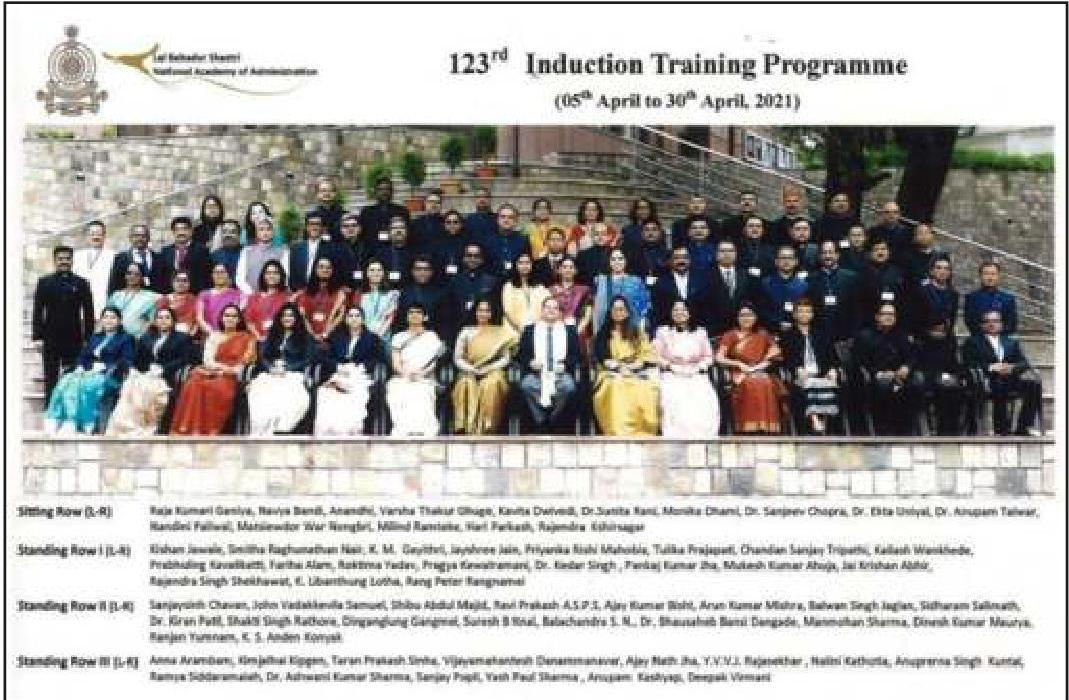
The Evaluation report of Participants is as follows:-
| Grade | No. of Participants |
|---|---|
| A+ | 39 |
| A | 27 |
| B+ | 01 |
8.6 Joint Civil Military Programme
| Course Name | 27th Joint Civil Military Programme
(6 September to 11 September, 2021) |
| — | — |
| Course Coordinator | Ms. Disha Pannu, Course Coordinator |
| Associate Course Coordinator(s) | Dr. Anupam Talwar, Associate Course Coordinator
Dr. Sristhee Sethi, Research Fellow |
| Programme inaugurated by | Gen. Bipin Rawat, PVSM, UYSM, AVSM,
YSM, SM, USM, ADC
CDS & Secretary, Department of
Military Affairs, Ministry of Defence |
| Valedictory address by | Hon’ble MoS Dr. Jitendra Singh |
| Composition of Group-
Service represented and
male/female breakup | Total $=53$ (Male- 51; Female- 02) |
| Programme meant for/Target
Group | All India Services -IAS, IPS, IFoS,
Central Civil Services- IFS, IC\&CES, IRS, IRTS,
IDAS, IDES
Paramilitary Organizations- BSF, CRPF, NSG,
ITBP, SSB
Defence Services- Indian Army, Indian
Navy, Indian Air Force, Coast Guard, Integrated
Defence HQ, Raksha Sewa Staff College
Intelligence-IB, Cabinet Secretariat
Other Organizations- CBI |
| Seniority Level | Joint Secretary/ Director to the Govt. of India
in the Civil Services
Major General/ Brigadier/ Colonel in the
Armed Forces |
Introduction of the Course
The Joint Civil-Military Training Programme on National Security is a flagship course of the Academy.
It was introduced in 2002 consequent to the report of the Group of Ministers on reforming the National Security apparatus.
Objectives, Course Activities and Highlights
- To increase awareness levels about the different dimensions and elements of National Security and the various threats to the Indian state;
- To familiarize the participants with challenges to management of national security, external security environment and internal security environment;
- To create awareness on different dimensions of security (Cyber, Environmental, Economic, Energy) as well as threats to such security;
- To expose them to the imperatives of civilmilitary interface; and
- To provide an opportunity for the participants to interact and exchange ideas on the subject
The instructional inputs comprised lectures, Panel Discussions, Case Studies, seminars, simulation exercises, Visits, group discussions and films. The programme attempted to juxtapose alternate view points on critical issues for deeper understanding of security challenges. It also aimed to harness the rich and diverse experience of the participants for more effective learning. The proximate objective of this programme was to meet the perceived gaps in knowledge, skill and attitude in respect of comprehensive national security through appropriate training inputs.
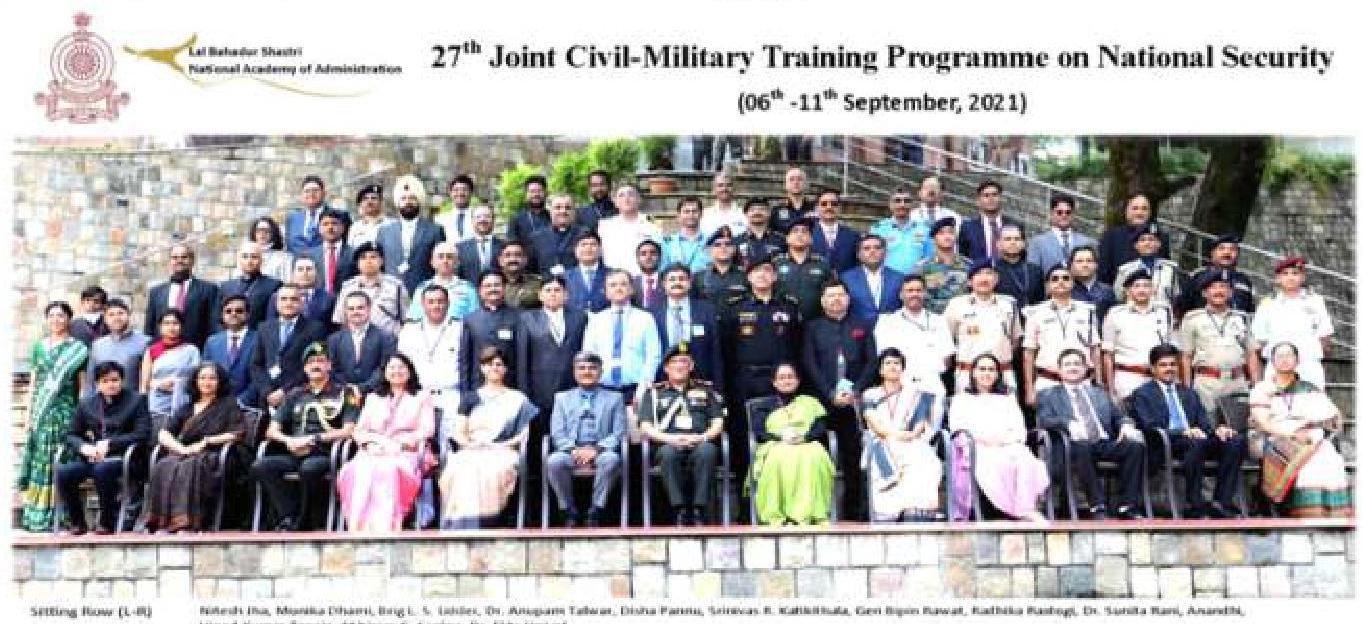
Stilling Rose (1-8)
Schools (Ata, Mandea Dharni, Eng.). S. Senter, Dr. Anupam Talwar, Disha Pansu, Srinivas R. Kahlchhala, Eani Bipin Rawat, Kaththa Rashigi, Dr. Sunita Rani, Anandhi, Vinod Kumar Taneja, Abhisam G. Sankar, Dr. Ekta Unipal
Standing Rose I (1-8) Dr. Siddhva N. Sethi, Resnew Vinovet Sthi, Nuspa M., Dr. M. G. Thamoth Vakaran, Sunnodav Singh Yadav, Rajashrikara N. DAS S. K. Singhree, Dr. Sibichee K. Mathere, I. D. Singh, Umansanda Dolez, Dr. Malarchical Yagal, Abhishek Viswai, Mohammad Mukom, DG P. Syam Kumar, Rajinder Kumar Bhambla, Bijay Kumar Verma, Devpak Kumar Botha, Anand Singh Nersang, Capt Manish Rao
Standing Rose II (1-8) Hani Prakash, Vinay B. Vinantra, R. V. Sankhooh Varma, Anil Kumar Rai, Swam Kartik Sharma, Air Cende Anun Lakhani, Shank Dhar Mishra, Lal Prakash Singh, Dilip Rana, Col Gaurav Kapur, Col Rakesh Singh, Nanjali Singh, Col Pradeep Vij, Ashok Tewari, Sandeep Dhakar, Ashok Yadav, Col Vijay Pal
Standing Rose III (1-8) Padmaja Chouhan, Abik Pandey, Gurkicali Ropal Singh, Navvied Manohar, Sunil Tated, Cinde Ravnish Seth, Air Cende P. J. Mohamed, Col Nikit Bisht, Gyanender Singh Malik, Air Cende R. Ravishankar, Dr. V. Murugesan, Anisash Dumparak, Vikas Yadav
Standing Rose IV (1-8) Dr. Sithartha Mohan Jain, Dheubalpoli De, Anitil Lodha, Sachin Jaleeal, Sihanavas C, Capt R. V. Subramanian, Col Vinovt Mishra, Vikram Sahgall
Service-wise breakup of participants in 27th JCM
| SI. No. | Service | No. of Participants |
|---|---|---|
| 1. | Air Force | 3 |
| 2. | Army | 6 |
| 3. | BSF | 2 |
| 4. | Coast Guard | 2 |
| 5. | CRPF | 2 |
|---|---|---|
| 6. | IAS | 9 |
| 7. | IC&CES (IRS) | 1 |
| 8. | IRS | 3 |
| 9. | IDAS | 1 |
| 10. | IFS | 1 |
| 11. | IPS | 13 |
| 12. | IRTS | 1 |
| 13. | ITBP | 2 |
| 14. | Navy | 3 |
| 15. | NSG | 1 |
| 16. | SSB | 1 |
| 17. | IB | 1 |
| 18. | Cabinet Secretariat | 1 |
| Total | 53 |
PART-B
8.7 Common Mid-Career Training Programme (CMCTP)
| Name of Course | 1st Common Mid-Career Training Programme |
|---|---|
| Duration | 25th October to 2nd November, 2021 |
| Course Coordinator | Ms. Anandhi, Deputy Director (Sr.) |
| Associate Course Coordinator | 1. Prof. Sunita Rani, Professor 2. Shri Abhiram G. Sankar, Deputy Director 3. Ms. Ekta Uniyal, Assistant Director |
| Participants | Total: 242 Male: 182 Female:60 |
| Batches represented | 2000 \& 2001 |
| Course inaugurated by | Dr. Jitendra Singh, MoS PP |
| Valedictory address by | Shri Pradip Kumar Tripathi, Secretary, DoPT |
Course Aim
The Common MCTP aims at bringing together officers from different services who head/will go on to head important government organization with the aim of enhancing each one’s leadership capacities. This programme strives towards instilling a sense of national pride, mission \& camaraderie among its
participants which will enable all to lead their teams to learn, build \& deliver on national aspirations \& goals.
Course Objectives
- Discovers and enhance next level leadership capacities;
- Strengthen the common understanding of national aspirations and challenges;
- Bring a stronger collaborative work ethic in their official functioning; and
- Ensure citizen centric efficient service delivery of the highest standard.
Course Design
During the year, the Government gave the task of implementing Mission Karmayogi’s Common Mid-Career Training Programme (CMCTP) which is an initiative of the government to bring back all the alumni of the Foundation Course back to their alma mater for the purpose of re-invigorating and reenergizing of officers and breaking down inter-departmental silos. This course was designed around entirely new pedagogy which focused on individualised learning pathways of officers by tapping into the MOOC architecture.
The idea was to create a common leadership cohort with shared understanding of national aspirations, equipped with requisite skills to build competent and high performing teams and is capable of collaboration, synergy and ability to deliver in exponential way. This programme was designed around three pillars. The first was the emphasis on bodily health for mental alertness. The activity stream involved participating in online training where officers were required to choose either of the two options: Yoga or Movement Training.
The second activity stream was to enhance common understanding and approach to a national challenge and to discuss various means and opportunities to achieve this goal. To facilitate this, the national challenge selected was Energy Security. The idea was to get the participants to look at this national challenge from their perspective and that of their organization and get exposed to similar perspectives of other participants.
The third activity stream was a deep and meaningful leadership experience, delivering in an immersive manner during intense sessions of over 18-hours duration at the Academy. This involved learning about ‘Leading from the Emerging Future’ by Massachusetts Institute of Technology. It was an introduction to a method called ‘Theory U’, which will introduce them to the concepts of deep listening, presencing, co-sensing, coinitiating, co-evolving which will build their capacity to lead transformational change. This was further buttressed by a workshop on adaptive leadership.
This entire pedagogy with complete focus on developing leadership skills among participants brought to the forth the importance of developing a leadership school which caters to the customised needs of senior civil servants and this further led to the establishment and inauguration of Sardar Patel Leadership Centre.
Details of participants of 1st CMCTP
| Service | Female | Male | Total |
|---|---|---|---|
| IAAS | 2 | 8 | 10 |
| IAS | 8 | 15 | 23 |
| ICAS | 1 | 3 | 4 |
| IDAS | 2 | 9 | 11 |
| IDES | – | 2 | 2 |
| IFS | 4 | 4 | 8 |
| IFS(AIS) | 7 | 10 | 17 |
| IIS | 4 | 3 | 7 |
| IOFS | 1 | 1 | 2 |
| IPOS | 1 | 10 | 11 |
| IPS | 4 | 10 | 14 |
| IPTAFS | 1 | 1 | 2 |
| IRAS | 5 | 13 | 18 |
| IRPFS | 1 | 14 | 15 |
| IRPS | 4 | 8 | 12 |
| IRS(C&IT) | 7 | 25 | 32 |
| IRS(IT) | 6 | 22 | 28 |
| IRTS | 2 | 22 | 24 |
| RPF | – | 2 | 2 |
| Grand Total | 60 | 182 | 242 |
| Female | 160 |
|---|---|
| Male | 182 |
| Grand Total | 242 |
| Batch | No. of Participants |
|---|---|
| 2000 | 133 |
| 2001 | 109 |
| Grand Total | 242 |
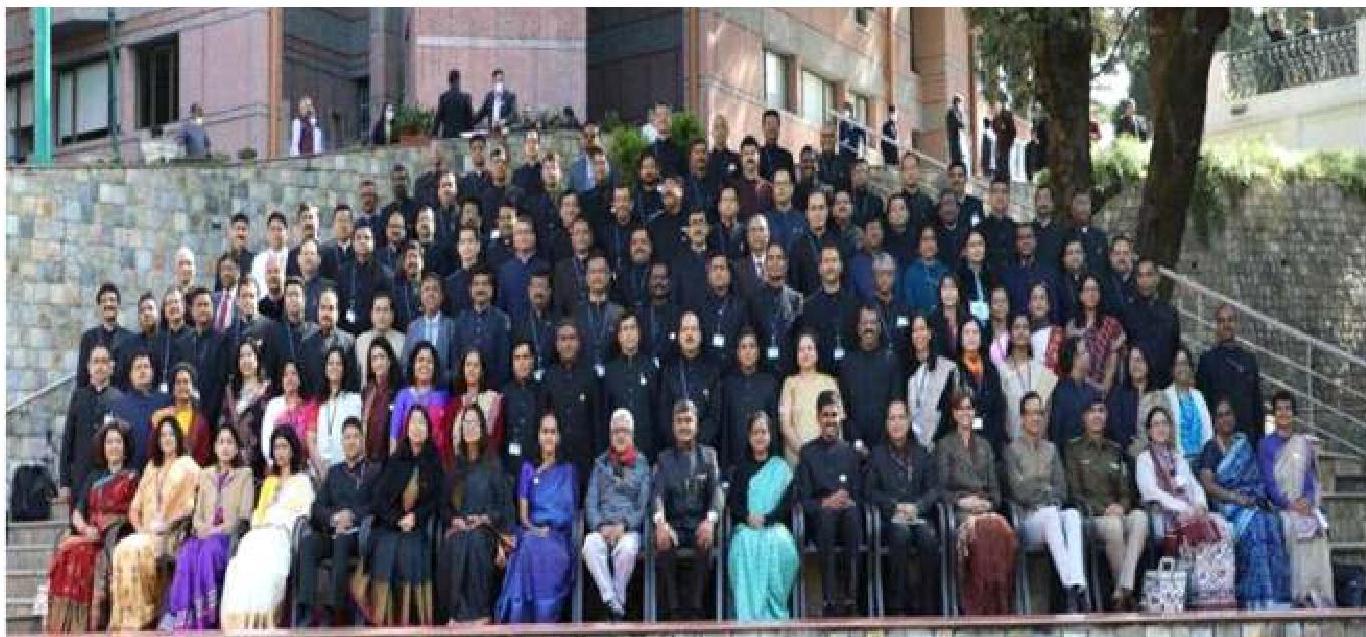
Group Photograph of CMCTP (2001 batch)
8.8 96th Foundation Course
Similarly, the existing pedagogy for Foundation Course was completely overhauled with the beginning of 96th Foundation Course, which is the first Winter Foundation Course ever conducted. This new architecture included the introduction of new outdoor pedagogy, sharp focus on having behavioural aspects of officer trainees and building esprit de corps amongst the 489 newly recruited officers of 19 services.
8.9 Financial Statement of LBSNAA
Budget allocation of LBSNAA is made under “Demand No.073-Ministry of Personnel, Public Grievances & Pensions”. The provision
includes establishment related expenditure under Non-Scheme (Revenue). Infrastructure related expenditure is provided under Scheme (Revenue) and Scheme (Capital). The budget allocation is made for various core activities of the Academy that include training programme such as the Foundation Course, Refresher Courses, Mid-Career Training Programmes etc. Allocations are made under Scheme (Capital) and Scheme (Revenue) for improvement of Infrastructure and upgradation of essential facilities at LBSNAA.
The details of actual expenditure for 2019-20, 2020-21, progressive expenditure for 2021-22 and allocation for upcoming financial year 2022-23 is as under
(Figure in thousands)
| Sl. No. |
Non-Scheme (Revenue) |
Actual Expenditure |
Progressive Expenditure As on 31st January, 2022 |
Budget Allocation |
|
|---|---|---|---|---|---|
| 2019-20 | 2020-21 | 2021-22 | 2022-23 | ||
| 1. | Salaries | $1,68,540$ | $1,62,878$ | $1,47,434$ | $1,92,000$ |
| 2. | Wages | 22,390 | 33,496 | 24,279 | 42,500 |
| 3. | Overtime allowance | 14 | 0 | 0 | 50 |
| 4. | Medical Treatment | 4,200 | 4,480 | 3,729 | 5,500 |
| 5. | Domestic travel expenses | 5,000 | 5,995 | 4,021 | 6,000 |
| 6. | Foreign travel expenses | 117 | 85 | 0 | 500 |
| 7. | Office expenses | 65,589 | 88,960 | 71,616 | 90,000 |
| 8. | Rent, rates \& taxes | 1,492 | 1,999 | 1,440 | 2,000 |
| 9. | Publication | 649 | 350 | 257 | 650 |
| 10. | Other administrative expenses | 200 | 199 | 9 | 200 |
| 11. | Minor works | 1,000 | 1,500 | 1,500 | 2,500 |
| 12. | Professional services | 64,300 | $1,22,494$ | 79,173 | $1,20,000$ |
| 13 | Grant-in-aidOther | 500 | 500 | 0 | 500 |
| 14. | Charges | 3,900 | 5,200 | 2,304 | 4,000 |
| 15. | Salaries | 2,493 | 1,660 | 3396 | 3500 |
| 16. | Overtime allowances | 1 | – | 0 | 100 |
| 17. | Medical treatment | 199 | 31 | 50 | 200 |
|---|---|---|---|---|---|
| 18. | Other Charges (Inf. Tech) | 594 | 596 | 423 | 600 |
| 19. | Swachhta Action Plan | 597 | 590 | 301 | 600 |
| 20. | Professional Services | 44,398 | 9,000 | 27,845 | 60,000 |
| 21. | Total (Non-Plan) | $3,86,173$ | $4,40,013$ | $3,66,284$ | $5,31,400$ |
| 22. | Scheme (Revenue) | $1,10,000$ | $1,09,900$ | 75,902 | $1,20,000$ |
| 23. | Scheme (Capital) | $1,77,500$ | $2,84,430$ | $1,46,058$ | $5,00,000$ |
| Grand Total | $6,73,673$ | $8,34,343$ | $5,88,244$ | $11,51,400$ |
8.10 Research Centres in the Academy
The centres of the Academy have been established with an aim to provide an avenue for initiating research in key areas of governance both from policy as well as implementation perspectives. The research is supposed to feed into the training curriculum and provide it with fresh insights. These centres (like BNYCRS) are mostly funded either by line ministries, or are self-sustaining like the NGCC and CDM and collaborate with various national and international funding agencies. Various Research Centres have been set up for undertaking action-research on domains linked to Academy’s mandate and to feed into training inputs.
8.11 B. N. Yugandhar Centre for Rural Studies (BNYCRS)
Vision: “Help building and promoting an environment for training, research and policy debate on various issues of land, rural development, agrarian movement, livelihood, gender, and panchayati raj.”
Mission:
“Develop training material and manuals for training of Officer Trainees, conducting research studies, organizing workshops and policy seminars, networking with partner organizations and professionals, ensuring publication of journals, research papers, reports etc. and disseminating research based knowledge with a view to help government agencies for policy initiation or changes, and exposing young professional to socioeconomic realities of the country.”
NAME OF CENTRE DIRECTOR
A BRIEF BACKGROUND OF THE CENTRE
B N Yugandhar Centre for Rural Studies (BNYCRS), since its establishment in the Lal Bahadur Shastri National Academy of Administration, Mussoorie in the year 1989, has emerged as a leading resource/ establishment for training of Officer Trainees (OTs) of the Indian Administrative Service (IAS) and policy recommendations. It is mainly funded and supported by Department of Land Resources, Ministry of Rural Development, Government of India. Presently it is registered as a scientific training and research society under the Indian Societies Registration Act 1860. Director of
Ms Anandhi, IAS (Since 21.12.2020)
the Academy is ex-officio Chairperson and he is authorized to appoint any Joint Director, Deputy Director or the Professor as the Centre Director.
The Centre conducts and promotes research, training and publications in the field of land reforms, land records management, wage employment, common property resources, displacement and rehabilitation, contemporary agrarian movements, and various issues of rural development, panchayati raj etc. It fundamentally organises Field Study and Research Programme (Earlier known as Village-Visit Programme) for the OTs during the Foundational Course.
Inputs on Participatory Rural Appraisal (PRA) Techniques are given to the OTs for assessing priorities of villagers to improve their socioeconomic conditions. It is also involved in preparation and canvassing of schedules through OTs during their district training. The data on tenancy, land ceiling, land records, land consolidation, wasteland management, homelessness, rural development programmes including poverty alleviation programmes is captured and used by OTs for preparing socio-economic and land reform reports of assigned villages. Based on these reports the Centre has published a series of ‘Land Reforms in India’ and three series of ‘Socio-Economic Profile of Rural India.’ Other publications of the Centre include books, articles, research papers and most
importantly the peer reviewed Journal of Land and Rural Studies, published by Sage Publications-New Delhi, is an international platform for disseminating and sharing opinions on above mentioned subjects. The Centre is also engaged is organizing workshops for regular exchange of views on land administration and rural development.
ACTIVITIES DURING THE REFERENCE YEAR
(A) Training Programme
The BNYCRS actively participates during the Foundation Courses and IAS Professional Courses organized by the Academy. During the reference year the Centre undertook following training activities:
8.12 IAS Professional Course Phase-I
- Land Administration Module: The Land Administration Modules were delivered as per the design approved by the Academic Council Members (ACM) for 182 IAS Officer Trainees of 2020 Batch.
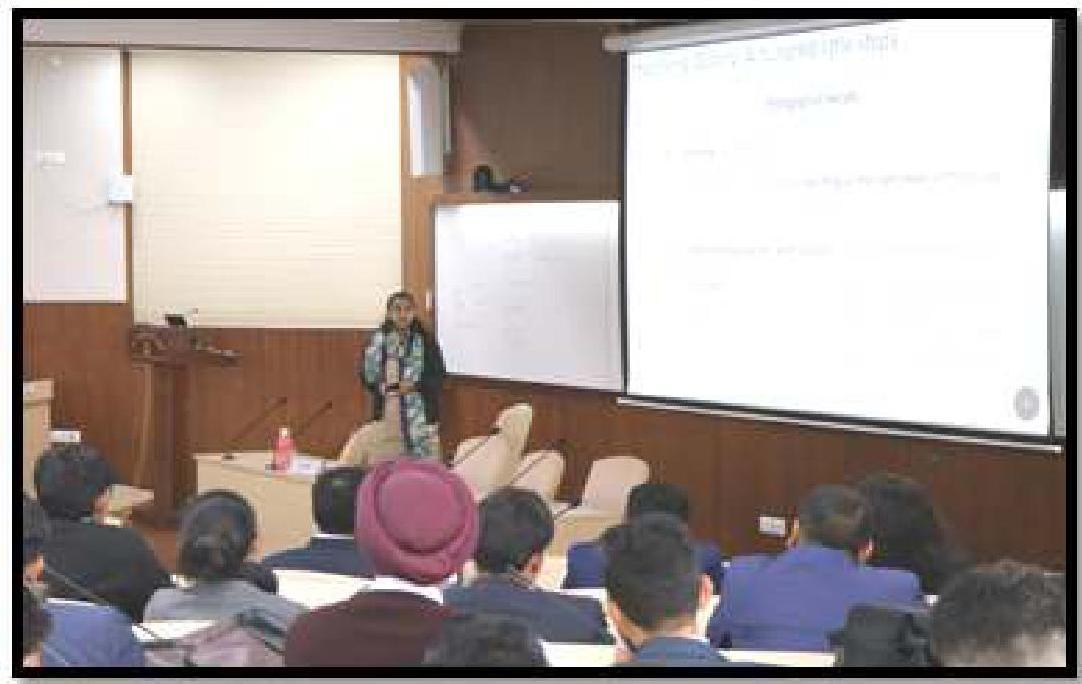
A Class Room Session by Ms Anandhi, Deputy Director (Sr.) & Centre Director, B N Yugandhar Centre for Rural Studies
- Hands-on Training on Land Surveying: The Centre duly coordinating with the Survey of India, Dehradun and District Survey and Settlement Office, Dehradun organised a hands-on training programme on ‘Introduction to Survey Techniques’ for IAS Professional Course Phase-I (2020 Batch). The programme was focused on demonstrating traditional and modern survey equipment and their usability during revenue surveys.
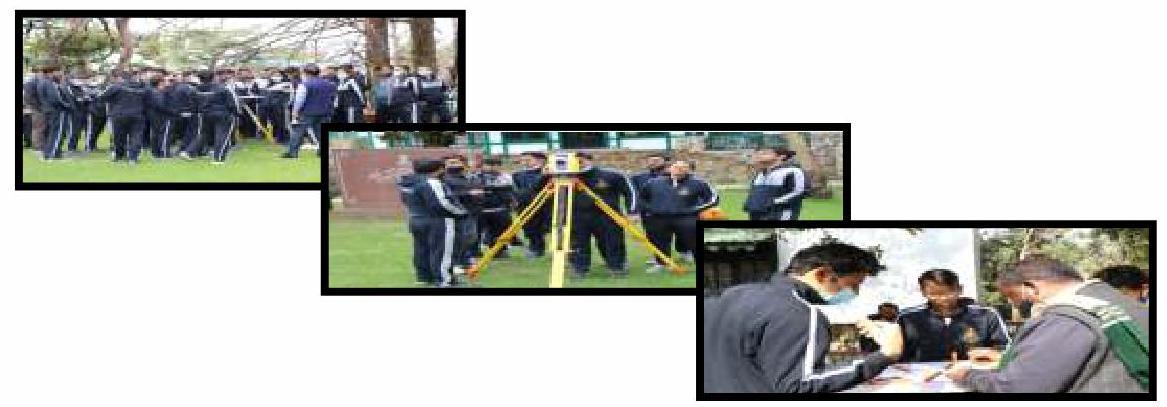
Photographs during Hands on Training on Land Surveying
8.13 Village Study Assignment (VSA) for District Training under IAS Professional Course
- Village Study Assignment (VSA): VSA is major part of the District Training Assignment given to IAS OTs during their training. During the reference year, the Centre had received 182 Socio-Economic (SE) and Land Reforms (LR) Reports from the IAS OTs of 2019-21 Batch. These reports were scrutinised and evaluated for coverage of existing situation, socioeconomic and political analysis and poverty alleviation initiatives. These evaluations play major role in identifying best reports and later used for compiling, editing and publishing as edited volumes on Socio-Economic Profile of Rural India. Until now three series of these volumes have been published.
- Longitudinal Study: Through IAS Officer Trainees (2020-22 Batch) the Centre has conducted longitudinal study in 65 villages duly identifying the villages studied between 1990 to 2009 by the then IAS Officer Trainees. Idea of these longitudinal studies is to observe and capture the pace of development that has taken place in select villages during previous two/three
decades. Various issues like poverty, agriculture, education, health, land reforms and panchayati raj institutions are covered. A comparative and analytical picture those emerge in the reports of IAS OTs may be useful for academics and planning. Various Ministries may monitor impact of their schemes and, if required, redesign them based on the recommendations highlighted in these reports. - Ethnographic Study of Rural Households (ESRH): Schedules executed and Reports/ Case Studies covered under the VSA not only present the development of village/ villagers as a community but also of select households. However, as most of the data is normally time-point based, a longitudinal Ethnographic Study is possible only when same villages and same households are covered at different time-points. It is with this vision that BNYCRS has adopted and designed a research strategy from this year onwards allocating one OT per State the task of preparing on “Ethnographic Study of Rural Households (ESRH)” instead of Case Study on “Poorest of the Poor”. Aim of this qualitative research is to capture ‘everyday lived realities’ of the
households and understand the processes of change within the individual household and track ‘developmental’ changes in ‘community’ at large.
8.14 Field Study and Research Programme (FSRP) for Foundation Course
The Field Study and Research Programme (FSRP) comprises of three activities: classroom inputs, field study, and evaluation of reports, presentations and films submitted by the OTs. During 96th Foundation Course following exercises were done:
a) Planning Phase of FSRP
- Field Study and Research Programme Manual’ was redesigned as reference document for OTs.
- 80 border villages of 16 districts of 4 States (Bihar, Rajasthan, Uttar Pradesh and Uttarakhand) were selected for the conduct of FSRP. Concerned DMs were contacted and requested to coordinate with ParaMilitary Forces to select BOPs.
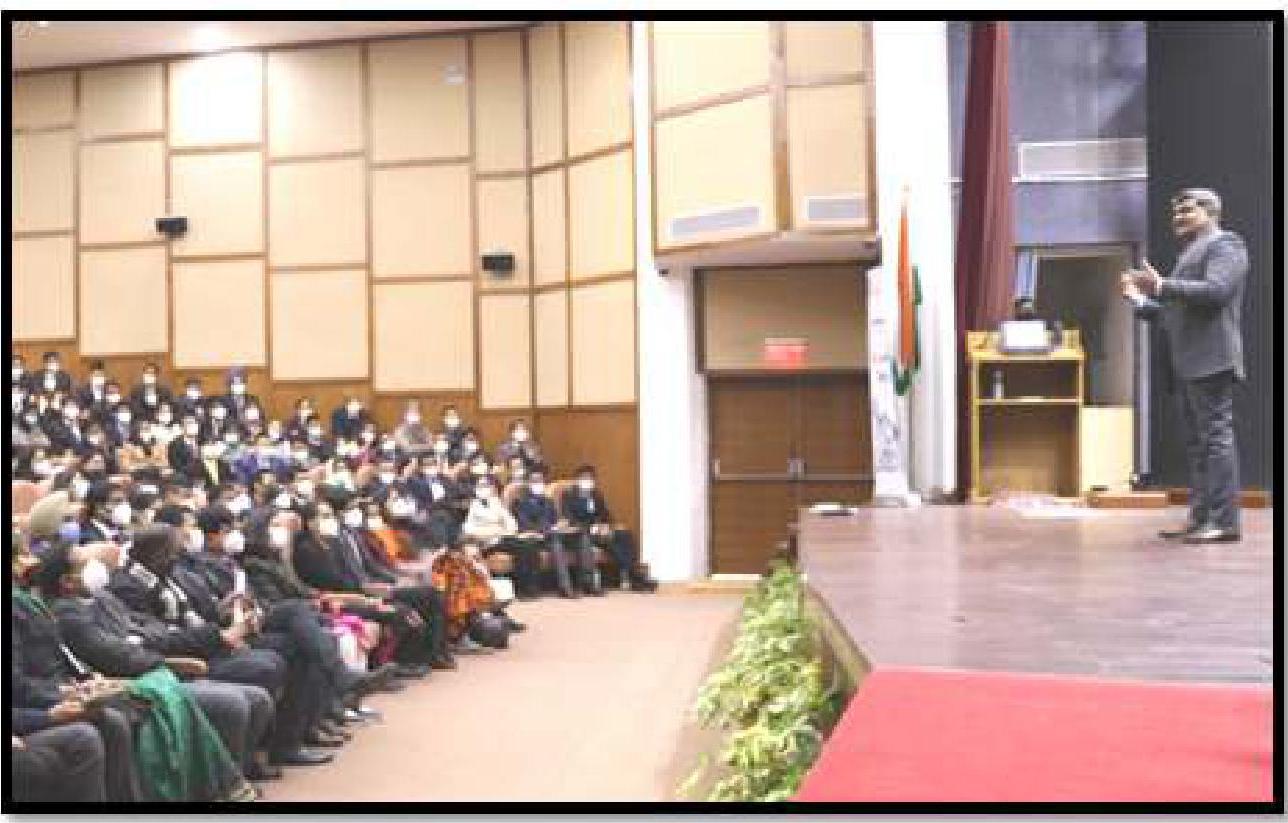
Shri Srinivas R. Katikithala, Director of the Academy addressing OTs during the Briefing Session of FSRP (96th FC)
- Sub-Groups of OTs (6-8 Members per Group) were formed with a Group Leader (GLs) for each District and a Sub-Group Leaders (SGLs) for each village.
- OTs were given inputs on the Participatory Learning and Action (PLA) techniques through class room teachings followed by mock exercises.
b) Execution Phase of FSRP - It was ensured that during the conduct of FSRP OTs would stay in respective villages, interact with villagers & grass-root functionaries and conduct PLA/ FGD exercises. They were also taken to BOPs for petrol and New Year celebrations with Officers and Soldiers of Para-Military Forces.
- Faculty of the Academy and the BNYCRS Officials visited various villages to oversee the activities conducted by the OTs in the field. They also take note of the general behavior and conduct of OTs during their stay in the field.
- Each Sub-Group of OTs prepared a detailed Field Study and Research Report and a Film to depict activities performed with the villagers in the field and also to give an overview of rural life.
c) Completion Phase of FSRP - All the Sub-Groups made presentations based on their field studies. These were evaluated by the Faculty of the Academy and the BNY-CRS Officials.
- The Field Study and Research Reports submitted by various Sub-Groups were evaluated by the BNYCRS Officials. These Reports are now part of the repository maintained by the BNYCRS.
- Select Sub-Groups were awarded Gold Medal, Silver Medal and Bronze Medal on the basis of quality of their presentations and reports.
- Select Sub-Groups were also awarded suitable cash prizes on the basis of the quality and coverage in the Films produced by them. These Films are now part of the repository maintained by the BNYCRS.
8.15 Continuous Engagement with Officers between Phase-II & Phase-III
- During the reference year the BNYCRS chose ‘Forest related Acts and its Impact on Tribal Rights’ as theme to facilitate Officers. Various sub-topics under the broad theme were identified and available reading material (Relevant Acts/ Policy/ Plan/ Advisory etc.) was extracted. Contact details of Officials of the concerned Ministries/Organisations were also listed.
8.16 Research Studies/ Projects
| SI. No. | Title | Status |
|---|---|---|
| 1. | Impact Assessment of Digital India Land Records Modernization Programme (DILRMP) of Goa |
Completed |
| 2. | Impact Assessment of Digital India Land Records Modernization Programme (DILRMP) of Mizoram |
Completed |
| 3. | Impact Assessment of Digital India Land Records Modernization Programme (DILRMP) of Lakshadweep |
Completed |
8.17 Other Research Studies
| SI. No. | Title | Status |
|---|---|---|
| 1. | Status of Implementation of the Scheduled Tribes and Other Traditional Forest Dwellers (Recognition of Forest Rights) Act – 2006 \& Amendment Rule – 2012 in Maharashtra |
Draft report is under progress |
| 2. | Status of Implementation of the Scheduled Tribes and Other Traditional Forest Dwellers (Recognition of Forest Rights) Act – 2006 \& Amendment Rule – 2012 in Himachal Pradesh |
Draft report received. |
8.18 Publications: Current and Forthcoming
| SI. No. | Title |
|---|---|
| Current Publications | |
| 1. | Impact Assessment of DILRMP in Madhya Pradesh |
| 2. | Impact Assessment of DILRMP of Uttar Pradesh |
| 3. | Impact Assessment of DILRMP of Karnataka |
| 4. | Impact Assessment of DILRMP of Bihar |
| 5. | Impact Assessment of DILRMP of Gujarat |
| 6. | Impact Assessment of DILRMP of Sikkim |
| 7. | Impact Assessment of DILRMP of Manipur |
| 8. | Impact Assessment of DILRMP of Uttarakhand |
| Forthcoming Publications | |
| 1. | Impact Assessment of DILRMP of Punjab |
| 2. | Impact Assessment of DILRMP of Rajasthan |
| 3. | Impact Assessment of DILRMP of West Bengal |
| 4. | Impact Assessment of DILRMP of Kerala |
| 5. | Impact Assessment of DILRMP of Maharashtra |
| 6. | Impact Assessment of DILRMP of Mizoram |
| 7. | Impact Assessment of DILRMP of Goa |
| 8. | Impact Assessment of DILRMP of Lakshadweep |
| 9. | Hand Book on Land Survey in India |
| 10. | Socio-Economic Profile of Rural India (Series IV) |
| 11. | Impact Assessment of National Generic Document Registration System (NGDRS) in Punjab |
| 12. | Impact Assessment of National Generic Document Registration System (NGDRS) in Jharkhand |
| 13. | Journal of Land and Rural Studies (Vol. 10, Issue 2: July 2022) |
8.19 Dashboard and Digitization of Old Reports
During the reference year the BNYCRS has started an IT Project with following objectives:
- Creating a single digital repository of the Socio-Economic (SE) Reports and Land Reforms (LR) Reports through digitization of the Reports and the filled-in Schedules submitted by Officer Trainees of various Batches.
- Creation of a well-structured user-friendly Dashboard and database; thereby facilitating administrators in decision making and encouraging researchers/ academicians to utilise it for future research
Idea is to facilitate Administrators in examining the impact of development schemes in their region (State/ District/ Village). They may like taking strategic
decisions for better implementation (if needed). At the same time, individual researchers, academicians, data scientists etc. across globe would find it easy to cull out data for future research, and Institutions/ Universities with whom Academy or its Centres has undergone an MOU may be requested to access the data, conduct research and come out with policy suggestions.
8.20 Journal of Land and Rural Studies
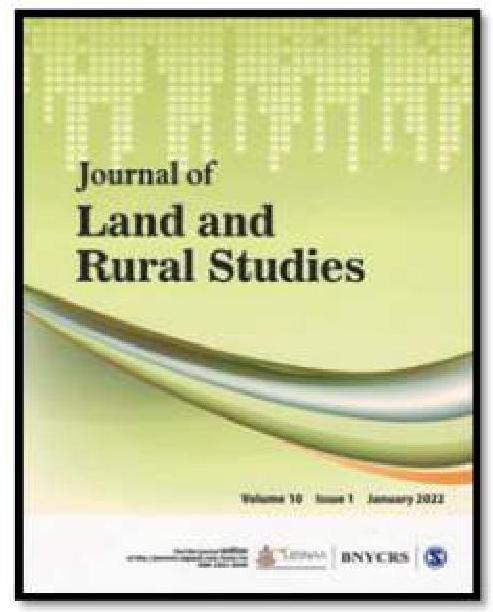
Journal of Land and Rural Studies, a peer reviewed journal, is being published by Sage Publications India Pvt. Ltd. on behalf of the Centre since 2012. It covers articles, policy briefs, working papers, book reviews etc. on topics like land reform, land administration and management, rural development, rural infrastructure and industrialisation, microfinance/credit, etc., and policies, schemes and programmes related to these areas. This journal is a member of the Committee on Publication Ethics (COPE). It is available in Print (ISSN: 2321-0249) and Online (ISSN: 2321-7464). Its tentative circulation, national and international, is around 10,446 at present. Full text usage and downloads from the journal platform during the prior calendar year has been reported as 9,145 .
Following Volumes and Issues of the Journal of Land and Rural Studies have been published during the reference year:
Volume 9 Issue 2 (July, 2021); Article and book reviews included are:
- Land Tenure, Land Property Rights and Adoption of Bio-fortified Cassava in Nigeria: Policy Implications by Kolapo Adetomiwa, Abimbola Esther Iseoluwa and Omilaju Samuel Babatunde
- Distress Migration Among Ultra-poor Households in Western Odisha by S.N. Tripathy
- Unravelling the Multifaceted Development Consequences of Agricultural Land Grabbing on Rural Migrant Women in Ghana by Mohammed Abubakari, Victoria Mensah Nyamadi and Patrick Arhin
- Impact of Improved Agricultural Technology Use on Household Income in Eastern Ethiopia: Empirical Evidence from a Propensity Score Matching Estimation by Muluken G. Wordafa, Jemal Y. Hassen, Getachew S. Endris, Chanyalew S. Aweke, Dereje K. Moges and Debbebe T. Rorisa
- Irrigation and Inclusiveness in Heath: A Study of Two Villages in North East Karnataka by Suma Scaria
- Availability and Spatial Inequality of Rural Infrastructure in Jungle Mahal Blocks of Purulia District, India by Uttam Kumar Patra and Suman Paul
- Securing Insecure Livelihoods Through Group Synergies: The Case of Violent Namatala Transboundary Wetland in Rural Eastern Uganda by Constance Mudondo, Robert Kabumbuli and Dauda Waiswa Batega
- Climate Change Adaptation in Akropong, Ghana: Experiences of Female Smallholder Farmers by Michael Addaney, George Effah Sarpong and Jonas Ayarbilla Akudugu
- APJ Abdul Kalam & Srijan Pal Singh’s book ‘Target 3 Billion (PURA: Innovative Solutions Towards Sustainable Development)’ is reviewed by Bhaskar Kumar Kakati
Volume 10 Issue 1 (Jan, 2022); Article and book reviews included are:
- The Process and Shortcomings in Paddy Procurement: A Case Study of Bhandara District of Maharashtra by Minal Karanwal*
- Land Governance in Fifth Schedule Areas: A Critical Analysis of Chhattisgarh State by Nayakara Veeresha
- Development, Prosperity and Aspirations: A Narrative from the Peri-Urban Areas of Noida by Bhawna Bali and Neha Bhatia
- The Role of Financial Inclusion in Eliminating Household Poverty: Evidence from the Rural Wa West District of Ghana by Adams Nuhu Timbile and Richard Angelous Kotey
- What Is the Nature of Women’s Tenure Security in Sub-Saharan Africa Rural Land Markets? Some Evidence from Nigeria by $O$. Olayemi Soneye
- Land-use Dynamics in Lupila Ward of Makete District in Southern Highlands of Tanzania by Faraja Sanga, Emma T. Liwenga and Evaristo Haulle
- Katharina Pistor’s book ‘The Code of Capital Reviewed’ is reviewed by C. E. Ajith Kumar
- NOTE: From the reference year onwards BNYCRS has started publication of Dissertations submitted by the Officer Trainees in partial fulfilment of the requirements for the completion of IAS Professional Course Phase-II. Awarded Dissertations are abridged and re-written by the concerned Officer Trainees in the form of research papers. This paper by an Officer Trainee of 2019-2021 Batch is a result of the same exercise.
8.21 Centre for Disaster Management (CDM)
Centre for Disaster Management (CDM) is a research and training centre and a unit of Lal Bahadur Shastri National Academy of Administration (LBSNAA), Mussoorie, Department of Personnel & Training (DoPT), Government of India. It was established in the
year 2003, and registered as autonomous society under Societies Registration Act (Reg.No-199/2007-2008 Dt. 26-05-2007). The Centre is involved in training of Civil Service Officers (the IAS and other Group-A Civil Services) at induction as well as at MidCareer level in various aspects of disaster mitigation (policy, planning, programme formulation and implementation) through classroom sessions, case studies, experience sharing presentations, panel discussions, workshops, mock drills, besides undertaking action research projects, the centre was also involved in publication activities such as documentation of best practices, development of case studies, books, and development of IEC materials in the area of Disaster and Emergency management and Science and Technology.
Since 2007, the Centre is also engaged in conducting a number of tailor-made training programmes under the XIth Five Year Plan for the Plan Scheme “National Programme for Training of Scientists \& Technologists working in the Government Sector” in collaboration with the Department of Science \& Technology, Government of India, New Delhi. Hundreds of Scientists and Technologists across the country have got exposed to the training environment of this premier institute with its unique pedagogical approach. The Centre was supported by the Ministry of Home Affairs since 2012-13. The CDM has been receiving support from National Disaster Management Authority (NDMA), Government of India, New Delhi under the Project entitled “Capacity Building on Disaster Management for IAS/ Central Civil Services Officers”.
A. Inputs on major initiatives/ achievements of CDM for the Development and Management of Human Resources
CDM, LBSNAA has successfully conducted the following online training programmes for IAS/ Central Civil Services Officers and Scientists \& Technologists working in Government Sector.
i) Climate Change: Challenges and Response for Women Scientists (09 – 13 August 2021)
| Programme meant for/ Target Group |
Women Scientists and Technologists working in the Government sector |
|---|---|
| Course coordinator | Shri Abhiram G. Sankar, IAS Deputy Director & Director, CDM Lal Bahadur Shastri National Academy of Administration |
| Associate Course Coordinator |
Dr. Pankaj Kumar Singh Associate Professor, CDM Lal Bahadur Shastri National Academy of Administration |
| Course Inaugurated by | Smt. Anju Bhalla, CSS Joint Secretary, Department of Science \& Technology, Government of India, New Delhi |
| Valedictory Address by | Shri Abhiram G. Sankar, IAS Deputy Director \& Director, CDM Lal Bahadur Shastri National Academy of Administration |
| Total no. of Participants | Total: 56 (Female: 56) |
| Scheme | XI Five Year Plan Scheme “National Programme for Training of Scientists and Technologists working in government sector” in collaboration with Department of Science \& Technology, Govt. of India, New Delhi. |
Objectives of the Training Programme:
- to discuss Climate change and changing thresholds;
- to deliberate on the mechanisms (tools, frameworks, methodologies, action plans, guidelines);
- to discuss emerging issues, Challenges and Policies
- to examine the adequacy of existing legal, institutional frameworks and recent developments;
- to identify the policies, governance and planning and coordination mechanisms for inclusive climate resilience;
- to collate information and exchange technical knowledge/ experiences and information for climate change mitigation and adaptation;
- to discuss learnings and recommendations for future course of action;
- to suggest future strategies, policies and options; and
- to facilitate peer and involved learning to achieve the objectives of Paris Agreement, Sustainable Development Goals (SDGs) and Sendai Framework for Disaster Risk Reduction (SFDRR).
Thematic Areas:
- Water Security
- Biodiversity Loss \& Ecological Imbalances
- Food security
- Climate Refugees
- Tectonic Shifts in Geopolitics
- Role of Technology
- Disaster Risk Reduction
ii) Customized Regional Training Programme on “Management and Mitigation Strategies for Cyclone Risk Reduction (29th September, 2021 to 1st October, 2021)
| Programme meant for/
Target Group | IAS/ Central Service Officers in India (Secretary/ Joint Secretary (Disaster Management Department), District Magistrates/ Deputy Commissioners, Additional District Magistrates/ Additional Deputy Commissioners, Sub-Divisional Magistrates from multi hazard prone districts) |
| — | — |
| Course coordinator | Shri Abhiram G. Sankar, IAS
Deputy Director & Director, CDM
Lal Bahadur Shastri National Academy of Administration |
| Course Inaugurated by | Shri Suresh Chandra Mahapatra, IAS Chief Secretary to the Government of Odisha
Shri Pradeep Jena, IAS Development Commissioner-cum-Additional Chief Secretary and Managing Director, OSDMA Government of Odisha |
| Valedictory Address by | Shri Srinivas R Katikithala, IAS Director,
Lal Bahadur Shastri National Academy of Administration
Smt. Radhika Rastogi, IAS Joint Director, Lal Bahadur Shastri National Academy of Administration |
| Total no. of Participants | Total: 32 (Gentlemen-24; Ladies- 8) |
| Project details | “Capacity Building on Disaster Management for IAS/ Central Civil Services Officers” |
Objectives of the Training Programme: The aim of the programme was to enhance the knowledge and understanding of the participants about the principles and concepts of management and mitigation strategies for cyclone risk reduction and to provide skills to enable a quick and efficient disaster response. The training programme included both classroom sessions as well as field visits for experimental learning. The training programme intended to provide specialized orientation to officers on prevention, mitigation, preparedness, planning, response, build back better in recovery, rehabilitation and reconstruction strategies through field visits, presentation and group activities on best practices and learning in cyclone risk reduction. The 03 (three) day Customized Regional Training Programme for IAS Officers on “Management and Mitigation Strategies for Cyclone Risk Reduction” was organised from 29th September to 1st October, 2021 at Madhusudan Das Regional Academy of Financial Management (MDRAFM), Chandrasekharpur, Bhubaneswar, Odisha. The programme was a part of the ‘Azadi Ka Amrit Mahotsav’, commemorating 75 years of India Independence,designed especially for the IAS officers serving as DM/ADM/SDM from 09 Coastal States and 4 Union Territories of India. The three-day training programme
was organised by the Centre for Disaster Management (CDM), Lal Bahadur Shastri National Academy of Administration, Department of Personnel & Training (DoPT), Government of India in association with Odisha State Disaster Management Authority (OSDMA), Government of Odisha, under the National Disaster Management Authority (NDMA), Government of India scheme titled “Capacity Building on Disaster Management for IAS/ Central Civil Services Officers”.
While the class room sessions were held in the training hall of Madhusudan Das Regional Academy of Financial Management (MDRAFM), Chandrasekharpur, Bhubaneswar, the practical demonstrations and field sessions were organised at the State Emergency Operation Centre (SEOC), Rajiv
Bhawan, Bhubaneswar; Odisha Disaster Rapid Action Force (ODRAF) unit of OSAP 7th Battalion, Bhubaneswar; field site at Ramchandi near Puri and at Tikana Multipurpose Cyclone Shelter (MCS) of Khalkata Patana Gram Panchayat under Gop Block of Puri district. Participants were provided with boarding and lodging facilities at MDRAFM, Chandrasekharpur, Bhubaneswar during the entire period of training programme.
25 IAS Officers serving in different positions in 8 States -Andhra Pradesh, Goa, Karnataka, Kerala, Maharashtra, Odisha, Tamil Nadu, Gujarat and 01 UT- Dadra and Nagar Haveli and Daman and Diu and 1 NE region (Tripura) participated in the training programme.
iii) Role of Technology in Community Level Disaster Mitigation for Scientists \& Technologists (08-12 November 2021)
| Programme meant for/ Target Group |
Scientists and Technologists working in the Government sector |
|---|---|
| Course coordinator | Shri Abhiram G. Sankar, IAS Deputy Director \& Director, CDM Lal Bahadur Shastri National Academy of Administration |
| Associate Course coordinator |
Dr. Pankaj Kumar Singh Associate Professor, CDM Lal Bahadur Shastri National Academy of Administration |
| Course Inaugurated by | Shri Anil K. Sinha, IAS (Retd.) Hony. Chief Editor, Know Disasters \& Sr. Advisor, CDM, LBSNAA Founder Vice Chairman, Bihar State Disaster Management Authority (BSDMA), Patna |
| Valedictory Address by | Shri Abhiram G. Sankar, IAS Deputy Director \& Director, CDM Lal Bahadur Shastri National Academy of Administration |
| Total no. of Participants | Total: 24 (Male-17; Female 7) |
| Scheme | XIth Five Year Plan Scheme “National Programme for Training of Scientists and Technologists working in Government Sector” in collaboration with Department of Science \& Technology, Govt. of India, New Delhi. |
Objectives of the Training Programme:
- to deliberate on the mechanisms (various tools and techniques) for enabling community level disaster mitigation.
- to discuss emerging issues, Challenges and policies related to Climate change
- to provide exposure on effects of disasters on Various Socio-economic sectors and livelihoods integrating
- to provide exposure on Role of Science and Technology in Community level Disaster Risk Mitigation Planning
- to identify the policies, governance and planning and coordination mechanisms for inclusive disaster resilience
- to collate information and exchange technical knowledge/ experiences and information for climate change adaptation and Disaster Risk Reduction.
- to discuss learnings and recommendations for future course of action
- to suggest future strategies, policies and options
- to facilitate peer and involved learning to achieve the objectives of Paris Agreement, Sustainable Development Goals (SDGs) and Sendai Framework for Disaster Risk Reduction (SFDRR).
Thematic Areas:
- Governance in Science and Technology
- Science and Technology for Rural Communities
- Role of Technology in Community level Disaster Risk Mitigation
- Gender Mainstreaming
- Climate Change Adaptation and Disaster Risk Reduction
- Participatory Learning and Action (PLA)
iv) Climate Change: Challenges and Response for Scientists & Technologists (20 – 24 December 2021)
| Programme meant for/ Target Group |
Scientists and Technologists working in the Government Sector |
|---|---|
| Course coordinator | Shri Abhiram G. Sankar, IAS Deputy Director \& Director, CDM Lal Bahadur Shastri National Academy of Administration |
| Associate Course coordinator |
Dr. Pankaj Kumar Singh Associate Professor, CDM Lal Bahadur Shastri National Academy of Administration |
| Course Inaugurated by | Dr Akhilesh Gupta Sr. Adviser \& Head \& Nodal officer for COVID-19 (Actions/Key Decisions), Department of Science \& Technology (DST), Govt. of India |
| Valedictory Address by | Dr. Ekta Uniyal Assistant Director, CDM Lal Bahadur Shastri National Academy of Administration |
| Total no. of Participants | Total: 34 (Male-29; Female: 5) |
| Scheme | XI Five Year Plan Scheme “National Programme for Training of Scientists and Technologists working in government sector” in collaboration with Department of Science \& Technology, Govt. of India, New Delhi. |
v) In-house sensitization/ capacity building modules on Disaster Management for various Courses:
CDM inducted various capacity building modules on Disaster Prevention/Mitigation, Preparedness & Planning, Response \& Build Back Better in Recovery, Rehabilitation and Reconstruction and disaster management drills to sensitize participants of 123rd Induction Training Programme (ITP), IAS Phase- I (2020 Batch), IAS Phase- II (2019 batch), and 15th MCTP Phase- IV Programmes. Till now a total of 511 Officers have been sensitized under the “Capacity Building on Disaster Management for IAS/ Central Civil Services Officers” scheme of National Disaster Management Authority (NDMA), Government of India for the F.Y. 2021-22 till date. Course specific training/reading materials for capacity building were prepared and distributed to the participants of various courses. Modules on Disaster \& Emergency Management (13 \& 14 Jan, 2021), COVID-Case Study (24-12-2020) by Abhiram G. Sankar, IAS and Role of Effective Communication in Crisis Management (25-02-2021) by Abhishek Singh, IAS (CEO, MyGov) were inducted to Phase – I Officer Trainees. A session on Disaster Management was delivered by Abhiram G. Sankar, IAS to the Trainees of 123rd Induction Training Programme on 13-04-2021.
A session on “Disaster Risk Reduction- Case Study on Cyclones” by Sri Pradeep Jena, IAS on 11-02-2021 \& a Session on “Managing Big Events” by Sri Vijay Kiran Anand, IAS on 23-12-2020 were hosted during Phase I Training Programme (2020 Batch). A session on “Disaster Risk Reduction” by Dr. V. Thiruppugazh, IAS on 21-05-2021; as session on “Decision Support Systems (Geospatial Technologies) for Disaster Risk Mitigation \& Planning by Dr. Harish Chandra on 21-052021; a session on “Management of Disaster Situations in the District” by Sri Kapil Shirsat, IAS on 15-06-2021 and a session on “Tackling COVID: Case Study of Mumbai” by
Sri Iqbal Singh Chahal, IAS on 18-06-2021 were hosted during Phase II Training Programme (2019 Batch). A session on “Disaster Management: Planning \& Policy” by Sri S. N. Pradhan, IPS on 04-08-2021 was hosted during to 15th MCTP Phase- IV Training Programme. Sensitization modules on Disaster Management will be scheduled shortly for the Officer Trainees of 96th Foundation Course (FC).
B. Inputs on initiatives taken for staff welfare, capacity building/ training
HAM Radio Training Programme for Officer Trainees of Phase I: 2020 Batch was organized by Centre for Disaster Management (CDM), Lal Bahadur Shastri National Academy of Administration from 04-03-2021. A total of 14 officer trainees voluntarily participated in this training programme.
C. Publications
Developed Course Specific training and reading materials and distributed to the Officer Trainees of the above-mentioned training programmes:
a) Basics of Disaster Management
b) Legal Framework of Disaster Management
c) District Disaster Management Planning
d) Incident Response System
e) Public Health Emergency Management (COVID 19)
f) Role of Technology in Disaster Management
g) Role of Technology in Community Level Disaster Mitigation
h) Climate Change: Challenges and Response
D. Research \& Case Studies
As part of the Continuous Engagement with the officers posted in filed level assignments, CDM has collected the following case studies during the F.Y. 2021-22.
1) Mitigation and Management of Cyclone YASS
2) Mitigation and Management of Cyclone TAUKTAE
8.22 Upcoming activities of Centre for Disaster Management (CDM)
A. Inputs on major initiatives/ achievements of CDM for the development and management of Human Resources
The following are the upcoming programmes to be held in between 1st January, 2022 – 31st March, 2022 by CDM.
| Details of the upcoming Training Programme/ Workshop | Target Group | Proposed Date | Mode of Training & Venue |
|---|---|---|---|
| Training programme on “Role of Technology in Community Level Disaster Mitigation” | Scientists \& Technologists working in the Govt. Sector | $\begin{gathered} \text { 07-11 } \ \text { February } 2022 \ \text { (5 days) } \end{gathered}$ | Online |
| Specialized Training Programme on “Governance for Flood and Drought Resilience: Land and Water Management Practices” | Mixed Cohort of Administrators, Policy Makers, Scientists, and Domain Experts | Dates not yet finalised | Offline (Indira Bhavan Complex) |
| Annual Orientation programme on “Disaster Risk Reduction and Resilience” | Joint Secretaries (Nodal Officers for Disaster Management) in Ministries/ Departments of Gol | Dates not yet finalised | Offline (Main Campus, LBSNAA) |
| Target based customized Training Programme on “District Disaster Management Plan \& Incident Response System” | IAS/CCS officers | Dates not yet finalised | Offline (Indira Bhavan Complex) |
| Target based customized regionalTraining programme on “Mitigation and Management of Disasters in High Altitude Areas” | IAS/CCS officers | Dates not yet finalised | Offline (Indira Bhavan Complex) |
| ToT on Developing Local Level DRR Strategies and Plans for Urban Risk Reduction | Representatives from Local government officials and Trainers from National Institutes/ Academies and ATIs | Dates not yet finalised | Offline (Main Campus, LBSNAA) |
B. Inputs on initiatives taken for staff welfare, capacity building/ training
i) HAM Radio Training Programme for Officer Trainees of Phase I: 2021 Batch
ii) Fire Safety and Search \& Rescue Mock Drill for Academy Staff \& 96th FC
iii) Providing orientation to OTs of 96th FC on operation of wireless communication sets and GPS during Himalayan Study Tour
C. Publications
- Special Publication Series “CoVID-19 Governance in India” ISSN: 978-81-928670-7-6, 2022 (7 Volumes) (In Progress)
In the light of COVID 19, it is imperative that each officer trainee at the academy has a clear understanding of public health emergency management and exposure to its governance aspects. As directed by Centre Director, this initiative was taken forward under Continuous Engagement with the officers posted in filed level assignments and a total of 77 manuscripts/ case studies were received by CDM related to 1st and 2nd Wave of Covid 19 management strategies/ interventions. Now, CDM would like to bring the special publication series entitled “COVID19 Governance in India” (ISSN: 978-81-928670-7-6, Series 8, 2021) in 7 volumes, each volume consist of 11 manuscripts after the process of reviewing and editing of these manuscripts by a core group of expert editorial members headed by Dr. V. Thiruppugazh IAS (retd), Former Additional Secretary (policy & planning), National Disaster Management Authority (NDMA), Government of India as Chief Editor. These series of publications will be used as training resource to enrich the knowledge of officer trainees at the Academy. - Journal on “Disaster: Response and Management” ISSN: 2347-2553, Volume-9, Issue-I, 2022 (In Progress)
- Case study book series “Disaster Governance in India” ISBN: 978-81-928670-8-3, Series 8, 2022 (In Progress)
- Toolkit on Disaster Risk Reduction for CIVIL SERVICE OFFICERS OF INDIA (For 96th Foundation Course) – 2nd Edition (In Progress)
8.23 National Gender \& Child Centre (NGCC)
The Centre was established in 1995, with the foremost aim of mainstreaming gender and child rights in policy, programme formulation and implementation in Government. NG\&CC is a capacity building centre under the aegis of
the Academy, driven by the mandate of gender main streaming and its commitment to build synergies with different institutions, working on gender equality, child rights and women’s empowerment.
Working towards that end, the Centre, since inception has been actively involved in designing and conducting thematic workshops, programmes and trainings including Training of Trainers for trainers and policy makers – both to enhance gender sensitization but also to increase capacities for gender analysis and gender planning. Since the Centre was established, the Centre has successfully ensured the mainstreaming of gender training into all courses at the LBSNAA viz. Induction trainings and inservice mid-career training programmes for IAS officers at all levels besides conducting programmes on myriad aspects for officers from All India/ Central Services.
In 2021-2022, the following projects/activities were undertaken by the Centre:
a) Training Programmes for Protection Officers in Addressing Domestic Violence
The Training Programmes (four sets of one week intensive programmes) for Protection Officers in Addressing Domestic Violence were organized by the National Gender and Child Centre (NG\&CC), Lal Bahadur Shastri National Academy of Administration and National Commission of Women (NCW), New Delhi.
The Project was designed, developed and rolled out by the Centre highlighting the evident and subtle reasons for domestic violence and provided the PO’s a clear framework of their roles and responsibilities given under the Act. Experts on the subjects were invited who guided the PO’s on all the Acts provisions, including the landmark judgements. The virtual training programmes were organized on:
- Uttar Pradesh (Batch 1) – 28th June to 2nd July, 2021
- Haryana-5th to 9th July, 2021
- Uttar Pradesh (Batch 2) – 12th -16th July, 2021
- Uttar Pradesh (Batch 3) – 26th to 30th July, 2021
b) Training Module on Addressing Domestic Violence:
Basis the Training Programme for Protection Officers in collaboration with NCW, a Training Module has also been designed to strengthen the capacities of Protection Officers in the prevention of domestic violence and addressing the challenges they face on-theground in implementation of the related legal provisions. The module is a result of the consolidated feedback, shared learnings and best practices shared by the participants over the course of the training programmes. Developed for the purpose of trainings of PO’s, the module is a ready reckoner for facilitators, trainers, and institutions to leverage and build capacities of Protection Officers across states.
c) Case Studies on Violence against Women & Children (VAW\&C):
The National Gender and Child Centre have developed a compendium of case studies on violence against women and children. Each case study is accompanied by detailed teaching notes that act as a guiding light for the instructors. This compendium was circulated to Ministry of Women and Child Development, Department of Personnel \& Training, National Commission for Women, National Commission for Protection of Child Rights and all State Commissions for Women, State Commissions for Protection of Child Rights, WCD \& Social Welfare Departments for their knowledge of challenges and strengths in implementing the Acts and Rules besides enhancing their overall understanding of the subject.
d) Workshop on Stepping up to Tackle the Nutrition Challenges – with focus on POSHAN Abhiyaan on 07th October, 2021:
In the context of India celebrating Poshan Maah, the National Gender \& Child Centre (NG\&CC), Lal Bahadur Shastri National Academy of Administration, Mussoorie, had organised a workshop on “Stepping up to Tackle the Nutrition Challenges – with focus on POSHAN Abhiyaan” on 07th October, 2021. The objective of the programme was to drive awareness and dissemination of information regarding the importance of nutrition challenge and early childhood development.
e) Towards an inclusive Society:
In the ongoing 96th Foundation Course for the Officer Trainees, the National Gender and Child Centre has developed, designed and rolled out the session on Gender Sensitisation, under the deconstruction module.
Ongoing Projects of NGCC:
8.24 Project on Capacity Building of duty holders for effective implementation of Juvenile Justice Act 2015 in India:
A 3 weeks online course is being designed and developed on JJ act for duty holders. Each week would cover one module, covering a specific dimension of the topic for the module. At the end of each week/module, there would be an evaluation to measure learnings vis-à-vis the expected outputs of all modules would be necessary for a certificate. The module will be hosted on the Gyan Portal of the Academy and going forward may be made available on I-got platform of the government as well.
8.25 Centre for Public Systems Management (CPSM)
Training Programme on Arbitration held on 02nd – 03rd September 2021 for Senior Officers at LBSNAA, Mussoorie
| Programme Coordinator | Ms. Monika Dhami, Coordinator CPSM |
|---|---|
| Number of Participants | Total: 29 (Male: 16; Female: 13) |
| Course Inaugurated by | Mr. R. Anand, Director, Nani Palkhivala Arbitration Centre |
Resource Person from Nani Palkhivala Arbitration Centre
- Sh. Shreyas Jayasimha
- Sh. Arjun Krishnan
- Ms. Renu Gupta
- Sh. Rishi Kumar Dugar
- Sh. N.L. Rajah
Organising Partners
- LBSNAA in collaboration with Nani Palkhivala Arbitration Centre
Participants
- Senior Officers at the rank of Joint Secretary and above from various Ministries /Departments and Faculty, Research Fellows and Teaching Associates of LBSNAA.
Aim of the training programme
The aim of the programme was to enhance the understanding of the participants about the principles and concepts of Arbitration. This short course had sessions focusing on different nuances of dispute resolution through arbitration.
Course Activities, Inputs and Highlights
The course content includes Alternative Dispute Resolution – Essential principles relating to Arbitration, Mediation and Conciliation, Highlights of Legal Service Act, 1987, General Principles of Contract, Drafting of Contract Clauses, Interpretation of Contracts, Contracts in Arbitration Disputes, History of Arbitration Law; Basic Principles relating to Arbitration Proceedings, Salient features of Arbitration and Conciliation Act 1996, Procedural requirement for termination of Contracts, Law relating to determination and Levy of damages, Advantages of Institutional Arbitration, Drafting effective Arbitration Clauses, Effective control of costs in arbitration proceedings, Interplay between arbitration law and Commercial Courts Act, Cross-border insolvency, Insolvency & Bankruptcy Code, Adopting Institutional Arbitration procedures in Ad-hoc arbitrations, Mediation-Arbitration in Institutional Arbitrations, Enforcement of Domestic/International arbitral awards, Interim relief. The methodology used in the training programmes includes, case laws and discussion.
Training Programme on Arbitration conducted by Centre for Public Systems Management in collaboration with Nani Palkhivala Arbitration Centre $\left(02^{\text {nd }}\right.$ and $3^{\text {rd }}$ September, 2021)
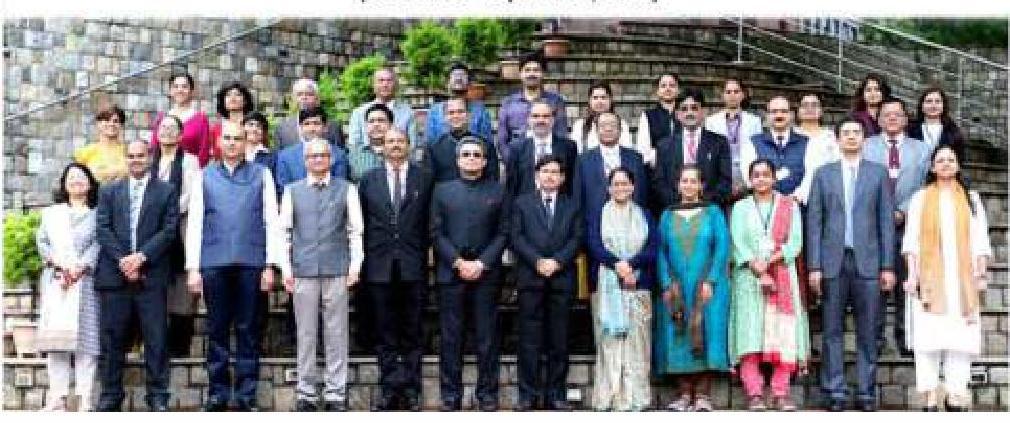
8.26 Sardar Patel Leadership Centre (SPLC)
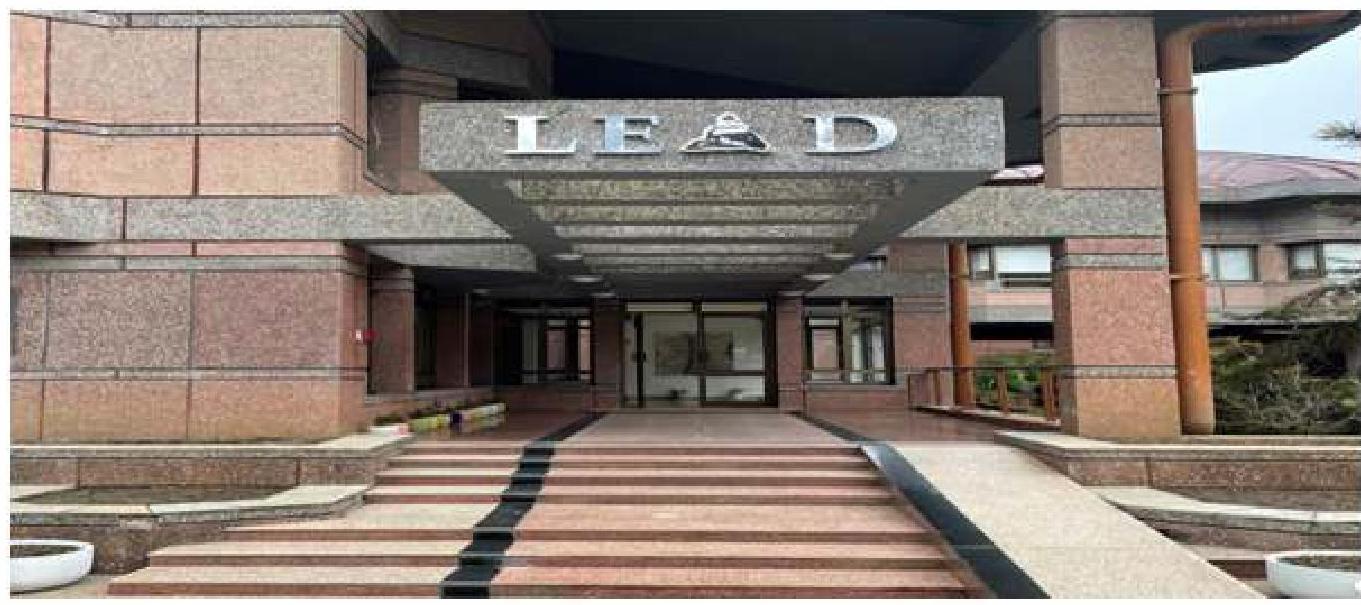
Sardar Patel Leadership Centre was inaugurated on 31 October, 2021 by Hon’ble Union Minister of State Science & Technology; Minister of State Earth Sciences; MoS PMO, Personnel, Public Grievances, Pensions, Atomic Energy and Space, Dr Jitendra Singh and dedicated this centre to the nation at Lal Bahadur Shastri National Academy of Administration on the occasion of Rashtriya Ekta Diwas, marking the birth anniversary of Sardar Vallabhbai Patel.
The Centre aims to lay the foundation capacity building for future generations of Civil Servants so that they learn from the best practices of leadership across the world while at the same time they remain connected with their cultural ethos, values and roots. He added that Good governance needs good leadership skills among the field officers as well as officers at the policymaking level. The Sardar Patel Leadership Centre aims to be Resource Centre to provide continuous study and learning opportunities to Civil Servants from India.
The objective behind this centre’s establishment is to enable a civil servant to constantly remain in touch with Sardar Patel Leadership Center, an entity that can provide them with upgraded skills and guidance for their own personal pathways.
The following workshops and Training of Trainers (ToT) were conducted:
- 1st Common Mid-Career Training Programme (CMCTP)-LEAD -26th -2nd November, 2021: The 1st round of CMCTP was conducted for 2000 and 2001 Batch IAS Officers. This programme aimed at bringing together officers from different services to head important government organizations with the aim of enhancing each other’s leadership capacities and instill a sense of national pride, mission and camaraderie among its participants which will enable all to lead their teams to learn, build and deliver on national aspirations and goal. It’s objective was to discover and enhance the next level leadership capacities.
- 27th December, 2021: A workshop was conducted for brainstorming about the design and delivery of leadership modules for various courses. The objective of this workshop was to identify the leadership competencies required at various levels of training and how these competencies can be addressed from leadership course offered by reputed organizations. In this workshop, the entire faculty members discussed and identified the competencies
for various levels of courses and drafted the leadership modules for each course. This workshop was attended by 19 outside experts (online & off-line) and in-house faculty.
- 18th – 19th January, 2022: Online ToT on Inclusive Leadeship was conducted and attended by outside experts and in-house faculty. This was subsequent to the leadership workshop conducted on 27th December, 2021.
- 18th -20th February, 2022: A refresher Training of Trainers (ToT) is scheduled for faculty and outside experts before conducting final leadership modules for the Officer Trainees of 96th Foundation Course with the objective to revise the concepts for the experienced facilitators and to help the new faculty members in understanding the concepts. The ToT will be conducted offline as well as online.
- 21st- 22nd February, 2022: The Leadership Module is scheduled for the Officer Trainees of 96th Foundation Course which will be conducted by outside experts and in-house faculty. The objective this module is to enhance the leadership skills needed at all levels.
8.27 Facilities at the Academy
The Academy is well-equipped with good training infrastructure in terms of academic buildings, classrooms, hostels and other support infrastructure. The Academy has the following Academic and Administrative Blocks:
o Karmashila
o Dhruvshila
o Gyanshila
o Aadharshila
The Gandhi Smiriti Library in the Academy has a stock of 1.71 lakh books and provides access to its users of 279 journals /magazine/newspapers and 7 e-resource databases. For accommodating the trainees and participants of various training programmes the Academy has seven hostels namely, Ganga, Narmada, Kaveri,
Silverwood, Mahanadi, Happy Valley and Valley View with a total capacity of 299 rooms. The Officers’ Mess can cater to around 500 people at three different locations. To encourage the trainees to take up physical activities, Academy has a well-equipped Officers Club, Riding Ground and Shooting Range. Medical Centre and AYUSH Centre are functioning in the Academy to cater to the requirements of officers, staff and participants of different training courses.
During 2021-22, the following works were being undertaken through CPWD under the scheme Capital of this Academy to enhance the ambience of LBSNAA campus to facilitate better learning environment for the Officer Trainees \& participants of senior course:
- Constructions of 04 No. Type – V Quarters: (Approved Budget: 488.47 Lakh)
- Construction of New Sports Complex: (Approved Budget: 1524.10 Lakh)
- Construction of New Auditorium: (Approved Budget: 4890.47 Lakh)
- Construction of Executive Hostel: (Approved Budget: 3348.57 Lakh)
INSTITUTE OF SECRETARIAT TRAINING AND MANAGEMENT
Introduction
8.28 The Institute of Secretariat Training and Management (ISTM) is imparting training to the officers of the Central/State Governments, Public Sector Undertakings \& Autonomous Bodies. Originally set up with the objective of conducting foundational and in-service training programmes for Assistants and Section Officers of the Central Secretariat, the range of the activities of the Institute has increased exponentially over the last seven decades. In addition to the inhouse training programmes, the Peripatetic Training provided by the Institute to the officials of State Governments and Union Territories in Behavioral Skills, Management Techniques, Financial Management and Office Management, is of particular
significance. On specific request from Central Government Departments, Autonomous Bodies, Public Sector Organizations, the Institute also organizes special programmes addressed to the specific customer needs in different areas.
From the year 2007-08, ISTM is also involved in implementation of the Central Secretariat Service Cadre Training Plan (CSS-CTP) and from 2011 onwards Central Secretariat Stenographer’s Service Cadre Training Plan (CSSS-CTP), which envisages mandatory training programmes having linkages with career progression up to Director level officers.
During the year 2021-22 the Institute caped up with changing training scenario by creating a large number of e-contents and is meeting training needs of government officials mostly on online basis. The Institute has conducted its training programmes largely through online/ flip mode on e-LMS portal of ISTM and i-GOT Mission Karmayogi platform of DOPT. ISTM has also undertaken to develop elearning resources for blended/online training programmes. This institute is also actively involved in implementation of ‘Mission Karmyogi’ principles and programmes and development of Framework of Role, activities and competency for carrying out FRACing exercise frameworks including (FRACing) toolkit, the institute is setting up a FRACing National Centre of Excellence (FNCOE) during 2021-22. During the current financial year 2021-22, 226 courses were planned, however due to COVID -19 pandemic; all of these courses could not be conducted as scheduled.
Training Programmes
8.29 ISTM conducts the following programmes in various categories
i. Foundational and ‘in-service’ Courses conducted as per new CSS and CSSS Cadre Training Plan
ii. Induction Training component for Group ‘A’ Services of ICoAS, and Director General Civil Aviation (DGCA), CVOs of CVC etc.
iii. Induction Training component for various Group ‘A’ Organized Services like IAS, IFS, IRS, ISS, IES, ITS, ICLS, IDES, IIS & IRTS probationers.
iv. Personnel Administration and Office Management
v. Financial Management
vi. Management Services
vii. Behavioral Training
viii. Training of Trainers, Master \& Recognized Trainers Development Programmes and also State Category Development Programmes (SCTP) sponsored by DOPT
ix Peripatetic Training Programmes
$x$ Capacity Building -Right to Information training programmes
xi Organization Specific Programmes/ Cadre Specific Programmes
xii Capacity Building Programmes for State Civil Services Officers and State Secretariat Service Officers of North Eastern States sponsored by Department of Personnel \& Training.
xiii ASO(DR) Training Programme for North Eastern Region (NER), During the year 2021-22, ISTM has Planned organize ASO(DR) Foundation Training Programme for Arunachal Pradesh and Railway Board Secretariat Service (RBSS).
8.30 Training programmes and training weeks planned \& conducted during the year 2021-22
| SI. No. | Programmes | No. of Programmes* | Training weeks |
|---|---|---|---|
| 1. | Number of programmes planned / scheduled during 2021-22 |
226 | 542 Weeks 02 days |
| 2. | Programmes Conducted during 2021-22 (as on 31st December, 2021) |
$155 #$ | 366 Weeks 2 days No. of participants $\mathbf{5 4 9 6}$ |
|---|---|---|---|
8.31 Calendar & Non-Calendar Training Programmes conducted during 2021-22
Table 2
| SI. No. | Category of Training Programme |
Number of programmes conducted* |
No. of training participants |
No. of training weeks |
|---|---|---|---|---|
| 1. | CSS-CTP | 33 | 1939 | 237 Weeks |
| 2. | CSSS-CTP | 15 | 599 | 53 Weeks |
| 3. | Calendar Courses other than CSS/CSSS CTP |
90 | 2486 | 55 W 2 Days |
| 4. | Organization Specific Programmes/ Cadre Specific Programmes \& Peripatetic Training Programmes |
17 | 472 | 21 Weeks |
| Total | 155 | 5496 | 366 Weeks 2 days |
- As on 31st December, 2021
# shortfall due to pandemic conditions
8.32 Research \& Consultancy Work during 2021-22
ISTM is also engaged in conducting Research and Consultancy projects. The consultancy projects relating to following Government Departments/ Organizations have been conducted / ongoing at present:-
(a) Consultancy work: – The ongoing consultancy work for the year 2021-2022 for following organizations:-
i. Andaman \& Nicobar Administration, Department of Information and technology
ii. IIM Calcutta – Man Power study of nonteaching cadre
iii. IIM Calcutta – Drafting of Regulation
iv. SEBI – Preparation of Reservation Roster for SEBI
v. National Crime Record Bureau Under Ministry of Home Affair, Work study on Cadre Restructuring
vi. Indian institute of Food Processing Technology-IIFPT
vii. Bureau of Out Reach and Communication – Recruitment Rules of various Post
(b) Audit of proactive disclosure under RTIAct, 2005
The audit of proactive disclosure under RTI Act 2005 for 44 different Ministries/ Departments/UTs/ PSUs \& other autonomous bodies of Central Government have been completed during 2021-22 as on 31 December, 2021.
8.33 New Training Programmes/Areas Introduced
(i) Introduction of two-day Workshop on ‘Development of e-Learning ContentMission Karmayogi’.
(ii) Introduction of two-day Training Programmes on ‘Basic Knowledge on Economics’.
(iii) Introduction of one-day Training Programmes on e-Tendering & Advanced Records Management.
(iv) Introduction of two-day Training Programmes on ‘Economic Reforms and Development’.
(v) Introduction of two-day Training Programmes on ‘Drafting of Requests for Proposals’.
(vi) Introduction of two-day Training Programmes on ‘Statistical Tools \& Techniques’.
(vii) Organization of 26 workshops of one-day each on ‘Tabulation of Roles, Activities, Competencies \& knowledge (TRACK) Resources on TRACK Portal for all Ministries \& departments
(viii) Introduction of two-day Training Programmes on ‘Effective Presentation’.
(ix) Introduction of two-day Training Programmes on ‘Data Driven Decision making in Government’.
8.34 Newtopics Introduced
(1) One/ two sessions on Legal information and Briefing System (LIMBS) in all the CSS/CSSS-CTP training programmes
(2) 2 sessions on Cyber Security to be included in all CSS/CSSS-CTP
(3) Two sessions on Disaster Management in all CSS-CTP training programmes
(4) Two sessions on Rights of Persons with Disabilities (PWDs) in all CSS-CTP training Programme
(5) Two sessions on Social Media and Information Retrieval in all CSS/CSSSCTP training programme
(6) Two sessions on Mission KarmayogiMapping of Competencies with Roles and Activities in all CSS/CSSS-CTP training Programme
(7) Training Module on Sensitization of Government Functionaries on Social, Economic and Educational conditions of Social Religious Communities (SRCs) of India
- Three-day training module in ASO(DR) -FTP courses
- Three sessions in Stenographers Direct Recruits (SDR)
- Three sessions in Level-D Training Programme
- One course of two days in 2021-22 and two calendar courses in subsequent year 202223 onwards.
(8) Mission karmayogii-Civil Services Competency Building
(9) Insolvency and Bankruptcy Code- a Bold New Reform
(10) “Financial Inclusion “using innovative technology and JAM trinity
(11) New Education Policy, 2020
(12) Infrastructure Development- New Strategies and Models
(13) Energy Transition- Role of New \& Renewable Energy in Energy Mix
(14) Labour Policy Reforms – Labour Welfare and Productivity
(15) Industry 4.0 – India as Manufacturing destination and FDI
(16) Adopting new and emerging technologies for better decision making in Government.
8.35 Library Resources
ISTM has Library with all the modern facilities consisting of more than 17,450 books besides modest video collection. ISTM also subscribes to DELNET online services and provides access to faculty and staff members to update them. The Institute has built up a rich reservoir of continuously updated training material for distribution to its course participants.
8.36 Infrastructural Development
(i) ISTM had undertaken various infrastructure developments and works under the Scheme – Augmentation of Training Facilities in ISTM for the year 2021-22 to enhance the ambience of ISTM campus to facilitate better learning environment for the trainee participants.
(ii) ISTM has been allotted 7.07 acres of land. It is proposed to develop an integrated building structure for ISTM & DoPT (Training Division). During this year, the initial work relating to seeking approval from various authority, preparation & approval of design of new building will be completed. In addition to that, preliminary construction work is also expected during the year.
(iii) Regarding IT (Information Technology) infrastructure, it is proposed inter-alia to procure public dress system for 10 class rooms with mic & cameras and centralized Uninterrupted Power Supplies (UPSs) system for training complex and admin block.
(iv) During 2021-22, following works have been proposed for implementation through CPWD under the scheme of this Institute: –
| Sl. No. | Name of the item |
|---|---|
| (i) | Upgradation of Hostel Infrastructure |
| (ii) | Upgradation of Class Room facilities |
| (iii) | Replacement of existing three old passenger lift having capacity of 13 passengers |
| (iv) | Renovation of Administrative Block Conference Room |
(v) In this context, it has been proposed to replace old and obsolete computer system/IT equipment under the scheme (upgradation of ICT Laboratories with latest systems including replacement of furniture/minor civil works).
8.37 Assistant Section Officer (OR) Foundation Training Programme:
Assistant Section Officers (ASOs) play a crucial role in examination of cases assigned to them and implementation of various Government schemes, programmes, projects, etc. They are required to handle work related to parliament questions, assurances, bills, administrative matters, vigilance matters, budgetary work, establishment related matters, policy matters etc. The initial examination of any policy, scheme, or case on any subject in any Ministry/Department is handled at the level of ASO. In this process, the ASO is expected to contribute immensely through in-depth examination of the issues involved.
A Government servant should have the functional, behavioral and domain competencies to work in a swift changing competitive and complex environment. This would entail having thorough knowledge of the Constitution of India, various Rules & Regulations governing the functioning of the Government, organizational environment and culture and wide range of skills such as analytical abilities and skills to deal with people.
A comprehensive training programme spanning over two years has been prepared having several unique features like pre-foundation component of 4 weeks, catering to 38 functional and 18 specific behavioral competencies, adopting 70:20:10 model of learning and so on. The ASOPs would be provided with the best learning opportunities to be able to perform their responsibilities effectively and efficiently; be alive to the national and international developments.
so that their support to the decision-making system is proactive; and future ready to meet the expectations of the Government of the day.
The Foundation Training Programme ensure ‘role-based’ approach in the mind- set of the ASOs and inculcate functional, behavioral and domain competencies for better and effective functioning of the Government Machinery. The Foundation Training Programme also provide the ASOPs with an opportunity to develop basic competencies in comprehension, analytical interpretation communication skill and noting & drafting and to build camaraderie and ‘esprit de corps’ amongst the participants. The Programme also endeavors to develop the right attitude and values, spirit of public service and imbue quality of humanism and development of a multi-faceted personality. The progress of training over a period of two years will be closely monitored before certification at the end of the programme.
8.38 Setting up of a Digital Learning Lab (DLL) atISTM :-
A Digital Leaning Lab has been inaugurated by the Hon’ble Minister of State (Personnel \& PMO) Dr. Jitendra Singh at ISTM, on 27 August, 2021. This Lab known as Karmayogi Digital Learning Lab has been provided by D o PT with the support of Asian Development Bank (ADB) to support the Civil Service reform initiatives of Government of India towards capacity building of civil servants.
The Lab is located at Institute of Secretariat Training and Management (ISTM), Old JNU Campus, New Delhi. It covers an area of about 1000 square feet, in which there is a server room and video recording facilities. It has fifteen (15) work stations with state-of-the-art system, latest hardware and software tools to create, alter and upload multi-media based electronic content in any Learning Management System (LMS).
The Lab is compatible to be integrated with any audio / video input produced in any futuristic digital class rooms, from any part of the world. Similarly, it is capable of capturing classes held physically and video-graphed at any Central or State Training Institute for the purpose of making training learning material to be used in asynchronous manner.
The Lab is a first of its kind facility, under Department of Personnel \& Training to be utilized by ISTM and other Ministries / Departments. It is scalable to cater to the needs of Ministries and Departments of Central government – who require to produce a quality audio-visual, especially the domain content in respect of their flagship programmes.
The KDLL has since made operational. The ADB has made three resources available online and one physically in the lab. Together, they have started developing e-content on ISTM core competency areas and flagship programmes of different Ministries. Ten (10) hours of e-Content are in various stages of completion. By 31st March, 2022 the KDLL is expected to deliver twenty (20) hours of eLearning Content. Training Division, DoPT has recently approved a proposal to augment its man power.
During the year 2022-23, it is proposed to develop 100 hours of e-content by ISTM through KDLL. Out of that 60 hours e-content will be developed by MDOs in their respective domain areas. For the remaining 40 hours, econtent of Behaviour competencies will be developed for another 20 hours and remaining 20 hours e-content will be developed for functional competency. In the areas of Behaviour and functional competencies, focus will be given to competencies identified for ASO(DR). ISTM will conduct 40 courses of one week duration on “Curation and Authoring of Digital econtent”.
8.39 Centre of Excellence for Civil Services Competencies (COECSC)
Institute of Secretariat Training & Management (ISTM) has been identified by Department of Personnel \& Training as the National Centre of Excellence in the Framework of Roles Activities and Competency Development for all categories of civil servants under Mission Karmayogi the National Programme of Capacity Building of Civil Servants. Following are details with respect to CoECSC:
Proposed Structure

Administrative Layer
Process Delivery Layer
(a) Editorial Boards are being formed by Training Division, DoPT.
(b) Administrative Layer of the COECSC is proposed to take care of:
(i) Knowledge Management relating to TRACK \& Competency Mapping;
(ii) Liaison with stake holders
(iii) Secretariat back office support for COECSC
(c) Delivery layer is proposed to prepare cloud-based interactive SOPs to edit competencies and to suggest dynamic improvements therein by experts / knowledge partners to be hired / engaged by DoPT;. The experts / knowledge partners may comprise:
i) HR Management specialist
ii) Industrial Psychologist
iii) IT Specialist
iv) Data Management Expert
v) Product Management Specialist
Software development and support for Tabulation of Roles, Activities and Competencies along with Knowledge Resources (TRACK): The software may be integrated with ‘Competency’ hub of iGOT Karmayogi and let any government servant –
(a) write down his / her position description, Role Label, Role Description, Activities
and pick up maximum three from each bucket of available behavioral, functional and domain competencies;
(b) Seek online help from an ML-based chatbot;
(c) Propose addition of any new competencies;
(d) Indicate knowledge resource.
Software development for Competency Editing at user / Ministry, Department, Organization (MDO) level
(1) Which would enable MDOs edit competencies for their functional and domain requirement in light of the TRACK database; and
(2) Allow MDOs further to indent requisition of service providers to engage them on payment basis from a panel of vendors, certified by COECSC for competency curating and editing;
Devise a Standard Operating Procedure (SOP) for adding to the competency dictionary with the approval of Editorial Board:-
(1) Which would be able to both digitize an automated logic sequence to check functional efficacy and qualitative adequacy of a set of competencies curated / picked up by an MDO vis-à-vis TRACK entries with respect to all positions; and
(2) Generate a comprehensive checkpoint based fact sheet for the editorial boards to either stamp their approval or otherwise.
One Deputy Secretary two Under Secretaries and four Assistant Section Officers, as already approved by the IFD(MHA) and Secretary (P); are proposed to be posted in
the administrative layer. Hiring of auxiliary staff, like Research Associates, MTS and DEOs are in process, within ISTM. Constitution of editorial boards and hiring of five experts for process layer immediately, are being looked into by the Training Division, DoPT.
8.40 The training programmes to be conducted by ISTM during the year:-
| S. No. | Name of the Course | Number and duration of the course |
|---|---|---|
| 1 | Workshop on mapping competencies with Roles & Activities |
No. of Course – 40 (Online) Duration of course – 1 day |
8.41 Training Management Information System (TMIS) of ISTM
Quality of training is largely impacted by the various issues relating to training administration. The ISTM has been using Training Management Information System (TMIS) since 2011-12. TMIS has been evolved as a robust digital MIS and it is being updated continuously to enable ISTM to establish a complete paperless system. Following works of TMIS are ongoing/ completed during 2020-21:-
(a) Development of an application for ASO Probationers, for two years Implementation Modalities:
(i) ASOPs online registration module.
(ii) Dashboard for ASOPs participants and profile management system.
(iii) Task Management system for ASOPs Probationers which is controlled by FTP cell panel and Course Director’s panel.
(iv) Designing \& content delivery system for ASOPs Pre-foundation course and Foundation course.
(v) Manage Notifications system for FTP cell and Course Director.
(vi) System for Managing Course Participants from Course Director’s Dashboard.
(vii) System for Managing Query / Suggestions for both FTP Cell and Course Director’s panel.
(viii) Assignment Management system for both FTP Cell and Course Director’s panel.
(ix) Development of online Assessment system for ASOPs and report generation at Course Director’s panel.
(x) Development of session log to check how much time ASOPs Participant’s spend on e-LMS portal.
(b) Quiz \& Assessment module for e-LMS courses.
(c) Security Audit of TMIS, e-LMS and ISTM website (Under Process).
(d) A module will be developed to take online post training feedback from their reporting officers on how the participants of CSS/CSSS courses have benefited from the training.
8.42 Online Training Programmes and eContent Development during COVID- 19 on i-GOT and e-LMS portal of ISTM: –
The pandemic condition posed a challenge to physical class room training. ISTM turned this into opportunity and developed 260 hours \& 07 minutes of contents on i-GOT \& e-LMS on various subjects / topics and conducted training for Level-I, II \& III courses of CSSS
Cadre Trainings Programmes. In addition to the above, ISTM has also conducted 4114 webinar session on e-LMS portal of ISTM Training Management Information System (TMIS) as on 31st December, 2021. Due to COVID-19 pandemic ISTM has started online classes initially for CSS/CSSS-CTP courses and now ISTM provides support for online and offline classes for all the courses being conducted by ISTM. Till 31st December, 2021, ISTM has conducted 4,114 webinar sessions online through e-LMS portal of ISTM-TMIS & 9,971 hours 30 minutes sessions on iGOT portal of DOPT on various subjects. Details of online training for different calendar \& non-calendar courses is given below: –
(i) The Level A \& Level-B courses of CSSCTP \& other calendar training programmes are being conducted through webinars in e-LMS Portal of ISTM-TMIS.
(ii) Level- I, Level-II \& Level- III training programmes of CSSS are hosted on iGOT platform and same are being conducted with the help of interaction through e-LMS portal of ISTM-TMIS.
(iii) The Calendar and non- calendar training programmes including OSP, PT programmes and Faculty Assistants are being conducted through online / flipped mode through ISTM – Training Management Information System (TMIS) platform.
(iv) The Institute is in the process for development of e-library for all the subjects and topics being taught in the classroom. All faculty members have been requested to develop the emodules on their subject respective areas of specialization.
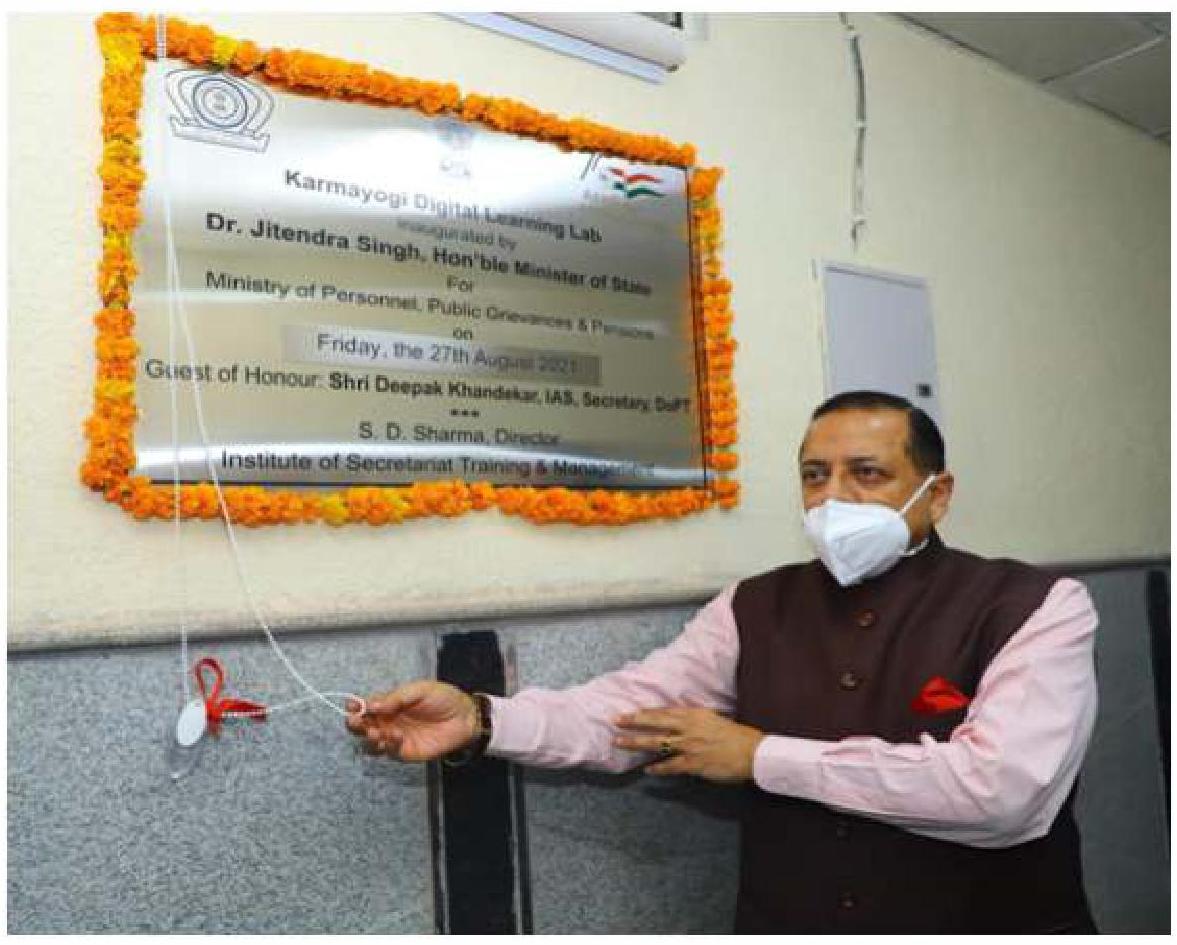
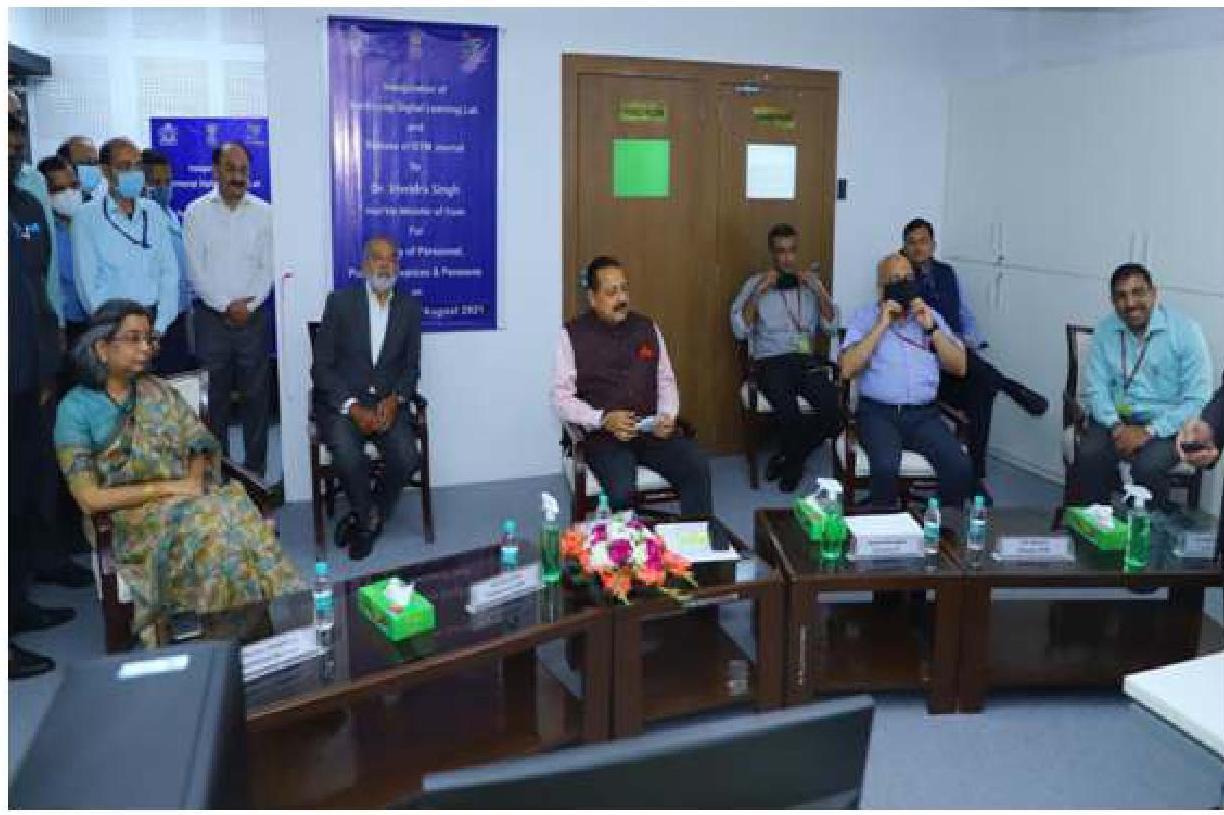
Inauguration of Karmayogi Digital Learning Lab (KDLL) at ISTM by Dr. Jitendra Singh, Hon’ble MoSPP on 27th August, 2021
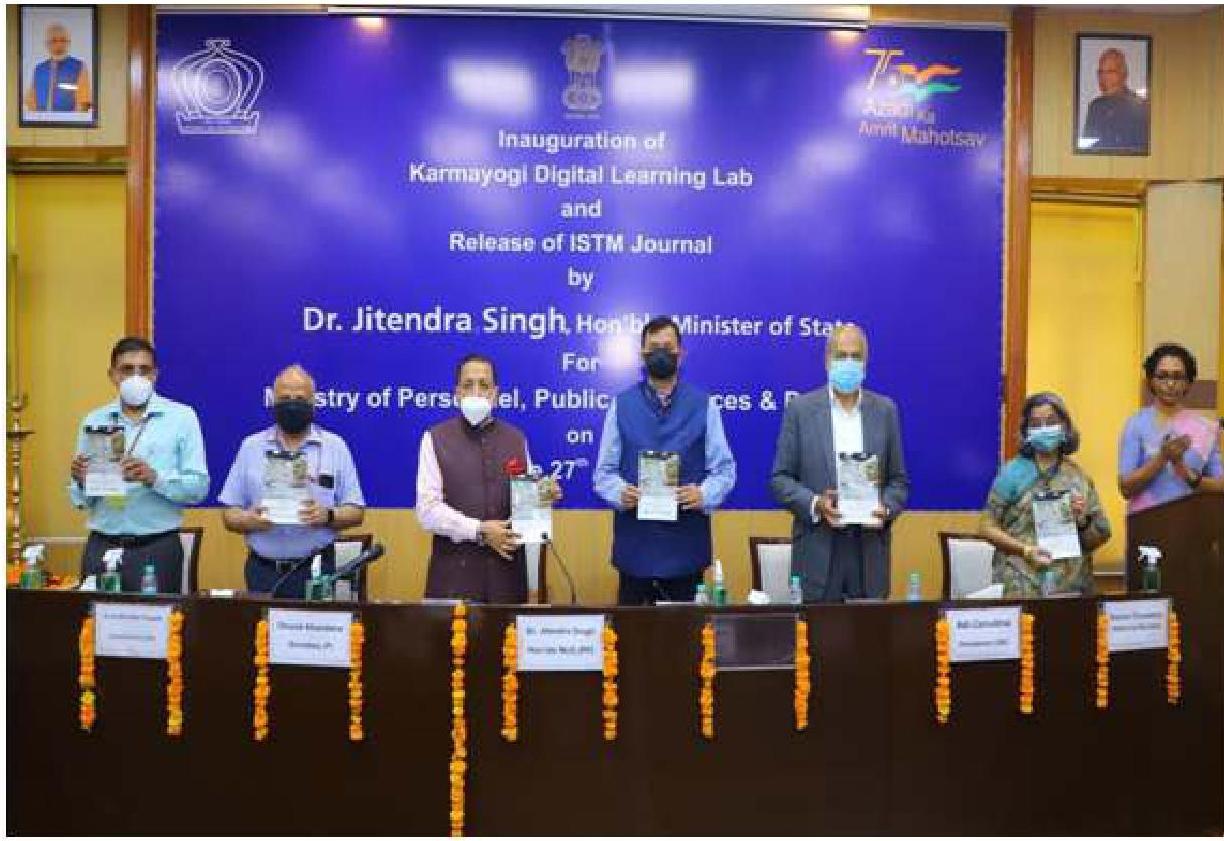
Release of ISTM Journal by Dr. Jitendra Singh, Hon’ble MoSPP on 27th August, 2021
Annual Report 2021-22
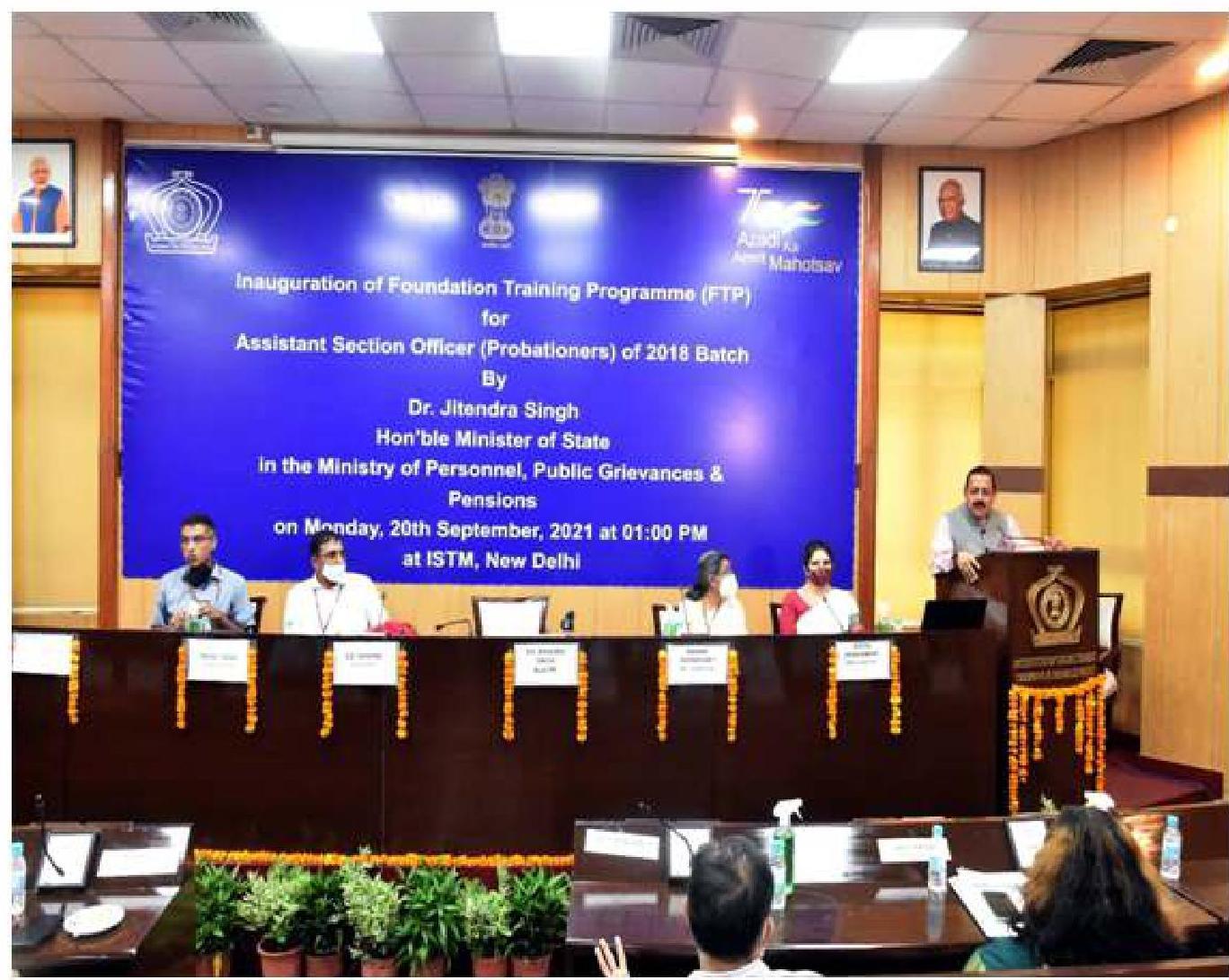
(v) Inauguration of Foundation Training Programme for Assistant Section Officers (Probationers) of CGLE-2018 Batch at ISTM on 20th September, 2021.
National Program for Civil Services Capacity Building (NPCSCB) – Mission Karmayogi
9.0 Union Cabinet on $2^{\text {nd }}$ September, 2020 approved the National Program for Civil Services Capacity Building (NPCSCB) Mission Karmayogi. Under NPCSCB, DoPT is taking steps to calibrate all civil services tasks to a framework of Roles, Activities and Competencies (FRAC) to identify the behavioural, functional and domain needs of each individual position in the government. An online learning platform (iGOT-Karmayogi) is also being developed that will allow the Departments to provide training resources and opportunities to their employees. NPCSCB has an overall budget of Rs. 510.86 Crore (including Taxes) to be spent over a period of 5 years (2020-2025). This includes technical assistance from the World Bank Group to the tune of 50 million USD in the form of loan.
Objective
9.1 Civil Services are at the centre of all government activities – they are agents of policy making and the executive hand that delivers on the ground. The skillsets and capacity of the civil servants play a vital role in service delivery, program implementation and performing core governance functions. Recognising this crucial responsibility, the National Programme for Civil Services Capacity Building (NPCSCB) aims to create a professional, well-trained and future-looking civil service that is imbued with a shared understanding of India’s developmental aspirations, national programs and priorities.
The focus of NPCSCB is on promoting ease of living and ease of doing business, by considerably enhancing the citizengovernment interface. This involves creation of both functional and behavioural competencies among the civil servants.
NPCSCB – Pillars & Philosophy
9.2 NITIAayog, in its report on India@75, has highlighted the need for reforms in training. The experience gained during the COVID 19 pandemic also brought forth the need for the civil service to be agile, capable of partnering with diverse stakeholders and to be up to date with new competencies. The NPCSCB is carefully crafted to lay the foundation for capacity building for future generations of the civil servants so that they learn from the best practices across the world, while remaining connected to their roots
The key philosophy of NPCSCB is to create an ecosystem of competency driven training and Human Resource (HR) management by transitioning from a ‘rule-based’ system to the ‘role-based’ system.
The National Programme for Civil Services Capacity Building has six key pillars i.e.
(a) Policy Framework
(b) Institutional Framework
(c) Competency Framework
(d) Digital Learning Framework iGOTKarmayogi (Integrated Government Online Training Karmayogi Platform)
(e) The electronic Human Resource Management System (eHRMS) and
(f) The Monitoring and Evaluation Framework.
The NPCSCB will cover all civil servants (including contractual employees) across different Ministries/ Departments/ Organisations and agencies of the Union Government. The willing State Governments will also be enabled to align their capacity building plans on similar lines.
Policy Framework
9.3 A competency-based HR policy requires assignment of right person to the right role at the right time. NPCSCB aims to create a robust policy framework towards
implementation of such an HR policy in the Government. The policy framework will also enable adoption of modern technological tools such as a digital platform, artificial Intelligence, machine learning and data analytics for monitoring and evaluation of the entire programme especially quality of the learning content, assessment of user feedback and competency assessment.
The approach will break silos in capacity development and democratize knowledge on an equitable basis across civil services. Besides delivery of training & capacity building, service matters like confirmation i.e., completion of probation, deployment, work allocation, work assignment, notification of vacancies etc will be integrated with the proposed competency framework.
Key principles of the proposed policy framework are:
(a) To complement Physical Capacity Building with an Online Training framework.
(b) Focus on ‘On-Site learning’ to complement ‘Off-Site learning’ whereby the civil servant learns in her job environment and only higher order learning is delivered through training institutions.
(c) To create an ecosystem of shared training infrastructure including teaching material and personnel.
(d) To harmonise the functioning of all civil services training institutions (such as Central Training Institutions etc.) and enable them to partner with domestic and global institutions.
(e) To calibrate all civil service tasks to a Framework of Roles, Activities and Competencies including skills (hereinafter referred to as FRACs)
(f) To partner with all content creators including in-house sources, as well as the private sector to build a content marketplace on iGOT-Karmayogi.
(g) To make available to all civil servants, agnostic to their geographical location and their position in the hierarchy, an opportunity to access training content in Hindi, English and other Indian languages.
(h) To enable the individual learners to follow self-decided as well as mandated learning paths.
(i) To make Mid-Career Training Programme (MCTP) mandatory for all services including horizontal and combined programs amongst services.
Competency Framework
9.4 The exercise for defining the Framework for Roles, Activities, and Competencies including skills (FRACs) will be carried out by each Ministry/Department/Organisation of Union Government and integrated with the i-GOT-Karmayogi Platform. FRACs exercise will define the roles, activities and competencies required at each position in the government. Thereafter, work-allocation, notifications of vacancies etc. will be done through the i-GOT-Karmayogi platform following the FRACs model. Further, content appropriate to the FRACs model will be provided by participating organisations on the 70:20:10 rule (an indicative $70 %$ training online, $20 \%$ on-the-job and $10 \%$ physical).
Digital Learning Framework (iGOT-
Karmayogi Platform)
9.5 An online learning platform, i-GOTKarmayogi, will be developed as an integral part of the Digital India stack for capacity building of all government employees. It will provide anytime-anywhere-any device learning to train about 2.0 crores users which was hitherto not achievable through traditional measures.
Content Curation: The platform is envisioned to evolve into a vibrant and world class marketplace for content modelled on FRACs, supported by a robust e-learning content industry. The content can be curated by individual Ministries/ Departments/ Organisations in- house or through knowledge partners. Carefully crafted and
vetted content from best-in-class institutions, universities, private content providers and individual resources will be made available as training modules.
e-Human Resource Management System (e-HRMS)
9.6 To facilitate digital working environment in Central Government, an electronic Human Resources Management System (e-HRMS) has been introduced in all the Departments. This will help Government to digitally manage the service matters of officials leading to reduction in transaction time and cost, availability of digital records, dashboards for MIS, real time monitoring of manpower deployment as well as serving as a productivity enhancement tool amongst others. The e-HRMS will be integrated with the i-GOT-Karmayogi platform.
Institutional Framework
9.7 The NPCSCB will have the following institutional framework
(i) Prime Minister’s Public Human Resource Council (hereinafter referred to as ‘PMHRC’): A Council comprising of eminent public HR practitioners, thinkers, global thought leaders and representatives of the Indian political leadership under the Chair of the Prime Minister of India, is conceived to be the apex body for driving and providing strategic direction to civil services reforms and capacity building. It will identify areas for policy intervention and approve the National Capacity Building Plan.
(ii) Cabinet Secretariat Coordination Unit: A coordination unit under the Chairmanship of the Cabinet Secretary will monitor the implementation of the NPCSCB. It will align all stakeholders and provide mechanism for overseeing capacity building plans.
(iii) Civil Service Capacity Building Commission – The Civil Service Capacity Building Commission is at the heart of the NPCSCB. It will coordinate the preparation of annual capacity
plans, monitor and evaluate their implementation and functionally supervise the training institutions (CTI’s etc.) for the purpose of creation of shared resources ecosystem. The Secretariat of the Commission will be headed by an officer in the grade of Joint Secretary (Designated as Secretary to the Commission) to Government of India. The functions of Capacity Building Commission are indicated in para 8.22.
(vi) Special Purpose Vehicle (SPV)- A not-for-profit company, under the administrative control of DoPT will be incorporated as a $100 %$ government owned entity for owning, managing, maintaining and improving the digital assets, i.e., i-GOT-Karmayogi- the digital/ e-learning platform, including the IPR of all software, content, process etc on behalf of Government. The SPV will have the responsibility to create and operationalize the content marketplace and continuously evaluate its utilization. The functions of the SPV are given in para 8.23.
(v) A Programme Management Unit (PMU) is being set up in DoP&T to interface with support agencies. It will provide program management and support services to the department for rolling out and managing different aspects of NPCSCB.
9.8 Some important functions of the Capacity Building Commission will be the following:
(i) Coordinate with Departments, Organisations and Agencies of the Government for evolving a harmonious de-siloed approach to improve capacity.
(ii) Facilitate preparation of Annual Capacity Building Plans and monitor and report the periodical progress of its implementation.
(iii) Prepare the Annual HR Report on the health of Civil Services.
(iv) Make recommendations on standardisation of training and capacity building to Government Training Institutions.
(v) Undertake analysis of data emit from iGOT-Karmayogi pertaining to different aspects of capacity building, content creation, competency mapping, feedback etc.
(vi) Organize the Global Public HR Summit under the guidance of the PMHRC utilising the resources and budget to be provided by DoPT.
(vii) Approve Knowledge Partners for the NPCSCB.
9.9 The primary functions of the Special Purpose Vehicle shall be the following:
(i) Design, implement, enhance and manage the digital platform and infrastructure
(ii) Create, buy, source internally, curate content and ensure validation of the content
(iii) Manage and deliver proctored assessment services
(iv) Manage governance of telemetry data and make such data/ analysis available to identified authorities.
Monitoring and Evaluation framework
9.10 The performance of all users of the i-GOT-Karmayogi platform will be monitored and evaluated on Key Performance Indicators (KPIs). This will include the individual learner, the supervisor, the organisation, the peer group, the content provider, the content creator, and the technology service providers etc. A Dashboard and an Annual State of the Civil Services Report will capture the KPIs for all Departments, Organisations and agencies of the Government and document the outcomes of current initiatives, the targets against goals (including key KPIs from the iGOT-Karmayogi dashboard) along with the roadmap for future Public HR Management and Capacity Building.
Funding of NPCSCB
9.11 To cover 46 lakh central government employees, an amount of Rs. 510.86 crore is proposed to be spent over a period of 5 years from 2020-21 to 2024-25. This includes
multilateral assistance to the tune of 50 million dollars (amounting to Rs. 350.00 crores approx.). The SPV will operate on a selfsustainable basis by generating the revenue required for its operational and functional purposes.
9.12 Achievements of Mission Karmayogi in 2021-22
Capacity Building Commission (CBC), an Attached Office of DoPT has been established on 01/04/2021. The composition of CBC is as under:
(a) ShriAdil Zainulbhai, Chairperson
(b) Shri R. Balasubramaniam, Member (HR)
(c) Shri Praveen Pardeshi, Member (Admin)
(d) Shri Hemang Jani, Secretary
The CBC has started functioning with requisite budget allocation and manpower at its new office located at Jawahar Vyapar Bhawan, New Delhi. Order for Delegation of Financial Power Rules for CBC has been issued with the approval of IFD. IFA has also been established in CBC.
The core purpose of the Commission is to build credibility and shape a uniform approach to capacity building on a collaborative and cosharing basis. CBC inter-alia is mandated to perform the following key functions:
(a) Preparing an Annual State of Civil Services Report
(b) Facilitating the creation of Annual Capacity Building Plans for ministries and departments.
(c) Organising a global HR Summit
(d) Evolving a harmonious, de-siloed approach to capacity building initiatives
(e) Undertaking an Audit of Human Resources available in Government.
- Key activities taken up by the CBC are:
(a) The First Roundtable for Central Training Institutions (CTIs) was organized by Capacity Building Commission (CBC) on 12th October 2021. The roundtable was attended by top management of 23 CTIs. The objective of the workshop was to kickstart collaboration activities amongst CTIs.
(b) CBC is currently in the process of pilot testing the Draft Functional Evaluation Framework for CTIs. The framework aims to introduce minimum standards as a means for continuous improvement of CTIs.
(c) CBC is looking to partner with competent Indian institutions with enhanced capabilities for faculty training so as to run faculty development programmes for CTIs.
(d) CBC is engaged in the facilitation of Annual Capacity Building Plans (CBPs) for 8 pilot Ministries and Departments Ministry of Civil Aviation; Ministry of Food Processing Industries; Ministry of Social Justice & Empowerment; Ministry of Labour \& Employment; Department of Defence, Ministry of Defence; Logistics Division, Ministry of Commerce; Department of Expenditure, Ministry of Finance.
(e) The Commission is piloting with various citizen-facing agencies like Railways, Dept. of Post, Ministry of Youth Affairs (MoYA), BSNL, and UT Police Forces to co-develop short, self-paced digital modules focused on building behavioural competencies. The objective of this exercise is to help citizen-facing staff in Ministries/Departments to be proactive \& customer-oriented.
(e) CBC is preparing to launch an engagement survey covering 3.1 million civil servants (group $A+B+C$ ) to understand their outlook towards the current training \& capacity building ecosystem, their experience, and motivation levels.
The experimental digital platform of the programme iGOT-Karmayogi has become functional on which various types of learning courses are being uploaded by the central and other training institutions. 50 Ministries/ Departments/ CTIs have already been onboarded on iGOT platform along with 123 live courses for learners’ consumption. The Mission Karmayogi platform has gone live.
Outreach/ Briefing sessions were organized for content onboarding on iGOT Karmayogi platform in various identified Ministries/ Departments and Ministries/ Departments implementing Flagship Schemes.
It has been decided to conduct a pilot exercise to test the Learner-on-boarding readiness in which 13 Ministries/Departments with an approx. user base of 6000+ employees have been shortlisted with the following criteria:
(i) Ministries/Department which are onboarded both on e-HRMS and iGOT Karmayogi platform.
(ii) Ministries/Departments which have created and on-boarded their content/courses on iGOT Karmayogi platform.
Helpdesk in the form of L1, L2 and L3 to deal with various issues pertaining to iGOT Karmayogi platform at different levels and troubleshoot them is being made functional.
A Task Force was set up on 23.06.2021 to guide operationalization of the SPV. The subgroups under the SPV Task Force have given multiple recommendations as under which are being broadly examined by DoPT:
(a) Governance Working Group
(b) Technology Working Group
(c) Operations Working Group
(d) Content Working Group
(e) HR Working Group
(f) Finance Working Group
A Special Purpose Vehicle (SPV) has been incorporated on 31.01.2022 in the name of ‘Karmayogi Bharat’ under Section 8 of the Companies Act, 2013 as a 100% Government owned not for profit Company under National Programme for Civil Services Capacity Building (NPCSCB)-Mission Karmayogi with the approval of the Government circulated vide O.M. No. F-16017/16/2020-iGOT dated 21.01.2022. Certificate of Incorporation, PAN and TAN of the company has been obtained and the logo has also been finalized.
iGOT Karmayogi platform has been migrated and hosted on NIC cloud. Migration of courses and contents is under process.
A High-level Steering Committee under the Chairmanship of Secretary (Personnel) has been constituted on 6th September, 2021 to have regular strategic discussions, progress review and providing guidance for project implementation with stakeholders of Mission Karmayogi.
A Digital Learning Lab has been inaugurated on 27/08/2021 which will support the Ministries and Departments in development of their e-Content learning courses through its specialized manpower and infrastructure.
A Working Group under the Chairmanship of Joint Secretary (Training), DoPT for detailed deliberation on online courses/modules on Geographic Information System (GIS) under Mission Karmayogi has been constituted which will help use GIS for decision making which may in turn increase Country’s GDP by $2-3 %$.
iGOT COVID-19 courses are being provided on DIKSHA platform of M/o Education to provide training to the COVID frontline workers to efficiently handle the Covid-19 pandemic. There are total 123 courses in five different languages (viz. English, Hindi, Marathi, Gujarati, Bengali). Out of these 115 courses have been approved by respective Ministries/Departments/Organizations (MDOs) and more that 60 courses have been made live on the iGOT platform. In the first phase around 14 lakh users were trained on the portal. A total of around 20 lakhs course enrolments were done in 12 languages and 15 lakhs certificates were issued. In the second phase as on 9th January, 2022 a total of 63543 participants are registered. 43704 courses have been completed and 43692 certificates have been issued.
A full day workshop on Mission Karmayogithe Path Ahead was organized on 23rd December, 2021 at Bhim Auditorium, Dr. Ambedkar International Centre, New Delhi, as part of Azadi ka Amrit Mahotsav- Good Governance Week celebration. During the workshop, Pilot demo of the iGOT platform
was given along with deliberation sessions on various themes spread over the day.
Two Brainstorming Sessions on Mission Karmayogi were held under the Chairmanship of the Hon’ble MoS (PP) Dr. Jitendra Singh with Lal Bahadur Shastri National Academy of Administration (LBSNAA), Capacity Building Commission (CBC), Institute of Secretariat Training and Management (ISTM), Indian Institute of Public Administration (IIPA), National Centre for Good Governance (NCGG) and Training Division, DoPT on 13.09.2021 and 28.12.2021 respectively.
Integrated Government Online Training (iGOT) Programme
This Department in collaboration with Abdul Latif Jameel Poverty Action Lab (J-PAL), South Asia and Massachusetts Institute of Technology (MIT), USA has offered six online courses of MITx Micro Masters programme in Data, Economics and Development Policy (DEDP) under the Integrated Government Online Training (iGOT) initiative of DoPT since 2018. The iGOT initiative is aimed at needbased capacity building of State and Central Government officers and to facilitate the outreach of training facilities for them to make training available on site and on flexitime basis. The online training courses under iGOT programme are focused and targeted to the requirements of the government officers and will help in their career progression.
The six online courses available under iGOT Programme are as under:
(a) The Challenges of Global Poverty;
(b) Designing and Running Randomized Evaluations;
(c) Data Analysis for Social Scientists;
(d) Principles of Microeconomics;
(e) Foundations of Development Policy; and
(f) Political Economy and Economic Development
These courses are offered three times a year – March, June and September. The officers who successfully earn the course completion certificate from J-PAL are reimbursed thecourse fee of $$ 100$ USD per course by this Department. These programmes have been
received very well by the officers considering their effectiveness. As of now through eight batches, 773 officers have completed 864 courses till financial year 2021-2022.
e-HRMS Project
9.13 DoPT (Department of Personnel and Training) introduced the Electronic Human Resource Management System (e-HRMS) to facilitate a digital working environment, and streamline Human Resource Services for Government employees. National Informatics Centre (NIC) is the technical partner of DoPT for design, development and implementation of e-HRMS.
e-HRMS has digitized HR processes in the Government of India, leading to several benefits for both the Government and Officials. e-HRMS will provide analytics to the Senior Administration in Policy formulation and implementation.
Background
9.14 The Expenditure Management Commission (EMC) had, in the year 2015, recommended to put in place a Human Resource Management System (HRMS) across all offices of the Government of India within a defined time frame. The manual system of handling personnel administration was to be completely dispensed with.
DoPT was tasked to expeditiously roll-out eService Book in respect of all the Central Government Employees in a time bound manner with the support of NIC and involvement of Cadre Controlling authorities.
9.15 Salient Features of e-HRMS:
| 1. | Single source of authentic employee data | 6 | $24 \times 7$ access and availability |
|---|---|---|---|
| 2. | Common document repository of employees | 7 | Ease of sharing information among stakeholders |
| 3. | MIS reports analytics | 8 | e-sign facility |
| 4. | Standardization of master data | 9 | Alerts/notification functionality |
| 5. | Minimizes manual entry of data | 10 | Integrates with other applications like PFMS, e-office, Bhavishya etc. |
9.16 Status of e-HRMS
- e-HRMS has targeted and covered about 37,000 employees of Govt. of India in various Ministries/Departments.
- The following 08 modules have become functional in e-HRMS: –
| i) Leave | ii) Personal Information | iii) Reimbursement | iv) Advance |
|---|---|---|---|
| v) Tour | vi) Training | vii) Complaint/ Grievance | viii) LTC |
- A Comprehensive dashboard has been developed providing various analytics to senior administration for decision and policy making.
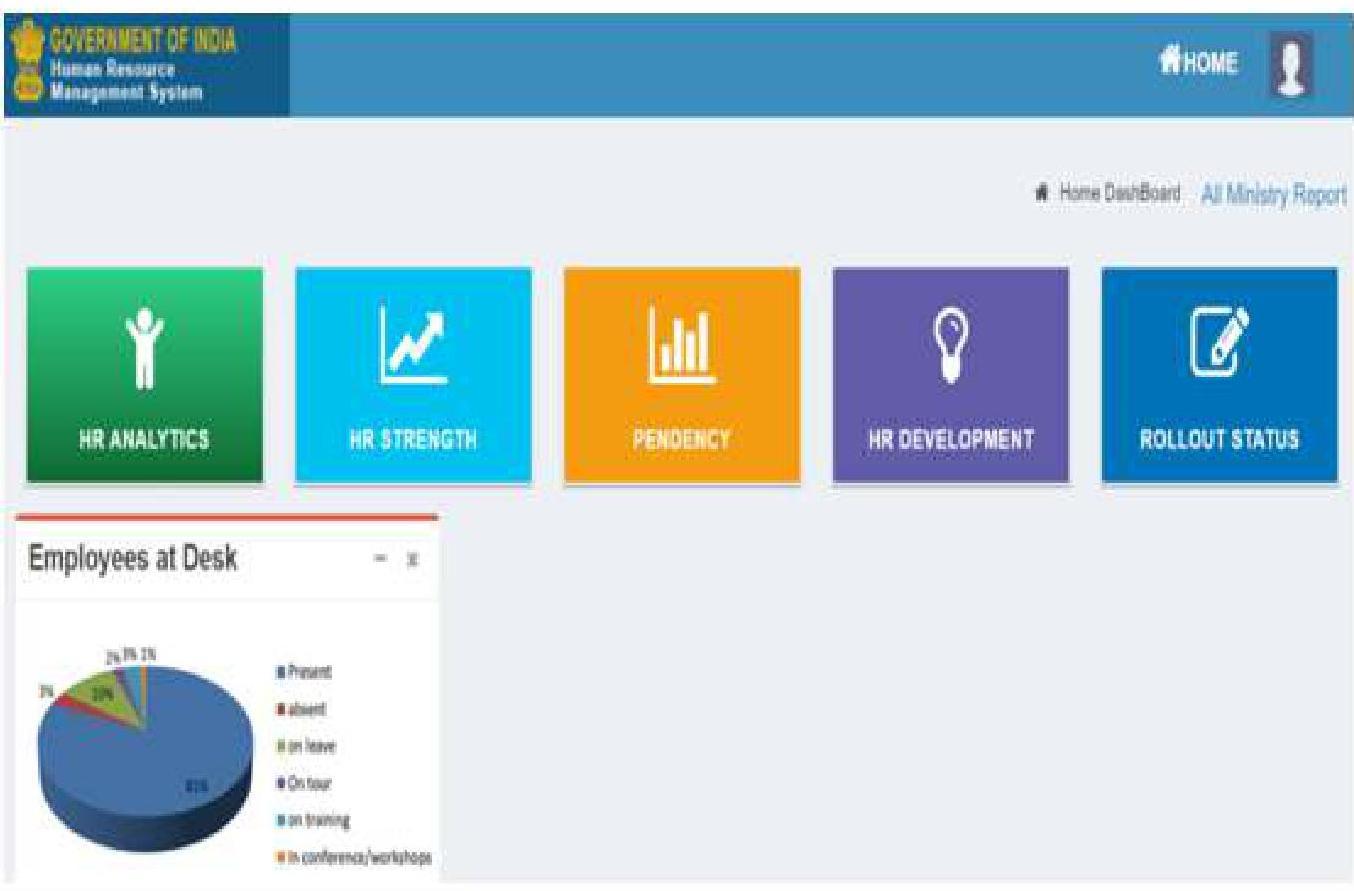
- Training Programmes for Ministries and Departments and meetings of Project Monitoring Committee (PMC) of e-HRMS are held online to review the status of onboarding of employees in different Ministries/Departments.
9.17 Benefits
By this system, the public Human Resources can be optimally managed. The employee can avail HR approvals/facilities at the click of a button. This application can also be adopted by States and other Government Units, providing a seamless flow of information from hiring-to-retiring of Government employees. In other words, once implemented across Central and State governments, the e-HRMS application will be able to provide any information in respect of any employee or group of employees about their service particulars
- Savings: Assuming that an employee currently spends, on average, two days in a year performing all Human Resource activities then 30 lakh odd employees will be saving about 5 crore hours annually.
- Automated Clearances: e-HRMS has built in the tools and capabilities to bring together dispersed data to generate automated clearances in respect of Foreign Travelling, Transfer, Promotion, Deputation etc.
9.18 Achievements:
(a) More than 25,000 employees (covering 65 major Administrative Ministries/ Departments) have so far been onboarded onto e-HRMS (as on 09/03/2022). Approx. 36,000 employees have been further targeted for onboarding onto e-HRMS platform.
(b) In order to firmly put e-HRMS on the path of full utilization, DoPT has adopted a ‘Systems only HR Management Approach’.
(b) Relevant fields of 3700 employees on the e-HRMS platform have been identified and migrated onto i-GOT Karmayogi platform to facilitate Civil Services Training and Development under Mission Karmayogi.
9.19 Future Plans
(a) Integration of platforms. Three applications viz. Single User Platform Related to Employees Online (SUPREMO), Smart Performance
Appraisal Report Recording Online Window (SPARROW) and Vigilance Information System (VIS) have been identified for possible integration with e-HRMS.
(b) Rotational Transfer and Postings (RTP), clearance for retiring personnel and Training Module and access to training material are expected to be made available via e-HRMS in coming days.
CHAPTER
10
ADMINISTRATIVE VIGILANCE DIVISION
10.0 Administrative Vigilance Division-I is responsible for examination of disciplinary cases and vigilance matters in respect of Indian Administrative Service officers working under the Central Government and State Governments under the All India Services (Discipline and Appeal) Rules 1969 and All India Services (Death-Cum-Retirement Benefits) Rules, 1958. Administrative Vigilance Division-I is also responsible for examination of disciplinary cases received from the Ministries / Departments in respect of Group ‘A’ officers of the Central Secretariat Service (CSS) and Central Secretariat Stenographers Service (CSSS) for initiation of disciplinary proceedings under Rule 14, Rule 16, Rule 19 of CCS (CCA) Rules, 1965 and under Rule 9 of CCS (Pension) Rules 1972.
10.1 The Division processes cases referred by the State Governments and Ministries / Departments under Government of India on the following issues:
- Proposals from the State Governments seeking to impose major penalty of dismissal / removal / compulsory retirement on members of IAS.
- Proposals from the State Governments seeking permission under the AIS (DCRB), 1958 Rules to initiate action against retired members of IAS.
- Proposals from the State Governments for imposing penalty of cut in pension against retired IAS officers.
- Proposals to initiate disciplinary proceedings / suspension of IAS officers working under the Government of India.
- Appeal against suspension submitted by IAS officers serving in the States.
- Memorial submitted by IAS officers against the orders passed by the Central Government or the State Governments in disciplinary proceedings in which the officer is aggrieved.
- Requests for sanction for prosecution against IAS officers under the Prevention of Corruption Act, 1988.
- Requests for sanction for prosecution under the Prevention of Corruption Act, 1988 against Group ‘A’ officers of the Central Secretariat Service (CSS) and Central Secretariat Stenographers Service (CSSS) cadres.
- Handling of Privilege Notices from the Members of Parliament received from the Lok Sabha / Rajya Sabha Secretariat as well as complaints against IAS Officers.
- Examination of vigilance status of IAS officers for purposes of empanelment/ training/ posting on deputation and other purposes as per extant guidelines. To facilitate this function, a Computerized Vigilance Information System is in operation with a central data base which can be accessed by the requisitioning Divisions concerned of this Department.
- Examination of vigilance status of all Group ‘A’ officers of the Central Secretariat Service (CSS) and Central Secretariat Stenographers Service (CSSS) cadres for various purposes viz. promotion, empanelment, deputation, VRS, etc. as per extant guidelines.
- Advice / clarification to the State Governments / Central Ministries/ Departments on the procedural aspects of disciplinary proceedings.
10.2 Disciplinary Proceedings:
- Final orders in disciplinary proceedings against IAS officers were issued in thirteen cases during 01.04.2021 to 31.12.2021.
- Six suspension cases against IAS officers serving in the State Governments were reviewed by the Central Review Committee and suspension period in these cases was extended. In two cases, suspension of IAS officers while serving in State Governments were confirmed and further extension of
suspension period beyond thirty days was approved.
- During the period 01.04.2021 to 31.12.2021, nine final orders in seven disciplinary cases against Group ‘A’ officers of CSS was issued. In eight cases, nine charge sheets were issued against Group “A” officers of CSS cadre.
- In two cases, suspension against Group “A” officers of CSS cadre were reviewed from time to time.
10.3 Sanction for Prosecution and Monitoring of Proposals of Sanction for Prosecution under provisions of Prevention of Corruption Act, 1988: - Sanction for prosecution against IAS Officers were decided in ten cases under Prevention of Corruption Act, 1988. Order of Sanction for prosecution was issued in respect of ten IAS officers and denied in respect of one IAS officer.
- Orders of sanction for prosecution was denied under Prevention of Corruption Act, 1988 in two proposals in respect of two Group ‘A’ officers of CSS cadre.
10.4 Privilege Notices from Members of Parliament and Complaints against IAS officers: - During the period 01.04.2021 to 31.12.2021, 38 Privilege notices against officials of Districts Administration for protocol violation were received from the Lok Sabha / Rajya Sabha Secretariat and processed during the period. 30 Privilege notices were finally disposed of.
- During the period from 01.04.2021 to 31.12.2021, 09 complaints were received from Hon’ble Members of Parliament against IAS officers and all these complaints were disposed of.
- During the period 01.04.2021 to 31.12.2021, 968 complaints against IAS officers were received and processed, and 856 complaints were finally disposed of.
- During the period 01.04.2021 to 31.12.2021, 79 complaints against Group “A” officers of CSS/CSSS cadres were received and processed.
Disagreement cases in disciplinary matters:
10.5 In order to bring about greater uniformity in existing disciplinary cases on behalf of the President, in cases where the President is the disciplinary authority and there is a difference of opinion between the CVC and the concerned Department, the Departments are required to consult the DoPT before taking a decision on not to accept the CVC’s advice. Similarly, disciplinary cases where Central Vigilance Commission advises major penalty and the UPSC favours a minor penalty or recommends exoneration, before the Disciplinary Authority takes a final view, the matter is to be referred to this Department for resolving the disagreement. This Division has disposed of 02 such case, between 01.04.2021 and 31.12.2021 (Annexure-II).
Disagreement in the matter of Prosecution Sanction cases:
10.6 Similarly, the cases of disagreement between the CVC/CBI and Sanctioning/Disciplinary Authority in the matter of Prosecution sanction cases are required to be referred to DoP&T for a final decision in terms of this Department’s OM dated 6th November, 2006. This has been modified vide DoP\&T’s OM No. 372/19/2012-AVD-III dated 3rd May, 2012 providing that final decision for grant or denial of sanction for prosecution shall be taken by the Competent Authorities concerned even in cases they decide to differ with CVC’s advice after obtaining views of DoPT. Accordingly, the views of DoP\&T may be taken into account while passing final speaking order. This Division has disposed of 24 such case, between 01.04.2021 and 31.12.2021 (Annexure-III).
Central Vigilance Commission (Amendment) Act, 2021:
10.7 Section 25 of the CVC Act, 2003 which deals with the appointments, etc., of officers of the Directorate of Enforcement in the Central Vigilance Commission, has been amended by way of promulgation of the Central Vigilance Commission (CVC) Ordinance, 2021 on
14.11.2021. Further, the CVC (Amendment) Bill, 2021 was introduced in both the Houses on 03.12.2021 to replace the aforementioned Ordinance. The Bill was passed by the Lok Sabha and Rajya Sabha on 09.12.2021 and 14.12.2021. After its passage through both the Houses of Parliament and assent of the Hon’ble President, the Central Vigilance Commission (Amendment) Act, 2021, came into force w.e.f. 14.12.2021.
Central Vigilance Commission
Introduction
10.8 The Central Vigilance Commission is the apex integrity institution mandated to combat corruption and to ensure integrity in administration. It is a statutory body vested with the superintendence of vigilance administration in the Central Government and its organisations. The Commission also endeavours to create awareness amongst civil society and the public at large towards achieving transparency, accountability and corruption free governance with its outreach measures.
Statutory Provisions
10.9 The Central Vigilance Commission (CVC) was set up by the Government of India through a Resolution vide No. 54/7/64 dated 11.02.1964 and was accorded statutory status by the Central Vigilance Commission Act, 2003 (No. 45 of 2003), notified in the Gazette of India Extraordinary on 12.09.2003.
10.10 The Commission is empowered to inquire or cause inquiries to be conducted into offences alleged to have been committed under the PC Act 1988 by specified categories of public servants and in terms of clause (b) of sub-Section (2) of Section 8 of the Central Vigilance Commission Act, 2003 (45 of 2003) and subsequent notification issued vide 18th March 2004 and 12th September 2007.
10.11 The Commission exercises superintendence over the vigilance administration of the Ministries /Departments /Organisations of the Central Government. The Commission is mandated to exercise superintendence over the functioning of CBI
and monitoring cases taken up by CBI for investigation under PC Act. The Central Vigilance Commission has been designated as the agency to receive and act on complaints or disclosure on any allegation of corruption or misuse of office from whistle blowers under the “Public Interest Disclosure and Protection of Informers’ Resolution” (PIDPI), 2014, which is popularly known as “Whistle Blowers” Resolution. The Commission is also empowered as the designated agency to take action against complainants making motivated or vexatious complaints.
10.12 The Central Vigilance Commission has been designated as the agency to receive and act on complaints or disclosure on any allegation of corruption or misuse of office from whistle blowers under the “Public Interest Disclosure and Protection of Informers’ Resolution” (PIDPI), 2014, which is popularly known as “Whistle Blowers” Resolution. The Commission is also empowered as the designated agency to take action against complainants making motivated or vexatious complaints.
10.13 The Commission conducts its activities concerning inquiry or causing inquiry through the Chief Vigilance Officers (CVOs), who are the extended arms of the Commission.
10.14 As per Section 14 of the CVC Act, 2003, the Commission submits an Annual Report of its activities to the President within six months of the close of the year under report. The report also contains a separate part on the functioning of the Delhi Special Police Establishment (DPSE) in so far as it relates to sub-section (1) of section 4 of the DSPE Act, 1946 (25 of 1946).
Multi-Pronged Strategy of the Commission to combat Corruption
Punitive, Preventive and Participative Vigilance
10.15 As a part of its multi-pronged strategy the Commission has been stressing on not just punitive but preventive and participative vigilance measures to combat corruption.
Punitive Vigilance
10.16 As far as punitive vigilance is concerned, the Commission feels that timebound and effective punitive action resulting in award of exemplary and adequate punishment deters others from committing such misconduct. It tenders advice on issues referred to it by various organisations, it reviews the progress of work periodically through the mechanism of annual sectoral reviews and other meetings, it guides the Chief Executives and the CVOs of various organizations on issues pertaining to vigilance, it seeks organizational responses and suggests systems improvement in areas attracting complaints, conducts direct inquiries on certain sensitive complaints and also summons officials for hearings on specific issues. All this is done as part of comprehensive effort for better vigilance administration.
10.17 The advisory role of the Commission extends to references received from Departments/Organisations of the Central Government in individual cases of officers covered under its jurisdiction and consists of a two-stage mechanism i.e. on investigation /inquiry reports before initiating disciplinary action termed as first stage advice (FSA) and on completion of disciplinary proceedings as to the nature of penalty or otherwise termed as second stage advice (SSA), whenever DA has a different opinion on FSA.
Preventive Vigilance
10.18 Central Vigilance Commission, the apex institution for vigilance administration in the country uses various tools for effective vigilance administration. Preventive Vigilance is one of the most important tools in the offensive against corruption as it improves upon existing systems, procedures and establishes in-built checks within the system to bring about more clarity, standardisation and transparency.
10.19 In line with the Commission’s directives and instructions towards Preventive vigilance, a number of exemplary initiatives have been taken by various Government Departments, Banks, PSUs, Flls etc. in 2020-21 to
strengthen the Preventive Vigilance mechanism, despite the period being marked by the Global Pandemic that has severely affected the working of various organizations.
10.20 The initiatives range from Improvements in Human Resources Management, Banking and Financial Services, Improvements in Contracts and Inventory Management, Project Management and Policy Initiatives, Automation of Operations, Transport & Infrastructure Management System, and Strengthening Vigilance Administration. These have been compiled in a booklet published by the Commission “Initiatives on Preventive Vigilance” released during VAW 2021.
Participative Vigilance
10.21 The Commission endeavours to promote integrity in the daily life of all citizens and elicit the participation of all stakeholders in the fight against corruption. One of the major initiatives taken in this regard is the observance of Vigilance Awareness Week every year in the week in which the birthday of Sardar Vallabhbhai Patel falls in i.e the last week of October.
10.22 In a move towards commemorating 75 years of India’s Independence which falls on August 15, 2022, the Commission had decided to observe Vigilance Awareness Week from 27th October 2021 to 2nd November 2021 with the theme of “India @ 75: Self-Reliance with Integrity”. This year as a run up to Vigilance Awareness Week, a Joint Conference of CVC and CBI was held on 20th October 2021 at Kevadia, Gujarat.
10.23 The observance of Vigilance Awareness Week commenced with the taking of the integrity pledge by public servants in the Ministries/ Departments/ Central Public Sector Enterprises (CPSEs)/ Public Sector Banks (PSBs) and all other organizations on 26th October, 2021.
10.24 In the Vigilance Awareness Week 2021, the Commission focused on three areas: i) continuation of the House Keeping Activities of 2020, ii) spreading awareness about the complaint mechanism under Public Disclosure and Protection of Informers
(PIDPI) Resolution, and iii) Special Clearance Campaign to clear all outstanding cases.
10.25 Organizations were informed to ensure maximum participation and output in the above three focus areas while also ensuring that requisite social distancing norms under Covid-19 are followed.
Integrity Pact
10.26 Integrity Pact (IP) is an important tool of preventive vigilance mechanism aimed at preventing corruption and ensuring integrity in public procurement. In India, the Central Vigilance Commission is the nodal authority for implementation of the Integrity Pact in Central Govt. owned or controlled organizations. IP is a written agreement between the buyer etc. and all the vendors/bidders agreeing to refrain from corrupt/unethical practices at any stage of the contract. If the written agreement is violated, the Pact describes the sanctions that shall apply. These include (i) Loss or denial of contract; (ii) Forfeiture of the bid or performance bond; (iii) Liability for damages; (iv) Exclusion from bidding on future contracts (department); and (v) Criminal or disciplinary action.
10.27 Integrity Pact provides for independent oversight, through Independent External Monitors (IEMs) who are being nominated by the Central Vigilance Commission nominates IEMs. Thus, IP in its present form has three players. i.e. (i) The Principal or the Company/Department; (ii) The Vendor; and (iii) The Independent External Monitor (IEM). Central Vigilance Commission, from time to time has not only recommended for adoption of Integrity pacts but has also devised a Standard Operating Procedure for adoption and implementation of the Integrity Pact. The Standard Operating Procedure has been extensively revised and updated by the Commission, vide Circular No. 06/05/21 dated 03.06.2021 bringing out more clarity about the methodology, role and responsibilities of IEMs.
Training and Capacity Building
10.28 With a view to reduce the time taken in finalization of Departmental Inquiries, the Commission has formulated a three-day uniform Training Programme for Inquiry Officers (IO) and Presenting Officers (PO) of the Government organizations including PSUs and PSBs. The focus of the Commission is to train adequate numbers of potential IO and PO across the country. It is expected that the organizations will assign work only to the trained officers as IO and PO for conducting the departmental inquiries henceforth.
10.29 To roll out the IO/PO training, the Commission has identified a number of training institutions namely Institute of Secretariat Training and Management (ISTM), Hindustan Petroleum Corporation Limited, CBI Academy, Central Academy for Police Training and National Productivity Council. They would be conducting the training of IO/PO on the basis of a uniform training module prepared by the Commission.
10.30 The Commission has received 5252 nominations from 266 organisations. The training of the first batch was conducted on 09th to 11th August, 2021 and it is expected that by the close of 2021, training of 20 batches of IO/PO will be completed covering over 600 officers.
Lokpal & Lokayuktas Act, 2013 (No. 1 of 2014) \& related matters
10.31 In order to establish a more effective mechanism to deal with complaints relating to allegations of corruption against public servants, the Government of India enacted Lokpal and Lokayuktas Act, 2013, which came into force with effect from 16.01.2014. Further, the Lokpal and Lokayuktas (Amendment) Act, 2016 has been brought into force w.e.f. 16.01.2014.
The institution of Lokpal has been operationalized with the appointment of its Chairperson and Members in March, 2019.
Rules made under the Act
10.32 The Central Government, in exercise of powers conferred by clauses (a), (g) and (h) of sub-section (2) of section 59 of the Lokpal and Lokayuktas Act, 2013, has notified the following Rules:
(i) The Search Committee (Constitution, Terms and Conditions of appointment of members and the manner of selection of Panel of Names for appointment of Chairperson and Members of Lokpal) Rules, 2014;
(ii) The Lokpal (Complaint) Rules, 2020;
(iii) The Lokpal (Finance and Account) Rules, 2020.
In exercise of powers conferred by subsection (3) of section 10 read with section 59 of the Act, Central Government has also notified the following Recruitment Rules:
(i) Lokpal (Staff Car Driver) Recruitment Rules, 2020;
(ii) Lokpal (Multi Tasking Staff, Group ‘C’ posts) Recruitment Rules, 2021.
(iii) Lokpal (Court Master) Recruitment Rules, 2021.
10.33 The Public Servants (Declaration of Assets and Liabilities and Minimum Value of Assets) Rules are at the drafting stage.
10.34 The Prevention of Corruption (Amendment) Act, 2018:
(i) The Prevention of Corruption (Amendment) Bill, 2013, for amending the Prevention of Corruption Act, 1988, traversed through Parliamentary Committees including Select Committee of Rajya Sabha and Law Commission of India as a part of consultative exercise. The object of the Bill was to fill certain gaps in description and coverage of the offence of bribery so as to bring it in line with the current international practices and also to meet more effectively, the country’s obligations under United Nations Convention Against Corruption (UNCAC). Having been passed by both the Houses of the Parliament and upon receiving the Presidential assent, the Act has since been notified and brought into force with effect from 26th July, 2018.
(ii) The amendments are aimed at harmonising the existing provisions by use of uniform phraseology to facilitate clear and unambiguous interpretation and making the law more stringent to strike at big ticket corruption while at the same time also ensuring that adequate protection is provided to honest public servants for discharge of their duties without fear of any frivolous or vexatious investigation/ prosecution.
(iii) The amended law removes ambiguities by consolidating all offences relating to receiving of bribe by a public servant under a single umbrella section – section 7 by incorporating the element of mens rea for establishing an offence.
(iv) A provision has been inserted to expressly criminalize active bribery – the act of giving bribe, either by any individual or commercial organizations. However, at the same time safeguard is provided for the citizen that in case of prior intimation by bribe giver to investigating authority or in the case of coercive bribery, when intimation regarding giving of such undue advantage or bribe is provided within 7 days of such incident, no offence shall be created against such bribe giver assisting the law enforcement agency. Vicarious liability is also created qua the senior management of a commercial organization if the act of giving bribe is committed with their knowledge and connivance, in terms of recently inserted section 10 of the Prevention of Corruption Act.
(v) The amended law also lays down specific time lines for administrative processes forgiving prior approval for inquiry/ investigation or prior sanction for prosecution, as also to provide for conclusion of trial within a total period of 4 years to ensure speedy delivery of justice
Whistle Blowers Protection (Amendment) Bill, 2015:-
10.35 In order to establish a mechanism to receive complaints relating to disclosure on any allegation of corruption or wilful misuse of power or wilful misuse of discretion against any public servant and to inquire or cause an inquiry into such disclosure and to provide
adequate safeguards against victimization of the person making such complaint and for matters connected therewith and incidental thereto, the Government has notified the Whistle Blowers Protection Act, 2014 (No. 17 of 2014) on 12th May, 2014. In terms of provision of sub-section (3) of section 1 of the Act, the provisions of the Act shall come into force on such date as the Central Government may, by notification in the Official Gazette, appoint. No such notification has been made by the Government for the reason that the Act requires amendments aimed at safeguarding against disclosures affecting sovereignty and integrity of India, security of the State, etc., before it is brought into force. To make these amendments to the Act, the Government introduced the Whistle Blowers Protection (Amendment) Bill, 2015 in the Lok Sabha on 11th May, 2015 which was passed by the Lok Sabha on 13th May, 2015 and transmitted to the Rajya Sabha. The Bill has since lapsed upon the dissolution of the Sixteenth Lok Sabha.
Prevention of Bribery of Foreign Public Officials and Officials of Public International Organisations Bill, 2011
10.36 To criminalize the offence of bribery of Foreign Public Officials and Officials of Public International Organizations, in compliance of Article 16 of UNCAC, the Government introduced the Prevention of Bribery of Foreign Public Officials and Officials of Public International Organisations Bill, 2011(Foreign Bribery Bill) in the Lok Sabha on 25-03-2011. The Bill however, lapsed with the dissolution of the 15th Lok Sabha.on 25-032011. The Bill however, lapsed with the dissolution of the 15th Lok Sabha. Subsequently, the Law Commission has also submitted its 258th Report on this aspect, whose recommendations were considered by a Team of Ministers (ToM).
CHAPTER
11 INTERNATIONAL COOPERATION
11.0 The International Cooperation Division deals with the matter pertaining to implementation of review of United Nations Convention Against Corruption (UNCAC), G20 Anti-Corruption Working Group (ACWG) and BRICS Anti-Corruption Working Group (ACWG). The primary tasks of this Division emanate from the follow up to the ratification of the United Nations Convention Against Corruption (UNCAC) and the other consequential international collaborative efforts on global platforms. This Division acts in conjunction with specialized agencies like the Central Vigilance Commission, Central Bureau of Investigation, Enforcement Directorate and other line Ministries entrusted with the specific tasks within their respective administrative domain, viz. combating corruption, extradition matters, prevention of money laundering, mutual legal assistance treaties etc.
11.1 The United Nations Convention Against Corruption (UNCAC) is a universally binding international legal Instrument to fight corruption at both domestic and global level and was adopted by the United Nations General Assembly in October 2003. The
convention aims to bring in rationalization and uniformity in legal frameworks and in the approaches in the fight against corruption. The provisions contain both mandatory and non mandatory obligations. India signed the Convention in December 2005 and ratified the same in May 2011, after being satisfied of substantial compliance status of its domestic laws with the tenets of the Convention.
11.2 The Convention provides for a detailed mechanism for peer review of the status of implementation of its provisions by the Member States. This Department, in coordination with Ministries of Home Affairs, Ministry of Corporate Affairs, Ministry of External Affairs, Department of Legal Affairs; bodies like CVC and UPSC; and organizations like Central Bureau of Investigation, Enforcement Directorate, finalized the Executive Summary of $1^{\text {st }}$ cycle review on Chapter III (Criminalization and Law Enforcement) and Chapter IV (International Cooperation) of UNCAC in 2020. The second cycle review of implementation of Chapter-II (Preventive measures) and Chapter-V (Asset Recovery) of UNCAC has been initiated in November 2015.
11.3 Details of interactions (online) held on various global platforms specific to UNCAC related issues during the period April 2021 to March 2022 are indicated below:
| S . No. |
Description | Period | Organized by | Venue/ Mode |
|---|---|---|---|---|
| 1. | Special session of the Conference of the States Parties to the UNCAC | 7th May 2021 | UNODC | Virtual |
| 2. | United Nations General Assembly Special Session (UNGASS) 2021 | 2nd – 4th June 2021 | UNODC | Virtual |
| 3. | $12^{\text {th }}$ session of the Implementation Review Group | 14th-18th June 2021 | UNODC | Virtual |
| 4. | $12^{\text {th }}$ session of the Working Group on Prevention | 14th-18th June 2021 | UNODC | Virtual |
| 5. | Resumed $12^{\text {th }}$ session of the Implementation Review Group | (6th-10th September 2021) |
UNODC | Virtual |
| 6. | $15^{\text {th }}$ session of the Open-ended Intergovernmental Working Group on Asset Recovery | $\left(6^{\text {th }}-10^{\text {th }}\right.$ September 2021) | UNODC | Virtual |
|---|---|---|---|---|
| 7. | $10^{\text {th }}$ open-ended inter-governmental expert meeting to enhance international cooperation under the UNCAC | $\left(6^{\text {th }}-10^{\text {th }}\right.$ September 2021) |
UNODC | Virtual |
| 8. | $9^{\text {th }}$ session of the Conference of the States Parties to the UNCAC Sharm El-Sheikh (Egypt) | $\left(13^{\text {th }}-17^{\text {th }}\right.$ December 2021) |
UNODC | Physical |
11.4 India is also a Member of G-20 Anti Corruption Working Group (ACWG). The focus of this Group is towards the global financial system, particularly from the point of view of denial of entry or visa to corrupt officials, providing measures to protect whistle blowers, promote effective functioning of anti corruption bodies and association of private and business sector in combating corruption. India has been participating in ACWG meetings. Three G-20 ACWG meetings are held every year. In year 2021, Italy was the G20 Chair, with India as Co-Chair. In the year 2022, Indonesia is the Chair and Australia is the co-chair of G-20 ACWG in 2022. India would be Chairing G-20 in year 2023.
11.5 India kept its focus on the topic of Fugitive Economic Offenders in continuation to efforts on the same in previous years in G20 ACWG meetings 2021. The basic objective behind this was to place the concern of India
and other developing countries on the issue of black money and the need for deliberation in the anti-corruption group for enhanced international cooperation. In the G-20 ACWG Action plan 2022-24 approved in the year 2021, special focus was given on the “Think Pieces” developed by the International Organizations (IOs) to stimulate and guide the future discussions on the promotion of international cooperation, in particular regarding (i) Asset recovery; (ii) Law enforcement cooperation; (iii) Informationsharing; (iv)Technology, and (v) Denial of safe haven/entry. It was decided to explore the links between corruption and other economic crimes and ways to tackle them, including through cooperation on the return of persons sought for such offences and stolen assets, consistent with international obligations and domestic legal systems. India’s participation in this forum from April 2021 to March 2022 was as follows:
| S. No. | Description | Period | Period |
|---|---|---|---|
| 1. | $1^{\text {st }}$ G-20 ACWG of 2021 | 29th March 1st April 2021 | Virtual |
| 2. | $2^{\text {nd }}$ G-20 ACWG of 2021 | 5th – 8th July 2021 | Virtual |
| 3. | $3^{\text {rd }}$ G-20 ACWG of 2021 | 28th September 1st October 2021 | Virtual |
| 4. | $1^{\text {st }} \text { G-20 ACWG of } 2022$ (Indonesia Chairmanship of G-20 2022) | 28th March 31st March 2022 | TBC |
11.6 BRICS Anti Corruption Working Group (ACWG) holds its meeting on the margins of G-20 ACWG meetings at least twice every year to discuss strategies for presenting a united front for anti-corruption in G-20 Anti Corruption Working Group meetings. Under India’s Chairmanship of BRICS ACWG in 2021, the $1^{\text {st }}$ BRICS ACWG, $2^{\text {nd }}$ BRICS ACWG & $3^{\text {rd }}$ BRICS ACWG of 2021 meetings were held on $26^{\text {th }}$ March 2021 (Virtually), $2^{\text {nd }}$ July 2021 (Virtually) and $27^{\text {th }}$ September 2021(Virtually) respectively on the sidelines of G20 ACWG meetings. A 2-day online Anticorruption training Lecture Series on the issue “Harnessing Technology in combating corruption” was organized by India on $26^{\text {th }}-27^{\text {th }}$ August 2021 for the Anti Corruption
Practitioners of BRICS Countries. 1st BRICS ACWG meeting under China’s Presidency of BRICS 2022 was held on 22nd March 2022 (virtually).
11.7 Apart from the direct participations by the Department of Personnel and Training, the concerned Ministries/ Departments/Organizations are representing the Government of India in respect of specialized areas. The role of DoPT in such cases is towards providing overarching support and inputs on global platforms include participation in FATF, SAARC, Stolen Asset Recovery (StAR) initiative etc.
CHAPTER
12
CONSTITUTION, ORGANIZATION AND EVOLUTION OF CBI
A. Setting-up of Special Police Establishment
12.1 During the early stages of World War-II, the then Government of India realized that the enormously expanded expenditure for purposes connected with the war had brought about a situation in which unscrupulous and antisocial persons, both officials and nonofficials, were enriching themselves dishonestly at the cost of the public and the Government. It was under these circumstances, that the setting up of a separate organization to investigate offences connected with these transactions, was conceived. Consequently, the organization known as the Special Police Establishment (S.P.E.) was created by the Government of India in 1941, by an Executive Order.
12.2 The functions of the S.P.E. were to investigate cases of bribery and corruption in transactions with which the War and Supply Department of the Government of India was concerned. The superintendence of the S.P.E. was vested in the then War and Supply Department. Towards the end of 1942, the activities of the S.P.E. were extended to include cases of corruption in the Railways also, presumably, because the Railways were strategically concerned with the movement and supply of war material.
12.3 An Ordinance No. XXII of 1943 was issued by the Government of India, by which a Special Police Force for the investigation of certain offences committed in connection with departments of the Central Government and with powers to investigate such offences, wherever committed in British India, was constituted. This Ordinance lapsed on 30th September, 1946 and was replaced by the Delhi Special Police Establishment Ordinance No. 22 of 1946, which was subsequently
replaced by the Delhi Special Police Establishment Act, 1946 (Act XXV of 1946). After the promulgation of the Delhi Special Police Establishment Act (DSPE Act, 1946), the superintendence of the Special Police Establishment was transferred to the then Home Department (later Ministry of Home Affairs) and its functions were enlarged to cover all Departments of the Government of India.
12.4 In 1953, an Enforcement Wing was added to the Special Police Establishment to deal with the offences under the Import and Export Control Act. With the passage of time, more and more cases under various laws other than Prevention of Corruption Act and violations of Import and Export Control Act were also entrusted to SPE. By 1963, SPE was authorised to investigate offences under 91 different sections of Indian Penal Code and 16 other Central Acts, besides offences under the Prevention of Corruption Act, 1947.
12.5 In 1963, the Delhi Special Police Establishment had 14 Branches, each under the charge of a Superintendent of Police. There were also two other Branches called the Central Investigating Agency comprising 2 squads, situated at Delhi, both having panIndia jurisdiction. At the Head Office of the CBI, the Delhi Special Police Establishment Division was under the direct charge of an Additional Inspector General of Police under the overall control of the Inspector General of Police. The Branches of the Delhi Special Police Establishment were divided into two Zones, each under the charge of a Deputy Inspector General of Police.
B. Establishment and Evolution of CBI
12.6 The Central Bureau of Investigation (CBI) was established vide Resolution No.4/31/61-T dated $1^{\text {st }}$ April, 1963 of the Ministry of Home Affairs, Government of India, which reads as follows:
“The Government of India have had under consideration the establishment of a Central Bureau of Investigation for the investigation of crimes at present handled by the Delhi Special Police Establishment including specially important cases under the Defence of India Act and Rules particularly of hoarding, blackmarketing and profiteering in essential commodities, which may have repercussions and ramifications in several States: the collection of intelligence relating to certain types of crimes; participation in the role of the National Central Bureau connected with the International Criminal Police Organization; the maintenance of crime statistics and dissemination of information relating to crime and criminals; the study of specialized crime of particular interest to the Government of India or crimes having all India or interstate ramifications or of particular importance from the social point of view; the conduct of Police research; and the coordination of laws relating to crime. As a first step in that direction, the Government of India have decided to set up with effect from $1^{\text {st }}$ April, 1963, Central Bureau of of Investigation at New Delhi with the following six Divisions, namely:-
(i) INVESTIGATION AND ANTICORRUPTION DIVISION (DELHI SPECIAL POLICE ESTABLISHMENT)
(ii) TECHNICAL DIVISION
(iii) CRIME RECORDS AND STATISTICS DIVISION.
(iv) RESEARCH DIVISION.
(v) LEGAL & GENERAL DIVISION.
(vi) ADMINISTRATION DIVISION.
The Charter of functions of the above said Divisions will be as given in the Annexure. The assistance of the Central Bureau of Investigation will also be available to the State Police Forces on request for investigating and assisting in the investigation of interstate crime and other difficult criminal cases.
12.7 Hence, CBI has evolved out of the Delhi Special Police Establishment (DSPE) with an enlarged Charter of functions. In fact, with the establishment of CBI on $1^{\text {st }}$ April, 1963,
the Delhi Special Police Establishment was made one of its Divisions, viz. ‘Investigation and Anti-Corruption Division’.The Investigation \& Anti-Corruption Division (Delhi Special Police Establishment) was entrusted with the following mandate in the Resolution although it continued to derive its jurisdiction and powers from DSPE Act, 1946:
- Cases in which public servants under the control of the Central Government are involved either by themselves or along with State Government servants and/or other persons.
- Cases in which the interests of the Central Government or of any public sector project or undertaking, or any statutory corporation or body set up and financed by the Government of India are involved.
- Cases relating to breaches of Central Laws with the enforcement of which the Government of India is particularly concerned, e.g.:
(a) Breaches of Import and Export Control Orders.
(b) Serious breaches of Foreign Exchange Regulation Act.
(c) Passport frauds.
(d) Cases under the Official Secrets Act pertaining to the affairs of the Central Government.
(e) Cases of certain specified categories under the Defence of India Act or Rules with which the Central Government is particularly concerned. - Serious cases of cheating or fraud relating to the Railways, or Posts \& Telegraphs Department, particularly those involving professional criminals operating in several States
- Crime on the High Seas.
- Crime on the Airlines.
- Important and serious cases in Union Territories, particularly those by professional criminals.
- Serious cases of fraud, cheating and embezzlement relating to Public Joint Stock Companies.
- Other cases of a serious nature, when committed by organised gangs or professional criminals, or cases having ramifications in several States, including Union Territories, serious cases of spurious drugs, important cases of kidnapping of children by professional interstate gangs, etc. These cases will be taken up only at the request of or with the concurrence of the State Governments/Union Territories Administrations concerned.
- Prosecution of cases investigated by this Division.
C. Enlarging Role for Preventive Vigilance
12.8 To ensure probity, integrity, fairness and transparency in public life, MHA, vide Office Memorandum No. 130/1/66-AVD dated 5.5.1966, entrusted Central Bureau of Investigation (CBI) with several AntiCorruption and Preventive Vigilance functions in respect of the Central Government Departments, Central Public Sector Undertakings etc., such as:-
(a) Preparation of Agreed List of Suspect Officers of Gazetted status.
(b) Preparation of list of Officers of Doubtful Integrity.
(c) Preparation of Agreed List of Points and Places of Corruption.
(d) Preparation of list of Undesirable Contactmen.
(e) Provide inputs to Departments, Undertakings or Administrations for preparation of the list of Unscrupulous Contractors, Suppliers, Firms and Clearing Agents.
(f) Preparation of Appreciation Reports regarding modes of corruption in various Government Departments and Public Sector Undertakings.
(g) Conducting Joint Surprise Checks and Special Drives.
(h) Provide inputs on Vigilance Status of officers for appointment to key positions.
(i) Discreet Verification & Scrutiny of Complaints and Source Information Reports.
D. Jurisdiction of CBI vis-a-vis State Police
12.9 In order to secure cooperation between the Special Police Establishment and the Ministries/Departments of the Central Government, separate directives had been issued by the Ministry of Home Affairs, Railway Board and the Army, Naval and Air Headquarters and Defence Production Organisation. Subsequently, these separate directives were replaced by one single directive, vide Minsitry of Home Affairs Office Memorandum No. 371/13/66-AVD(III) dated 25.06.1969. Thereafter, amendments were issued by the Government of India from time to time, with the last revised version of the Directive incorporating all amendments issued vide, Office Memorandum No. 371/13/87-AVD.III dated 19.09.1988 by DOPT.
12.10 It was provided that Special Police Establishment enjoys with the respective State Police Force, concurrent powers of investigation and prosecution under the Criminal Procedure Code. However, to avoid duplication of effort, an adminstrative arrangment was arrived at with State Governments which mainly prescribed:-
(a) The cases which substantially and essentially concern the Central Government employees or the affairs of the Central Government, even though involving certain State Government employees, are to be investigated by the Special Police Establishment. The State Police is, however, kept informed of such cases and will render necessary assistance to the Special Police Establishment during investigation; and
(b) The cases which substantially and esentially involve the State Government employees or relating to the affairs of a State Government, even though involving certain Central Governmnet employees, are investigated by the State Police. The Special Police Establishment is informed of such cases and it extends assistance to
the State Police during investigation, if necessary.
E. Expanding Role and Restructuring
12.11 The Economic Offences Division (EOD) in CBI was created vide Resolution No. 24/66/64-AVD, dated June 29, 1964. The scope of EOD was expanded from time to time to cover various economic offences mainly pertaining to serious frauds in Banks, Stock Exchanges, Financial institutions, Joint Stock Companies, Public Limited Companies, misappropriation of public funds, misallocation of national natural resources like Coal, criminal breach of trust, cheating of small investors through Ponzi Scheme and Chit fund Scams, Cyber Crime, IMPEX Laws, counterfeiting of currency, narcotics, drug trafficking, offences related to antiques, arts & treasures, piracy, forgery of travel documents/ identity papers, fraud in overseas job rackets, Wildlife crimes etc.
12.12 With the passage of time, requests were made by various quarters for CBI to take up investigation even in conventional crimes like homicide, kidnapping, large scale Banks and Insurance Frauds, complicated matters etc. Constitutional Courts also reposed faith in CBI and started referring cases to it for enquiry/investigation on the basis of petitions filed by the aggrieved persons in serious matters. This led to multi-dimensional growth of the agency.
12.13 In 1987, internal work distribution in agency broadly categorised Investigation work into Anti- Corruption Division and Special Crimes Division, the latter dealing with cases of conventional crimes as well as Economic Economic Offences. Subsequently, in the wake of Secruties Scam of 1992, a separate Banking Frauds and Securities Cell was created.Even after the establishment of separate divisions, creation of Special Cells was necessitated to take up investigation in important \& sensational cases of conventional nature like Special Investigation Team (SIT) was constituted in 1991 to investigate the case relating to the assassination of Shri Rajiv
Gandhi, Special Investigation Cell was created in 1992 to investigate cases relating to the demolition of Babri Masjid in Ayodhya and Special Task Force was created in 1993 to take up investigation relating to Bomb blasts in Bombay.
12.14 A comprehensive internal work distribution was done in 1994 and divisions were given tasks as under:-
(a) Anti-Corruption Division – To deal with the cases of corruption and fraud committed by public servants of all Central Government Departments, Central Public Sector Undertakings and Central Financial Institutions.
(b) Economic Crimes Division- To deal with bank frauds, financial frauds, Import Export \& Foreign Exchange Violations, large-scale smuggling of narcotics, antiques, cultural property and smuggling of other contraband items, etc.
(c) Special Crimes Division – To deal with the cases of terrorism, bomb blasts, sensational homicides, kidnapping for ransom and crimes committed by the mafia/underworld.
12.15 The Legal Division of CBI was reconstituted as Directorate of Prosecution by Government of India, Ministry of Personnel, Public Grievances and Pensions, Department of Personnel \& Training, vide its OM No. 201/5/2000-AVD.II dated 9.7.2001. This was in pursuance to the direction of Hon’ble Supreme Court of India in Vineet Narain v/s Union of India case [(1998) 1 SCC 226]. The Directorate of Prosecution, CBI mainly performs the following functions:-
(i) Tendering Legal Advice in cases investigated by CBI.
(ii) Conducting and monitoring prosecution of cases investigated by CBI
(iii) Matters relating to the appointment of CBI Retainer Counsels and Special Counsels.
(iv) Matters relating to the notifications regarding appointment of CBI Prosecuting Officers under sections 24(2), 24(8) and 25(1-A) of the Code of Criminal Procedure, 1973 (Act No. 2 of 1974)
(v) Processing legal matters pertaining to the conferences and meetings.
(vi) Matters relating to interpretation of laws, statutory rules and regulations and amendments thereof.
(vii) Matters relating to notification under sections 3, 5(1) and 6 of the Delhi Special Police Establishment Act, 1946 (Act No. 25 of 1946).
(viii) Examination of Letter Rogatories.
12.16 In order to further improve the organisational efficiency, the organization was restructured with effect from 1.1.2009. The Organisation, with a view to increase efficiency, was divided into Branches supervised by the Zones. A new zone, namely, “Technical Forensic & Coordination Zone” (TFC) was created at CBI Head Quarters, New Delhi. This zone is responsible for Technological up-gradation of CBI including functioning of Technological and Forensic Support Units (TAFSU) and strengthening inter-branch, inter-state and international cooperation and coordination.
F. INTERFACE WITH CVC
12.17 In pursuance of the directions of the Hon’ble Supreme Court in the Vineet Narain case, the Central Vigilance Commission (CVC) was accorded statutory status by enactment of the Central Vigilance Commission Act, 2003. The Commission was vested with superintendence over DSPE, in terms of Section 4 of the DSPE Act as far as it relates to the investigation of cases under the Prevention of Corruption Act, 1988.
12.18 The appointments in CBI (including extension or curtailment of tenure) to the posts of the level of Superintendent of Police and above (except the Director) are made by the Central Government on the recommendation
of a Committee constituted under Section 4 (C) (1) of the DSPE Act which provides:-4C. Appointment for posts of Superintendent of Police and above, extension and curtailment of their tenure, etc.-[(1) The Central Government shall appoint officers to the posts of the level of Superintendent of Police and above except Director, and also recommend the extension or curtailment of the tenure of such officers in the Delhi Special Police Establishment, on the recommendation of a committee consisting of:-
(a) The Central Vigilance Commissioner — Chairperson;
(b) Vigilance Commissioners —- Members;
(c) Secretary to the Government of India in Charge of the Ministry of Home Affairs – Members;
(d) Secretary to the Government of India in charge of the Department of Personnel \& Training — Member.
Provided that the Committee shall consult the Director before submitting its recommendation to the Central Government.
(2) On receipt of the recommendation under sub-section (1), the Central Government shall pass such orders as it thinks fit to give effect to the said recommendation.].
12.19 The function and powers of the Commission, laid down in Section 8 of CVC Act, 2003 are as under:-
(a) Exercise superintendence over the functioning of the Delhi Special Police Establishment in so far as it relates to the investigation of offences alleged to have been committed under the Prevention of Corruption Act, 1988 or an offence with which a public servant specified in subsection (2) may, under the Code of Criminal Procedure, 1973, be charged at the same trial;
(b) Give directions to the Delhi Special Police Establishment for the purpose of discharging the responsibility entrusted to
it under sub-section (1) of Section 4 of the Delhi Special Police EstablishmentAct, 1946: Provided that while exercising the powers of superintendence under clause (a) or giving directions under this clause, the Commission shall not exercise powers in such a manner so as to require the Delhi Special Police Establishment to investigate or dispose of any case in a particular manner;
(c) Inquire or cause an inquiry or investigation to be made on a reference made by the Central Government wherein it is alleged that a public servant being an employee of the Central Government or a corporation established by or under any Central Act, Government Company, Society and any local authority owned or controlled by that Government, has committed an offence under the Prevention of Corruption Act, 1988 or an offence with which a public servant may, under the Code of Criminal Procedure, 1973, be charged at the same trial;
(d) Inquire or cause an inquiry or investigation to be made into any complaint against any official belonging to such category of officials specified in subsection (2) wherein it is alleged that he has committed an offence under the Prevention of Corruption Act, 1988 and an offence with which a public servant specified in sub-section (2) may, under the Code of Criminal Procedure, 1973, be charged at the same trial;
(e) Review the progress of investigations conducted by the Delhi Special Police Establishment into offences alleged to have been committed under the Prevention of Corruption Act, 1988 or the public servant may, under the Code of Criminal Procedure, 1973, be charged at the same trial;
(f) Review the progress of applications pending with the competent authorities for sanction of prosecution under the Prevention of Corruption Act, 1988;
(g) Tender advice to the Central Government, corporations established by or under any Central Act, Government companies, societies and local authorities owned or controlled by the Central Government on such matters as may be referred to it by that Government, said Government companies, societies and local authorities owned or controlled by the Central Government or otherwise;
(h) Exercise superintendence over the vigilance administration of the various Ministries of the Central Government or Corporations established by or under any Central Act, Government Companies, Societies and local authorities owned or controlled by that Government. Provided that nothing contained in this clause shall be deemed to authorise the Commission to exercise superintendence over the Vigilance administration in a manner not consistent with the directions relating to vigilance matters issued by the Government and to confer power upon the Commission to issue directions relating to any policy matters;
12.20 The persons referred to in clause (d) of sub-section (1) are as follows:
(a) Members of All-India Services serving in connection with the affairs of the Union and Group ‘A’ officers of the Central Government;
(b) Such level of officers of the corporations established by or under any Central Act, Government companies, societies and other local authorities, owned or controlled by the Central Government, as that Government may, by notification in the Official Gazette, specify in this behalf:
(c) On the reference made by the Lokpal under proviso to sub-section (1) of section 20 of Lokpal and Lokayuktas Act, 2013, the persons referred to the clause (d) of sub-section (1) shall also include:
(i) Members of Group B, Group C and Group D services of the Central Government;
(ii) Such level of officials of staff of the corporation established by or under any Central Act, Govt. Companies, Societies and other local authorities, owned or controlled by the Central Government, as that Government may, by notification in the official Gazette, specify in this behalf.
Provided that till such time a notification is issued under this clause, all officers of the said corporations, companies, societies and local authorities shall be deemed to be the persons referred to in clause (d) of sub-section (1).
12.21 CVC exercises superintendence over the functioning of the DSPE in respect of investigation of offences under the PC Act. Issues discussed /reviewed during the Director, CBI and CVC Monthly Review Meetings are as under:
- Review of Under Investigation Cases under PC Act against Senior Govt. officers/ Politicians.
- Pendency of Under Trial cases under PC Act & their mode of disposal.
- Review of pending sanctions for prosecution under PCAct.
- Review of Under Investigation cases \& RDA against CBI Personnel
- Review of Vigilance Clearance for seniorlevel govt. appointments.
- Review of Complaints referred by the CVC.
G. LOKPALAND LOKAYUKTAS ACT, 2013
12.22 With the Lokpal and Lokayuktas Act, 2013 (Act No. 1 of year 2014), the Delhi Special Police Establishment Act, 1946 has been amended providing for selection of Director, CBI on the recommendation of a Committee consisting of the Prime Minister Chairperson, the Leader of Opposition recognized as such in the House of the People or where there is no such Leader of Opposition, then, the Leader of the single largest Opposition party in that House Member and the Chief Justice of India or Judge of the Supreme Court nominated by him – Member.
12.23 The Act of 2013 further provides for a Directorate of Prosecution in CBI headed by a Director who shall be an officer not below the rank of Joint Secretary to the Government of India, for conducting prosecution of cases under this Act. The Director of Prosecution shall function under the overall supervision and control of the Director,CBI. The Central Government shall appoint the Director of Prosecution on the recommendation of the Central Vigilance Commission and the Director of Prosecution shall notwithstanding anything to the contrary contained in the rules relating to his conditions of service, continue to hold office for a period of not less than two years from the date on which he assumes office.
12.24 As per the Act, the Lokpal on receipt of a complaint, alleging commission of an offence punishable under PC Act, 1988 by a Public Servant, may order:-
(a) Preliminary inquiry against any public servant by the DSPE (CBI) to ascertain whether their exists a prima facie case for proceedng in the matter; or
(b) Investigation by DSPE (CBI) when there exists a prima facie case.
12.25 The Lokpal shall, notwithstanding anything contained in section 4 of the Delhi Special Police Establishment Act, 1946 and section 8 of the Central Vigilance Commission Act, 2003, have the powers of superintendence over, and to give direction to the Delhi Special Police Establishment in respect of the matters referred by the Lokpal for preliminary inquiry or investigation to the Delhi Special Police Establishment under this Act. Provided that while exercising powers of superintendence or giving directions as above, the Lokpal shall not exercise powers in such a manner so as to require the Delhi Special Police Establishment to investigateor dispose of any case in a particular manner.
H. CBI AS NATIONAL CENTRAL BUREAU (NCB)- NODAL POINT FOR INTERPOL IN INDIA
12.26 CBI has been the representative of the Country, since 1966, with International Criminal Police Organisation (ICPO), popularly known as Interpol. Director, CBI is the ex-officio Head of National Central Bureau of India (NCB-India).
12.27 NCB-India, also known as Interpol Wing of CBI, provides police-to-police communication and intelligence network for both State Police Agencies and Foreign Police Agencies. It also provides an interface to these agencies to seek assistance in criminal investigation that extends beyond their national boundaries.
12.28 Keeping in view the multifarious role being performed by NCB-India and to make it a vibrant and useful Support unit for CBI, State Police Forces, other Law Enforcement Agencies, MHA and MEA in the area of international police cooperation, an integrated unit by the name International Police Cooperation Unit (IPCU) consisting of two distinct though interlinked sub-units called NCB-India and International Police Cooperation Cell (IPCC), was set up.
12.29 NCB- India maintains I-24X7 communication network, processes requests for issuance of Notices including Red Notice and also processes the requests received from Law Enforcement Agencies of different countries through their NCBs, gather information through Interpol Liaison Officers (ILOs) of different States and transmits the same after due analysis, collates data from various enforcement and investigating agencies and provides the same to Interpol Database and retrieves and makes available data relevant to the Law Enforcement Agencies of India. It has also been providing support to the Ministry of Home Affairs, Ministry of External Affairs and DoPT in handling incoming and outgoing Requests for investigation as well as outgoing Extradition Requests, negotiation of Mutual Legal Assistance Treaties, Conventions, Extradition Treaties with other countries and various other arrangements.
12.30 Upon ratification of United Nations Convention on Transnational Organized Crime (UNCTOC) by India, Ministry of Home Affairs, Government of India designated the Central Bureau of Investigation (CBI) to act as a nodal authority to receive and respond to all requests for assistance as a single point of contact and to act as a liaison between the MEA and other State parties or matters relating to UNCTOC as well as the supplementary protocols thereto.
12.31 International Police Cooperation Unit (IPCU), CBI holds Conferences acting as the nodal point for law enforcement agencies in the country. It coordinates with States, primarily, through Interpol Liaison Officers (ILOs) in pending matters of Extradition, Letters Rogatory (LRs), Mutual Legal Assistance / Requests in Criminal Matters, issuance of Notices and guidance for International aspect of Investigation.
I. CENTRAL FORENSIC SCIENCE LABORATORY (CBI)
12.32 In 1968, the Ministry of Home Affairs, Government of India, set up a Forensic Science Laboratory for Central Bureau of Investigation and Delhi Police, under the administrative control of the Central Bureau of Investigation. Central Forensic Science Laboratory (CFSL-CBI) provides expert opinion on various aspects of Forensic Science concerning crime investigation. Apart from CBI and Delhi Police, it also provides assistance to other agencies. The expertise available at the CFSL is also utilized in teaching and training activities. Various courts summon experts of CFSL for giving evidence. Their services are also utilized by investigating agencies for the inspection of scenes of crime.
J. SPECIALISED UNITS WITHIN CBI
12.33 Realizing the ominous trend of exponential growth of Cyber Crimes early, the Cyber Crime Investigation Cell was setup in CBI in 1999. The Ministry of Home Affairs, vide U.O.No.22011/1/2001-PMA dated 09.02.2001, nominated Cyber Crime Investigation Cell (CCIC) of the CBI as the
nodal agency for developing national capabilities for fighting cyber-crime and to develop training courses for cyber-crime investigation for state police officers. In addition, Cabinet Secretary, vide DO letter no.281/29/6/2000 dated 03.06.2002, has designated this unit as the nodal point for investigating cases of hacking/defacement of Government Websites. CBI is Contact Point for G-8 24/7 Network for making requests for preservation of electronic data.
12.34 Cyber & Hi-Tech Crime Investigation \& Training (CHCIT) Centre has been set up at CBI Academy in June 2010 by Ministry of Information Technology, Government of India for capacity building in the areas of investigation of cyber-crime, through training and providing tools and technology. The Centre aims to upgrade Cyber/Hi-Tech Crime investigation capabilities of CBI and also to provide world-class training to the investigators of CBI, State Police and Law Enforcement Agencies of South Asia and Asia Pacific Region.
12.35 Anti Human Trafficking Unit (AHTU), subsuming the Criminal Intelligence Cell, has been set up to develop specialization in area of illegal human trafficking especially trafficking of children \& women for the purpose of begging, prostitution, pornography, forced labour in industries and other forms of exploitation. This unit collects data, analyse the same to develop actionable intelligence to conduct operations against organised gangs involved in trafficking for exploitation. The Govt. of India has designated all police officers of the rank of Inspector and above in CBI as “Trafficking Police Officers” to exercise powers of investigate under the Immoral Traffic (Prevention) Act, 1956 and other laws dealing with sexual exploitation of persons.
12.36 Economic Intelligence Unit (EIU) was created in CBI in the year 2007 for collection, collation and dissemination of intelligence with regard to economic crimes. The specialized unit also coordinates with other stakeholders like Central Economic Intelligence Bureau (CEIB), Financial Intelligence Unit (FIU) etc.
12.37 Some units under the Economic Offences Divisions have been designated to handle the offences related to Narcotics \& Drugs, Arms smuggling, Antique Theft and Smuggling and Wild Life Crimes and Counterfeiting and Fake Indian Currency Notes (FICN).
12.38 In addition, specific units have been dedicated in Economic Offences Divisions to specialize in investigation of niche areas of Narcotics \& Drugs, theft of Arts/Antiquities, Counterfeiting Fake Currency Notes (FICN) and Wildlife Crimes.
12.39 A Sports Integrity Unit has been established in CBI in the year 2014 for investigation/enquiry of matters concerning corruption in sports including sports bodies, match fixing, doping, illegal betting and any other offences related to sports by individual sportsmen or/their agents or /and the role of organized crime syndicates
12.40 An exclusive MAC \& Linux Forensic Lab is also functioning at CBI Academy. This lab is a first of its kind in India and is equipped with the latest Apple workstations and Forensic data recovery software from Apple devices such as iMAC, MAC BookPro, iPhone, iPad, iPod etc. as well as from Linux devices. Forensic tools for cloning / imaging, password recovery, forensic analysis, internet artefacts recovery etc. are also available. Ministry of Home Affairs, in 2014, has identified CBI Academy as Centre of Excellence in the field of Cyber Forensics.
12.41 A new specialized Unit, namely, “OnLine Child Sexual Abuse and Exploitation (OCSAE) Prevention/Investigation Unit” has been created in CBI to collect, collate and disseminate information regarding publication, transmission, creation, collection, seeking, browsing, downloading, advertising, promoting, exchanging, distribution of information relating to online child sexual abuse and exploitation; and investigation of offences covered under the provisions of the Indian Penal Code (IPC) 1860, the Protection of Children from Sexual Offences (POCSO)
Act, 2012 (32 of 2012) and the Information Technology Act, 2000 (21 of 2000) and under various Laws of the land, as applicable, which are in force.
12.42 With increasing number of Bank Fraud complaints, a need was felt to have a single point for receiving the same so that Bank Fraud cases are taken up earnestly, without delay. Accordingly, a cell has been created under BS&F Zone in September, 2019 to deal with the complaints of Bank Frauds.
K. INTERNAL VIGILANCE
12.43 Members of Central Bureau of Investigation, the premier investigating agency fighting corruption, are required to maintain the highest standards of probity. As public, Constitutional courts and the Government repose so much faith in the CBI, it jealously guards its standards of integrity. Therefore, a very robust internal vigilance system has been put in place, which is constantly reviewed and upgraded. The policy of Zero Tolerance towards any questionable conduct on the part of any CBI officer deviating from the organisation’s motto of Industry, Impartiality and Integrity, is followed. The complaints pertaining to the integrity, high handed behaviour or moral turpitude of any CBI personnel are dealt with, promptly, firmly and as per the laid down procedure.
L. TECHNOLOGICAL UPGRADATION
12.44 Implementation of CAS Application:
(i) During the year of 2021, CBI CAS Application which was launched in Dec2019, has been implemented across all CBI branches and was used extensively by replacing the physical files to electronic files. Almost each and every branch of CBI is now using the CAS Application for various official activities.
(ii) VPN Certificates have been issued to the respective officers/officials to access the CAS Application from outside CBI network. Due to availability of VPN certificates, officers/officials were able to
deliver the assigned tasks timely that too as per the user’s convenience.
(iii) Following modules of CAS Application are being used by CBI branches to automate various CBI processes:
- Case Management System (CMS): The modules covers entire flow from registration of Complaint/SIR, registration of RC/PE, filing of Chargesheets and disposing of Court Cases from trial. This module is being used extensively for registration of FIRs \& PEs, filing of chargesheets with digital signing of reports/documents.
- File \& Document Management System (FMS/DMS): Electronic movement of files with flagging and para numbering features
- Human Resource Management System (HRMS): Functions related to Employee Information, Leaves, Transfers, RDA Cases, Appraisals, Higher Studies, CAT \& Court Cases Management
(iv) The application has also been integrated with Inter-operable Criminal Justice System (ICJS) and data sharing between ICJS database and CBI CAS database is being done. However, the functionality is still under testing phase, so CBI data is being shared with a test server of ICJS. Very soon CBI will be one of the pillars of ICJS. Other ICJS Pillars are e-Court, e Prison, CCTNS, etc.
(v) Other modules/functionalities/activities which were launched/undergone during the year 2021 are: - Data Migration activity for migrating CRIMES Module data to CAS Database
- Implementation of FA (Financial Analytics) Module
- Daily Summery Information (DSI) Module
- Vigilance Clearance Module
- Incorporation of RA and LI feature
- IPR Module for submitting Immovable Property Returns by CBI employees through CAS online
- SLP Handling through CAS
- Many improvements were done in FMS Module which includes Paragraph Toggling, File Flagging, Color Coding in user’s inbox, Headwise numbering of files, etc.
- Complaint Duplication Check feature in CMS
- Budget Dashboard
- HRMS Data updation campaign for updating employees data in CAS
- 360 Degree Employee Profile report has been developed in HRMS Module to obtain complete details about all CBI employees
- APAR Part upload & Force Upload feature in Appraisal Module
12.45 Procurement of Symantec AntiVirus
(vi) For increased security of data, 2000 licenses of Symantec Anti-Virus have been renewed and 500 new licenses have been procured and provided to branches for installing/updating the latest Anti-Virus on the official desktops/laptops being used by the branches.
12.46 Utilization of Virtual Platform
(vii) One high end Video Conferencing Camera with MIC has been procured and installed in the conference room for organizing video conferences with good quality audio video experience
(viii) Five user licenses of CISCO WebEx have been procured/renewed and these licenses have been used extensively during the year for organizing virtual conferences/events across all the CBI branches
M. FUNCTIONING OF CBI
12.47 CBI derives its power to investigate from DSPE Act, 1946. Section 2 of the Act vests DSPE with jurisdiction to investigate offences notified under section 3 of the Act in the Union Territories only. However, the jurisdiction of the DSPE Act can be extended
by the Central Government to other areas, including Railway areas and States under Section 5(1) of the Act, provided a State Government accords consent under Section 6 of the Act. The Executive Officers of CBI of the rank of Sub-Inspector and above exercise all powers of a Station Officer-in-charge of the Police Station for the concerned area for the purpose of investigation. As per Section 3 of the Act, Special Police Establishment is authorised to investigate under those sections of law, which are notified by the Central Government from time to time. The Hon’ble Supreme Court of India and the Hon’ble High Courts also entrust matters for Investigation or Enquiry to CBI. These may be new cases or cases which are already registered by the State Police or other investigating agencies. In the cases entrusted to CBI by the Hon’ble Supreme Court or the Hon’ble High Courts, there is no requirement for any notification under section 5 or 6 of the DSPE Act, 1946.
12.48 The superintendence of the Delhi Special Police Establishment in so far as it relates to investigation of offences alleged to have been committed under the Prevention of Corruption Act, 1988, vests in the Central Vigilance Commission. The superintendence in all other matters vests in the Central Government.
12.49 The administration of Delhi Special Police Establishment vests in an officer appointed in this behalf by the Central Government ( referred to as the Director), who shall exercise in respect of that police establishment, such of the powers exercisable by an Inspector-General of Police in respect of the police force in a State as the Central Government may specify in this behalf.
12.50 The Director CBI heads the organization and is assisted by Special Director(s) and Additional Director (s). The organization is divided into Zones, each headed by a Joint Director. The Zones may be classified into Investigating Zones and Support Zones/ Divisions.
12.51 CBI has 18 investigative Zones and 68 investigative Branches spread across India. The Investigating Zones, comprise of Branches, which are headed by DIG/SP and report to Joint Directors, who report to Director, CBI through a Special Director/ Additional Director. Some of these Zones have Ranges under them, which are headed by DIG. They supervise the branches falling within their jurisdiction.
12.52 Each Branch is primarily specialized in nature and belongs to one of the three categories – Anti Corruption; Economic Offence; Special Crime. Some of these Branches have territorial jurisdiction over a particular area, while some branches have all India jurisdiction and are centrally located. Some of the Zones are central zones comprising of specialized nature of Branches, having all India jurisdiction; whereas, the others are Territorial Zones, which comprise of Branches of different nature, falling within its territorial jurisdiction.
12.53 At the Headquarter, there are Support Zones/Divisions viz. Administration Division, Policy Division, Training Division and Technical Forensic Coordination (TFC) Zone. Besides, there is a Directorate of Prosecution under the Director of Prosecution, which functions under the overall supervision and control of the Director, CBI.
12.53 At the Headquarter, there are Support Zones/Divisions viz. Administration Division, Policy Division, Training Division and Technical Forensic Coordination (TFC) Zone. Besides, there is a Directorate of Prosecution
under the Director of Prosecution, which functions under the overall supervision and control of the Director, CBI. organisation has evolved from an Anti-Corruption Agency to a Multifaceted, Multi-Disciplinary Police Investigative Agency with capability, credibility and legal mandate to investigate and prosecute offences. As on date, offences under existing 104 Central Acts, 39 State Acts and 285 offences under the Indian Penal Code have been notified under section 3 of the DSPE Act, 1946.
N. HUMAN RESOURCE AND INFRASTRUCTURE UPGRADATION
12.55 CBI derives its strength from its multidisciplinary character which is ensured by getting officers from various services, professions and streams.
12.56 The total sanctioned strength of CBI as on 31-12-2021 was 7273 against which 5740 officers were in position and 1533 posts lying vacant. The vacancies existed in the ranks of Special/Additional Director (1), Joint Director (5), Deputy Inspector-General of Police (22), Senior Superintendent of Police (1), Superintendent of Police (54), Additional Superintendent of Police (11), Deputy Superintendent of Police (51), Inspector (362), Sub-Inspector (134), Assistant SubInspector (55), Head Constable (72), Constable (180). The posts of 100 Law Officers, 94 Technical Officers, 345 Ministerial Staff and 46 Canteen staff at various levels were also lying vacant.
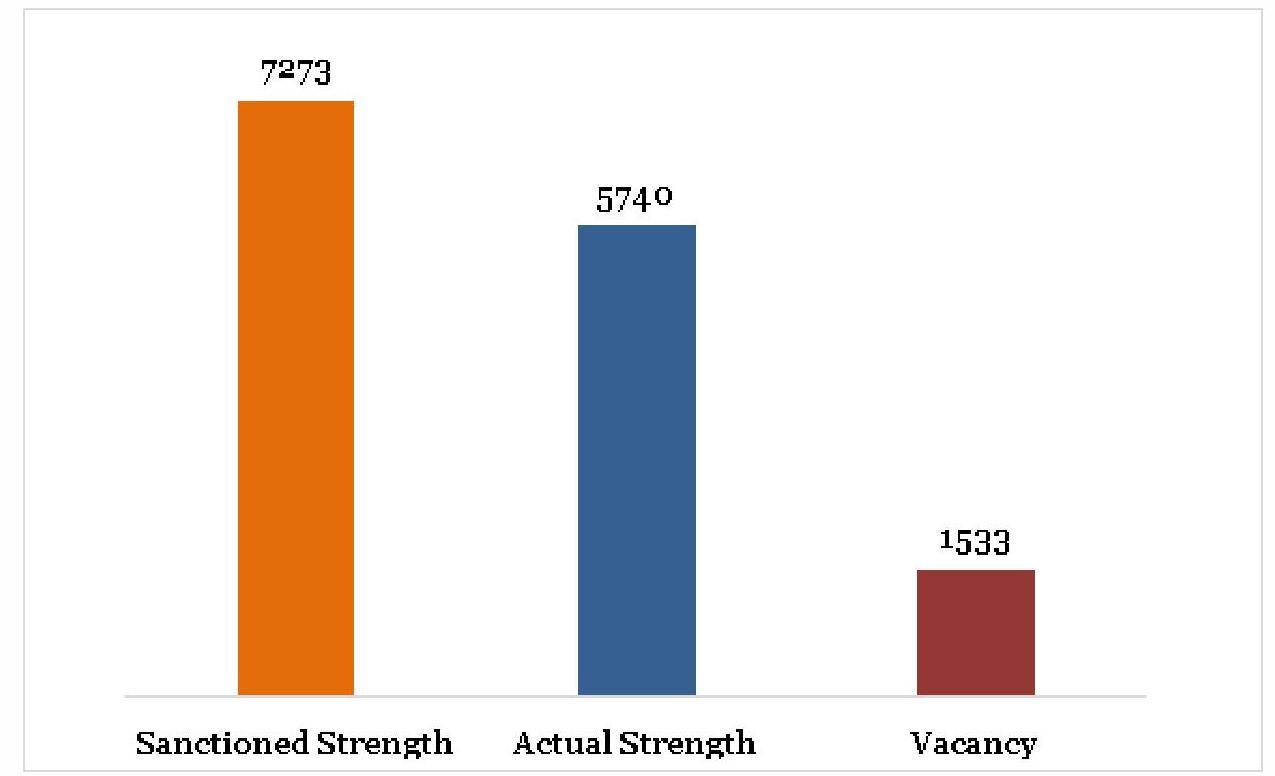
12.57 To provide better office-cumresidential environment, various projects relating to construction of office/residential buildings/quarters in various CBI branches are underway as part of the scheme”Comprehensive Modernization and purchase of land and construction of office/residence buildings for CBI” under which funds to the tune of Rs. 63 Crore were allocated in the Revised Estimates for 202122.
Induction
12.58 During the year 2021, total 199 Officers/Officials were inducted on deputation in CBI in different ranks comprising of Director, CBI (1), Joint Director (3), Superintendent of Police (8), Deputy Superintendent of Police (5), Inspector [(State Police/CPOs/ other Central Govt. org./Bank Officer- (36)], Head Constable (2) and Constable (144).
Extension in Deputation Tenure
12.59 During the year 2021, deputation tenure of 166 personnel was extended in the different ranks comprising of Joint Dierctor (3),
Deputy Inspector General (3), SP (5), DSP (2), Inspector (21), ASI (1), Head Constable (2) and Constable (129).
Direct Recruitment
12.60 During the year 2021, 28 Officers/Officials were recruited in different ranks under direct recruitment quota comprising of Steno Grade-II (11), Junior Hindi Translator (6) and MTS (11).
Departmental Promotion Committee Promotion
12.61 During the year 2021, 7 meetings of DPCs/Review DPCs and 13 Screening Committee for Ad-hoc Promotions of Executive and Ministerial Staff were held and 182 officers/ officials were promoted in different ranks comprising of SP (9), ASP (9), DSP (5), ASI (14), Head Constable (14), Constable (MT) [7], Constable (GD) [58], DLA (3), Sr. PP (8), PP (11), APP (3), CA (2), UDC (6), LDC (32) and PS (1).
Grant of MACP
12.62 During the year 2021, total MACP were
granted to 404 Officers/Officials of different ranks comprising of SP (2), Sr.PP (4), DSP (11), Programmer (2), Assistant Programmer (1), PS (2), CA (16), UDC (16), LDC (56), SG-I (10), SG-II (32), Inspector (69), Sub-Inspector (1), ASI (13), HC (51), Constable (104), Senior Library Information Assistant (1), Data Entry Operator (3) and MTS & Canteen Staff (10).
O. CRIME STATISTICS
Registration
12.63 Criminal Cases viz. Regular Cases (RCs) or Preliminary Enquiries (PEs) were registered by the CBI on the basis of references received from Government Departments, Statutory authorities like Central Vigilance Commission, Constitutional Courts (Hon’ble Supreme Court and High Courts) and references received from the State Governments and also on the basis of its own information. CBI is not the first responder and has limited manpower and resources. So due care is taken to ensure that only good cases are registered.
12.64 During the year 2021, 747 Regular Cases/ Preliminary Enquiries [RCs-680, PEs67] were registered. Out of these 747 cases, 133 cases were taken up on the directions of the Constitutional Courts and 37 cases on the requests of State Governments / Union Territories. Other than these, 15 references including of Lokpal were taken up.
DISPOSAL FROM INVESTIGATION/ENQUIRY
12.65 The investigation in cases was expedited in the year 2021 and as a result, investigation was completed in 884 cases comprising of 798 Regular Cases (RCs) and 86 Preliminary Enquiries (PEs). The investigation is analyzed with the assistance of Law Officers so as to present the best evidence in admissible form before the court of law. Other than this, 11 Lokpal references in form of Inquiry were also completed.
Preliminary Enquiries
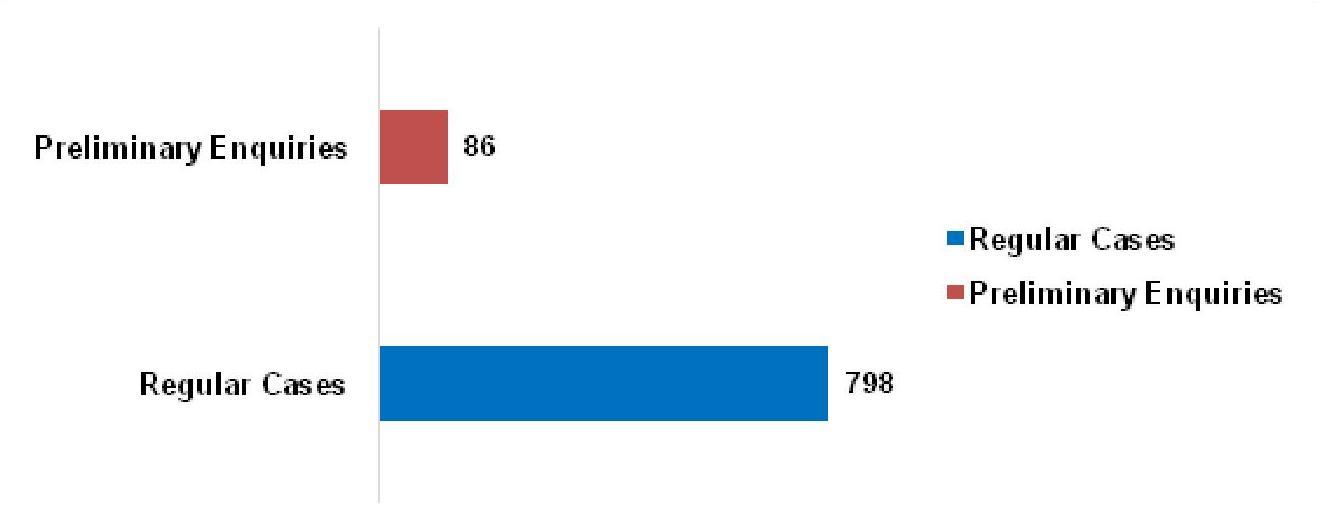
12.66 MODE OF DISPOSAL
12.66.1 Mode of disposal of RCs
Out of 798 RCs, Prosecution, Prosecution \& RDA was recommended in 682 cases, only RDA was recommended in 11 cases. The break-up of the disposal of 798 Regular Cases (RCs) from investigation, is depicted as under:-
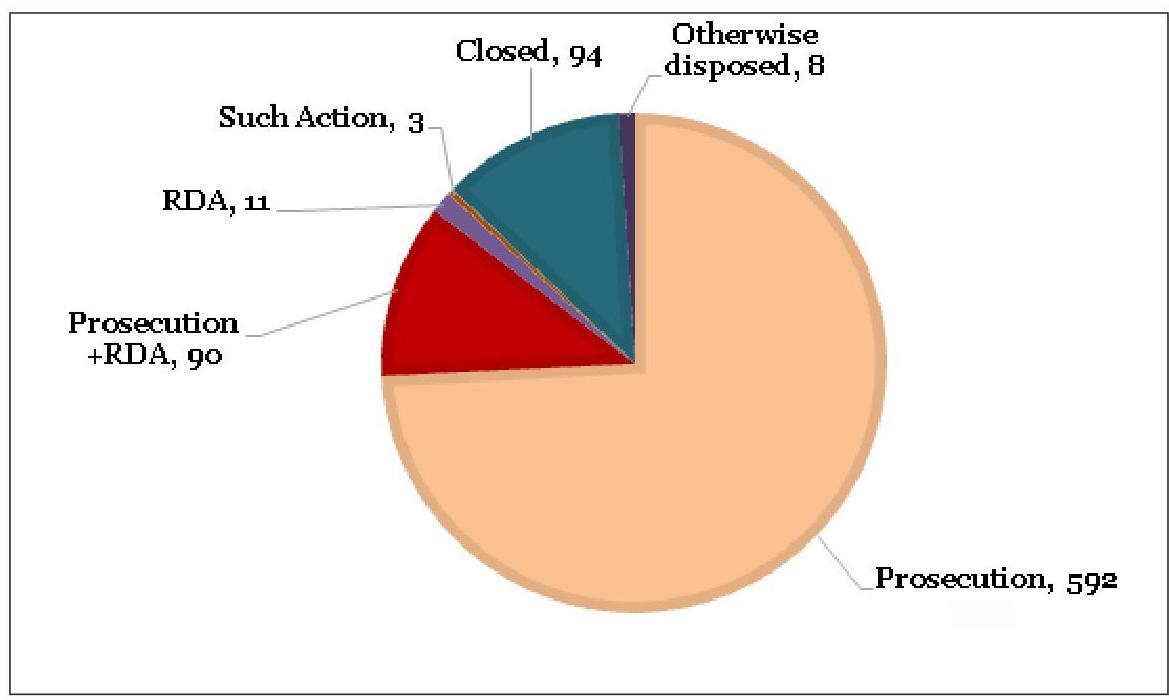
12.66.2 Mode of disposal of PEs
Out of 86 PEs, 21 PEs were converted into Regular Cases (RCs) and RDA was recommended in 10 PEs. The break-up of the disposal of 86 Preliminary Enquiries (PEs), is depicted as under:-
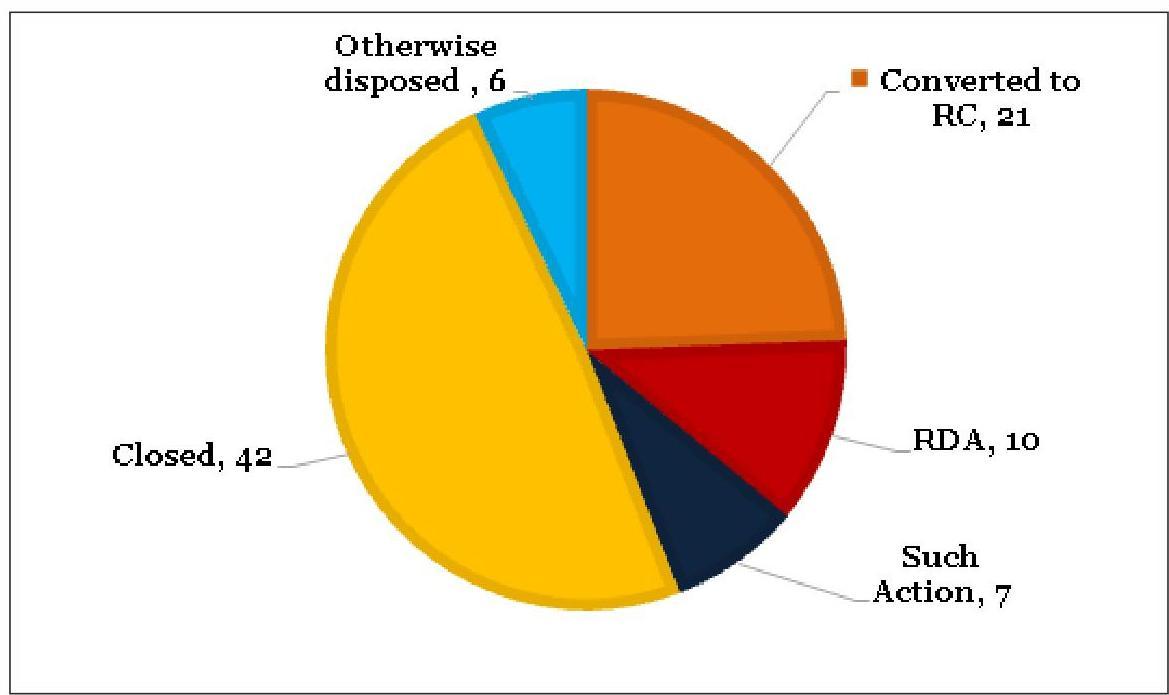
12.67 CASES PENDING UNDER INVESTIGATION/ENQUIRY
A total number of 982 cases (RCs 932, PEs 50) were pending under investigation/ enquiry at the end of the year. Other than this, 04 Lokpal references were pending at the end of year. Out of 932 RCs, 465 RCs were pending under investigation for more than one year. Similarly, out of 50 PEs, 38 PEs were pending under enquiry for more than three months.
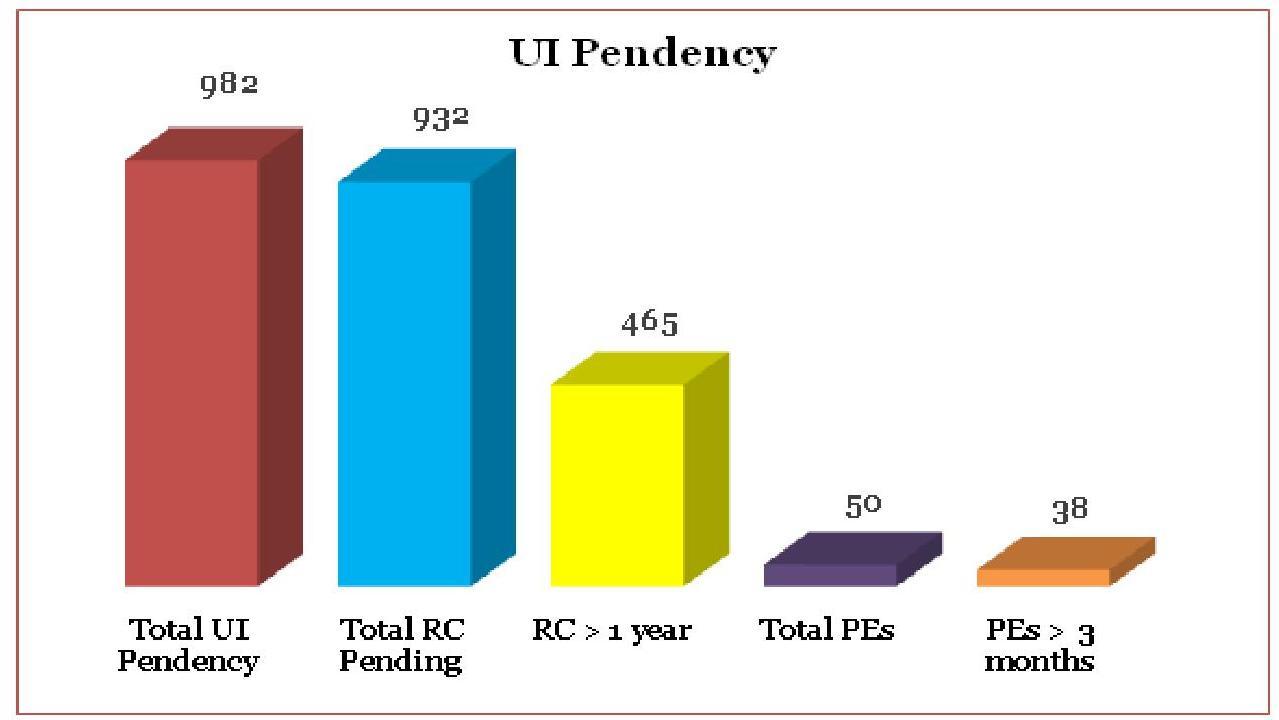
12.68 TRIAL
During the year 2021, Courts delivered Judgements in 360 Court Cases of CBI. Out of these, 202 cases resulted in Conviction, 82 in Acquittal, 15 in Discharge and 61 cases were disposed of for other reasons. The conviction rate was $67.56 %$.
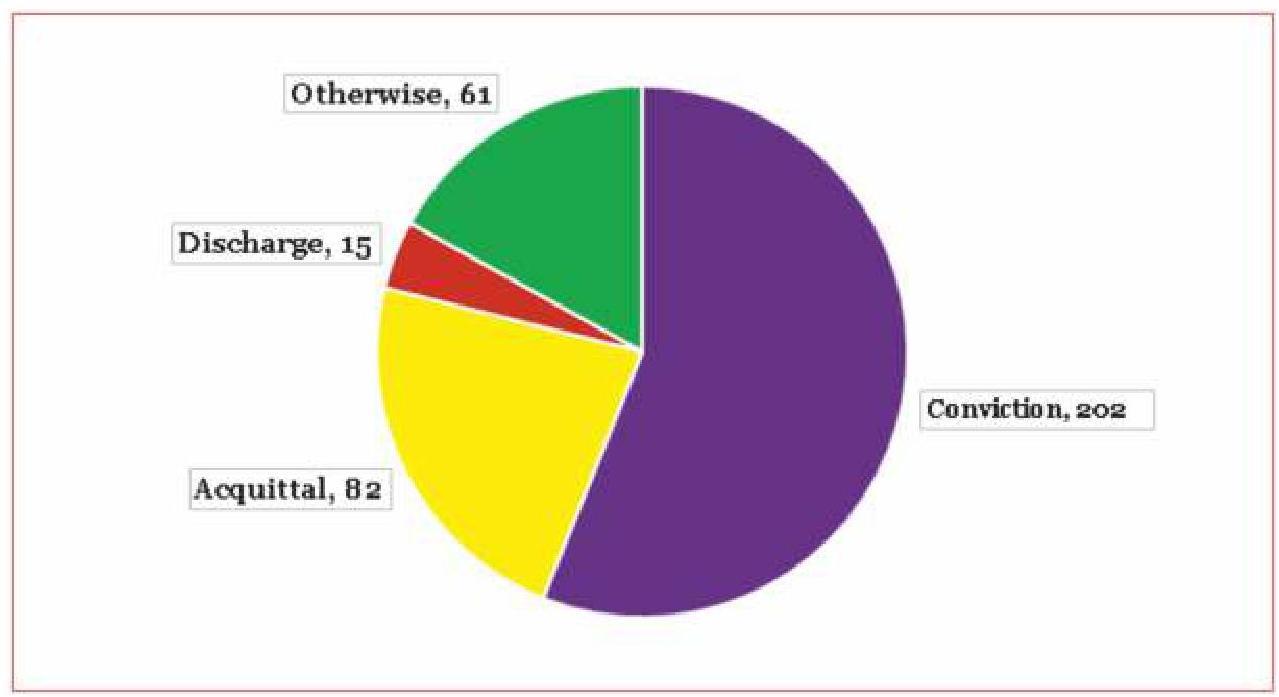
A total number of 10232 Court Cases were pending under trial in various courts as on 31.12 2021.
P. INTERNATIONAL INVESTIGATION AND COORDINATION
Coordination with Law Enforcement/ State/ Union Territory
12.69 CBI plays a key role in facilitating improved coordination between State/UT Police agencies. Tackling interstate crimes and organized crime requires enhanced coordination, information exchange and communication between police agencies across the country. CBI has been active in providing common platform for bringing together police professionals from across the country. Going forward, CBI strives to create more robust and institutionalized platforms for enhanced interstate coordination among police agencies.
CONFERENCES/WORKSHOPS ORGANISED DURING 2021
12.70 CBI Law officers Conference
Conference of CBI Law Officers was organised on 30th October, 2021 at Vigyan Bhawan, New Delhi. The conference was attended by the officers of the level of Assistant Public Prosecutors to Director of Prosecution and also by the Senior officers of CBI. Shri S.K. Jaiswal, Director, CBI chaired the Conference. Important matters related to prosecution and investigations of cases were deliberated during the Conference.
90th GENERAL ASSEMBLY OF INTERPOL
12.71 The 90th General Assembly of INTERPOL is scheduled to be held in New Delhi in 2022. The Flag of INTERPOL was handed over to Shri S.K. Jaiswal, Director, CBI and Head of NCB-India during the 89th INTERPOL General Assembly held in Turkey during 23rd to 25th November, 2021. During the occasion, an Invitational video of India was also shown to all the INTERPOL Member countries.
Election of Shri Praveen Sinha as member from Asia on the Executive Committee of INTERPOL
12.72 Shri Praveen Sinha, Special Director, CBI has been elected as a delegate fromAsia
on the executive committee of INTERPOL in the election held on 25th November 2021, during 89th INTERPOL General Assembly in Turkey.
Engagement with counterpart INTERPOL NCBs
12.73 During the year 2021, NCB-New Delhi held interactions through Video Conference, with counterparts in NCBs of 64 INTERPOL Member countries for enhanced cooperation through INTERPOL channels. During the interactions, the issues of mutual interest for strengthening police cooperation through INTERPOL channels was discussed
12.74 VISIT OF FOREIGN DELEGATION TO CBI HEAD QUARTERS
Visit of Ambassador of Lithuania
H. E. Mr. Julius Pranevicius, Ambassador of Republic of Lithuania visited CBI Headquarters on 19th January, 2021 and interacted with Director, CBI and other CBI senior officers.
MEETING WITH MR. JURGEN STOCK, SECRETARY GENERAL OF INTERPOL
Meeting was held on 26th October, 2021 through video conferencing between Mr. Jurgen Stock, Secretary General of INTERPOL and Shri S K Jaiswal, Director, CBI and various issues of International Police Cooperation through INTERPOL channels was discussed.
VISIT OF POLICE LIAISON OFFICERS
Police Liaison Officers from the USA, UK, Japan, France, Spain, Australia, Germany and Chile visited CBI Headquarter on 27th September, 2021. Shri S.K. Jaiswal, Director, CBI interacted with the delegations and highlighted the importance of mutual police cooperation.
Visit of Deputy Assistant Attorney General, DoJ, USA
A delegation from USA comprising of Shri Arun Rao, Deputy Assistant Attorney General (DOJ Civil Division), Shri Richard Goldberg, Deputy Director, Consumer Protection
Branch, DOJ, Smt. Dayna R Kendall, FBI Supervisory Special Agent, Shri Mathew Reynolds, Senior Special Agent, FBI, Representatives from FBI, LEGAT Office, New Delhi visited CBI Headquarter during 18–20, October, 2021. The Delegation met with senior officers of CBI and issues related to cyber-crimes and cyber-enabled financial crimes were discussed.
12.75 LETTERS ROGATORY (OUTGOING)
During the year 2021, 50 Letters Rogatory (LRs) were sent abroad, out of which 19 LRs pertained to CBI cases and 31 pertained to State Law Enforcement and Central Law Enforcement agencies. It was confirmed by Indian Law Enforcement Agencies including CBI that 24 LRs are fully executed. These 24 LRs include 18 LRs of CBI and 6 LRs of State Police and other Law Enforcement Agencies. During the year 2021, 20 LRs were also treated as closed. Out of these 20 LRs, 06 relate to CBI and 14 relate to other Law Enforcement Agencies. As on 31.12.2021, a total of 502 LRs were pending with other countries, out of which 273 pertained to CBI cases and 229 pertained to State Police and other Central Law Enforcement Agencies.
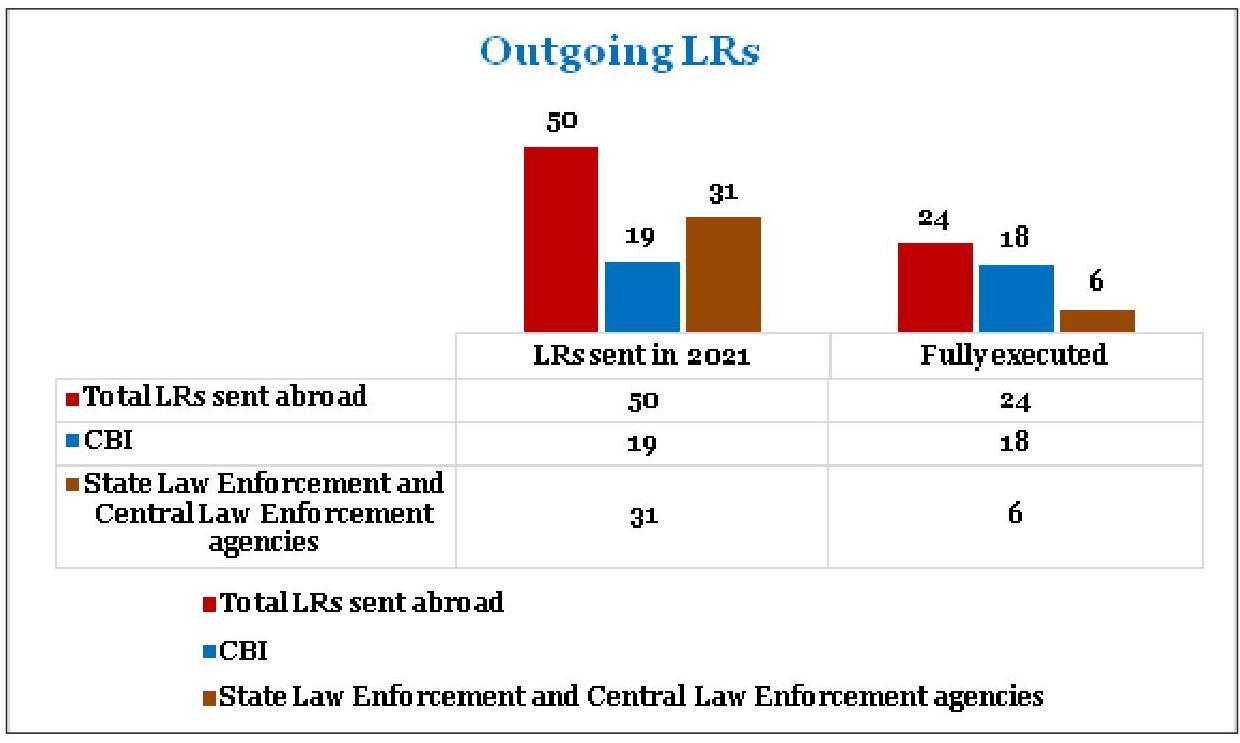
12.76 LETTERS ROGATORY (INCOMING)
During the year 2021, 109 Letters Rogatory (LRs) / Treaty Based Requests were received from various countries, requesting to provide assistance in investigation of criminal matters. Execution Reports in 120 cases were sent to MEA/MHA, after receiving the same from Indian Investigating Agencies, for onward transmission to the law enforcement agencies of the requesting countries. Besides these, 06 LRs were otherwise disposed of as closed or withdrawn. As on 31.12.2021, 144 LRs were pending for execution.
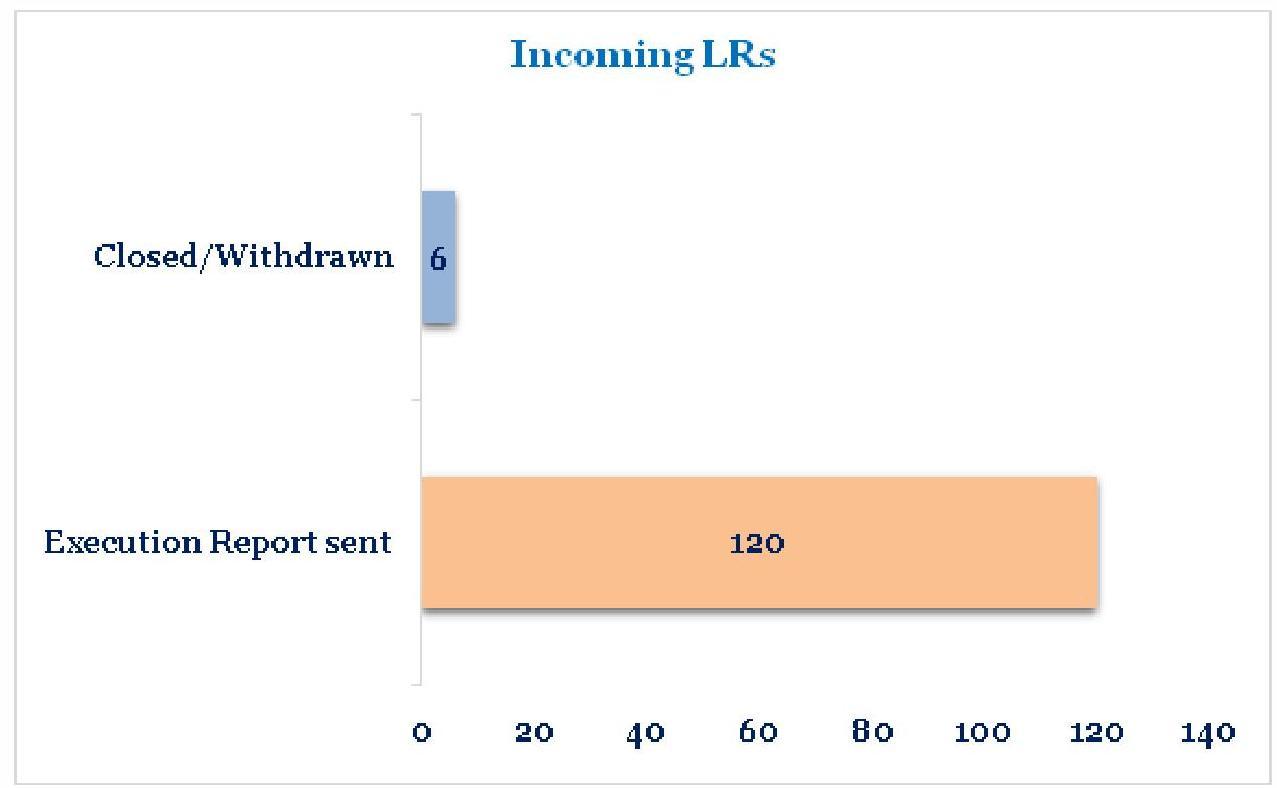
Interpol Notices
12.77 During 2021, notices as per details below, were published by NCB-India:-
| Red Notices | 47 |
|---|---|
| Blue Notices | 71 |
| Yellow Notices | 06 |
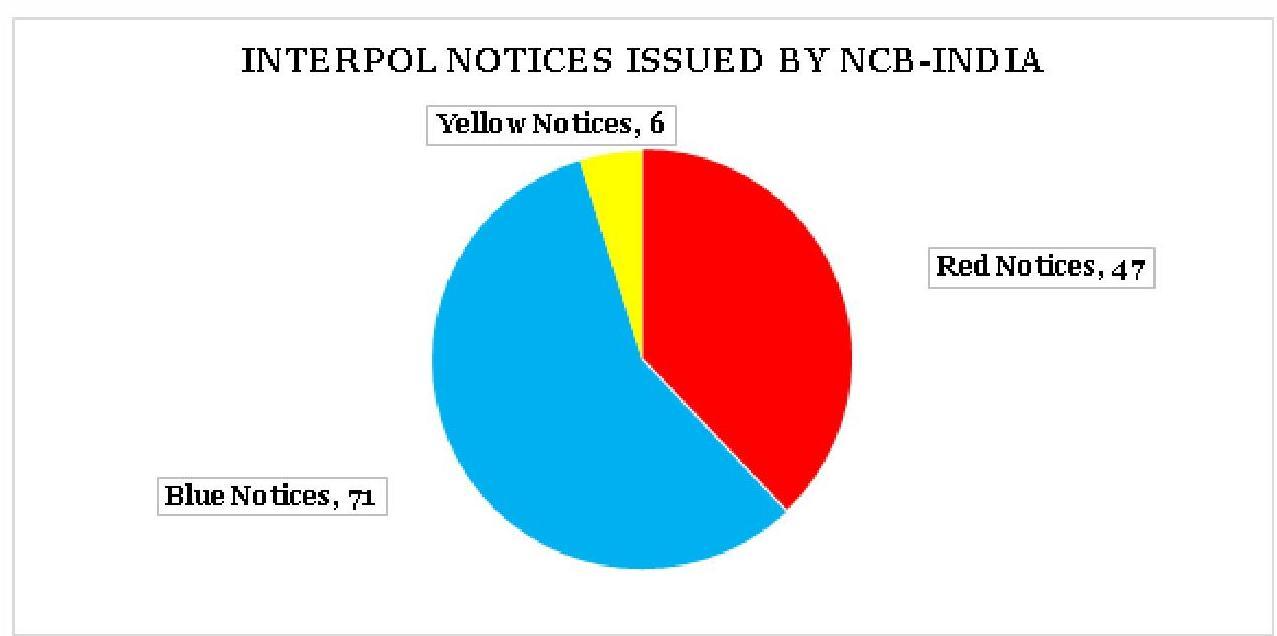
Extradition / Deportation
12.78 During the year 2020, the following numbers of fugitives were extradited/ deported/ arrested/located: –
| Wanted Persons/Fugitives wanted by India located abroad | 36 |
|---|---|
| Wanted Persons/Fugitives wanted by other countries, detected/ located in India |
136 |
| Wanted Persons/Fugitives returned to India from abroad/ arrested/ located in India on the basis of LoC |
18 |
Interpol Stolen and Lost Travel Documents (SLTD) Database
12.79 NCB, India has uploaded data relating to lost/stolen/revoked Indian Passports into the INTERPOL SLTD Database being maintained by IPCU Branch. Till 31.12.2021, data of 20,90,556 Stolen/Lost/Revoked Indian Passports has been uploaded in the SLTD Database. Upto 31.12.2021, 1270 cases of use of STLD recorded Indian Passports have been reported/detected by various other NCBs.
Interpol Global Communication System [IGCS] Messages Received During 2020
12.80 The four Regional Desks received 8281 requests/ IGCS message/ letters from January 2021 to December 2021 from various NCBs, PLOs and Indian Law Enforcement agencies/authorities regarding various matters on police-to-police cooperation basis. The four regional desks of NCB-India also worked in close coordination with other NCBs and rendered necessary guidance to them on various issues.
During the year 2021, 104 numbers of Purple Notice alerts published by INTERPOL for various kinds of modus-operandi used by criminals, were shared with Indian Law EnforcementAgencies/MAC/ICMR.
R. CAPACITY BUILDING
12.81 In the year 2021, CBI Academy and the three Regional Training Centres (functioning at Kolkata, Mumbai and Chennai) conducted a total of 98 courses and trained 3190 Officers/Officials.
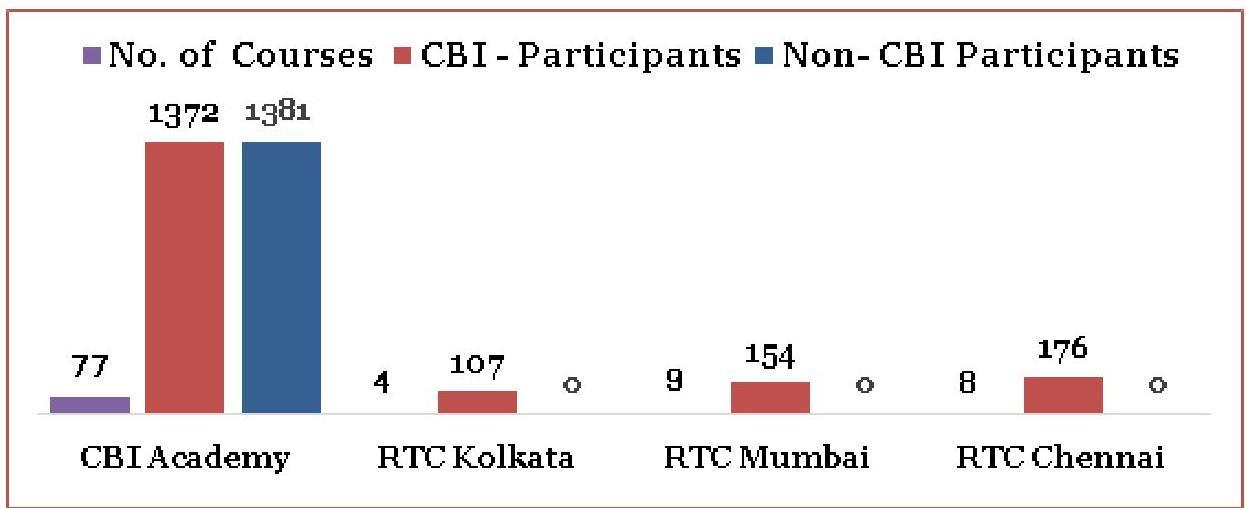
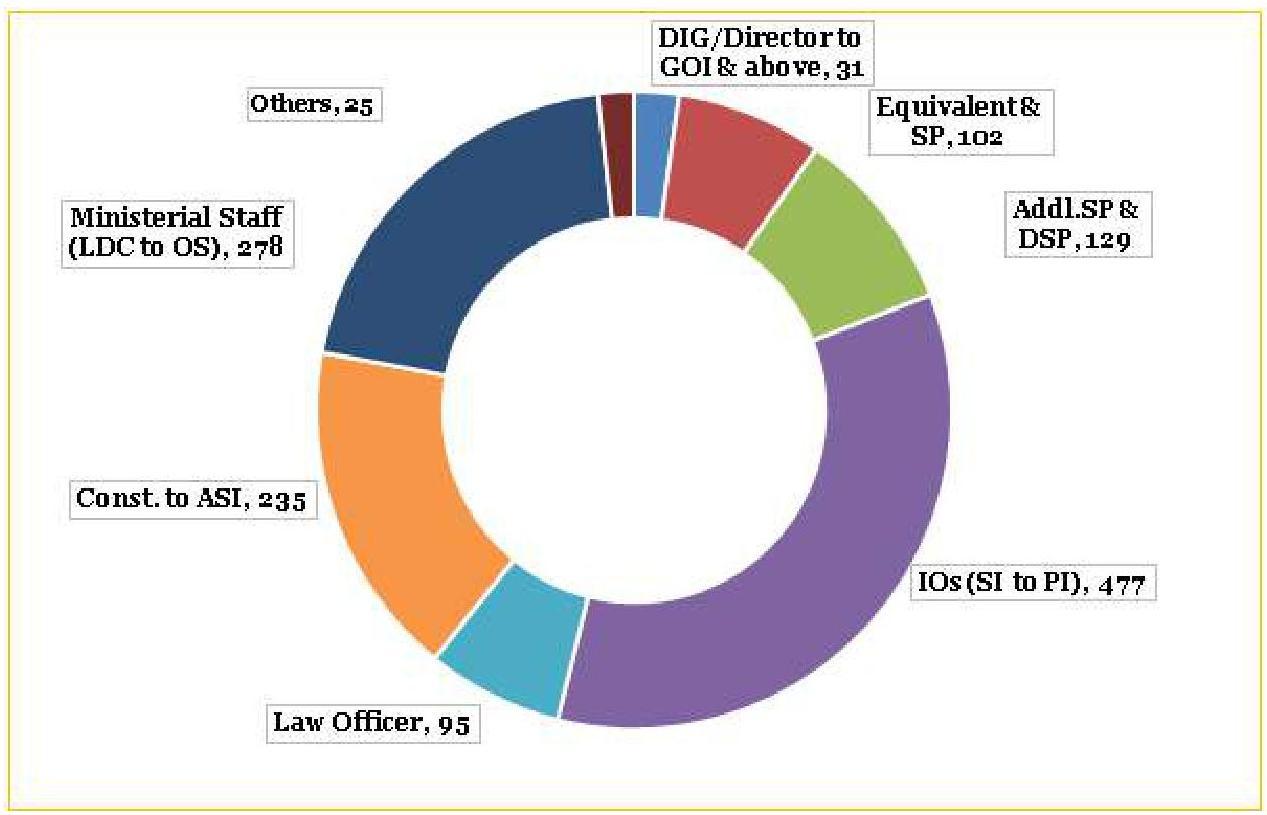
12.82 Specific courses conducted for CBI officers
| No. of courses | Participants | Participants | |
|---|---|---|---|
| Nurses | 150 | 82 | 571 |
| Institutions | 64 | 4 | 211 |
| Total | 150 | 82 | 523 |
| Total | 150 | 82 | 523 |
Note: – ^{2} Participants in the CBI office are not included in the CBI program. – ^{3} Participants in the CBI program are not included in the CBI program. – ^{4} Participants in the CBI program are not included in the CBI program.
12.83 TRAINING TO STATE POLICE AND OTHER ORGANIZATIONS
These courses were conducted exclusively for the requesting organization or police agency. Some of these were:-
- 03 Online Training to 157 Officers of ACB, Andhra Pradesh Police on below mentioned subject:-
- Trap Cases
- Economic Offences and
- Cyber Crime Investigation
- 5 days training course on PC Act, Trap, DA & search \& seizure for UP Police officers at Lucknow conducted in Hybrid mode.
- 03 Training courses for Inquiry / Presenting officers under the jurisdiction of the CVC.
AWARDS AND ACCOLADES TO CBI OFFICERS DURING 2020
12.84 PRESIDENT’S POLICE MEDAL \& POLICE MEDAL
During the year 2021, twelve (12) officers of Central Bureau of Investigation have been awarded President’s Police Medals (PPM) for Distinguished Services and forty-eight (48) officers of Central Bureau of Investigation were awarded Police Medal (PM) for Meritorious Services on the occasions of the Republic Day, 2021 and the Independence Day, 2021.
12.85 INVESTITURE CEREMONY
An ‘Investiture Ceremony’ was organised by CBI on 12.12.2021 at CBI Headquarters, New Delhi. Dr. Jitendra Singh, Union Minister of State (Independent Charge) for Science \& Technology; Minister of State (Independent Charge) for Earth Sciences; MoS PMO, Personnel, Public Grievances, Pensions, Atomic Energy and Space was the Chief Guest at the event which was also graced by Shri Pradip Kumar Tripathi, Secretary (Personnel) and Shri Suresh N. Patel, Chief Vigilance Commissioner.
12.86 AWARD OF UTKRISHT \& ATI UTKRISHT SEVA PADAK
During the year 2021, thirty-five (35) officers of Central Bureau of Investigation were awarded Ati Utkrisht Sewa Padak for their 25 years of continuous service with special distinguished
record and seventy-one (71) officers of Central Bureau of Investigation were awarded Utkrisht Sewa Padak for their 15 years of continuous service with special distinguished record.
12.87 UNION HOME MINISTER’S MEDAL FOR EXCELLENCE IN INVESTIGATION AWARDED TO CBI PERSONNEL
During the year 2021, fifteen (15) officers were awarded Union Home Minister’s Medal for Excellence in Investigation for the year, 2021.
12.88 ASADHARAN AASUCHANA KUSALATA PADAK
During the year 2021, 02 officers were awarded ‘Asadharan Aasuchana Kusalata Padak’ for exceptional courage and skill in intelligence service.
12.89 UNION HOME MINISTER’S MEDAL FOR EXCELLENCE IN POLICE TRAINING
During the year 2021, 02 officers were awarded ‘Union Home Minister’s Medals for Excellence in Police Training’.
FUTURE ROADMAP
12.90 Perspective Future Plan
CBI strives for excellence in investigation and prosecution of offences by bench marking its standards with the best law enforcement institutions in the world. Accordingly, there is a constant endeavour to understand the changes in national and global scenario, identified perspective future plans as under:-
- Expediting Investigation by Multidisciplinary Teams with greater technical support.
- Enhancing operational capabilities so as to detect crime, especially cases of Collusive Corruption.
- Making comprehensive investigation, using the various data fields and open source information.
- Enhanced coordination with State Police and liaison with INTERPOL.
- Achieving greater specialization in niche areas like On-line child Sexual Abuse offences, Cyber Crime, Arts and Antiquities etc.
- Focus on Training and re-Training
- Emphasis on Preventive Vigilance and intelligence collection so as to check corruption at the origin.
- Coordinating with Private Sector for promoting integrity.
CHAPTER
13
JOINT CONSULTATIVE MACHINERY
13.0 The Scheme for Joint Consultative and Compulsory Arbitration for the Central Government Employees was introduced in the year 1966 on the lines of the Whitely Councils in the U.K. The scheme provides a platform for constructive dialogue & discussion between the representatives of the staff side and the official side for peaceful resolution of all disputes between the Government as employer and the employees. The scheme was introduced with the objectives of promoting harmonious relations and securing the greatest measure of cooperation between the Central Government as the employer and the employees in matters of common concern and with the object of further increasing the efficiency of the public service combined with the well being of those employed.
13.1 The JCM Scheme provides for threetier machinery:
(i) The National Council as the apex body; (chaired by the Cabinet Secretary);
(ii) Departmental Councils at the level of individual Ministries / Departments including their attached and subordinate offices and (chaired by respective Secretaries); and
(iii) Regional / Office Councils to deal with mainly the local problems at the level of each individual office, depending on its structure. (Chaired by Head of the office of respective organizations).
13.2 The scope of the JCM Scheme includes all matters relating to:
- conditions of service and work;
- the welfare of the employees; and
- improvement of efficiency and standards of work,
13.2.1 Provided, however that: in regard to recruitment, promotion and discipline, consultation is limited to matters of general principles; and Individual cases are not considered.
National Council (JCM)
13.3 So far, 48 meetings of the National Council (JCM) have been held, under the Chairmanship of Cabinet Secretary, since its inception in 1966. The last, i.e. the 48th meeting of the National Council (JCM), chaired by the then Cabinet Secretary (Shri Rajiv Gauba), was held on 26.06.2021. In the meeting 29 Agenda Items were discussed.
National Council may have two Standing Committees; i) for the Non- Industrial employees, ii) Industrial employees. The Official Side of the National Council consists of 25 Members and the Staff Side consists of 60 Members.
Standing Committee Meeting of the National Council (JCM) :
13.4 Standing Committee meeting of the National Council (JCM) was held on 26th February, 2021 under the Chairmanship of the Secretary (P) (Shri Deepak Khandekar). In the meeting 49 Agenda Items were deliberated upon.
ARBITRATION
13.5 An important feature of the JCM Scheme is the provision for arbitration in cases where there is no agreement between the Official Side and the Staff Side on matters relating to:-
- pay and allowances;
- weekly hours of work; and
- leave, for a class or grade of employees.
BOARD OF ARBITRATION (BOA)
13.6 A Board of Arbitration (BOA) comprising three Members; a Chairman (an independent person) and two Members, nominated, (one each by Staff Side and Official Side), functions under the administrative control of the Ministry of Labour \& Employment. Award of the Board of Arbitration is binding on both sides, subject to the over-riding authority of Parliament to modify or reject the Award.
CHAPTER
14
ADMINISTRATIVE TRIBUNALS
14.0 The Administrative Tribunals Act, 1985 owes its origin to Article 323-A of the Constitution of India which empowers Central Government to set up Administrative Tribunals by an Act of Parliament for adjudication of grievances and disputes arising out of the conditions of service of an employee appointed to the public services and posts in connection with the affairs of the Union and the States. In pursuance of the provisions contained in the Administrative Tribunals Act, 1985, the Administrative Tribunals, set up under it, exercise original jurisdiction in respect of service matters of employees covered by the Act. As a result of the Supreme Court’s judgment dated 18.03.1997 in the case of L. Chandra Kumar & Others Vs UOI, the appeals against the orders of an Administrative Tribunal shall lie before the Division Bench of the concerned High Court.
14.1 The Administrative Tribunals are distinguishable from the ordinary courts with regard to their jurisdiction and procedure. They exercise jurisdiction only in relation to the service matters of the litigants covered by the Act. They are also free from many of the procedural technicalities of the ordinary courts. The procedural simplicity of the Act can be appreciated from the fact that the aggrieved person can also appear before it personally. Government can also present its cases through its departmental officers or legal practitioners. Further, only an affordable and nominal fee of ₹ 50 is to be paid by the applicants for filing the original application before the Tribunal. Thus, the objective of the Tribunal is to provide speedy and affordable redress to the aggrieved applicants arising out of employment or conditions of service.
14.2 The Central Administrative Tribunal was set up on 01.11.1985. As on date, it has 19 regular Benches, 17 of which operate at the principal seats of High Courts and the
remaining two at Jaipur and Lucknow. Two newly Benches at Jammu and Srinagar have been created. The Jammu Bench was made functional w.e.f. 08.06.2020 and the Srinagar Bench has been made functional w.e.f. 23.11.2021. A statement showing the location of Central Administrative Tribunal Benches, the dates of their establishment and the number of courts in each of these Benches along with a list of places where they hold Circuit Sittings is given in Appendix-I.
14.3 The Tribunal consists of a Chairman and Members. It has also been the constant endeavour of this Ministry to ensure that the posts of Chairman and Members are filled up well in time and no post remains vacant for long time. The Members of Central Administrative Tribunal (CAT) and State Administrative Tribunals (SATs) are drawn from judicial as well as administrative streams, so as to give the Tribunal the benefit of domain expertise both in legal and service matters. The sanctioned strength of Members of Central Administrative Tribunal is 70 (including Chairman, CAT), out of which 35 are Judicial Members and 35 are Administrative Members. As per Tribunals Reforms Act, 2021, the Chairman can be a Judicial Member or an Administrative Member.
14.4 The appointment of Members in CAT is made on the basis of the recommendations of a Search-cum-Selection Committee chaired by Chief Justice of India or a sitting Judge of Supreme Court (nominated by the Chief Justice of India). After consulting the Hon’ble Chief Justice of India, appointments are made with the approval of Appointments Committee of the Cabinet.
14.5 State Administrative Tribunals (SATs) were also set up in the following States:
(i) Karnataka
(ii) Maharashtra
(iii) West Bengal
(iv) Kerala
(iv) Haryana (not functional)
14.6 The appointments to the vacancies in SATs are made on the basis of proposals sent by the State Governments. Thereafter, their appointments undergo the same process as the one in respect of Central Administrative Tribunal.
14.7 Since its inception in 1985 and up to 31.10.2021, the Central Administrative Tribunal received 8,65,619 cases for adjudication (including those transferred from High Courts), out of which 7,92,685 cases have been disposed of, leaving a pendency of 72,934 cases. On an average, about $89.15 %$ of the cases instituted are disposed of. A statement indicating the institution, disposal and pendency of cases since inception of CAT is at Appendix-II.
14.8 Section 14(2) of the Administrative Tribunals Act, 1985 empowers the Central Government to extend the provisions of the Act to local or other authorities within the territory of India or under the control of Government of India and to Corporations or Corporations or Societies owned or controlled by Government of India. In exercise of these powers, the Central Government had
extended the provisions of the Act to 214 organizations so far.
14.9 In order to familiarize the newly appointed Members of CAT with the functioning of the Tribunal, a short Orientation Programme / Training is held from time to time. So far, four such Orientation Programme / Training have been held at the National Judicial Academy, Bhopal.
14.10 Further, for maintaining absolute integrity and promoting fair practices in the professional court dealings and keeping in view the general directions of the Hon’ble Supreme Court, the designated Selection Committee, in its meeting decided that a Judicial Member of CAT, who earlier practiced as Advocate in a Court in that station, should not normally be considered for posting in the CAT Bench of the same station.
14.11 It has been the constant endeavour of the Government to strengthen the infrastructure in all the Benches of CAT for their smooth functioning. For this purpose, allocation of funds for purchase of land and construction of building during the period 2016-17 to 2021-22 is as under.
| Year | Allocation (Rs. In crore) |
|---|---|
| $2016-17$ | 10.93 |
| $2017-18$ | 3.50 |
| $2018-19$ | 4.57 |
| $2019-20$ | 9.98 |
| $2020-21$ | 8.00 |
| $2021-22$ | 10.00 |
14.12 Hon’ble Mrs. Manjula Das has been authorized to act as Chairman of CAT with effect from 01.08.2021.
APPENDIX-I
NAME, DATE OF SETTING, NO. OF COURTS AND LOCATION OF VARIOUS BENCHES OF CENTRAL ADMINISTRATIVE TRIBUNAL
| S.No. | Name of the Bench | Date of setting | No. of courts | Location |
|---|---|---|---|---|
| 1. | PRINCIPAL BENCH | 01.11 .1985 | 6 | NEW DELHI |
| 2. | AHMEDABAD | 30.06 .1986 | 1 | AHMEDABAD |
| 3. | ALLAHABAD | 01.11 .1985 | 4 | ALLAHABAD |
| 4. | BANGALORE | 03.03 .1986 | 2 | BANGALORE |
| 5. | CHANDIGARH | 03.03 .1986 | 2 | CHANDIGARH |
| 6. | MADRAS | 01.11 .1985 | 2 | CHENNAI |
| 7. | CUTTACK | 30.06 .1986 | 1 | CUTTACK |
| 8. | ERNAKULAM | 01.09 .1988 | 2 | ERNAKULAM |
| 9. | GUWAHATI | 03.03 .1986 | 1 | GUWAHATI |
| 10. | HYDERABAD | 03.06 .1986 | 2 | HYDERABAD |
| 11. | JABALPUR | 30.06 .1986 | 1 | JABALPUR |
| 12. | JAIPUR | 15.10 .1991 | 1 | JAIPUR |
| 13. | JODHPUR | 30.06 .1986 | 1 | JODHPUR |
| 14. | CALCUTTA | 01.11 .1985 | 2 | KOLKATA |
| 15. | LUCKNOW | 15.10 .1991 | 1 | LUCKNOW |
| 16. | MUMBAI | 01.11 .1985 | 2 | MUMBAI |
| 17. | PATNA | 30.06 .1986 | 2 | PATNA |
| 18. | JAMMU | 08.06 .2020 | 1 | JAMMU |
| 19. | SRINAGAR | 23.11 .2021 | 1 | SRINAGAR |
STATEMENT SHOWING THE NAME OF BENCH AND PLACES WHERE CIRCUIT SITTINGS ARE HELD
| BENCH | PLACES |
|---|---|
| 1. ALLAHABAD BENCH | Nainital |
| 2. CALCUTTA BENCH | Port Blair, Gangtok |
| 3. CHANDIGARH BENCH | Shimla |
| 4. MADRAS BENCH | Pondicherry |
| 5. GUWAHATI BENCH | Shillong, Itanagar, Kohima, Agartala, Imphal, Aizwal |
| 6. JABALPUR BENCH | Indore, Gwalior, Bilaspur |
| 7. BOMBAY BENCH | Nagpur, Aurangabad, Panaji |
| 8. PATNA BENCH | Ranchi |
| 9. ERNAKULAM BENCH | Lakshadweep |
APPENDIX-II STATEMENT SHOWING THE POSITION OF INSTITUTION, DISPOSAL AND PENDENCY OF CASES IN THE CENTRAL ADMINISTRATIVE TRIBUNAL SINCE INCEPTION UPTO MARCH, 2022. (As provided by Central Administrative Tribunal, Principal Bench from time to time)
| S.no | PERIOD | INSTITUTION | DISPOSAL | PENDENCY AT THE END OF THE YEAR |
|---|---|---|---|---|
| 1. | 1985 | 2,963 | 30 | 2,933 |
| 2. | 1986 | 23,177 | 8,934 | 17,176 |
| 3. | 1987 | 19,410 | 15,084 | 21,502 |
| 4. | 1988 | 19,425 | 13,769 | 27,158 |
| 5. | 1989 | 18,602 | 13,986 | 31,774 |
| 6. | 1990 | 19,283 | 15,495 | 35,562 |
| 7. | 1991 | 21,623 | 17,552 | 39,633 |
| 8. | 1992 | 25,184 | 23,782 | 41,035 |
| 9. | 1993 | 27,067 | 28,074 | 40,028 |
| 10. | 1994 | 26,230 | 26,409 | 39,849 |
| 11. | 1995 | 25,789 | 23,668 | 41,970 |
| 12. | 1996 | 23,584 | 20,667 | 44,887 |
| 13. | 1997 | 23,098 | 21,981 | 46,004 |
| 14. | 1998 | 21,911 | 18,394 | 49,521 |
| 15. | 1999 | 22,944 | 24,566 | 47,899 |
| 16. | 2000 | 25,146 | 31,398 | 41,647 |
| 17. | 2001 | 25,977 | 31,953 | 35,671 |
| 18. | 2002 | 25,398 | 29,514 | 31,555 |
| 19. | 2003 | 25,089 | 28,076 | 28,568 |
| 20. | 2004 | 23,825 | 27,735 | 24,658 |
| 21. | 2005 | 21,528 | 22,408 | 23,778 |
| 22. | 2006 | 18,722 | 17,774 | 24,726 |
| 23. | 2007 | 17,725 | 18,674 | 23,777 |
| 24. | 2008 | 18,287 | 20,352 | 21,712 |
| 25. | 2009 | 24,496 | 23,681 | 22,527 |
| 26. | 2010 | 26,620 | 25,477 | 23,670 |
| 27. | 2011 | 25,869 | 24,750 | 24,789 |
| 28. | 2012 | 27,733 | 24,206 | 28,316 |
|---|---|---|---|---|
| 29. | 2013 | 27,442 | 21,654 | 34,104 |
| 30. | 2014 | 27,913 | 24,739 | 37,278 |
| 31. | 2015 | 29,089 | 25,150 | 41,217 |
| 32. | 2016 | 26,984 | 26,266 | 41,935 |
| 33. | 2017 | 25,402 | 20,055 | 47,282 |
| 34. | 2018 | 26,309 | 23,538 | 50,053 |
| 35. | 2019 | 24,998 | 26,040 | 49,011 |
| 36. | 2020 | 25,888 | 12,616 | 62,283 |
| 38. | 2021 | 29,679 | 17,395 | 74,567 |
| 39. | Upto March, | 6,127 | 4,397 | 76,297 |
| Total | $\mathbf{8 , 7 6 , 5 3 6}$ | $\mathbf{8 , 0 0 , 2 3 9}$ |
CHAPTER
15
STAFF WELFARE
15.0 The Central Government is the largest single employer in the country and bears the major responsibility for looking after the welfare of a large number of employees spread all over the country. Realizing that improvement in the working and living conditions of the employees and their families leads to efficiency and high morale, the Department of Personnel and Training supports various staff welfare measures. A brief account of various welfare measures dealt with by the Welfare Division is given below.
RESIDENTS’ WELFARE ASSOCIATION
15.1 In order to foster a spirit of mutual help and goodwill among residents of Government colonies and to promote social, cultural and recreational activities, Department of Personnel & Training (DoPT) has been encouraging formation of Central Government Employees Residents’ Welfare Associations (CGERWAs). Every CGERWA seeking reorganization and grants-in-aid from Government is required to adopt Model Constitution prescribed by DOPT. The members of the Managing Committee of these Associations are elected every two years under the Provisions of a Model Constitution framed by the Department of Personnel \& Training. This Department Sanctions grants-in-aid only to recognized Associations, subject to a maximum of Rs. 10,000/- per annum for an Association.
AREA WELFARE OFFICERS
15.2 The Area Welfare Officers (AWOs) are nominated in residential colonies having a large number of Central Government employees. The AWOs serve as a link between the Government and residents in matters relating to the welfare of the Government employees living in various colonies. They also work as field officers in coordinating and maintaining liaison with
various agencies of Government such as CPWD, CGHS, Police etc. Applications are invited from Gazetted officers working in various Ministries/Departments for being nominated as Area Welfare Officers for a period of two years. Officers desirous of being nominated as AWOs on voluntary and honorary basis are required to apply through their respective Ministries/ Departments.
CENTRAL CIVIL SERVICES CULTURAL \& SPORTS BOARD (CCSCSB)
15.3 The Central Civil Services, Cultural \& Sports Board, a society registered under the Societies Registration Act, 1860 is the Central agency for promotion of Cultural \& Sports activities amongst the Central Government employees in the country. The Board was set up in 1964 as Central Secretariat Club in the Ministry of Home Affairs. Initially, the objective of the Board was to promote cultural and sports activities amongst the Central Government Employees located in Delhi only. Subsequently, Regional Sports Boards were set up in various states. Financial grants-in-aid is sanctioned every year by the Board to the Regional Boards.
ACTIVITIES OF THE BOARD INTER MINISTRY TOURNAMENTS 2021-22
15.4 The Board organizes Inter-Ministry Tournaments in 18 disciplines of sports. CCSCSB has successfully organized inter ministry tournaments in all 12 disciplines of sports.
AII INDIA CIVIL SERVICES TOURNAMENTS HELD DURING THE YEAR 2021-22
15.5 These tournaments, which are open to Central and State Government employees, aim to give an opportunity to the civil servants to meet and interact with each other and compete. AICS Tournaments are being organized in collaboration with different States/UTs.
NEW ACTIVITIES UNDERTAKEN BY THE BOARD IN 2021-22
15.6(1) In the year 2021-22 the CCSCSB has organized first ever womens Sports Meet for women employees at Vinay Marg Sports Complex on 22nd Dec, 2021 to celebrate Azadi ka Amrit Mahotsav. Aprrox 800 women participated.
15.6(2) All India Civil Services Music & Dance was organised after a period of 15 years.
15.6(3) Online Music \& Dance Competition for wards of Central Government Employees was also held.
SCHEME FOR PROMOTION OF ADVENTURE SPORTS \& SIMILAR ACTIVITIES AMONGST CENTRAL GOVERNMENT EMPLOYEES
15.7 As a welfare measure, the CCSCSB launched a Scheme for promotion of adventure sports and similar activities amongst Central Government Employees working in the Ministries/Departments. The Scheme includes up to 10 days programme having components of environmental awareness, disaster management, team spirit, capacity building, and Swachh Bharat Campaign and activities like Trekking, Mountaineering, Rock-Climbing, Cycling in a difficult terrain, Skiing, Rafting, Para Sailing, Jungle Safari and Environmental Awareness Camps etc.
15.8 It is expected that participation by Central Government Employees in adventure sports and similar activities will give them a platform where they would learn lessons from nature and use the knowledge acquired for welfare of the society. It would also foster spirit of risk-taking, cooperative team work, and capacity of readiness, vital response to challenging situations, endurance and environmental awareness.
15.9 CCSCSB provides financial assistance up to Rs.20,000/- including to and fro travel charges to the Central Govt. employees.
PARTICIPATION OF GOVERNMENT EMPLOYEES AND THEIR FAMILIES IN SPORTING ACTIVITIES CONDUCTED IN COLLABORATION WITH SAI
15.10 The Board has Introduced Scheme for Swimming for Central Government Employees and their children in collaboration with Sports Authority of India at Major Dhyanchand National Stadium \& Talkatora Stadium New Delhi. Under the Scheme, Government employees and their dependents/families avail the facility of Swimming at nominal charges. Badminton, Table tennis and Fitness Centre facilities are also extended to Government Employees under “Come and Play” scheme of Sports Authority of India to the employees and their families. Under this scheme, the amount charged by SAI is reimbursed to the beneficiary after deduction of nominal fee.
BOARD’S AFFILIATION TO NATIONAL FEDERATION
15.11 The Board is affiliated to a number of sports associations/federations at the National level. Board’s teams participate in the National Tournaments organized by these Associations/Federations in Kabaddi, Hockey, Football, Carrom, Cricket and Chess.
SPORTS FACILITIES IN DELHI
15.12 The Board has a sports complex at Vinay Marg, New Delhi which has facilities for Football, Hockey, Cricket, Athletics, Lawn Tennis, Basketball, Volleyball and practice pitches for Cricket. The Board also maintains lawn Tennis Courts at Brassy Avenue, Bharti Nagar, Pandara Road and R.K.Puram Sector 13, New Delhi, Brassy Avenue has facilities for Cricket practice pitches also. There is facility for Indoor games such as Table Tennis, Carrom and Chess at Nirman Bhawan, New Delhi. Open Gym facilities are available at Vinay Marg, Bharti Nagar, Pandara Road and R.K Puram Sector 13.
COACHING FOR CHILDREN/ DEPENDENTS OF GOVERNMENT EMPLOYEES
15.13 The Board also conducts regular coaching in Cricket, Football and Lawn Tennis for the children/ dependents of Government employees at Vinay Marg Sports Complex, New Delhi. Coaching in Lawn Tennis is also available at Bharti Nagar, Pandara Road and R.K. Puram Sector-13.
15.14 The Board also organizes Summer Coaching camp in Basketball, Cricket, Football, Volleyball, Self-defence and Lawn Tennis for children/dependents of government employees.
GRIH KALYAN KENDRA
15.15 Grih Kalyan Kendra (GKK) is a registered Society under the Societies Registration Act, 1860 and functioning under the aegis of Ministry of Personnel, Public Grievances & Pensions.
15.16 The basic objectives of the Kendra in brief are: –
(a) To promote social, economic, cultural and educational activities for the welfare of Central Government Employees and their families.
(b) To impart technical and vocational training in home crafts and other household arts for useful utilization of leisure time and better and efficient housekeeping.
(c) To organize and promote economic activities that may provide opportunities for gainful employment to families of Central Government employees for supplementing the family income.
15.17 The GKK is administered by GKK Board.
The Board, which has the Secretary (P) or his nominated officer as the President, is responsible for the organization and administration of GKK.
15.18 In pursuance of its objectives, GKK has been conducting the following activities:
(a) Training classes in cutting, tailoring and embroidery for the housewives and grown-up girls during their leisure hours.
(b) Nursery education for children in the age group of 3 to 5 years.
(c) Creches or Day Care Centres for children between the age of 90 days to 10 years.
(d) Recreational facilities like Health Club/Gym, Badminton and Tennis, etc.
(e) Coaching classes in Martial Arts, Yoga, Music, Dance, Computer, Brain Development, Fine Arts, Lawn Tennis etc.
15.19 The welfare activities run by Grih Kalyan Kendra are indicated in the table given below:
| Place | Number of Samaj Sadans/ Centres |
Craft Centres | Nursery Schools |
Creche Centres |
Health Clubs/ Gyms |
|---|---|---|---|---|---|
| Delhi | 31 | 7 | 13 | 10 | 7 |
| Mumbai | 4 | 3 | 4 | – | – |
| Chennai | 3 | – | 2 | – | – |
| Jaipur | 2 | 1 | – | 1 | – |
| Dehradun | 2 | – | 2 | – | – |
| Nagpur | 2 | – | – | – | – |
| Bangalore | 3 | – | – | – | – |
| Faridabad | 1 | 1 | 1 | 1 | – |
| Kolkata | 1 | – | – | – | – |
| Ghaziabad | 1 | – | – | – | – |
| Total | $\mathbf{5 0}$ | $\mathbf{1 2}$ | $\mathbf{2 2}$ | 12 | $\mathbf{0 7}$ |
15.20 The Grih Kalyan Kendra has undertaken the following activities during year 2021.
(i) Due to COVID-19 pandemic, the Samaj Sadans/Centres of Grih Kalyan Kendra in Delhi and outstations were closed and all the activities viz. Nursery/KG classes, Craft centres, Creches, Yoga and Health Clubs/fitness centres etc. being conducted were suspended w.e.f 17.3.2020. Online (distance learning) classes for Nursery/KG has since been started in GKK Mumbai w.e.f. 5.2.2021. Approx. 426 students are being benefited by distance learning classes. Martial Art and Gym/ Crossfit, Music and Dance activity on outsource basis have also been resumed in GKK, Delhi from January, 2021 with approx. 150 beneficiaries. Offline yoga classes have also been resumed in GKK Delhi and outstation from August, 2021.
(ii) DOPT launched a Yoga training scheme w.e.f. 01.04.2015 in association with Morarji Desai National Institute of Yoga, New Delhi for the benefit of Central Government employees and their dependants free of cost. The training sessions are conducted in 25 locations in Delhi and 10 Samaj Sadans of Grih Kalyan Kendra outside Delhi. Yoga Trainers have been selected by Morarji Desai National Institute of Yoga (MDNIY), New Delhi. These trainers have been engaged by Grih Kalyan Kendra on contract basis. Government has allocated Rs. 2 crores for the scheme of Yoga Training sessions under the NonPlan Head in 2019-20 and Rs. 2 Crore for the year 2020-21.
(iii) International Yoga Day, 2021 was celebrated on 21.6.2021 and due to COVID-19 pandemic the participants conducted yoga at their homes.
KENDRIYA BHANDAR
OBJECTIVES OF THE ORGANISATION
15.21 The Central Government Employees
Consumer Cooperative Society Ltd., New Delhi, operating in the name of KENDRIYA BHANDAR was set up in 1963 in pursuance of Cabinet decision as a Welfare Project for the benefit of the Central Government Employees. The society endeavours to serve the Central Government Employees and the general public at large by providing quality goods of daily needs at reasonable prices through its retail stores. The range of items which Kendriya Bhandar provides includes consumer goods, grocery items, stationery and medicines etc.
MULTI-STATE COOPERATIVE SOCIETY
15.22 The Society is registered under MSCS Act 2002, as a Multi-State Co-operative Society and operates in Delhi and other States of the country.
NETWORK
15.23 The Society operates a network of 150 stores/branches in Delhi, Maharashtra, Tamilnadu, Andhra Pradesh, Karnataka, Cochin, Daman, Gujarat, Uttar Pradesh, Uttarakhand, Rajasthan, Madhya Pradesh, West Bengal, Jharkhand, Assam, Haryana, Jammu & Kashmir, Punjab and Chandigarh etc.
15.24 At Delhi, Kendriya Bhandar has a chain of 102 nos. self service grocery consumer retail stores beside the Institutional Sales Unit (ISU) and 05 Pharmacy shops (inclusive of three JAN Aushadhi Generic Drug Shops). In addition, 07 stores are operating in Delhi-NCR under franchisee system. At Grocery/Consumer stores, all items of consumer goods, grocery items and certain stationery items are being sold. Through its Institutional Sales Unit, Kendriya Bhandar continues to provide goods to institutions like Tihar Jail, JNU/IIT Hostels, Janpath/Samrat Hotel, Hyderabad House, President House, Vigyan Bhawan, Homes of Social Welfare Department of Govt. of Delhi, Govt. Hospitals etc. In addition, Kendriya Bhandar has exclusive counter at East Block and West Block, R.K. Puram, New Delhi for sale of stationery and other products.
15.25 Furthermore, Kendriya Bhandar is supplying medicines and related items to CGHS Dispensaries and ESIC Hospitals in Delhi-NCR through its existing chemist shops. Jan Aushadhi Generic Drug Shops have been opened in GTB Hospital, DDU Hospital and Shastri Bhawan as a part of Jan Aushadhi project of the Department of Pharmaceuticals, Govt. of India.
15.26 Kendriya Bhandar has also opened Stationary Counter at Jamia Hamdard University. At Stationery Division Kendriya Bhandar had opened a separate Counter for COVID -19 related items.
SHARE CAPITAL
15.27 As on 31st March 2021 Kendriya Bhandar had a paid-up capital of Rs. 101.34 lakhs of which Rs. 68.18 lakhs have been subscribed by the Central Government and the rest by individual members.
MODERNISATIONIAUTOMATION EFFORTS
15.28 Activities such as billing to customers, purchase, inventory etc. of Stationery division of Kendriya Bhandar, located at R.K. Puram East & West Blocks are computerized through Local Area Network. Further, in Head Office, purchases \& stocks of Consumer items, pulses and spices are computerized. As part of ongoing process to build positive image of Kendriya Bhandar, a MEGASTORE has been set up at Pushpa Bhawan. New glowing Sign Boards have been provided in all the stores.
15.29 Debit/Credit Card swiping machines have been installed in all stores of Kendriya Bhandar for the convenience of customers.
SALES AND FINANCIAL PERFORMANCE
15.30 Kendriya Bhandar has achieved sales of Rs. 2911.41 crores during the financial year 2020-21 against the sale of Rs.1717.11 crores in Financial year 2019-20 and also achieved a net profit of Rs. 4.73 crores in the F.Y 2020-21 (after making provision of Rs. 3 Crores for wage Revision) against the net profit of Rs. 4.63 crores during the F.Y. 201920.
Kendriya Bhandar has declared a dividend of $10 %$ for the year 2020-21. There is no financial assistance from Govt. to Kendriya Bhandar. Source of income of Kendriya Bhandar is trading of products, interest on FDRs etc.
BENEFITS TO CUSTOMERS
15.31 The Society has been able to maintain competitive prices for various products sold by it as compared to those prevailing in the market. In fact, selling prices prevailing in Kendriya Bhandar now are deemed as the benchmark in the market. On the occasion of Diwali (2021) 5 new product have been launched under Kendriya Bhandar Brand which are best in terms of quality and more economical in terms of price. More products are likely to be added in KB brand in near future.
15.32 For better quality control, full-fledged Quality Control Department is in place for monitoring the product quality and for making improvements on an ongoing basis. Packed grocery items are sold after pre-testing in the laboratory. On the shelf, post-testing is done periodically. The goods sold in the manufacturers packing carry the warranty of the manufacturer. Complaint books are provided in all the stores for the customer to enter their complaints/suggestions, which are acted upon from time to time.
15.33 It is pertinent to mention that the Society has been involved in welfare activities and has always assisted the Central Government and the Govt. of NCT of Delhi in arresting the price rise at the time of crisis. Recently, Kendriya Bhandar has sold onions @Rs.20/- per kg when the rate of onions in the open market was Rs.60/- to Rs.70/-per kg. At previous occasions, Kendriya Bhandar had sold Atta at Rs.140/-per 10 kg against market price of Rs.200/- per 10kg. Similarly, during the crisis of pulses in 2015, KB sold pulses @ Rs.105/- per kg against market price of over Rs. 250/-perkg.
15.34 CCTV cameras have been provided in a large number of stores as a preventive
measure against shoplifting, theft etc.
The Civil Service Society (Sanskriti School)
Introduction
15.35 The Civil Services Society is a society registered under the Societies Registration Act. The Society was set up in February 1995, by the wives of the officers of the All India and Allied Civil Services. The wife of serving Cabinet Secretary is the Chairperson of the Civil Services Society. The office of the Society is at Dr S Radhakrishnan Marg, Chanakyapuri, New Delhi-110 021.
Aims and Objectives
15.36 The aims and objectives of the society, inter alia, are as under: –
(1.) To establish progressive schools or other educational institutions in Delhi or outside Delhi, open to the children of officers of the All India and Central Services. Depending on the availability of seats, children of officers of the Public sector (Non – government servants) may also be admitted, at the discretion of the Governing Body.
(2.) To impart sound and liberal education to boys and girls during their impressionable years – a type of education that will lay stress on character building, team work, esprit de corps, physical development and will infuse in school children a spirit of adventure, fair play and justice.
(3.) To develop among its students a feeling of pride in Indian culture and to produce citizens who will truly be global and rise above social, communal, religious and provincial prejudices.
15.37 The Society started its first school with the strength of 32 students, the Sanskriti School, in New Delhi, in the year 1998. The present strength of the School is over 2800 students. The Chairperson of the Society is also the Chairperson of the School. Sanskriti School is a recognized integrated co-
educational school, affiliated to the CBSE, offering education from Nursery to Class XII.
15.38 The Society believes that every child can and must realize his/her full potential, and towards this end, must be enabled through appropriate means. With this in mind, the School has a Learning Centre with Special Educators and Counselors guiding children who have special needs, through an Individual Education Program (IEP).
15.39 Likewise, for those from the relatively less privileged sections of society, the Society runs a parallel school Umang in the afternoon. Efforts are also made to mainstream some of the children. These children from the economically weaker sections are admitted through the admission process under the Delhi School Education Act.
15.40 The Civil Services Society has set up a Centre for Excellence to promote teacher training initiatives. It has instituted the Sanskriti Lecture Series to motivate students by exposing them to the thought processes of eminent persons.
Management
15.41 The general management of the affairs of the Society is vested in its Executive Committee.
15.42 The general management of the affairs of Sanskriti School is also guided by the Managing Committee.
Activities
15.43 Sanskriti School has well stocked libraries, smart classrooms, laboratories, a gymnasium, a football field and a swimming pool. Apart from the prescribed curriculum, Sanskriti School offers its students a choice of sports and games, like cricket, football, basketball, table tennis, swimming and wide ranging co – curricular activities like yoga, chess, theatre, music, dance, quiz, public speaking, paper craft, etc.
Finance
15.44 The Society has no income of its own other than the annual subscription of the
members. For Sanskriti School, the source of income is the fees collected from the students.
Post Covid-19, Sanskriti School was recognized as the first google reference school for holding online classes.
CIVIL SERVICES OFFICERS INSTITUTE (CSOI)
INTRODUCTION
15.45 The Civil Services Officers’ Institute is a registered society under the Societies Registration Act and was set up in February 1998. CSOI was allotted a building at K.G Marg, M.S. Apartments complex in 1998 which was later re-appropriated by CPWD to provide facilities of an Institute. Subsequently, the land was allotted to CSOI in 2002 at Vinay Marg, Chanakyapuri measuring 4.23 acres by Ministry of Urban Development, GOI. The new building was constructed by NBCC at a cost of Rs. 44.33 crore and it became operational with effect from December 2012. The Governing Council of CSOI decided to run both the Institutes at their respective locations in view of increased membership.
AIMS AND OBJECTIVES
15.46 The aims and objectives of the CSOI inter alia include:-
(i) To promote the welfare of the officers of the Civil Services and bring them together under one umbrella to secure complete integration of the services and to build a corps of officers imbibed with the spirit of co-operation in all aspects of Civil Services.
(ii) To hold, organize, arrange and conduct seminars, symposiums, talks, debates, workshops, lectures and other means of dispensing education to meet the needs and challenges of modern-day Civil Administration
(iii) To print and publish journals, periodicals and manuals to keep the civil servants abreast with modern-day development.
(iv) To acquire and promote modern skills of Civil Administration and harmonize between different fields of Civil Administration by disseminating or exchanging knowledge thereof and by providing such other facilities as would lead to their Universal application.
(v) To establish and maintain libraries and information system to facilitate the study of Civil Administration at International level and spreading information in regard thereto.
(vi) To organize and maintain, on no-profit-no loss basis, limited residential accommodation for the members of the Society coming to participate in the activities of the Association and of other bodies with cognate objectives, as well as non-members, invited to participate in the activities of the Association.
MANAGEMENT
15.47 CSOI is managed by a Governing Council headed by Cabinet Secretary, an Executive Committee headed by Secretary (P), DoPT and a Working Committee headed by Additional Secretary (DoPT). Various subcommittees comprising of members to assist the Working Committee in its day to day smooth functioning, viz:
(a) Finance subcommittee
(b) Food & Beverages subcommittee
(c) Arts \& Events subcommittee
(d) Building Maintenance subcommittee
(e) IT subcommittee
(f) Library subcommittee
(g) Sports subcommittee
DEPARTMENTAL CANTEENS
15.48 As a measure of Staff Welfare, Departmental Canteens/Tiffin Rooms have been set up in the Central Government Offices/Establishments to make available beverages, snacks and meals prepared in hygienic conditions, to the employees at reasonable rates. At present, about 1,000 Departmental Canteens/Tiffin Rooms are
functioning in various Central Government Offices all over India. With a view to bring out cleanliness, qualities of service etc. Detailed instructions are issued from time to time including orders on policy matters. Detailed instructions on functioning of Departmental Canteen are contained in Administrative Instructions on Departmental Canteens in Government Offices and Industrial Establishments.
15.49 Important instruction/orders issued during 2021-22:
(a) Change in Nomenclature to the post of Manager Gr.II to Manager in the Nonstatutory Departmental Canteens located in Central Government officers vide OM No. 3/1/2021-Dir(C) dated 19.07.2021.
(b) Amendment in Model Recruitment Rules for the post of Halwai-cum-Cook in NonStatutory Departmental Canteens in the clause of Educational and other qualifications (desirable and Essential) for Direct Recruits Vide O.M.No. 11/2/2020-Dir(C) dated 13.07.2021.
(c) Grant of funds for Modernisation of Departmental Canteens:
Funds ranging from 5 lacs to 20 lacs are granted to Ministries/Departments for modernisation of their Departmental Canteens. Modernisation work may include procurement of equipment, furniture and fixture, civil & electrical work. Funds to five offices were relased for modernisation of their departmental canteens in F.Y.2021-22.
(d) Scholarship scheme for children of nonstatutory Departmental Canteen Employees:
Scholarship is granted to eligible canteen employees from the discretionary fund of Director (Canteen). The Scholarship Scheme was revised vide O.M dated 06.08.2021 giving an increase both in the number of scholarships and decent hike in the scholarship amount in 21 disciplines in the range of Rs. 2000 to Rs. 15,000 applicable for the academic year 2020-2021. Earlier it was in the range of Rs. 1000 to Rs. 10,000.
CHAPTER
16
RIGHT TO INFORMATION
MANDATE
- Administration of the RTI Act and Rules including amendments thereof.
- Issue of Guidelines and clarification on RTI.
- Implementation of the Annual Programme titled ‘Improving Transparency and Accountability in Government through Effective Implementation of RTI Act’.
- Management of RTI online web portal.
- Administrative matters of Central Information Commission.
- Appointment of Chief Information Commissioner and Information Commissioners in the Central Information Commission.
- Framing of the Law regarding the Right to Privacy
SALIENT FEATURES OF THE RIGHT TO INFORMATION ACT, 2005
16.1 To set out a practical regime for securing information by citizens from the Public Authorities and to promote transparency and accountability in the working of all Public Authorities, the Parliament enacted the Right to Information Act in 2005.
16.2 The Act is comprehensive and covers disclosure of information by public authorities on matters of governance. It is applicable to Government at all levels- Union, State and Local and also to the bodies owned, controlled or substantially financed directly or indirectly by the Government. It covers legislative bodies, the judiciary, the executive and Constitutional bodies.
16.3 The Act casts an obligation on public authorities for suo-motu disclosure /publication of information held by them. It also requires the public authorities to supply information called for by any citizen and to permit him to inspect the documents and collect samples of various works. The procedure for seeking information is very
simple. A person seeking information has to make a request to the concerned Public Information Officer indicating the information required. The request may be sent either by post, or be submitted in person or online if such facility exists with the public authority. It can be made in Hindi or English or in the official language of the area in which the application is made.
16.4 The Act creates the machinery to ensure supply of information, which consists of Public Information Officers, Assistant Public Information Officers, Departmental Appellate Authorities, independent Central and State Information Commissions etc.
16.5 The Act requires information to be provided in time bound manner. A Public Information Officer is required to send information called for at the specified address within 30 days. In case the information concerns the life or liberty of a person, it has to be provided within forty eight hours. The Act provides for imposition of stringent penalty on the Public Information Officer, if the information is not provided within the prescribed period which could be Rs.250/- per
day of delay subject to a maximum penalty of Rs. 25,000/-.
16.6 The Act has created a system of two appeals. On not being provided information within the prescribed period or on not being satisfied with the reply provided, an applicant can make first appeal within 30 days to the departmental appellate authority, who is generally the next superior officer to the Public Information Officer. If not satisfied with the decision of the first appellate authority, the applicant can file a second appeal to the Central Information Commission or the State Information Commission, as the case may be, within 90 days.
16.7 However, certain types of information pertaining to security of the country, scientific or economic interest of the country and information on trade secrets etc. are
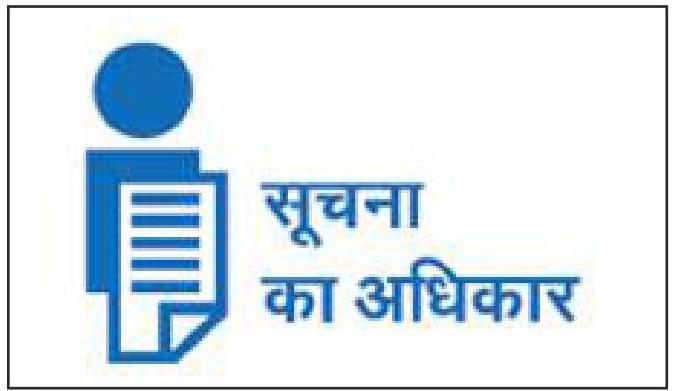
CENTRAL INFORMATION COMMISSION
16.9 The Government of India has constituted a Central Information Commission. Further, all the 28 States to which the Act applies, have constituted State Information Commissions. These Commissions are high powered independent bodies which, inter-alia, can look into the complaints made to them and decide the appeals. The Commissions have power to impose penalty on the defaulting Public Information Officers. Central Information Commission entertains complaints and appeals in case of offices, financial institutions, public sector undertakings, etc.
exempted from disclosure. Certain security or intelligence organizations have been exempted from disclosing any information except that pertaining to allegation of corruption or violation of human rights. Such organizations are required to designate Public Information Officers and First Appellate Authorities to deal with applications and appeals relating to information pertaining to corruption or violation of human rights.
16.8 With a view to create a brand for the Right to Information, a logo as given below had been adopted for the RTI on 28th October, 2010. The logo is very simple and iconic. A sheet of paper with information on it, and the authority figure behind it – providing the information. This represents the two key stakeholders in the process of sharing information under the RTIAct.
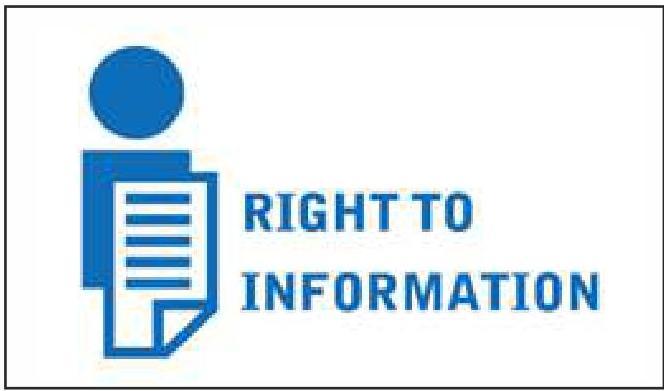
under the Central Government and the Union Territories while the State Information Commissions entertain appeals pertaining to offices, financial institutions, public sector undertakings, etc. under the concerned State Government.
16.10 The Central Information Commission, when constituted initially, had five Commissioners including the Chief Information Commissioner. With the last appointment of the Chief Information Commissioner and three Information Commissioners on 7th November, 2020, the Commission has now SEVEN Information Commissioners apart from the Chief Information Commissioner in position.
RIGHT TO INFORMATION RULES, 2012
16.11 In supersession of the Central Information Commission (Appeal Procedure) Rules, 2005 and the Right to Information (Regulation of Fee and Cost) Rules, 2005, the Right to Information Rules, 2012 have been notified in the Gazette of India on 31st July, 2012.
16.12 The Right to Information Rules, 2012 provide inter-alia that a request for obtaining information shall be accompanied by an application fee of rupees ten by way of cash against proper receipt or by demand draft or bankers’ cheque or Indian Postal Order payable to the Account Officer of the public authority. The applicant may have to pay fee in addition to application fee for obtaining documents or for inspecting the documents. The persons below poverty line are not required to pay any fee for seeking information.
16.13 The RTI Rules, 2012 also prescribe the procedure for deciding appeals by the Central Information Commission, covering the following aspects:
(i) Documents to be enclosed with the appeal
(ii) Return of Appeal
(iii) Process ofAppeal
(iv) Procedure for deciding appeals
(v) Presence of the appellant before the Commission
(vi) Presentation by the Public Authority
(vii) Service of notice by Commission
(viii) Order of the Commission
RIGHT TO INFORMATION RULES, 2019
16.14 RTI Amendment Bill, 2019 was passed by the Lok Sabha on 22.07.2019 and Rajya Sabha on 25.07.2019. The Bill received the assent of the President on 1stAugust, 2019.
16.15 The RTI (Amendment) Act, 2019 was notified, by the Legislative Department, in the Gazette of India on 1stAugust, 2019.
16.16 Notification to bring into force the provision of the RTI (Amendment) Act, 2019 has been published in the in the Gazette of India, Extraordinary under Part II, Section 3, Sub-Section (ii) on 24.10.2019.
16.17 Consequently, ‘The Right to Information (Term of Office, Salaries, Allowances and Other Terms and Conditions of Service of Chief Information Commissioner and Information Commissioners in the Central Information Commission, State Chief Information Commissioner and State Information Commissioners in the State Information Commission) Rules, 2019’ have been notified in the Official Gazette of India, Extraordinary under Part II, Section 3, SubSection (i) on 24.10.2019.
RTI WEBSITE
16.18 There is a dedicated website on RTI www.rti.gov.in, which contains valuable information including circulars, notifications and Guides on RTI, search facility for locating CPIOs and Appellate Authorities in Central Government etc. It has links with other RTI related sites as well. Further, there is an RTI online web portal whereby Right to Information (RTI) applications can be filed online by Indian citizens, including those who are living abroad. An Indian citizen can file RTI application online through RTI online webportal, having url www.rtionline.gov.in. The prescribed fee for RTI application can also be paid online through a payment gateway of State Bank of India by way of internet banking of State Bank of India, debit/credit cards of Master/Visa and RuPay cards. This facility at present is available for 2451 Public Authorities of Government of India (as on 14.12.2021).
ANNUAL PROGRAMME ON RIGHT TO INFORMATION
16.19 The Government has launched a Centrally Sponsored Plan Scheme “Improving Transparency and Accountability in Government through Effective Implementation of the Right to Information Act” in August, 2010 to undertake activities in the area of awareness generation and
capacity building. Under the scheme, the State Administrative Training Institutes and State Information Commissions are supported through release of grants for awareness generation and training programmes of all stakeholders. The total outlay of the scheme under XIIth Five Year Plan was Rs.110.36 crores. Now, the Scheme is continued as an Annual Programme and during the F.Y 202122, an amount of Rs 2.81 crores has been released till 31.03.2022.
TRAINING:
16.20 The above Annual Programme has components of training of Public Information Officers / First Appellate Authorities of Centre as well as States. For the training of State PIOs, a sum of Rs. 193.84 Lakhs has been released to Administrative Training Institutes during the Financial Year 2021-22.
AWARENESS GENERATION FOR RTI:
16.21 The component of awareness generation includes Organization of Workshops, RTI Week Celebration, Innovative Awareness Generation Programmes and Publication of Guidebooks. Rs. 80.50 lakhs has been released to Administrative Training Institutes under these components during the Financial Year 2021-22.
INTERNSHIP ON RTI:
16.22 Considering the need to consolidate and document the experiences of the Ministries / Departments of Government of India in the implementation of RTI, its successes, constraints in implementation, to identify the areas which need more attention, to address the gap areas and to see what more needs to be done to help achieve the objectives of the RTI Act, 2005. DOPT provides Short Term Internships to Undergraduates pursuing the five year integrated course in Law and pursuing Graduation in Law to conduct an analysis of applications received under RTI Act in Select Public Authorities. During the current F.Y. 2021-22, this Short Term Internship on RTI could not be provided due to the ongoing pandemic.
RTI FELLOWSHIP:
16.23 The RTI fellowship of 3-month duration is awarded every year to four fellows in the age group of 25-40 years from the field of Media/Journalism/Civil Society Organizations associated with RTI/RTI Trainers to conduct field based research on themes relating to RTI with the aim that the research output will enhance our understanding of the status of the implementation of the Act, including its success, constraints in its implementation and how those are being/could be overcome and what more needs to be done to help achieve the objectives of the Act. During the fellowship period each fellow is granted a total stipend of upto Rs.2.00 lakhs. The fellowship has been started from 2010.
RTI CELLS IN MINISTRIES /
DEPARTMENTS
16.24 Department of Personnel & Training provides a one-time grant of Rs.50,000/under the Annual Programme for setting up RTI Cells in the Central Ministries / Departments to streamline receipt and disposal of RTI applications / appeals and orders. So far, 39 Central Public Authorities have received grants for setting up RTI Cells since inception of the scheme.
RTI ONLINE PORTAL
16.25 A web portal namely ‘RTI Online’ has been launched to provide the facility for the Indian Citizens to file online RTI applications and first appeals and also to make online payment of RTI fees. The prescribed fee can be paid by the applicant through internet banking of the State Bank of India as well as by Credit/Debit cards of VISA / Master, through the payment gateway of SBI, which is linked to RTI Online portal.
16.26 The RTI online portal provides for sending online replies to applications and appeals, though reply can be sent by regular post also. For a successful implementation of this facility, extensive training to the CPIOs / FAAs has been provided by DOPT, with the help of NIC. As on 31.03.2022, 2462 Public Authorities have been aligned with this portal.
CHAPTER
17
PROACTIVE DISCLOSURE
17.1 Section 4(1)(b) of the RTI Act lays down the information which should be disclosed by Public Authorities on a suo motu or proactive basis. Sections 4(2) and 4(3) of the Act prescribe the method of dissemination of this information. In order to improve the proactive disclosure, Government of India constituted a Task Force on Suo motu disclosure in May, 2011. After considering the recommendations of the Task Force, the Government of India has issued guidelines to Central Ministries / Departments for Proactive Disclosure under section 4 of the RTI Act on 15.4.2013 and the same were reiterated on 07.11.2019. These guidelines envisage –
(a) Suo motu disclosure of more items under section 4.
(b) guidelines for digital publication of proactive disclosure.
(c) detailing of certain clauses of section 4(1)(b) to make disclosure more effective
(d) compliance mechanism for suo motu disclosure
(e) personal information of an individual not to be disclosed
17.2 As per the guidelines, Pubic Authorities may publish information relating to procurement, public private partnerships, transfer policy and orders, RTI applications, CAG and PAC paras, citizens’ charter, discretional and non-discretionary grants, foreign tours of Prime Minister and Ministers.
17.3 The guidelines further provide that each Central Ministry/ Public Authority should get its proactive disclosure package audited by a third party every year and that such audit should be communicated to the Central Information Commission annually through publication on their own websites along with the names of the third party auditors. Under these guidelines it is mandatory that a senior officer of the level of Joint Secretary in the case of Ministry/Department and Additional
HoD in the case of attached/subordinate offices is nominated as nodal officer for ensuring compliance with the proactive disclosure guidelines.
17.4 The above guidelines have been reiterated duly incorporating a slight revision to Para 4.4 of the above guidelines allowing for third party audit by any Government Training Institute, in cases where no Training Institute exists under the concerned Ministry /Department/Public Authority. In course of a relaxation to the Central Public Authorities in aforesaid guidelines, it has been further provided that if any Training Institute, under any Ministry/Department/Public Authority, is recognized and functions as a separate Public Authority in terms of provisions of RTI Act, 2005, it may get third party audit of its proactive disclosure package done by any Government Training Institute.
17.5 The Government of India has also issued circular/guidelines on 10.07.2020 in the wake of Covid-19 pandemic advising all Ministries/Departments that all the Public Authorities dealing with essential services should widely disseminate information regarding the government relief, rescue and other welfare actions, in the media as well as on their official websites in accordance with Section 4 of the RTI Act, 2005.
17.6 State Governments have also been requested to consider issuing similar guidelines, along with templates for disclosure at various levels, for better implementation of suo motu disclosure at State level. Four areas have been identified for development of templates viz. Public distribution system, Panchayats, MGNREGA and Primary and Secondary Schools.
17.7 A facility to upload the reply of RTI applications and first appeals on the respective website of the Ministry/Department has been started from 31st October, 2014. All the Ministries/Departments of
Govt. of India have been requested to upload the reply to RTI application and first appeal on their respective websites, except the replies relating to the personal information of an individual, if they do not serve any public interest.
17.8 During the year 2021-22 a total of 19133 RTI applications were received and 18604 RTI applications were disposed of in DoPT. In addition, 1481 RTI First Appeals
were received and 1372 RTI First Appeals were disposed of during the year 2021-22.
17.9 Third Party Audits on suo-moto disclosures under the RTI Act, 2005 in respect of DoPT for the year 2020-21 was conducted by ISTM through online mode. In the audit, it has been stated that the Department is complying with the RTI rules except the following points:
| S.no. | Main Point | Sub Point | Remarks |
|---|---|---|---|
| 1. | Boards, Councils, Committees and other Bodies constituted as part of the Public Authority [Section 4(1)(b)(viii)] | – Whether their meetings are open to the public? – Whether the minutes of the meetings are open to the public? – Place where the minutes if open to the public are available? |
Information not available. |
| 2. | No. of employees against whom Disciplinary action has been proposed/ taken [Section4(2)] | – No. of employees against whom disciplinary action has been (i) Pending for Minor penalty or major penalty proceedings (ii) Finalised for Minor penalty or major penalty proceedings | Information not available. |
| 3. | Programmes to advance understanding of RTI (Section 26) | – Educational Programmes – Efforts to encourage public authority to participate in these programmes – Training of CPIO/APIO |
Information not available. |
| 4. | Are the details of policies/ decisions, which affect public, informed to them [Section 4(1)(c)] | – Publish all relevant facts while formulating important policies or announcing decisions which affect public to make the processes more interactive-Policy decisions/ legislations taken in the previous one year | Information not available. |
| 5. | Forms of accessibility of information manual/handbook [Section 4(1)(b)] | – Information manual/ handbook available in Printed format | As per self appraisal. |
|---|---|---|---|
| 6. | Whethet information manual/ handbook available free of cost or not [Section 4(1)(b)] | – List of materials available Free of Cost – List of materials available at a reasonable cost of the medium |
As per self appraisal. |
| 7. | Language in which Information Manual/ Handbook Available [F. No. 1/6/2011-IR dt. 15.4.2013] | – Vernacular/ Local Language | Information/ Guidelines needs to be prepared in English/ Hindi/ Vernacular languages & b e m a d e available in electronic and printed form. |
| 8. | Such other information as may be prescribed under Section 4(i)(b)(xvii) | – List of completed schemes/ projects/ programmes – List of completed schemes/ projects/ programme underway |
Information not available. |
| 9 . | Such other information as may be prescribed [F. No. 1/2/2016IR dt. 17.8.2016, F No. 1/6/2011-IR dt. 15.4.2013] | – Consultancy committee of key stake holders for advice on suo-moto disclosure (a) Dates from which constituted, (b) Name and designation of the officers | Information not available. |
| 9 . | Guidelines for Indian Government Websites (GIGW) is followed (released in February, 2009 and included in the Central Secretariat Manual of Office Procedures (CSMOP) by Department of Administrative Reforms and Public Grievances, Ministry of Personnel | – Does the website show the certificate on the Website? | Need to be displayed prominently on the Website |
NOTE: Necessary follow up action on the observations is being taken.
17.10 As part of Proactive disclosure, the following material has been uploaded on the DoPT Website:
(a) Details of Officers of DoPT with their Telephone number and Email id.
(b) Channel of Submission/ Internal Delegation of Powers.
(c) Induction Material containing subjects being handled in the respective Divisions of DoPT
(d) Acts and Rules.
(e) Citizen’s Charter.
(f) Compilation of Ducuments/ Data held by different Divisions of DoPT.
(g) Budget estimates in respect of the Department and its Organisations
(h) Details of CPIOs/APIOs (alongwith their work allocation).
(i) Information related to Procurement and Tenders awarded.
Citizens/ Client’s Charter and Sevottam Compliant Public Grievance System of the Department:
18.1 The Citizens’/Clients’ Charter of the Department was reviewed by the Task Force constituted by the Department. The Task Force appreciated the efforts of the Department and suggested some changes/modifications which were duly carried out and the revised Charter has been uploaded in the website of the Department. The revised citizens’/clients’ charter of the Department contains the services provided by the various Divisions, name and contact, details of the responsible officer, service standards and time taken, the process involved and documents required. The charter also contains the name and contact details of public grievance officer. The services included in the citizens’/clients’charter are:
i Processing of proposals for ACC approval.
ii Allocation of Service based on the result of the Civil Services Examination (Display on the website of this Department)
iii Nomination of the candidate to whom service allocated for Foundation Course (Display on the website of this Department)
iv Release of holiday list for the Government Department/organisations.
(v) Release of Grants-in-aid to staff side Secretariat of National Council (JCM).
vi Grant of advice on disagreement cases with UPSC on disciplinary matters.
vii Clarification on ACRs/APARs.
viii Processing for extension of ad-hoc appointment/Grant of approval.
ix Processing of proposals for framing/amendment/relaxation of RRs (including proposals received online on RRFAMS).
$x \quad$ Cadre Clearance for Deputation.
xi NOC for filling up of posts in Government organisation.
xii Nomination of officers under domestic Funding of Foreign Training- Long Term Training Programmes (6 months- 1 year) & Short Term Training Programmes (up to 6 months).
xiii Nomination of officers for Advanced Professional Programme in Public Administration (APPPA).
xiv Advice /clarification to Ministries /Departments on the issue of Reservation in services to SC, ST, OBC, PWD and Ex-Servicemen.
xv Payment to vendors for invoices submitted, except air bills, submitted complete in all respects.
18.2 Review of implementation of Citizens’/Clients’ Charter is a continuous process and the Department is committed to include more services and improve service standards.
Public Grievances Redressal System
18.3 The Department is implementing the centralized Public Grievances Redressal and Monitoring System (CPGRAMS) an online grievance redressal mechanism, developed and monitored by the Department of Administrative Reforms and Public Grievances (DARPG).
18.4 The department received online grievances from various sources in CPGRAMS portal with the majority of grievances lodged directly by the common public. In addition to this, the department also received grievances forwarded by the higher authorities namely PMO, President Secretariat, DARPG and DoP\&PW(pension) in CPGRAMS portal for their timely redressal. During the period from January 2021 to
December 2021, the Department has received 29549 grievances in CPGRAMS portal, out of which, 22801 grievances have been disposed of by the concerned
Ministry/Department/Organizations including DoP&T. During the year, the department received a total of 1367 COVID-19 related grievances, out of which 1221 grievances have been disposed of.
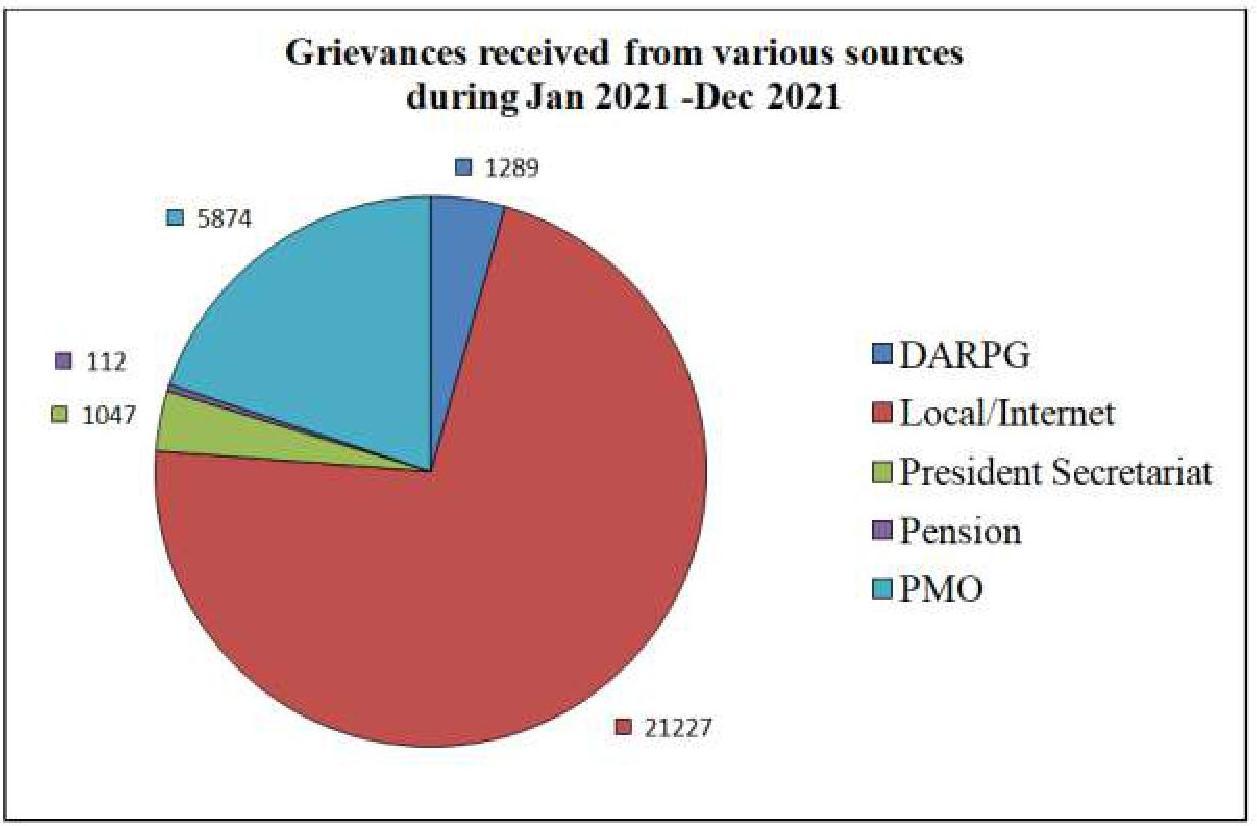
Figure : Grievances received during January 2021 -December 2021
18.5 Besides, the Department received 1940 grievances in physical form through letters written by the common public as well as forwarded by other Ministries/ Departments of the Government of India. These Grievances are forwarded to various Divisions concerned in DoPT for examination and redressal. The grievances which do not pertain to this Department are forwarded to the Ministries/ Departments concerned and the petitioners are informed, accordingly.
18.6 Director (Admn.), DoPT, is the Nodal Officer of Public Grievances for DoPT. As per the instructions of the Department of Administrative Reforms and Public Grievances, Wednesdays are observed as
meeting-less day so that the citizens can meet the officers concerned with their grievances
Information and Facilitation Centre
18.7 Information and Facilitation Centre (IFC) of this Department is functioning with a Help Desk for providing information to the citizens both at North Block and Lok Nayak Bhawan, New Delhi. Apart from facilitating and guiding the citizens, the IFC disseminates information regarding the Department of Personnel and Training and its activities. IFC has been set up to facilitate easy accessibility for the citizen.
CHAPTER
PROGRESSIVE USE OF HINDI IN OFFICIAL WORK
19.0 The Ministry continued to make concerted efforts to promote the use of Hindi in official work and to ensure compliance of the provisions of the Official Language Act, 1963 as amended in 1967 and Official Language Rules, 1976 framed thereunder. Various orders/instructions issued from time to time by the Department of Official Language with a view to ensure proper implementation of the Official Language Policy of the Union are also implemented in the Ministry.
19.1 MACHINERY FOR IMPLEMENTATION AND TRANSLATION
19.1.1 The Ministry has a full-fledged Official Language Division headed by a Joint Director (OL) with one (01) Deputy Director (OL) and two (02) Assistant Directors (one post vacant) and other supporting staffs. This Division caters to the needs of the Department of Personnel and Training. There is a separate Official Language Section under a Deputy Director (OL) with necessary supporting staff in the Department of Administrative Reforms and Public Grievances. Likewise, there is a separate OL Section headed by one (01) Assistant Director (OL) with necessary supporting staffs also in the Department of Pension and Pensioners’ Welfare. Besides monitoring the implementation of the Official Language Policy and the Annual Program, the Official Language Division arranges in-service training for the staff for learning Hindi Language, Hindi Stenography and Hindi Typewriting. It also undertakes translation of the material received from various sections/desks of the Department from English to Hindi and vice versa such as General Orders, Standard forms, Notifications, Resolutions, Cabinet Notes (except the annexure relating to other Ministries/Departments), Administrative and other Reports, Press Releases and Periodic Statements/Summaries etc. referred to in section 3(3) of the Official Language Act, 1963
in addition to Parliamentary and Budgetary matters.
19.2 VARIOUS COMMITTEES FOR EFFECTIVE IMPLEMENTATION OF OFFICIAL LANGUAGE POLICY
19.2.1 Kendriya Hindi Samiti
Kendriya Hindi Samiti headed by the Hon’ble Prime Minister suggests various ways and means to the Ministries/Departments to promote the use of Official Language Hindi in the official work. Last meeting of the committee was recently held on 06.09.2018 under the chairmanship of the Hon’ble Prime Minister. The directions and follow up actions of the Committee are being implemented in the Department.
19.2.2 The Committee of Parliament on Official Language
The Committee of Parliament on Official Language was to be constituted under section 3 of the Official Languages Act 1963 after ten years of the promulgation of the Act. This Committee was set up in 1976 under section 4 of the Act.
This is a high level committee comprising of 30 members of Parliament, 20 from Lok Sabha and 10 from Rajya Sabha. The Chairman of the Committee is elected by the members of the Committee. As a convention, the Union Home Minister (HM) has been elected as Chairman of the Committee from time to time
The Committee of Parliament on Official Language inspected Department of Personnel and Training (DoPT) on 10.10.2020. The Committee reviewed the implementation of the provisions of Official Language Act and suggested various ways and means to the Ministry/Department to promote the progressive use of Official Language Hindi in the official work by creating a conducive and facilitative environment for the personnels of the Department.
19.2.3 Hindi Salahakar Samiti (Hindi Advisory Committee)
As per the guidelines from Department of Official Language, Ministry of Home Affairs, Hindi Advisory Committees are constituted in Ministries/Departments to put their advice regarding proper implementation of the official language policy of the Government of India. The minister concerned of the office chairs the committee. This is a high level committee consisting of 30 members. The committee is constituted for three years and advises the Ministry and its subordinate offices regarding
implementation of the directions issued by Department of Official Language regarding provisions made under the Constitution, Official Language Act and Rules. The Hindi Salahakar Samiti of the Ministry has been reconstituted vide the Resolution No. E-11015/1/2019-Hindi dated 26.10.2020 after the constitution of the 17th Lok Sabha. The first meeting of the newly constituted the Hindi Advisory Committee as the overall 13th meeting was held at CSOI, New Delhi on 25.11.2021 under the chairmanship of Hon’ble MoS(PP), Dr. Jitender Singh.
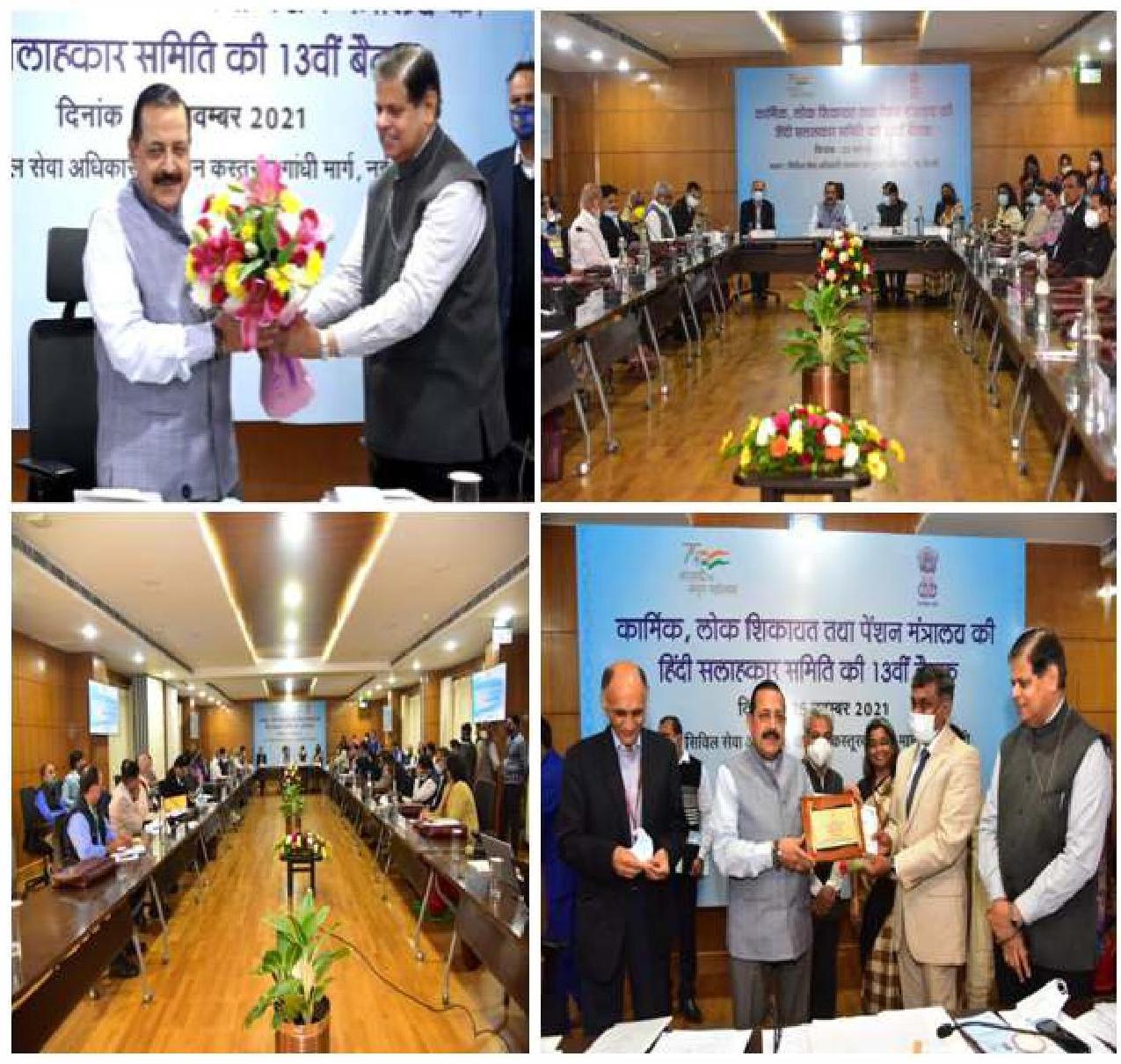
# Honb’le MoS(PP) chairing the 13th Hindi Salahkar Samiti
19.2.4 Kendriya Rajbhasha Karyanvayan Samiti
Kendriya Rajbhasha Karyanvayan Samiti is headed by the Secretary, Department of Official Language which reviews the ongoing progress of the use of Hindi in all the Ministries/Departments of Government of India. The directions of this Committee are being complied with in the Department.
19.2.5 Official Language Implementation Committee (OLIC)
The meetings of the Official Language Implementation Committee (OLIC) of the Department of Personnel and Training are held periodically in the Department to discuss the Quarterly Progress Reports and suggest various measures for progressive use of Official Language Hindi in the Department. The meetings of Official Language Implementation Committee (OLIC) are being held regularly in the Department. The last meeting was held on 24.12.2021. The Quarterly Progress Reports related to Official Language Hindi are reviewed in the meetings of Official Language Implementation Committee (OLIC) and various measures are taken for progressive use of Official Language Hindi in the Department.
19.2.6 Official Language Implementation Committee (OLIC) of Attached Offices
All the attached/subordinate offices of the ministry have their own Official Language Section and they have their own Official Language Implementation Committee (OLIC). The meetings of Official Language Implementation Committee are held regularly in these offices and the representatives of the Department also attend these meetings.
19.3 SPECIFIC MEASURES TAKEN FOR PROMOTING THE USE OF OFFICIAL LANGUAGE HINDI
19.3.1 Quarterly Progress Report and Annual Assessment Report
To assess the work done in Hindi by the personnels of the Department in their official
work, a Quarterly Progress Report (QPR) is compiled after collecting relevant and realtime data from various Divisions/Sections in a prescribed proforma and sent to the Department of Official Language, Ministry of Home Affairs on regular basis. Similarly, Annual Assessment Report (AAR) is also sent to the Department of Official Language, Ministry of Home Affairs.
19.4 CASH AWARDS AND INCENTIVE SCHEMES
Various incentive schemes of the Department of Official Language to encourage officers and employees to do their official work in Hindi are in vogue in all the government departments. One such scheme is in vogue in this Department under which cash awards are given to staff members who carry out their official work (Noting & Drafting) in Hindi. During the year 2020-2021 total six (06) officials have participated and all the winners have been provided with cash prizes and commendation certificates after the declaration of the results for the same.
19.5 HINDI WORKSHOPS
Hindi Workshops are organized in the Department to remove the hesitation among the officers and employees to do their official work in Hindi in which all the participants are given practical training of Rajbhasha Hindi and relevant rules and procedures thereof. Owing to widespread outbreak of COVID-19 during the period under review no Hindi Workshop could be organized by the department till date.
19.6 ORGANISING HINDI MONTH / FORTNIGHT/DIWAS
Hindi Month was organized in the Department from 01.09.2021 to 30.09.2021. During the fortnight five (05) competitions namely; Hindi Noting \& Drafting, Official Language Hindi and General Knowledge, Translation, Hindi Story Writing and Hindi Typing etc. were organized. On this occasion a large number of officers and employees of the Department enthusiastically participated in these competitions strictly following social distancing norms and COVID
appropriate behaviour and protocols decided by the Ministry of Health and Family Welfare. The participants who secured first, second and third positions and also those who
performed well were awarded with cash prizes. Commendation certificates are to be distributed to the winners at the earliest.
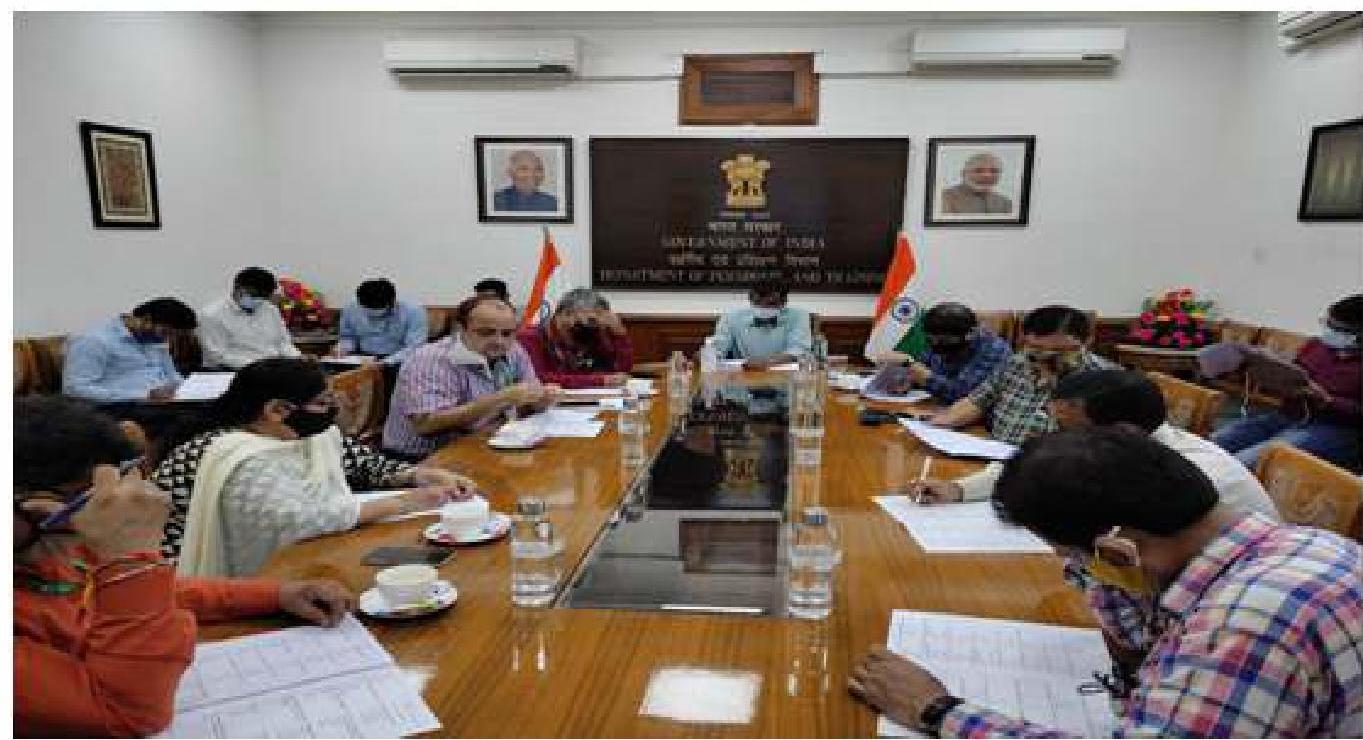
# Competitions held during Hindi Maah-2021.
19.7 HINDI IN TRAINING INSTITUTIONS
The two Training Institutions under the Ministry viz. Lal Bahadur Shastri National Academy of Administration (LBSNAA), Mussoorie and the Institute of Secretariat Training and Management (ISTM), New Delhi have made considerable progress in providing the training material in Hindi. In LBSNAA, the teaching material of main subjects are provided in book form and translation of the lecture notes of the topics taken by the faculty members is provided immediately on the demand of trainee officers. Institute of Secretariat Training and Management (ISTM) also has its all the training material available in bilingual form.
19.8 MONITORING AND INSPECTION
The progress made in Hindi for effective implementation of the Official Language Policy is reviewed on the basis of Quarterly Progress Report (QPR) and Annual
Assessment Report (AAR). The progress made in the progressive use of Hindi is discussed at length in the quarterly meetings of internal Official Language Implementation Committee in which remedial measures are suggested to remove the shortcomings found.
Besides, Divisions/Sections and the Attached Offices of the Ministry are inspected by Official Language Section of the Department of Personnel and Training in a phased manner and necessary measures are taken and directions are given to overcome the practical difficulties experienced in the course of implementing the Official Language Policy of the Union.
During inspection ways for doing away with the problems faced by the officials in carrying out their works in Hindi are also suggested to give the much needed fillip and thrust to progressive use of official language Hindi. Owing to widespread outbreak of COVID-19 in
the country during the year under review neither internal nor external inspection could be carried out to take the stock of the progressive use of Official Language.
19.9 RAJBHASHA SHIELD YOJANA
With a view to promote cooperative and competitive feeling and synergy among subordinate offices and headquarters for promoting progressive use of Rajbhasha Hindi in the official work of the Department, an ambitious shield scheme consisting of two parts entitled as Rajbhasha Shield Yojana was launched. The first part is meant for the sections located at Headquarters under which Rajbhasha Shield would be given to the section using Hindi in its official work at
premium with other sections and the officers and employees working there in Hindi would be rewarded. The second part of the scheme is meant for the Subordinate Offices in which provisions have been made to give the Rajbhasha Shield to the Subordinate Office doing its official work in Hindi at premium with any of the Subordinate Offices. During the year under review the Admin-III Section among the sections located at the Headquarters and the Staff Selection Commission (SSC) among the subordinate offices were awardwed with the Rajbhasha Shield. The yojana has created a spirit of competition and dynamism for progressive use of Official Language Hindi among the officers and employees of the Department.
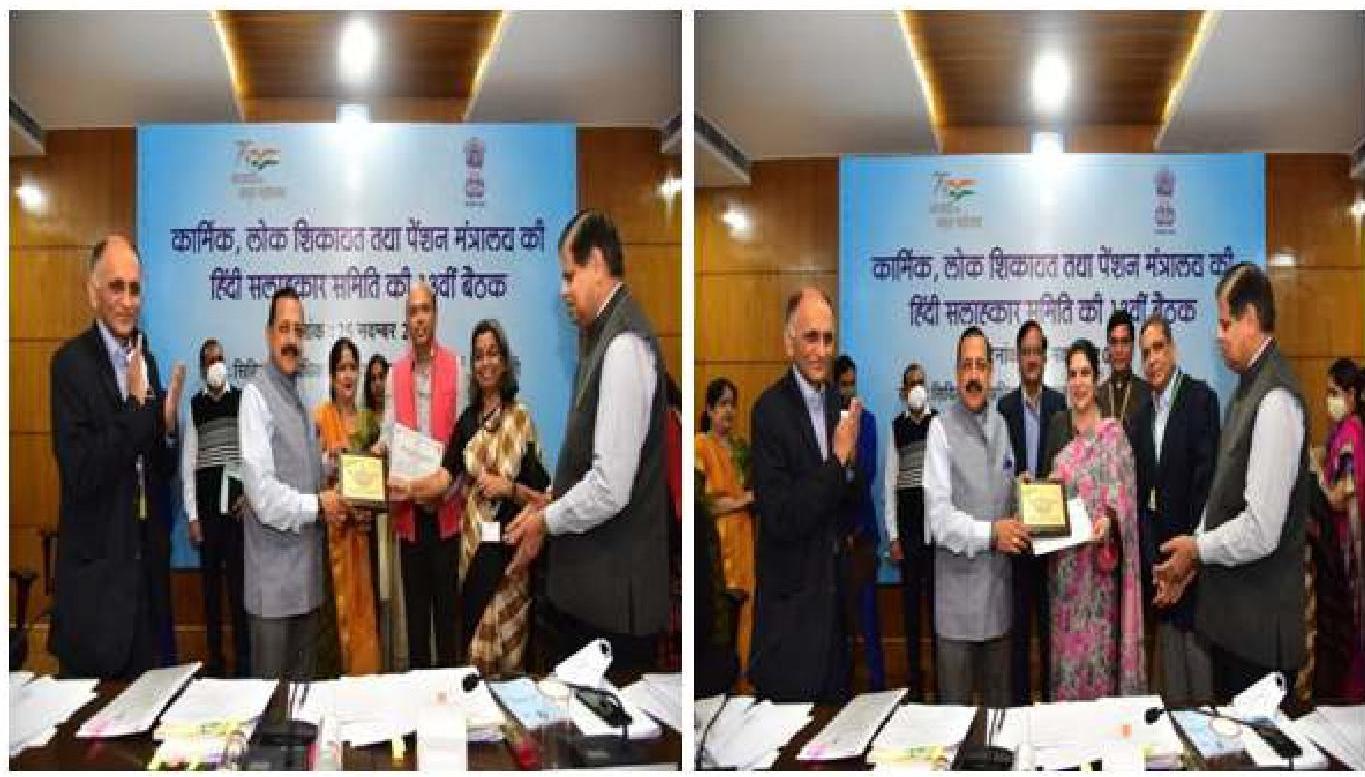
# Honb’le MoS(PP) giving Rajbhasha Shield to Admin-III Section and Staff Selection Commission(SSC) for the year-2019-20.
19.10 3rd Edition of e-Magazine “KAUSHAL” (A Covid Special Issue)
In a first of its kind initiative the Department of Personnel and Training started an e-magazine christened as “KAUSHAL” to provide a platform to the officers and employees of the Department to make a creative, conducive and positive environment for progressive use
of Hindi Language in official work in the year 2019. The initiative is leading to a keen desire among the officers and employees to give vent to their creative urge in Hindi language. Hence, this ambitious initiative is helping create a positive synergy among the officers and employees to do their official work in Hindi
which in turn will make public administration more citizen-centric and decentralized with greater active participation of the citizens. It would also make public administration more responsive and accessible with increased popular participation and two-way communication between the Government and the citizens.
This is a progressive step to make Official Language Hindi more popular among the officers and employees of the Department which would go a long way in translating the
vision of ‘New India-Atmanirbhar Bharat’ of Government of India into reality by rendering public administration and public service delivery mechanism more inclusive.
Owing to widespread outbreak of COVID-19 during the year under review the 3rd edition of the magazine could not be published in 20202021. Therefore, the publication of the 3rd edition of the magazine is in the wings and the link of the same would be made available on the website of the Department shortly.
CHAPTER
20.1 The provision is for expenditure of the Ministry of Personnel, Public Grievances & Pensions in respect of:
a Department of Personnel \& Training which is entrusted with the work relating to framing / interpretation of rules and regulations; recruitment, promotion and reservation policy; induction, training and refresher courses for all levels / grades of Civil Services posts; service conditions, career and manpower planning, vigilance, discipline and welfare activities of Central Government servants; investigation and prosecution in corruption cases and other serious crimes; redressal of grievances of public servants.
b. Department of Administrative Reforms \& Public Grievances which is entrusted with matters relating to Administrative Reforms, O\&M and policy, coordination and redressal of grievances including those pertaining to Central Government Agencies; hosting of Civil Service Day, PM’s Award, Chief Secretaries Conference etc.
c. Department of Pension \& Pensioners Welfare which administers all activities relating to retirement benefits including Gratuity, Pension, fringe benefits to pensioners, etc.
20.2 The provision is for establishmentrelated expenditure of the Central Bureau of Investigation which is entrusted with investigation and prosecution in corruption cases against public servants, private persons, firms and other cases of serious crimes. This also includes provision for various projects such as Modernization of Training Centres of CBI, Establishment of Technical and Forensic Support Units, Comprehensive modernization \& purchase of land/ construction of office/ residence buildings for CBI.
20.3 The provision is for establishmentrelated expenditure of the Staff Selection Commission including expenditure on the conduct of examinations for recruitment of staff in Central Ministries/Departments etc.
20.4 The provision is for establishmentrelated expenditure of the Central Administrative Tribunal which is entrusted with the redressal of grievances exclusively of public servants. This also includes provision for Purchase of Land and Construction of Building for various Benches of CAT.
20.5 The provision includes establishment related expenditure of Institute of Secretariat Training \& Management (ISTM), Lal Bahadur Shastri National Academy of Administration (LBSNAA) \& Training Division, DOPT. These Organizations arrange several training programmes including foundation courses, refresher courses, mid-career training, etc. so as to equip all levels / grades of Secretarial functionaries with adequate exposure to the latest rules and regulations, aptitude etc., expenditure on domestic / overseas travel, course fees etc. in respect of CSS / CSSS officials who are to undergo mandatory training at ISTM as a pre-condition for consideration for promotion to next higher grade have also been included centrally in the budget of this Ministry.
20.6 The provision is for establishment related expenditure of Public Enterprises Selection Board and Central Information Commission.
20.7 The provision is for establishment and construction related Charged expenditure for LokPal.
20.8 The provision is meant for reimbursement to State Governments towards House Building Advances paid to All India Service Officers.
20.9 This also includes provision for Training schemes like Training for All, Domestic Funding for Foreign Training, Upgradation of LBSNAA to a Centre of Excellence, Augmentation of Training Facilities at ISTM and National Programme for Civil Services & Capacity Building – Mission Karmayogi.
20.10 This also includes Scheme provision for Department of Administrative Reforms \& Public Grievances scheme for Modernisation of Government Offices, Pilot projects on Administrative Reforms which consists of promotion of e-governance, fostering of good governance, learning from success, sevottam.
etc. It also includes allocation for Department of Pension’s scheme “Pensioners Portal”.
20.11 This also includes Grants in Aid allocations to Indian Institute of Public Administration and National Center for Good Governance.
20.12 The provision includes Grants-in-aid assistance to Grih Kalyan Kendra, Central Civil Services Cultural \& Sports Board and National RecruitmentAgency.
20.13 This includes fund allocations in respect of DOPT’s Propagation of RTIAct.
20.14 Organisation Wise RE 2021-22 \& BE 2022-23 Allocations
Demand No-74, Ministry of Personnel, Public Grievances \& Pensions
| S.no. | Organisation | Budget Estimates 2021-22 |
Revised Estimates 2021-22 |
Expenditure upto 31.01 .2022 |
Budget Estimates 2022-23 |
|---|---|---|---|---|---|
| 1. | M/o PPG\&P | 2058.57 | 1950.00 | 1477.50 | 2337.18 |
| 2. | DoPT | 1995.90 | 1878.02 | 1432.45 | 2245.18 |
| 3. | D/o AR\&PG | 49.46 | 60.00 | 37.03 | 80.00 |
| 4. | D/o Pensions | 13.21 | 11.98 | 8.02 | 12.00 |
Organisation wise details:
| S.no. | Head | Budget Estimates 2021-22 |
Revised Estimates 2021-22 |
Expenditure upto 31.01 .2022 |
Budget Estimates 2022-23 |
|---|---|---|---|---|---|
| 1. | DOPT | 176.87 | 149.05 | 102.87 | 136.97 |
| 2. | National Programme for Civil Services and Capacity Building (NPCSCB |
50.00 | 50.00 | 8.16 | 120.01 |
| 3. | Training for All (TFA) | 20.00 | 14.30 | 10.53 | 13.00 |
| 4. | Domestic Funding of Foreign Training (DFFT) |
10.16 | 3.00 | 0.71 | 5.00 |
| 5. | LBSNAA | 107.92 | 85.13 | 62.54 | 115.14 |
| 6. | ISTM | 65.91 | 54.79 | 38.46 | 33.99 |
| 7. | IIPA | 24.50 | 28.37 | 18.38 | 24.50 |
| 8. | CBI | 835.39 | 870.50 | 667.53 | 911.87 |
|---|---|---|---|---|---|
| 9. | CAT | 122.03 | 133.00 | 98.76 | 159.00 |
| 10. | SSC | 382.59 | 374.36 | 330.33 | 263.00 |
| 11. | NRA | 129.61 | 58.32 | 58.32 | 396.00 |
| 12. | PESB | 5.60 | 5.20 | 4.20 | 5.70 |
| 13. | CIC | 25.65 | 26.00 | 20.85 | 27.00 |
| 14. | LOKPAL | 39.67 | 26.00 | 10.81 | 34.00 |
20.15 Details of Central Sector Schemes of this Ministry as per Statement of Budget Estimates (SBE) 2022-23
Scheme wise allocations are given below:-
| S.no. | Head | Budget Estimates 2021-22 |
Revised Estimates 2021-22 |
Expenditure upto 31.01.2022 |
Budget Estimates 2022-23 |
|---|---|---|---|---|---|
| I | Training Schemes | 178.32 | 133.69 | 72.99 | 210.75 |
| a | National Programme for Civil Services and Capacity Building (NPCSCB) |
50.00 | 50.00 | 8.16 | 120.01 |
| b | Training for All | 20.00 | 14.30 | 10.53 | 13.00 |
| c | Domestic Funding of Foreign Training (DFFT) |
10.16 | 3.00 | 0.71 | 5.00 |
| d | Improvement of infrastructure & upgradation of facilities at LBSNAA |
57.66 | 34.50 | 24.77 | 62.00 |
| e | Augmentation of Training facilities at ISTM |
40.50 | 31.89 | 28.82 | 10.74 |
| ii | Administrative Reforms \& Pensioners Scheme |
20.00 | 15.31 | 9.03 | 44.25 |
| a | Scheme for Administrative Reforms |
15.00 | 12.00 | 7.54 | 40.68 |
| b | Pensioners Portal | 5.00 | 3.31 | 1.49 | 3.57 |
| Total (Central Sector Schemes) |
198.32 | 149.00 | 82.02 | 255.00 |
20.16 Capital Allocations
| S.no | Head | Budget
Estimates
2021-22 | Revised
Estimates
2021-22 | Expenditure
upto
31.01.2022 | Budget
Estimates
2022-23 |
| — | — | — | — | — | — |
| 1. | Modernisation of
Training Centre of
CBI | 1.5 | 3.50 | 0 | 2.50 |
| | Comprehensive
modernisation &
Purchase of | 80 | 63.00 | 34.84 | 103.45 |
| | Land/ construction of
CBI Offices/ residence
building | | | | |
| | Motor Vehicles: CBI | 4.00 | 4.00 | 0.39 | 4.00 |
| | Machinery &
Equipments: CBI | 0.20 | 0.00 | 0.00 | 0.01 |
| | Total – CBI | 85.70 | 70.50 | 35.23 | 109.96 |
| 2. | CAT – Major Works | 10 | 5.44 | 3.13 | 25.00 |
| 3. | Augmentation of
Training facilities in
ISTM | 34.35 | 29.00 | 28.52 | 8.31 |
| 4. | Improvement of
infrastructure and
upgradation of
Essential Facilities
at LBSNAA | 46.66 | 23.00 | 17.20 | 50.00 |
| 5. | National Programme
for Civil Services &
Capacity Building:
NPCSCB (iGoT SPV) | 10.00 | 10.01 | 0.00 | 20.03 |
| 6. | Lokpal | 10.00 | 10.01 | 0.00 | 10.00 |
| 7. | HBA to AIS Officers | 1.65 | 1.65 | 1.65 | 2.00 |
| | TOTAL | 198.36 | 149.60 | 85.72 | 225.30 |
20.17 AUDIT OBSERVATION IN RESPECT OF MINISTRY OF PERSONNEL, PUBLIC GRIEVANCES & PENSIONS
20.17.2 Comptroller & Auditor General of India
- No C&AG para is pending in this Ministry
20.17.1 Public Accounts Committee
- No PAC para is pending in this Ministry.
20.17.3 Statutory Audit Paras
| S.no | Name of the office | No. of Outstanding paras as on 31/10/2020 |
No. of Outstanding paras as on 31/12/2021 |
|---|---|---|---|
| 1. | Department of Personnel & Training | 45 | 30 |
| 2. | Staff Selection Commission | 9 | 50 |
| 3. | Union Public Service Commission | 8 | 8 |
| 4. | Institute of Secretariat Training \& Management |
8 | 15 |
| 5. | Department of AR \& PG | 11 | 17 |
| 6. | Deptt. of Pensions \& Pensioners’ Welfare |
5 | 0 |
| 7. | Lal Bahadur Shastri National Academy of Administration |
17 | 20 |
| 8. | Central Administrative Tribunal | 37 | 37 |
| 9. | Central Vigilance Commission | 19 | 23 |
| 10. | Central Information Commission | 17 | 18 |
| 11. | Central Bureau of Investigation | 208 | 209 |
| Total | M/o PPG\&P | 384 | 427 |
- All the concerned authorities have been instructed to take steps for early settlement of the audit objections.
DEPARTMENT OF ADMINISTRATIVE REFORMS & PUBLIC GRIEVANCES
DEPARTMENT OF ADMINISTRATIVE REFORMS AND PUBLIC GRIEVANCES
Vision
Excellence in governance for the benefit of all citizens
Mission
To foster excellence in governance and pursuit of administrative reforms through:
- Improvements in government policies, structures and processes.
- Promoting citizen-centric governance with emphasis on grievance redressal.
- Innovations in e-Governance.
- Awards and Documentation & dissemination of Best Practices.
Objectives
- Promoting administrative reforms in government policies and processes.
- Formulation of policy and coordination of issues relating to redress of grievances.
- Dissemination of governance knowledge and best practices.
- Promoting reforms through e-Governance.
EXECUTIVE SUMMARY
21.0 The Department of Administrative Reforms and Public Grievances is the nodal agency of the Government of India for administrative reforms as well as redressal of public grievances relating to the States in general and those pertaining to Central Government agencies in particular. The Department endeavours to document and disseminate successful governance practices by way of audio-visual media and publications. The Department also undertakes activities in the field of international exchange and cooperation to promote public service reforms. There are 8 Divisions in the Department namely Administrative Reforms, Organization \& Methods, e-Governance, Documentation \& Dissemination, International Exchange \& Cooperation, Administration \& Coordination, Public Grievances and Administrative Reforms Commission (ARC)/e-Office.
21.1 The Department is headed by the Secretary, Department of Administrative Reforms \& Public Grievances and Pensions \& Pensioners’ Welfare. Available Staff Strength is one Secretary, 2 Joint Secretaries, 6 Directors/ Deputy Secretaries and 16 Under Secretary level officers in the Department. An organizational chart of the Department is at Annexure-VI. Incumbency position of Under Secretary and above level officers is at Annexure-VII. Information regarding steps taken by this Department for Prevention of sexual harassment of women at workplace and welfare of SC, ST, OBC and Persons with Disability (PWD) are at Annexure-VIII and Annexure-IX respectively.
21.2 As per the Government of India Allocation of Business Rules, the following subjects have been allocated to the Department of Administrative Reforms \& Public Grievances:
(1) Administrative Reforms, including egovernance and dissemination of best practices.
(2) Organization and Methods
(3) Policy, coordination and monitoring of issues relating to –
(a) Redress of public grievances in general; and
(b) Grievances pertaining to Central Government agencies.
(c) Monitoring of implementation of eOffice in Central Ministries / Departments
(4) (a) Research in public management;
(b) Liaison with State Governments, professional institutions etc. in public management matters.
(5) Administration of Central Secretariat Manual of Office Procedure.
PERFORMANCE (2021-22)
| S.no | Objective | Targeted Activities |
|---|---|---|
| 1. | Formulation of policy and coordination of issues relating to redress of grievances | (1.1) Review of pendency of grievances in Ministries / Departments / Organizations as well as States and UTs (1.2) Training of CPGRAMS to Ministries / Departments. (1.3) Capability building of Administrative Training Institutes for improved service delivery in their respective State Government Departments through capacity building. (1.4) CPGRAMS Reforms version 7.0 for user friendly and faster grievance redressal (1.5) Integration of State Government portals with CPGRAMS (1.6) The Appeal Mechanism / functionality in CPGRAMS in line with the Department related Parliamentary Standing Committee Recommendations in its 100th Report has been introduced in CPGRAMS. (1.7) Process for Setting up permanent Feedback call centre for seeking feedback from the Citizens on disposed of Grievances and also help citizens to file/track their grievances if such help is needed by them. (1.8) To leverage strength of Common Service Centres (CSC) to take the facility of CPGRAMS to unconnected rural population and make awareness about CPGRAMS. |
| (1.9) To introduce CPGRAMS in all regional languages, to expand its outreach specially among the rural population (1.10) Introduction of Artificial Intelligence (AI)/Machine Learning (ML) tools in the system in partnership with IIT, Kanpur to categories grievances and assess quality of resolution. (1.11) To develop a new format of Action Taken Report (ATR). This would provide a matrix for assessment of quality of resolution. |
||
|---|---|---|
| 2. | Dissemination of governance knowledge and best practices | (2.1) Providing financial assistance to States/ UTs/ CTIs for professional documentation and dissemination of Good Governance practices. (2.2) Production of documentary films on good governance practices (2.3) Publishing of books containing articles on shortlisted and awarded initiatives. (2.4) Publication of biannual e-magazine ‘Minimum Government-Maximum Governance’ (2.5) Organizing of Regional Conferences |
| 3. | State Collaboration Initiative | (3.1) DARPG has sanctioned 55 projects till date in various States/UTs. |
| 4. | Redress of public grievance | (4.1) Total no of public grievances disposed of as on 31.12.2021-21,35,923. |
| 5. | Promoting reforms through e-Governance | (5.1) Organizing National Conference on eGovernance and presenting National Awards for eGovernance (5.2) Publishing of Compendium of select papers on issues of e-Governance, a booklet on excellence in eGovernance, a booklet on citations for National eGovernance Award Winners, and a compilation of conference papers. |
| (5.2.1) Publishing of National e-Governance Service Delivery Assessment report (NeSDA). | ||
| $6^{*}$. | Transparency/Service delivery in the Department | 6.1) The Citizens’ Charter of Ministries/Departments as well as States/UTs is available on goicharters.nic.in. Review meetings held for updation of Citizens Charters. |
| $7^{*}$. | Administrative Reforms | (7.1) Prime Minister’s Awards for Excellence in Public Administration. (7.2) Organising Civil Services Day. (7.4) Promotion of Administrative Reforms through simplification of procedure such as abolition of affidavits and promotion of self certification. (7.5) Designing, Developing & publishing Good Governance Index, recommended by Sectoral Group of Secretaries on Governance to present a state-wise comparative picture about the strong and weak areas of service delivery, which would help them in generating performance improvement mechanism. (7.6) Developing District Good Governance Index of States/UTs. |
|---|---|---|
| $8^{*}$. | Improving Internal Efficiency/Responsiveness | 8.1) Update departmental strategy to align with Plan priorities/objectives of the Scheme. |
| $9^{*}$. | Ensuring compliance to the Financial Accountability Framework | (9.1) Timely submission of Action Taken Notes on Audit paras of C\&AG. (9.2) Timely submission of Action Taken Reports to the PAC Sectt. On PAC Reports. |
| 10. | e-Office Progress | (10.1) 56 Central Ministries and Departments have already achieved the target of complete e-Office. |
| 11. | National Centre for Good Governance (NCGG) | (11.1) The Centre is envisaged to be the apex think-tank that would guide the Government and help in implementing Good Governance Reforms. |
| 12. | Special Campaign on Disposal of Pendency | (12.1) During the campaign about 44.89 lakh records were reviewed and 22 lakh records were weeded out. Rs. 62.00 cr . was earned from the disposal of scrap. |
| 13. | Good Governance Week, 2021 | (13.1) During the event 380 citizen charters were updated, 621 new services have been added in Citizen Charters, 6.67 lakh public grievances were attended to and 2.89 cr . applications under service delivery were disposed of. |
21.3 FUNCTIONS
(i) Matters relating to administrative reforms.
(ii) Organization of Civil Services Day and Prime Minister’s Awards for Excellence in Public Administration.
(iii) Capacity building, change management and Government Process Reengineering to provide reform througheGovernance.
(iv) e-Office Mission Mode Project under NeGP.
(v) Organisation of National Conference on e-Governance and National awards on e-Governance.
(vi) Management of Public Grievance Redressal Mechanism.
(vii) Documentation and Dissemination of Good Governance Practices innovations, adaptation and replication.
Important events/achievements of the Department
21.4 Prime Ministers’ Awards for Excellence in Public Administration
21.4.1 Government of India has instituted a scheme “Prime Minister’s Awards for Excellence in Public Administration” in 2006 to acknowledge, recognize and award the extraordinary and innovative work done by the Districts/ implementing units and organizations of Central and State Governments
21.4.2 Since its inception and till 2015, the awards were conferred in three categories, viz., individual, group and organizations. The structure of the Awards Scheme was changed in 2015-16 to focus on excellence in implementation of identified Priority Programmes wherein the States were grouped in three categories namely; (i) North Eastern and Hilly States; (ii) Union Territories and (iii) Other States. The PM Awards Scheme was restructured in 2020 to recognize the performance of District Collectors towards economic development of the District. The Scheme for Prime Minister’s Awards for Excellence in Public
Administration was again revamped in 2021 with the objective to encourage Constructive Competition, Innovation, Replication and Institutionalization of Best Practices. 21.4.3 Prime Minister’s Awards are presented on Civil Services Day (CSD) held on 21st April of every year. This is an occasion for Civil Servants of the Country to rededicate themselves to citizens and renew their commitment to public service and excellence in work. So far 14 Civil Services Day have been celebrated.
21.5 PUBLIC GRIEVANCES
21.5.1 An online system for grievance redress, called the ‘Centralized Public Grievance Redress and Monitoring System’ (CPGRAMS) has evolved since 2007. During the year, the Department has extensively used the System to forward public grievances to both the Central Government Ministries /Departments/Organisations as well as the State Governments concerned. The inflow of both centre and State related grievances is in two forms (i) through the CPGRAMS and (ii) through post. The grievances received by post are digitized and sent online through the System as well as by post to the Central Ministries / Departments /Organisations/State /UT Government concerned.
21.5.2 For better monitoring, analytical reports are generated through CPGRAMS as per requirement. The format includes receipts, disposal and % disposals with reference to cases pending for 2-6 months, 6-12 months and more than one year.
21.5.3 Public Grievance Mechanism of PMO available on website www.pmoindia.gov.in has been integrated with the pgportal.gov.in. This enables transfer of grievances lodged to the PMO to the Central Ministries /Departments /Organisations and State Governments and online monitoring of public grievances through CPGRAMS.
21.5.4 The Public interface of CPGRAMS has also been duly integrated with the pensioners’ portal and an option has been provided to the
users to lodge pension related grievances to the pensioners’ portal by clicking the relevant option on the pgportal.gov.in.
21.5.5 Public grievance mechanism of PMO, the President’s Secretariat, the Directorate of Public Grievances (Cabinet Secretariat), Department of Administrative Reforms & Public Grievances (DARPG) and that of Department of Pensioners’ portal have been duly integrated through CPGRAMS thus enabling grievances lodged to any of these entities to be transferred to the Central Ministries/Departments and State / UTs Governments online through CPGRAMS.
21.5.6 Operational trainings on Centralized Public Grievance Redress and Monitoring System (CPGRAMS) are being held regularly by the Department on last Thursday of every month for Officials of various Ministries /Departments and their sub-ordinate organisations. A system for online registration for this training has been put in place by the Department for the purpose. The training imparted relates to new features and improvements in CPGRAMS. Problems which are being faced by the nodal Public Grievance Officers during the redressal of grievances are also taken up and resolutions on the same imparted during the training session
21.5.7 During the period from 2021-2022, 03 intensive review meetings have been held for reviewing the status of pending public grievancesin Ministries / Departments/ Organisations and expediting action on them.
21.5.8 Introduction of an Appeal Mechanism/functionality in CPGRAMS- The Appeal Mechanism/functionality in CPGRAMS in line with the Department related Parliamentary Standing Committee Recommendations in its 100th Report has been introduced in CPGRAMS. The recommendations were communicated to all Central Ministries/Departments with the request to nominate a Nodal (Appellate) authority. The Appeal provision has been made for redressal of dis-satisfied grievances
identified through a mandatory feedback rating to be given by the Citizen on disposal of the grievance by the Nodal Grievance Officers.
21.6 Citizens’ Charter
21.6.1 The Department of Administrative Reforms and Public Grievances in its efforts to provide more responsive and citizen-centric governance coordinates the efforts of Ministries / Departments to formulate and operationalize Citizen’s Charters in Central Government Ministries / Departments as well as State Governments and UT Administrations. It provides guidelines for formulation and implementation of the Citizen’s Charters. The Citizen’s/Client’s Charter (CC) was first introduced simultaneously in Central Government Departments and in all State Governments in May, 1997. The Citizen’s Charter of DARPG is being reviewed and the updated version will be uploaded on website of the Department as well as on the “goicharters.nic.in”.
21.7 Sevottam
21.7.1 Sevottam is a generic framework for achieving excellence in public service delivery. It comprises of 3 modules namely, Citizen’s Charter, Grievance Redressal Mechanism and Capability Building for Service Delivery. As part of the Strategic plan for Capability Building towards implementing Sevottam Quality Management System, a Scheme for Strengthening of Administrative Training Institutes has been implemented during the 12th Five Year Plan 2012-2017 in Training Institutions in 10 States. This Scheme was extended for a further period of 3 years till 31.03.2021.
21.8 INTERNATIONAL EXCHANGE AND COOPERATION:
21.8.1 The Department works as the nodal point in respect of matters relating to international cooperation in the field of Public Administration and Governance, which includes organizing programmes and visits of the foreign delegations to India and visits of Indian delegations abroad as part of projects /
bilateral measures taken up in accordance with the Memorandum of Understandings (MOUs) / Agreements signed between India and other countries (bilateral or multilateral).
21.9 Promoting Adoption of Selfdeclaration and Self-attestation
21.9.1 Affidavits are required in support of facts given by the applicants for issue of various certificates. Affidavits impose their own cost on the citizens – buying stamp paper, locating a deed writer, payment to the Notary for attestation and, of course, the time and efforts consumed in these processes. On the other hand, affidavits have no particular sanctity in law unless specifically ruled by any statute. The information can be given by way of self-declarations. Affidavits, therefore, can be replaced by self-declaration, which is adequate for the purposes of law. Similarly, attestation by the Gazetted officers also can be replaced by self-certification. The applicant/signatory continues to be responsible for the statement made. Thus practice of self-declaration/certification needs to be adopted in place of affidavits/ attestation by Gazetted Officers to the extent possible.
21.9.2 In this background the DARPG has persuaded Ministries/Departments of the Govt. of India and the State/UTs to review the requirement of Affidavits and Attestation by Gazetted Officers in various application forms. About 58 Ministries/Department of the Central Government and majority of the States have already abolished requirement of Affidavit and Attestation by Gazetted officers except where it is required under a statute. DARPG is pursuing with the Ministries/Department of Gol and the State/UTs, which have not adopted this practice through meetings/letters at highest level, so that citizens at large could get the benefit from the Govt.’s initiative. Even in the case of 58 Ministries who have adopted the processes, efforts would be made to widen and deepen the process across the Ministries/Departments concerned. Abolition of requirement of Affidavits and Attestation by Gazetted Officers in various services across
the country would save the money, time and would definitely establish trust between Government and the Citizen.
21.10 Minimum Government Maximum Governance Initiatives (implementation of e-office-Mission Mode Project)
e-Office is one of the Mission Mode Projects (MMPs), under the National e-Governance Plan (NeGP). The project is aimed at significantly improving the operational efficiency of Central Government Ministries and Departments through improvement in the workflow mechanisms and associated with office procedure manuals. The DAR&PG is the nodal agency for implementing the project “eOffice”. Effective steps have been taken to expedite implementation of e-Office in Central Government Ministries/Departments. 56 Central Ministries and Departments have already implemented e-Office fully and other Central Ministries/Departments have also started showing improving trends.
21.11 Promoting Documentation and Dissemination of Good Governance Initiatives
The Documentation and Dissemination Division of the Department primarily carries out the activities of documentation and dissemination of good governance practices of Central and State Governments and Union Territory Administration with a view to facilitate sharing of experience with one another and replication elsewhere. This Department brings out its e- Magazine titled ‘Minimum Government – Maximum Governance’ (MGMG) as an e-Book in its endeavors to document and disseminate successful good governance practices. In the e- Magazine, write-ups based on the shortlisted initiatives of PM Awards and National e- Governance Awards instituted by DARPG have been compiled and published on the website of the Department in e-Book form biannually.
21.12 Promoting e-Governance (National Conference on e-Governance and National e-Governance Awards)
The Department of Administrative Reforms & Public Grievances along with the Ministry of Electronics and Information Technology, in association with one of the State Governments, has been organizing the National Conference on e-Governance every year since 1997. This conference provides platform for the senior officers of the Government including IT Secretaries of State Governments, IT Managers of the Central Government, and resource persons, experts, intellectuals from the industry and academic institutions, etc. to discuss, exchange views and experiences relating to various e-Governance initiatives. National Awards on e-Governance are also presented during the Conference for excellence in e-Governance.
CHAPTER 22
ADMINISTRATIVE REFORMS
Civil Services Day and Prime Minister’s Awards Scheme for Excellence in Public Administration
22.1 The Government of India celebrates April, 21 every year as ‘Civil Services Day’ for the civil servants to rededicate themselves to the cause of citizens and renew their commitment to public service and excellence in work. The first such function was held in Vigyan Bhavan, New Delhi on 21st April, 2006. On the occasion, the Hon’ble Prime Minister conferred “Prime Minister’s Awards for Excellence in Public Administration” to acknowledge, recognize and award the extraordinary and innovative work done by officers of the Central and State Governments including Districts. This date coincides with the date when the first Home Minister of
Tweet
President of India
@rashtrapatibhon
On Civil Services Day, my greetings to civil servants past and present! Our bureaucracy is rightly called the Steel Frame, and you’ve been the backbone of our fight against Covid-19. You’ve raised the bar of professional excellence and dedication in public service. All the best!
7:02 AM – 21 Apr 21 – Twitter for iPhone
1,110 Retweets 54 Quote Tweets 8,190 Likes
$\odot \square \quad \odot \quad \ll$
Tweet of Hon’ble President of India
Independent India Sardar Vallabhbhai Patel addressed the first batch of Indian Administrative Services Officers at Metcalf House New Delhi. Technical sessions on governance related subjects of contemporary, exhibition, release of books and documentaries are part of the event, which is attended by Ministers and senior bureaucrats of the country
22.1.1 In 2021, Civil Services Day function could not be organised due to COVID 19. However, tweets were issued by Hon’ble President of India, Hon’ble Vice President of India, Hon’ble Prime Minister of India, Hon’ble Home Minister, Minister of State for Personnel, Public Grievances and Pensions, Cabinet Secretary and several Cabinet Ministers to celebrate the occasion.
$\leftarrow$ Thread
Vice President of India
@VPSecretariat
आज सिविल सेवा दिवस पर सभी सिविल सेवकों को हार्दिक शुभकामनाएं!
हमारी लोकतान्त्रिक शासन प्रणाली में जन-कल्याणकारी नीतियों के कारगर कार्यान्वयन & राष्ट्र की प्रगति में आपकी महत्वपूर्ण भूमिका रही है। महामारी के इस दौर में सिविल सेवकों ने प्रसंशनीय कार्य किया है। #CivilServiceDay
Translate Tweet
10:31 AM – 21 Apr 21 – Twitter for Android
80 Retweets 1 Quote Tweet 703 Likes
$\odot \square \quad \odot \quad \ll$
Tweet of Hon’ble Vice President of India

Best wishes to all Civil Servants on the occasion of Civil Services Day. In different terrains and across different sectors, they are working tirelessly to help our citizens and enhance national progress. May they keep serving the nation with the same zeal.
7:58 AM – 21 Apr 21 – Twitter for iPhone
4,156 Retweets 123 Quote Tweets 30.4K Likes
Tweet of Hon’ble President of India

#CiviIServicesDay today is an occasion to acknowledge that under PM @NarendraModi, when India is a front line warrior against #Corona, India’s Civil Services are contributing substantially to live up to this unprecedented challenge.#DoPT#ARPG #NationalCivilServicesDay
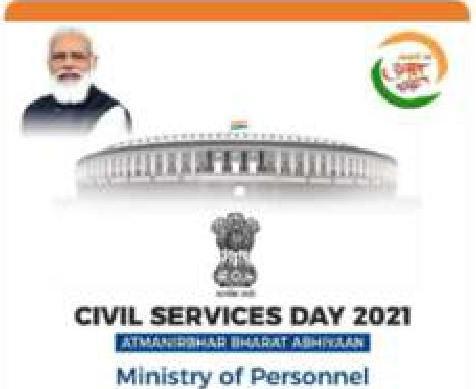
Tweet of Minister of State for Personnel, Public Grievances and Pensions

On Civil Services Day, my greetings to all civil servants and their families. From implementing policies to serving the society, our civil services have played a key role in India’s progress. I am sure that they will continue to serve the nation with the same passion & devotion.
10:06 AM – 21 Apr 21 – Twitter for iPhone
938 Retweets 21 Quote Tweets 6,262 Likes
Tweet of Hon’ble Home Minister

On the occasion of #CivilServicesDay 2021, I extend my greetings to all colleagues. Civil Servants have been at the forefront in the battle against #COVID19. I commend their untiring efforts: Cabinet Secretary Rajiv Gauba
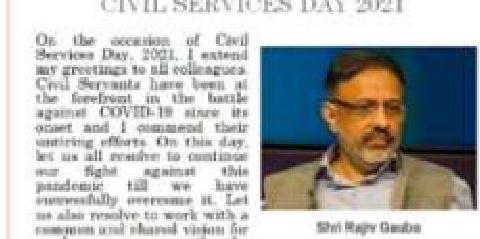
Tweet of Cabinet Secretary
22.2 Prime Minister’s Awards for Excellence in Public Administration 2021
22.2.1 The Scheme for Prime Minister’s Awards for Excellence in Public Administration has been revamped in 2021 with the objective to encourage Constructive Competition, Innovation, Replication and Institutionalization of Best Practices. The PM’s Awards 2021 will be awarded under the following six categories:
(i) Promoting “Jan Bhagidari” or Peoples’ participation in Poshan Abhiyan
(ii) Promoting excellence in sports and wellness through Khelo India scheme
(iii) Digital Payments and good governance in PM SVANidhiYojana
(iv) Holistic Development through One District One Product scheme
(v) Seamless, End to End Delivery of Services without Human Intervention
(vi) Innovations
22.2.2 Awards – The total number of awards under the Prime Minister’s Awards for Excellence in Public Administration 2021 is 18 and the Award consists of a (i) trophy, (ii) scroll and (iii) an incentive of Rs. 20 lakh to the awarded District/organization to be utilized for implementation of project/ programme or bridging resource gaps in any area of public welfare. There are two awards each under the category (i) to (iv). Under category (v), there is one award for Districts and one Award for others (State/ Central organisations). Under category (vi), a total of eight Awards are envisaged, two each for Central and State organisations and four for Districts.
22.2.3 Applications for Prime Minister’s Awards are received online on a designated portal and are evaluated by three hierarchical Committees. The shortlisting of applications is done by Screening Committees chaired by the Additional Secretary level officers, Expert Committee chaired by Secretary, Department of Administrative Reforms & Public Grievances and the Empowered Committee chaired by the Cabinet Secretary. The Empowered Committee then makes its recommendations for the consideration of the Hon’ble Prime Minister for final selection of the Awards.
22.2.4 There has been an overwhelming participation in the Prime Minister’s Awards 2021 and a total of 3422 nominations were made and till the last date 2105 completed applications received on the PM Awards portal.
22.2.5 The Prime Minister’s Awards for the year 2021 will be conferred on the Civil Services Day, 2022 function scheduled to be held on 20th -21st April, 2022. The Prime Minister’s Awards, 2019 and 2020 shall be given to the Awardees before the Civil Services Day, 2022.
22.3 Good Governance Index
22.3.1 Good Governance Index (GG) is a comprehensive and implementable framework to assess the State of Governance across the States and UTs which enables ranking of States/Districts. Key objective is to create a tool which can be applied uniformly across the States to assess impact of various interventions taken up by the Central and State Governments including UTs. Based on the GGI Framework, the Index provides a comparative picture among the States while developing competitive spirit for improvement.
22.3.2 The Government of India constituted a Group of Secretaries (GoS) on Governance who recommended developing of an index to gauge the performance of the States. Following the recommendation of the GoS on Governance, the Department of Administrative Reforms \& Public Grievances (DARPG) launched the Good Governance Index (GGI) Framework and publishing the ranking for the States and Union Territories for 2019 on the occasion of Good Governance Day i.e. 25th December, 2019.
22.3.3 Union Minister of Home Affairs and Minister of Cooperation, Shri Amit Shah in the august presence of Minister of State for Personnel \& Public Grievances, Dr. Jitrendra Singh released the Good Governance Index on Good Governance Day on 25th December, 2021 at Vigyan Bhavan, New Delhi.
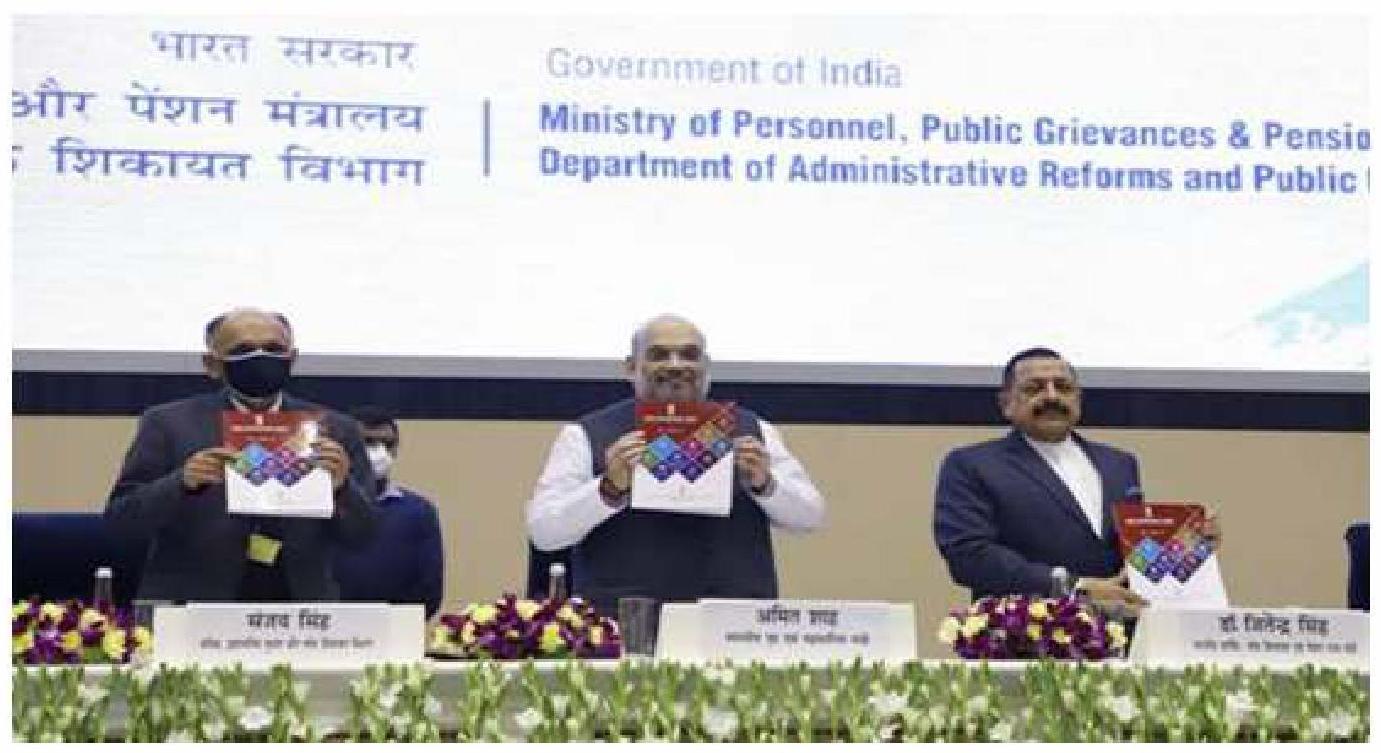
Release of Good Governance Index 2020-21 by Union Minister of Home Affairs and Minister of Cooperation Shri Amit Shah, Minister of State for Personnel & Public Grievances Dr. Jitendra Singh and Secretary, DARPG on 25th December, 2021 at Vigyan Bhavan, New Delhi
22.3.4 Good Governance Index (GGI) 202021 Framework covered ten sectors and 58 indicators. The sectors of GGI 2020-21 are 1) Agriculture and Allied Sectors, 2) Commerce \& Industries, 3) Human Resource Development, 4) Public Health, 5) Public Infrastructure \& Utilities, 6) Economic Governance, 7) Social Welfare \& Development, 8) Judicial \& Public Security, 9) Environment, and 10) CitizenCentric Governance. The GGI 2020-21 categorises States and UTs into four categories, i.e., (i) Other States – Group A; (ii) Other States – Group B; (iii) North-East and Hill States; and (iv) Union Territories.
22.3.5 Under GGI 2020-21, 20 States have improved their composite GGI Scores in GGI 2021 over the GGI 2019 index scores. Gujarat tops the composite ranking in 58 indicator index followed by Maharashtra and Goa. Uttar Pradesh registers 8.9 percent improvement in GGI indicators in the period
2019 to 2021. Jammu and Kashmir registers 3.7 percent improvement in GGI indicators in the period 2019 to 2021. Delhi tops the UT category composite ranking.
The GGI 2021 can be accessed at https://darpg.gov.in/relatedlinks/good-governance-index.
22.4 District Good Governance Index of J\&K
22.4.1 Good governance is very important factor in promoting a holistic development. Districts being a basic unit in field administration and governance, implementing various programmes and innovative projects for the well-being of citizens, measuring their performance becomes important for proper assessment and planning which will lead to the development of the districts and region as a whole
22.4.2 The District Good Governance Index (DGGI) is aimed to assess the state of governance in all 20 districts of Jammu and Kashmir based on certain sectors and selected indicators. It will enable ranking of districts and present a comparative picture. The ranking would bring about healthy completion amongst districts in the quest to
provide citizen centric administration and governance. The DGGI is expected to provide guidance to the UT & district administration of J\&K and other stakeholders in their efforts to address existing gaps, plan to bridge these gaps and aid as decision making tool.
22.4.3 The Union Minister of Home Affairs and Cooperation Shri Amit Shah virtually released India’s first “District Good Governance Index”
prepared by DARPG in collaboration with Government of Jammu \& Kashmir in the August presence of Minister of state for PMO, Personnel, PG and Pensions, Dr. Jitendra Singh and the Lieutenant Governor of Jammu \& Kashmir Shri Manoj Sinha and Secretary (DARPG) on 22nd January, 2022 at Convention Centre, Jammu.
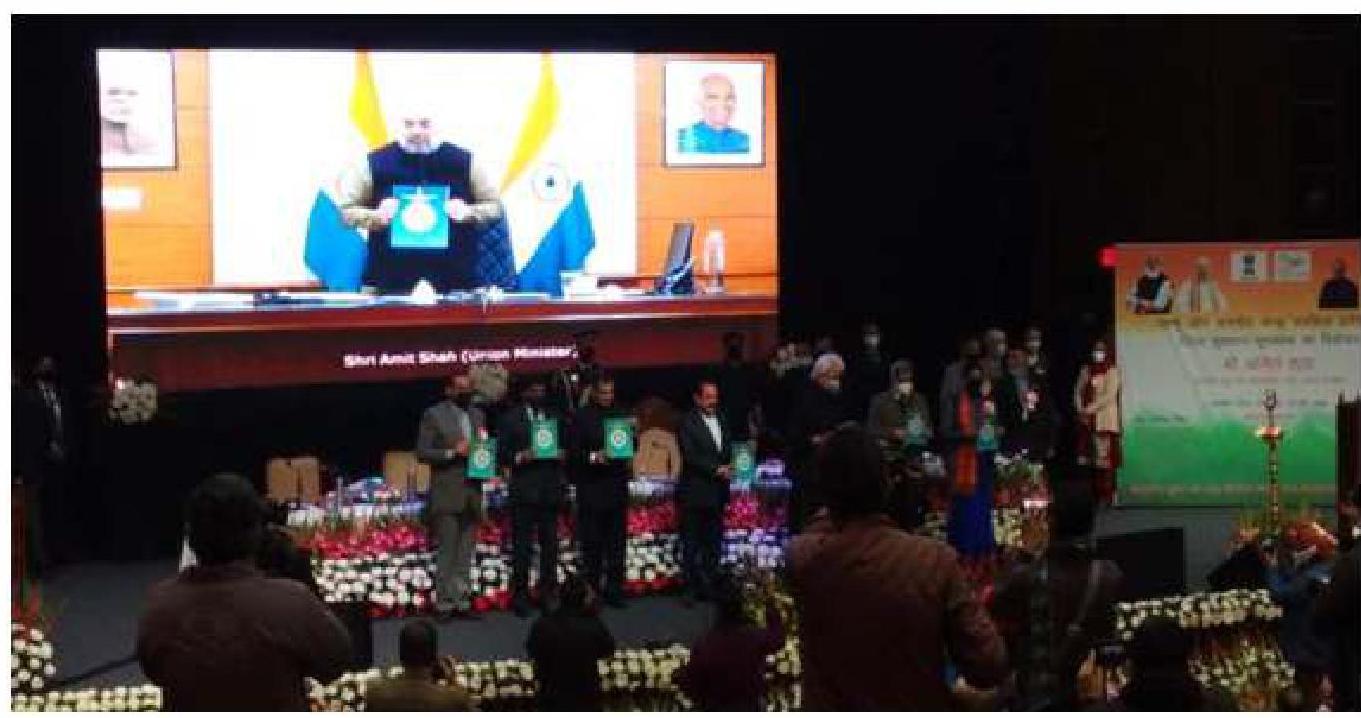
Release of DGGI of J\&K by Shri Amit Shah, Union Minister of Home Affairs and cooperation, Dr. Jitendra Singh, Minister of State for PMO, Personnel, PG and Pensions, Lt. Governor of J\&K and Secretary, DARPG ON 22ND January, 2022 at Convention Centre, Jammu
22.4.4 The DGGI of J\&K encompassed 10 Governance Sectors and 58 indicators
22.4.5 The Sectors of DGGI are; (i) Agriculture \& Allied (ii) Commerce \& Industry (iii) Human Resource Development (iv) Public Health (v) Public Infrastructure \& Utilities (vi) Social Welfare \& Development (vii) Financial Inclusion (viii) Judiciary \& Public safety (ix) Environment (x) Citizen centric governance
22.4.6 The DGGI represents Next Generation administrative reform in bench marking
governance at District level prepared after extensive stakeholder consultation. It helps in identifying the impact of various governance interventions at district level and provides a futuristic roadmap for improving district level governance with targeted interventions.
22.5 State Collaboration Initiatives
DARPG provides funds to the State Governments under the scheme “State Collaboration Initiatives” with a purpose to build collaboration with State Governments for improving public service delivery. The scheme was revised in 2015-16 to include funding for replication of PM awarded and National e-Governance awarded initiatives.
The objective of the State Collaboration Initiative is to promote and support improvement in public administration for improving service delivery through a
programmatic approach which will:
(i) Develop collaborative relationships with Central Ministries, States and other stakeholders.
(ii) Develop a coherent programme of initiatives which will support and encourage administrative reform and put citizen at centre stage, particularly the poor.
(iii) Build capacity at district, state and centre to ensure optimal use of systems and resources
22.6 National Centre for Good Governance (NCGG)
22.6.1 National Center for Good Governance was established as an autonomous institute under the aegis of the Department of Personnel and Training by upgrading the erstwhile National Institution of Administrative Research, Lal Bahadur Shashtri National Academy of Administration, Mussoorie. DARPG is Administrative authority for NCGG from 08.11.2017.
22.6.2 The Centre is envisaged to be the apex think-tank that would guide the Government and help in implementing good Governance reforms. It seeks to be a highlevel institute for research and capacity building to deal with the entire gamut of governance issues from the National to State to the local level and in sectors across the Government.
22.6.3 NCGG is governed by a Governing Body, under the Chairmanship of the Cabinet Secretary, Gol and a Management Committee with Secretary, Department of Administrative Reforms and Public Grievances (DARPG), Gol as the Chairperson.
22.7 Objectives of NCGG
- To be a think tank for governance & policy reforms, cutting across administrative, social, economic and financial spheres.
- To function as a national repository on information on best practices, initiatives and methodologies that promote Good Governance, E-Governance, innovation \&
change management within the government; - To initiate and participate in action research and capacity building on various aspects of regulatory and development administration, public policy, governance and public management at National/State \& local levels;
- To advise on key issues in governance and development synergy across various Ministries/ Departments of Gol, and State Governments;
- To promote sharing and replication of innovative ideas and best practices in Governance.
- To interact with national and international organizations, in and outside government, engaged in research and capacity building in the above spheres.
22.8 Mandate of NCGG
To promote Good Governance by:
- Carrying out Action Research/ Studies on issues relating to governance.
- Capacity Building on Public Policy and Governance at both National and International level.
- Organizing consultations, workshops, seminars \& talks to promote improved governance.
- Undertaking initiatives for citizen centric governance.
22.9 Activities of NCGG
I. International
A MoU has been signed between India \& Maldives during official state visit of the Hon’ble Prime Minister Shri Narendra Modi on 08th June, 2019. It had envisaged Capacity Building Training Programme (CBTP) for 1000 Civil Servants of Maldives over the next 5 years. Under this MoU, eight rounds of the Capacity Building Programmes have been conducted at NCGG. In precise, 230 Civil Servants from the Republic of Maldives have been trained so far.
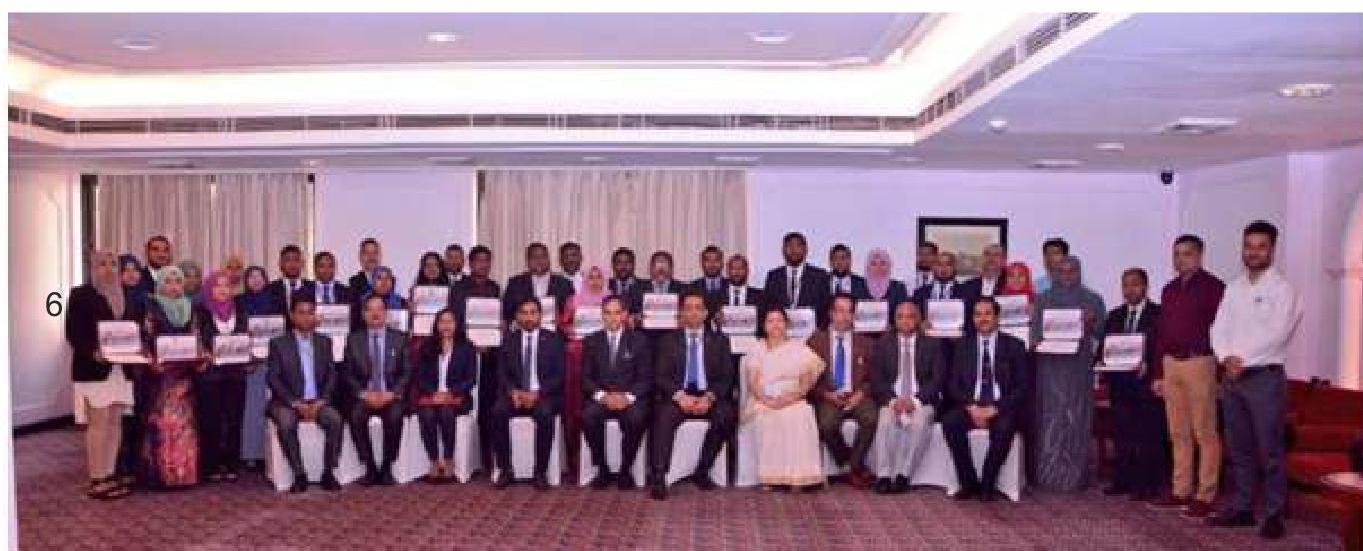
Batches conducted during the year 2021-22
| S. No | Course | Date | Participants |
| — | — | — | — |
| 1. | $06^{\text {th }}$ Capacity Building Programme
in Field Administration for the
Civil Servants of Maldives | $27^{\text {th }}$ Sept’21- $08^{\text {th }}$ Oct’21 | 30 |
| 2. | $07^{\text {th }}$ Capacity Building Programme
in Field Administration for the Civil
Servants of Maldives | $08^{\text {th }}$ Nov’21 – $19^{\text {th }}$ Nov’21 | 30 |
| 3. | $08^{\text {th }}$ Capacity Building Programme
in Field Administration for the Civil
Servants of Maldives | $20^{\text {th }}$ Dec’21 – $31^{\text {st }}$ Dec’21 | 30 |
II. National
In pursuance of the decisions announced by the Union Minister of State (Independent Charge) Development of North Eastern Region (DoNER), MoS PMO, Personnel, Public Grievances, Pensions, Atomic Energy and Space, Dr. Jitendra Singh in Kashmir Alamia during the Regional Conference on Replication of Good Governance Practices held on 01st – 02nd July 2021 at Srinagar organized by DAR&PG, Government of India and Government of Jammu \& Kashmir. During the conference, an MoU has been signed between J\&K Institute of Management, Public Administration \& Rural Development
(J\&KIMPARD) to train 2000 Senior Officers including Jammu \& Kashmir Administrative Service Officers on Public Policy \& Good Governance.
The objective of the MoU is to establish, maintain and enhance academic and intellectual interaction through specific initiatives with a view to promote excellence in Capacity Building Programmes and Practices relating to Good Governance.
The National Centre for Good Governance (NCGG) has conducted 2 batches of TwoWeek Capacity Building Programme for the Senior Officers of Jammu \& Kashmir Administrative Service.
Union Minister of State (Independent Charge) Development of North Eastern Region (DoNER), MoS PMO, Personnel, Public Grievances, Pensions, Atomic Energy and Space, Dr. Jitendra Singh, addressed the delegations from Jammu & Kashmir Administrative Service (JKAS). The delegation from J\&K has enthusiastically participated in the session of the programme.
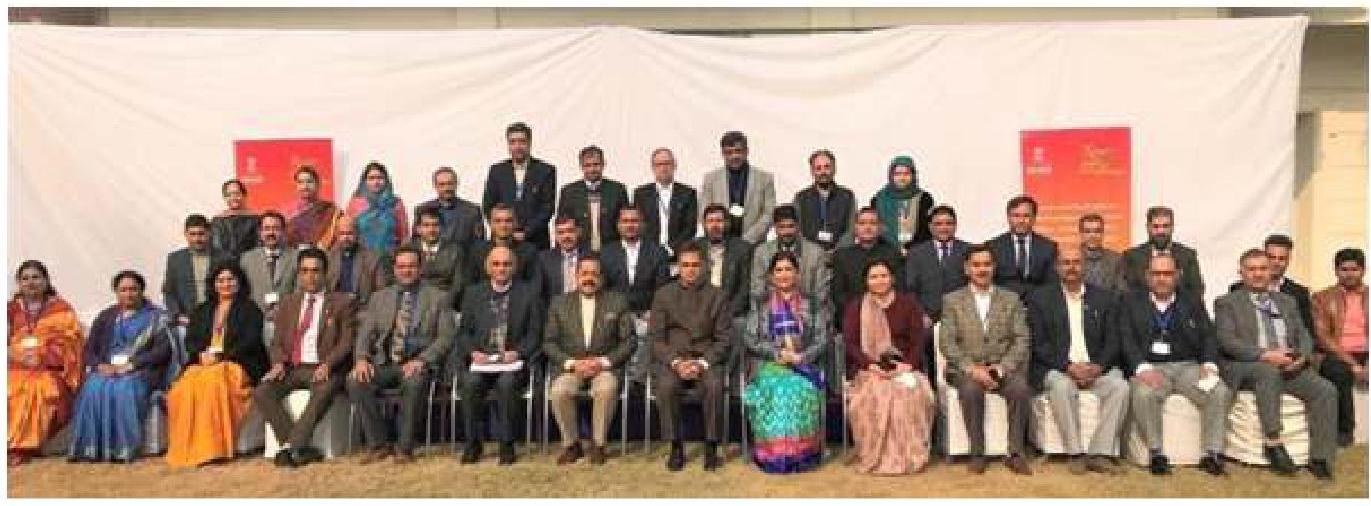
Batches conducted during the year 2021-22
| S.No | Course | Date | Participants |
|---|---|---|---|
| 1. | 1st Capacity Building Programme in Field Administration for the Senior Officers of Jammu \& Kashmir Administrative Services (JKAS) |
30th Aug’21 – 10th Sept’21 | 30 |
| 2. | 2nd Capacity Building Programme in Field Administration for the Senior Officers of Jammu \& Kashmir Administrative Services (JKAS) |
13th Dec’21 – 24th Dec’21 | 30 |
III. Good Governance Webinar Series
| S.No | Name of the Webinar | Date |
|---|---|---|
| 1. | Webinar on “Central Secretariat Services – Meeting the Challenges of New India” |
$02 / 12 / 2021$ |
| 2. | 72nd Indian Constitution Day Celebrations – Webinar on “Civil Services under the Indian Constitution” |
$26 / 11 / 2021$ |
| 3. | NCGG – ITEC Webinar on “Administrative Innovations – India Post & UDAN” |
$03 / 09 / 2021$ |
| 4. | Webinar on “The Comparative History of Civil Services of United States of America, Nigeria \& India” |
$18 / 08 / 2021$ |
| 5. | NCGG – ITEC Webinar on “Administrative Innovations – Passport Seva Kendra \& e-Office |
$06 / 08 / 2021$ |
| 6. | Webinar on “Effective, Accountable \& Inclusive Governance – Public Administration Reforms to Empower People” |
$30 / 07 / 2021$ |
| 7. | Webinar on “Principles of Good Governance: Role of Institutions to Achieving Sustainable Development |
$29 / 06 / 2021$ |
| 8. | NCGG – IIM Indore – University of Texas Webinar on “Does Leadership Matter? Improving Job Satisfaction and Commitment in the Public Service” |
$25 / 06 / 2021$ |
| 9 | Webinar on “Worldwide Governance Indicators \& Good Governance Index” |
$16 / 04 / 2021$ |
IV. Studies/Publications
NCGG and Centre for Good Governance (CGG), Hyderabad have entered into an MoU on $12^{\text {th }}$ May 2020 to “Design and Development of Good Governance Index (GGI), 2020” under the overall supervision of DAR\&PG, Govt. of India. The Good Governance Index (GGI) 2020-21 report has been published during the Good Governance Week on December $25^{\text {th }} 2021$.
The Worldwide Governance Indicators (WGI), 2020 report has been prepared in collaboration with Public Affairs Centre, Hyderabad.
NCGG has published a book on COVID – 19 Pandemic and Public Governance Measures \& Lessons Learned of States/UTs of India in consultation with 31 Universities of India.
NCGG is publishing a book on “Governance during the Pandemic: International Best Practices of COVID – 19” involving best practices of 20 Countries during the pandemic of COVID – 19.
NCGG is publishing a book on “Governance during the Pandemic: Best Practices of COVID-19 Management in Aspirational Districts in India”
To work on Public Policy \& Governance issues, NCGG has collaborated with several institutes such as IIM Indore, IIM Sambalpur, IIM Vishakapatnam, IIM Bangalore, IIT Delhi, Rajasthan University, Madras Christian College, Mizoram Central University \& Jamia Millia Islamia and Azim Premji University Bangalore.
CHAPTER
Public Grievances
The Public Grievances Division is responsible for issuing policy guidelines and coordinating & monitoring of issues regarding redress of public grievances for the Central Government. In accordance with federal principle of governance, the grievances relating to States are forwarded to concerned State Government for appropriate action. To provide a more responsive and citizen-centric governance, the PG Division coordinates efforts to formulate and operationalize the Citizen’s Charters of various Ministries/Departments and State and UT Governments. The PG Division also handles Sevottam which is a part of a citizen-centric quality management framework for better service delivery.
23.1 The Allocation of Business Rules, 1961, allocates to DARPG inter alia, the responsibility for Policy, Coordination and Monitoring of issues relating to (a) Redress of Public Grievances in general and (b) Grievances pertaining to Central Government Agencies, in particular. The Public Grievance Division is responsible for this activity since December 1987. From 1997, the Division has also been made responsible for several Citizen-Centric Initiatives under the platform of ‘Responsive Government’. These include Citizens’ Charter, and Sevottam, for bringing improvement in public service delivery on a continuous basis.
23.2 The management of Public Grievances today envisages reduction in grievances, by bringing continuous improvement in Public Service Delivery and in the Public grievance redressal system.
23.3 The Public Grievances Division has undertaken various activities during the year, some of which are on-going activities from the previous years, to improve the grievances redressal mechanism and to provide citizencentric governance.
23.3.1 CPGRAMS – An online system for grievance redress, called the ‘Centralized Public Grievance Redress and Monitoring System’ (CPGRAMS) has evolved since 2007. CPGRAMS facilitates forwarding of public grievances received online from the citizens to
both the Central Government Ministries /Departments/Organisations as well as the State Governments concerned. The inflow of these Centre and State related grievances are in two forms (i) online registered grievances through CPGRAMS and (ii) offline grievances received through post. The grievances received through post are digitized, uploaded on CPGRAMS and forwarded online through the System as well as by post to the Central Ministries /Departments/Organisations/State Government concerned. At present, the Department has undertaken CPGRAMS Reforms in the top grievance receiving Ministries/Departments. The CPGRAMS reforms envisages to ensure user friendly lodging of grievance by a citizen and enable navigation of the grievance to reach the field office responsible for resolution of the same. CPGRAMS Reforms will streamline grievance redressal mechanism so that the grievances reach the rightful redressal Office, surpassing the line offices. The broader salient features of the CPGRAMS Reforms 7.0 are that it is citizen friendly as there is a questionnaire guided registration process. Besides, there is a provision of lodging a grievance which will be automatically forwarded to field level directly. The system has also improved grievance redress time and lodging of grievance is done through drop down menus.
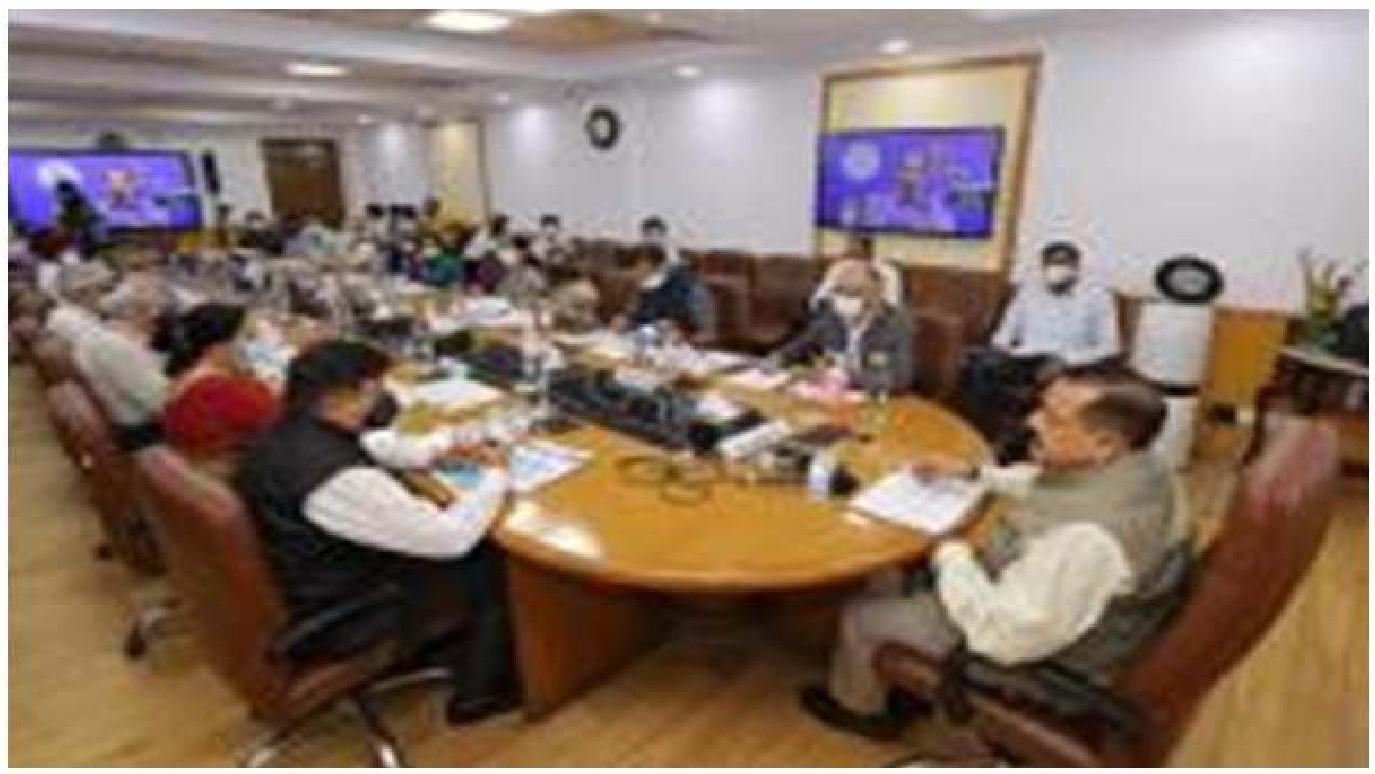
Inspection Review of Special Campaign progress by MoS
23.3.2 CPGRAMS Reformed version 7.0 has been launched and implemented in 13 Ministries / Departments namely Department of Posts, Departments of Telecommunications and Financial Services (Banking & Insurance Division), Ministry of External Affairs, Ministry of Health \& Family Welfare, Ministry of Petroleum and Natural Gas, Ministry of Road Transport \& Highways,
Department of School Education, Ministry of Civil Aviation, Ministry of Labour and Employment, Department of Personnel \& training and Department of Higher Education. The CPGRAMS Reforms are proposed to be implemented in the remaining Ministries/Departments receiving the maximum number of grievances in a phased manner.
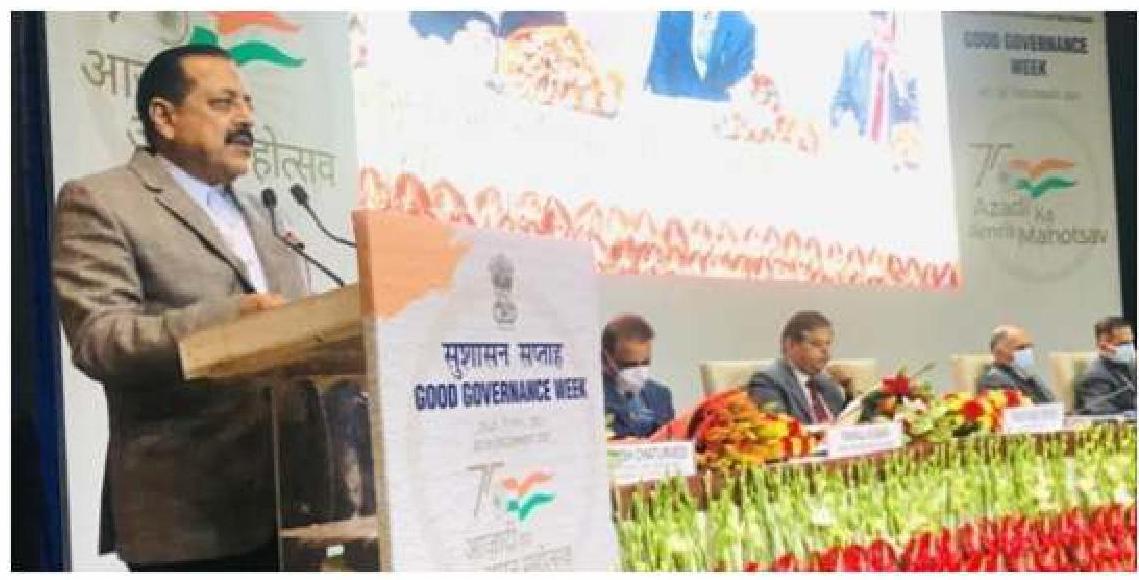
Inauguration of Good Governance Campaign “Prashashan Gaon ki Aur”
23.3.3 Citizens can use a Mobile App for lodging of public grievances and the action Status can also be viewed on the mobile itself. This mobile app is integrated with Unified Mobile Application for New-age Governance (UMANG). The app is available in both Android and iOS versions. A new mobile app called My Grievance is also available which is independently for CPGRAMS.
23.3.4 Public grievance mechanism of PMO, the President’s Secretariat, the Directorate of Public Grievances (Cabinet Secretariat),
Department of Administrative Reforms & Public Grievances (DARPG) and the Pensioners’ portal has been duly integrated through CPGRAMS thus enabling grievances lodged to any of these entities to be transferred to the Central Ministries/Departments and State Governments online through CPGRAMS. The CPGRAMS interlinks 90 Central Ministries/Departments/ Organisations and 36 States /UTs. There are more than 68,000 sub-ordinate users listed on CPGRAMS.
Year wise Receipts/ Disposal graph on grievances received on CPGRAMS Receipt/Disposal graph of Total receipts in CPGRAMS, as on 31.12.2021
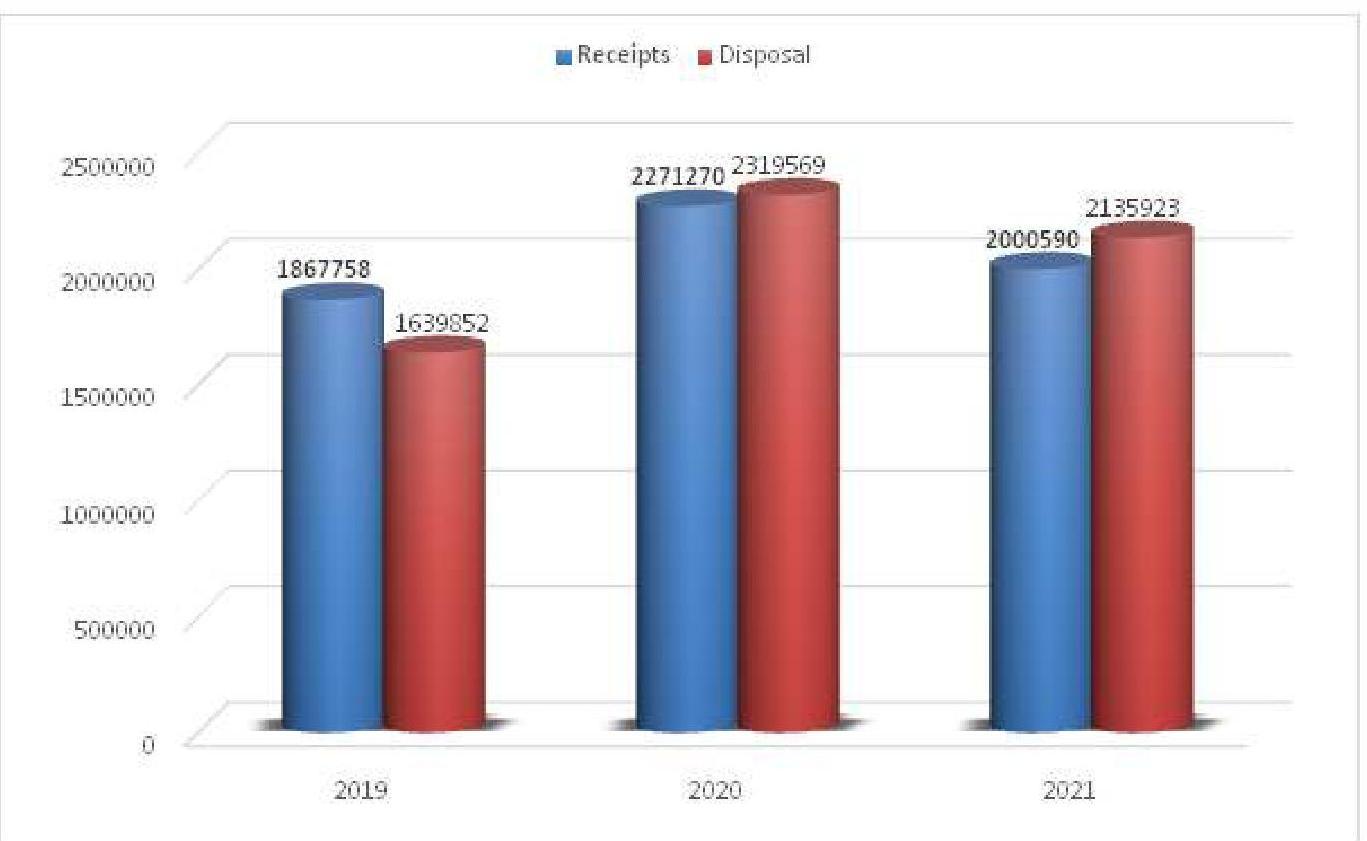
Receipt/Disposal graph of GOI Organizations in CPGRAMS, as on 31.12.2021
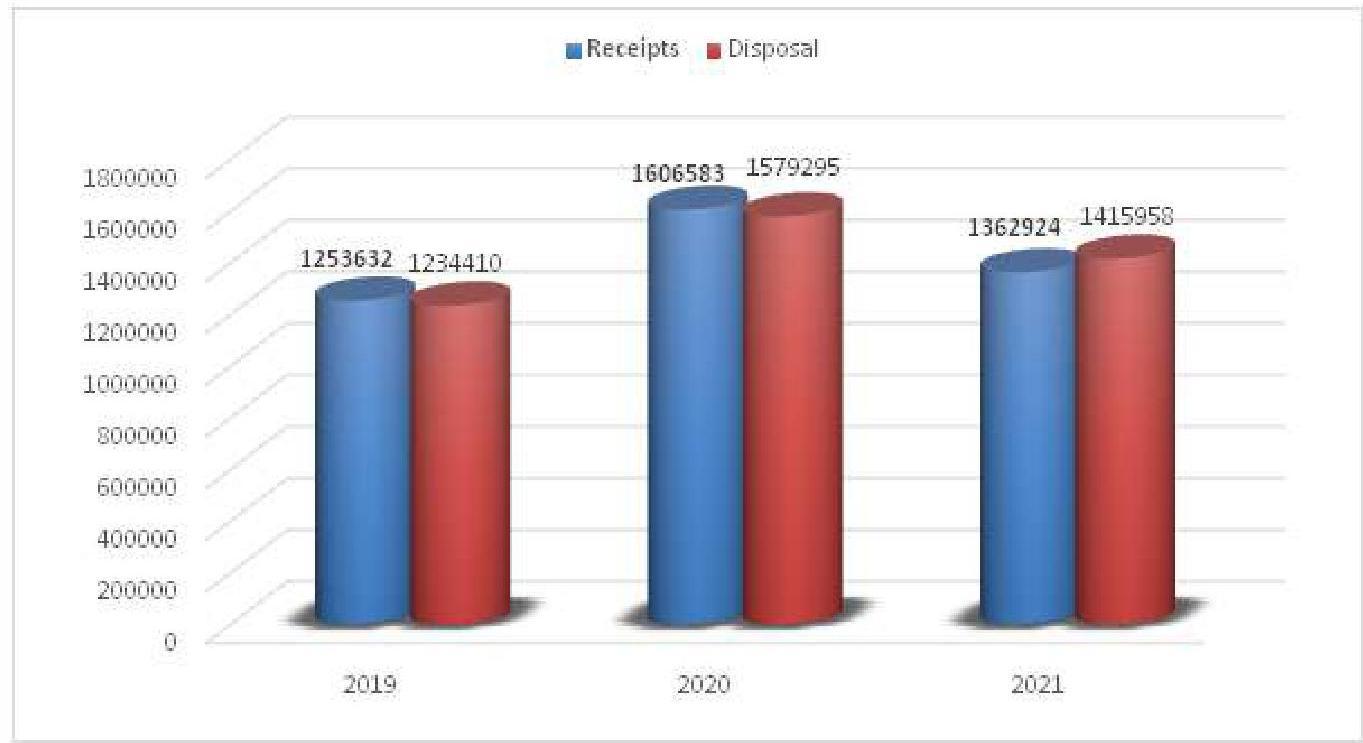
Total No of Organizations registered in CPGRAMS : 79828
Total Ministries/ Departments : 90
Total /States/UTs : 36
Details of Grievances Received in DARPG during 01.01.2021 to 31.12.2021
Total Receipts : 49122
Received by Post/Physical : 3974
Received online : 45148
Forwarded to States : 22942
Forwarded to Centre : 26180
Receipt/Disposal graph of grievances received in States on CPGRAMS, as on 31.12.2021
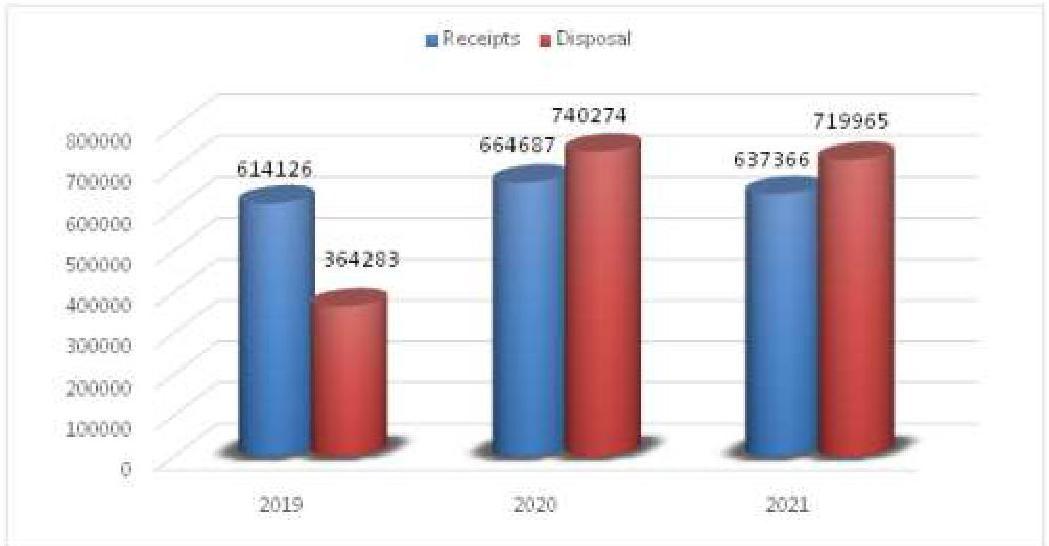
23.3.5 During the year, the Division has extensively used the System to forward public grievances to the State Governments. The inflow of State related grievances is in two forms (i) through the CPGRAMS and (ii) through post. The grievances received by post are digitized and sent both through the System as well as by post to the State Government concerned. During 2021 a total of 22,942 grievances have been sent to State Governments by Department of AR&PG.
23.3.6 CPGRAMS integration with State portal has also been taken up by DARPG. As of now while 15 States have been integrated with CPGRAMS, 4 States are in the process of integration and 14 States/UTs are using CPGRAMS for redressal of public grievances. One Portal One Nation is the goal and towards this end Integration of CPGRAMS with State Grievance portals is being pursued further.
23.3.7 As a pioneer of district level integration with CPGRAMS, the JK-IGRAMS integrates the grievances from the Centralized Public Grievance Redress and Monitoring System (CPGRAMS) at the top with the last mile district level offices in the UT of Jammu \& Kashmir at the bottom. Earlier only the Jammu \& Kashmir Secretariat Departments and their Directorates were linked. However, now the Offices at District
level have been linked and mapping up to Tehsil level and Block level has been done. The Union Territory of J\&K consists of 20 Districts and all these 20 Districts of the UT of Jammu \& Kashmir have been mapped and integrated with the grievance redressal portal of JK-IGRAMS as well as the Central Government grievance redressal portal of CPGRAMS
23.3.8 The Department holds regular meetings to monitor and review the pendency of grievances and for expediting action on them. During the year 2021, 03 intensive review meetings have been held for reviewing the status of pending public grievances in Ministries/Departments/Organisations and expediting action on them. Out of these one was exclusively regarding ‘Redressal of COVID-19 Public Grievances’.of COVID-19 Public Grievances’.
Over the years CPGRAMS has become more responsive with high rates of disposal and progressive reduction in average disposal time. In this regard a circular No.S-15/21/2021-O/o DS(PG)-DARPG(7085) dated 22.6.2021 was issued reducing the maximum time limit for disposal of grievances from existing 60 days to 45 days.
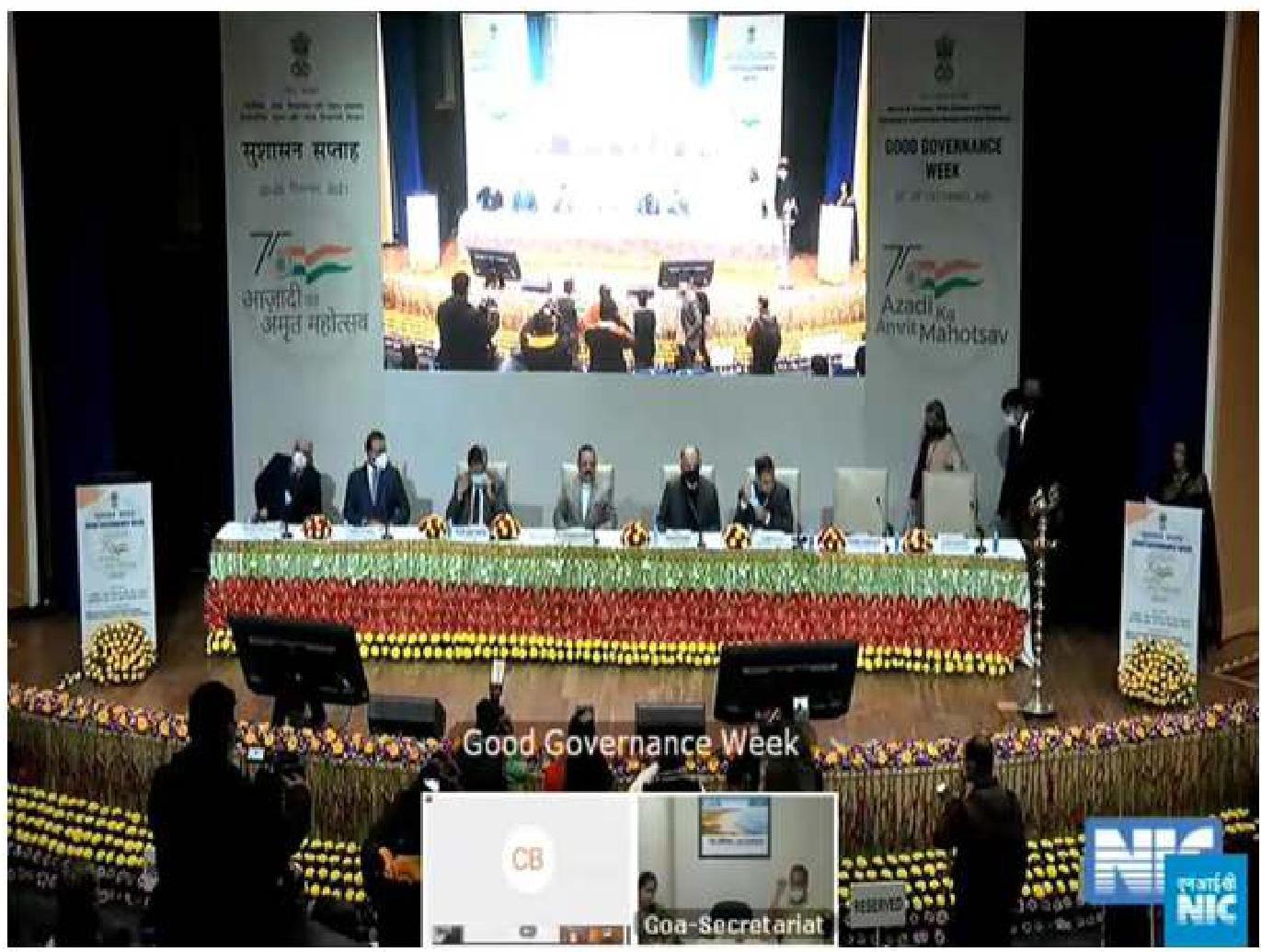
(Inauguration of Good Governance Week
23.3.9 Introduction of an Appeal Mechanism/functionality in CPGRAMS –
The Appeal Mechanism/functionality in CPGRAMS in line with the Department related Parliamentary standing Committee Recommendations in its 100th Report has been introduced. The recommendations were communicated to all Central Ministries/Departments with the request to nominate a Nodal (Appellate) authority. The Appeal provision has been made for redressal of dis-satisfied grievances identified through a mandatory feedback rating to be given by the Citizen on disposal of the grievance by the Nodal Grievance Officers.
23.3.10 A separate workflow and functionality for escalation of grievances to appeal authorities in CPGRAMS has been
operationalized by the Department of Administrative Reforms and Public Grievances. The time line for resolution of an Appeal by the Nodal Appellate Authority is 30 days of receipt of the same. The Appellate Authority to whom a dis-satisfied Complainant can raise/escalate a public grievance is one level above the existing designated Nodal Grievance Officers. As of now the details of the nominated Nodal Appellate Authorities of 84 Ministries/Departments are available on the website at pgportal.gov.in. The Appeal Module is being operationalized by NIC in two interfaces.
23.3.11 In the Citizens Interface, a complainant can file an appeal if he/she is not satisfied with the redress/reply of the grievance. Once the grievance is closed/disposed of, the complainant
can view the details of final disposal which includes the feedback section and the complainant needs to mandatorily provide the feedback on the redressal of his/her grievance. The option of feedback is also available in the dashboard of the complainant. Five ratings will be available to the Citizen namely, Excellent, Very Good, Good, Average and Poor. It is under ‘Poor’ rating only, the option to file an appeal will be enabled to the petitioner. The petitioner will be asked whether he/she wants to raise their concern with Nodal Appellate Authority and if ‘Yes’ option is pressed then the ‘Reason for Appeal’ would be sought from the Complainant. After providing of the requisite information the complainant can successfully file an appeal. The status of the Appeal can also be tracked by the petitioner with the grievance registration number.
The motive is to build trust with the citizen through effective and speedy redress of the grievances which would pave the way for good governance.
23.3.12 Operationalisation of Permanent
Call Centre:-
DARPG is in the process for setting up permanent Feedback call centre. The call centre will seek feedback from the Citizens on disposed of Grievances and also help citizens to file/track their grievances if such help is needed by them. It will be useful in spreading awareness among Citizens about CPGRAMS and to get the satisfaction of the citizens and area of improvement.
23.3.13 Introduction of Artificial Intelligence (AI)/Machine Learning (ML) tools:-
A MoU have been signed with IIT, Kanpur to Introduction of Artificial Intelligence (AI)/Machine Learning (ML) tools in the system in partnership with IIT, Kanpur to categories grievances and assess quality of resolution.
23.3.14 Redressal of Public Grievances during Special Campaign and Good Governance Week:-
A special campaign was launched on disposal of pending matters including Public Grievances and cleanliness drive was undertaken from 2nd October to 31st October, 2021 in every Ministry/ Department of government of India including their attached/ subordinate offices and autonomous organizations across the country and abroad. During the Special Campaign total 303415 Grievances were addressed. Further, Government of India celebrated Good Governance Week (GGW) under the auspices of Azadi Ka Amrit Mahotsav during 20-25 December, 2021. DARPG as the lead Department had conceived, conceptualized and implemented the programme in collaboration with all Central Ministries and all State Governments/UTs. During the event apprx. 6.67 lakh public Grievances were attended to.
23.3.15 Introduction of new format of ATR:-
It has been decided to develop a new format of Action Taken Report (ATR) for CPGRAMS. This would provide a matrix for assessment of quality of resolution. This will also feed into Artificial Intelligence/Machine Learning Tool to enable assessment of quality of resolution. This ATR would be required to mandatorily fill by Grievance Redressal Officers at the time of uploading disposal detail in CPGRAMS.
23.3.16 Setting of DSU in DARPG:-
DARPG has engaged NISG through contact dated 24.12.2021 for setting up a Data Strategy Unit (DSU) initially comprising 7 members. The PMU is expected to perform all the activities required for DARPG, ranging from software development, managing front end, backend, API integration, data analysis data visualisation, develop AI/ML algorithms & scripts and management of CPGRAMS \& other IT applications of DARPG including eOffice.
23.3.17 leverage strength of Common Service Centres (CSC)
CPGRAMS being a digital platform may have certain accessibility challenges for those who
are on wrong side of digital divide. 5.1 lakh CSC will facilitate citizens to register their grievances through CPGRAMS as per the standard and norms. With this regards a MoU has been signed with CSC on 20.09.2021 to leverage strength of Common Service Centres (CSC) to take the facility of CPGRAMS to rural population. This will also popularise CPGRAMS in rural population.
23.4 PUBLIC SERVICE DELIVERY
23.4.1 One of the citizen-centric initiatives that were taken by this Department was to develop a Quality Management System (QMS) framework called ‘Sevottam’ for bringing excellence in service delivery by Government organizations. This has institutionalized an assessment-improvement framework for improving the quality of service delivery on a continuous basis through the involvement of Ministries / Departments and citizens. Sevottam comprises of 3 modules in relation to a public service organization viz., (a) Citizens’/Clients’ Charter that specifies the service delivery standards (b) Grievance Redress Mechanism that gets activated if the service delivery is not as per standards in the charter, and (c) Service Delivery Capability of the organization to delivery service as per standards in the charter.
23.4.2 As part of the Strategic Plan for Capability Building towards implementing Sevottam Quality Management System (QMS), a Scheme for Strengthening of Administrative Training Institutes (ATIs) was implemented during the 12th Five Year Plan 2012-2017 in Govt. approved Training Institutions in 10 States. State ATIs which are being funded under the Scheme are Punjab, Haryana, Rajasthan, NCT Delhi, Karnataka, Tamil Nadu, Uttar Pradesh, Madhya Pradesh, Himachal Pradesh and Jharkhand. This Scheme has been extended for a further period up till 31.03.2021. The Scheme has resulted in capacity building of the ATI by
enabling conducting of training programmes and workshops by the ATIs for sensitizing the officers of the State Government for implementation of Citizens’ Charter and Grievance Redress Mechanism. Under the Scheme, an amount up to Rs. 20 lakh can be released annually to the ATIs based on the UC received for the funds released during the previous years and the performance of the concerned ATIs during the previous year (s) in which funds have been released.
However, in the past years it has been found that except one or two ATIs there has been no demand for Grants received from the ATIs for Sevottam related activities. In view of this, the scheme is being reviewed in consultation with the State Governments and also through third party evaluation by Indian Institute of Public Administration.
23.5 CITIZENS’/ CLIENTS’ CHARTERS
23.5.1 In view of decision taken in Conference of Chief Ministers held on 24th May, 1997 presided by Hon’ble Prime Minister, formulation of Citizen’s Charter by Central & State Governments began. The process started with sectors having large public interface (e.g. Railways, Telecom, Posts, Public Distribution Systems). Charters were required to include (i) standards of service (ii) time limits for public service delivery (iii) avenues for grievance redress. Guidelines for formulating the Charters as well as a list of do’s and don’ts were communicated to various government Departments/ Organisations by DARPG to enable them to bring out focused and effective charters. A comprehensive Website of Citizens’ Charter, www.goicharters.nic.in was launched by the DARPG on 31 May, 2002 which apart from guidelines contains the Citizens’ Charters existing in Ministries/Departments/States/ UTs/Organisations.
24
ORGANISATION AND METHODS DIVISION
Mandate
- Formulation and simplification of office procedures.
- Publication and updating of the paper based Central Secretariat Manual of Office Procedures (CSMOP), electronic based Central Secretariat Manual of e-Office Procedure (CSMeOP).
- Aiding and advising the Central Ministries/Departments and States/UTs Government on O&M aspects.
Central Secretariat Manual of Office Procedure (CSMOP)
24.1 The Department of Administrative Reforms and Public Grievances brought out the Fifteenth Edition of the Central Secretariat Manual of Office Procedure, 2019 (CSMOP, 2019) on the occasion of Good Governance Day i.e. 25th December, 2019. In this edition of the Manual the Procedures laid down in the Central Secretariat Manual of Office Procedure, 2015 and the Central Secretariat Manual of Electronic Office Procedure 2012 have been aligned in light of advances made in digital governance. The salient features of CSMOP 2019 are as under:
(i) The Manual have 16 Chapters. Definitions have been categorized as Glossary and given at the end of the CSMOP 2019.
(ii) Decision making in Government, Knowledge Management, and Digitization Framework are three new Chapters.
(iii) Provision for officers of the rank of DS and above to obtain Virtual Private Network (VPN).
(iv) Provision for officers of the rank of ASO and above to obtain Digital Signature Certificate (DSC).
(v) The e-office procedure has been incorporated in the form of e-boxes in the chapters wherever applicable.
24.2 Increasing Efficiency in Decision making
Efficient decision making is fundamental to a responsive and accountable governance. The Central Secretariat Manual of Office Procedure (CSMOP) has been a guiding framework for effective functioning of the Central Secretariat offices. The fifteenth additions of the Manual i.e. CSMOP-2019 was brought out with the aim of bringing simplicity, efficiency and transparency in government processes and procedures. With a view to increase efficiency in decision making in Central Secretariat it was decided to reiterate the provisions of CSMOP. Accordingly a workshop was organised by DARPG under the Chairpersonship of Cabinet Secretary on 26 March, 2021. The key action points emanating from the workshop were as under:
- To review channel of submission to ensure that levels in a channel of submission do not exceed four.
- Examine existing delegations for expeditious decision.
- Making use of Desk Officer System effectively.
- Optimal use of digital tools including eOffice for faster decision making.
- Strengthening of Central Registry Unit (CRU)
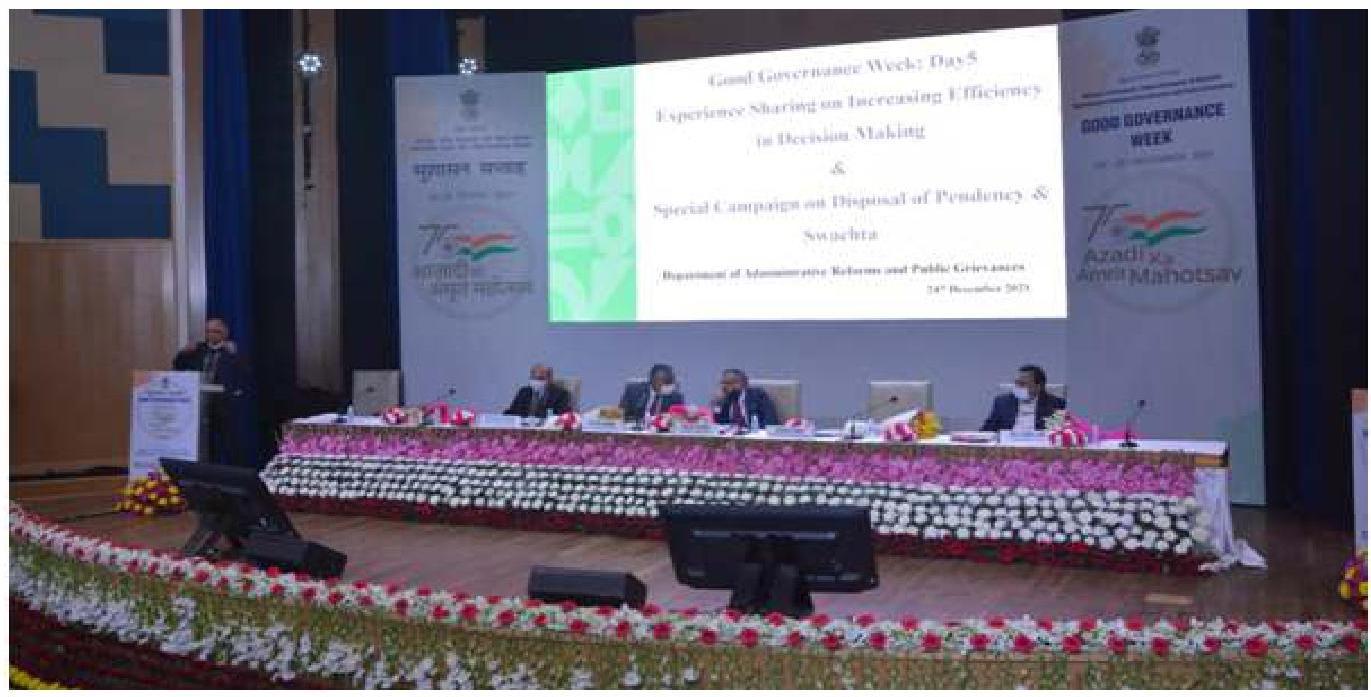
The Government’s campaign for Increasing Efficiency in Decision Making was adopted in almost all Ministries/Departments of the Central Secretariat. The campaign represents one of the most complicated and far-reaching administrative reforms witnessed in the Central Secretariat. The initiative for increasing efficiency in decision making has transformed work culture, reduced hierarchies and resulted in significant adoption of new technology. It has also enabled responsive communication and enhanced efficiency in processing receipts. Reduction in paper consumption was also witnessed.
24.3 Special Campaign on Disposal of Pendency (2nd October, 2021 to 31st October, 2021)
A Special Campaign on disposal of pending matters and cleanliness drive was undertaken from 2nd October to 31st October, 2021 in every Ministry/ Department of government of India including their attached/ subordinate offices and autonomous organizations across the country and abroad. During the campaign all pending references received from Members of parliament, State Governments, Inter-ministerial references,
Parliament assurances and Public grievances were to be taken up for disposal in mission mode approach. Records to be reviewed and files/ papers which have completed their retention cycle was to be weeded out in accordance with the set procedure and protocol. Special cleanliness drive both indoor and outdoor in all government buildings including disposal of scrap was also part of the special campaign. The campaign witnessed thousands of officials showing immense enthusiasm and support for the initiative. The campaign has been a resounding success and met Government expectations. To conduct and coordinate the campaign nodal officers were appointed in each Ministry. A dedicated portal was created to monitor real time progress of the campaign. DARPG coordinated and monitored the campaign aggressively with all the nodal officers. During the campaign about 44.89 lakh records were reviewed and 22 lakh records were weeded out. Rs.62.00 cr. was earned from the disposal of scrap. Weeding out of records and scrap disposal have freed up about 12 lakh sq. ft. space for productive use. Cleaning drive in offices which included renovation/ repair / whitewash etc. was undertaken. About 5968 outdoor
cleanliness campaigns were also conducted by the Ministries/ Departments.
The monitoring mechanism instituted during
the special campaign is being continued and Ministries/Departments are being monitored against pendency on monthly basis.
SWACHHTA CAMPAIGN
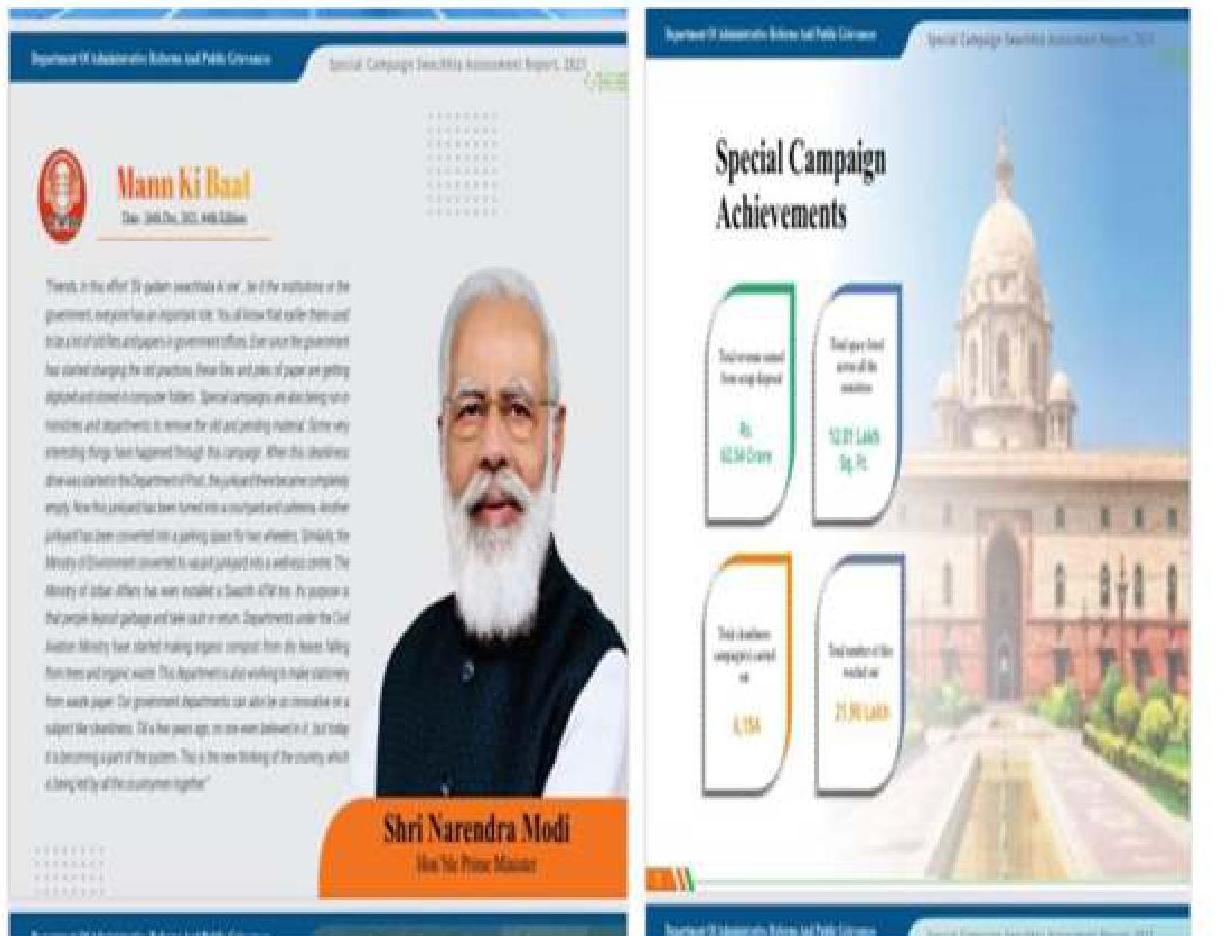
Cleanliness Campaigns: Ministry of Railways
Space freed post cleanliness drive at Ground Floor of Rail Bhawan
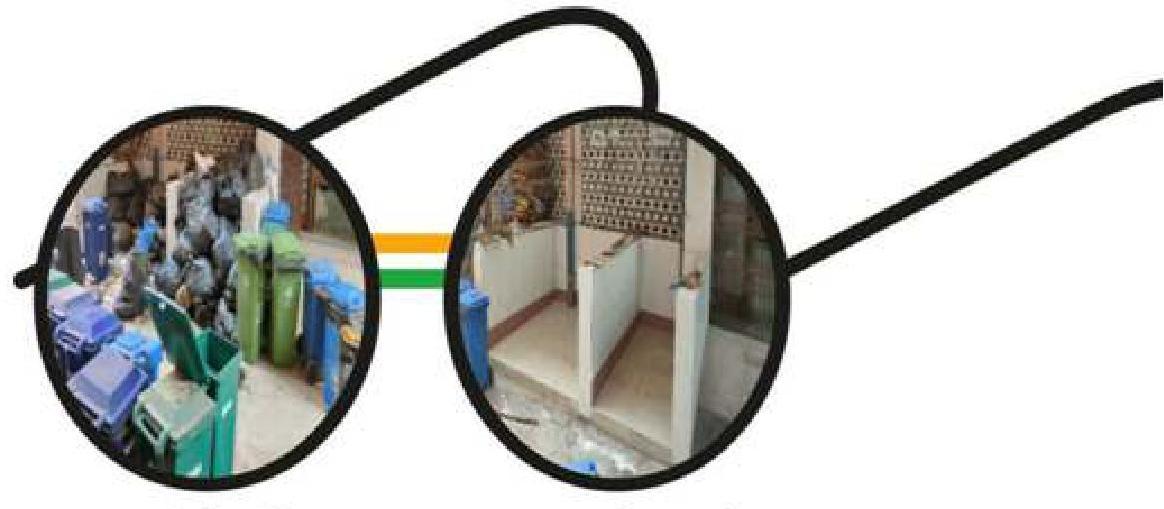
Cleanliness Campaigns: Department of Posts
8428 sq feet was freed up on the third floor of the Delhi Circle Office. A badminton court with light facility has also been developed for the staff in this area.
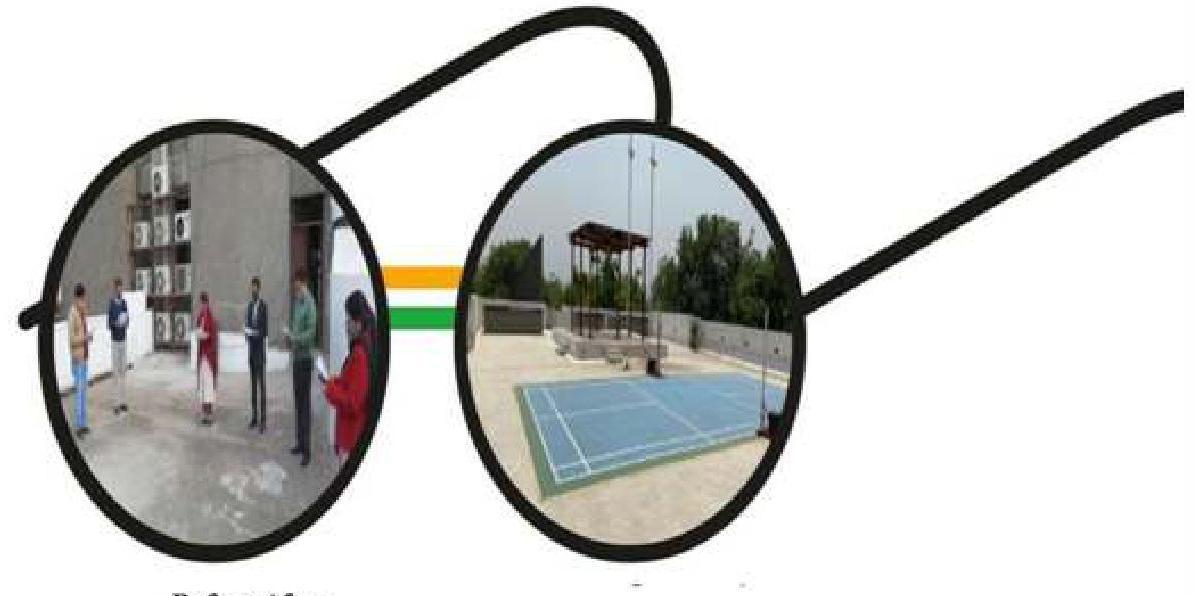
Department of Administrative Reforms & Public Grievances
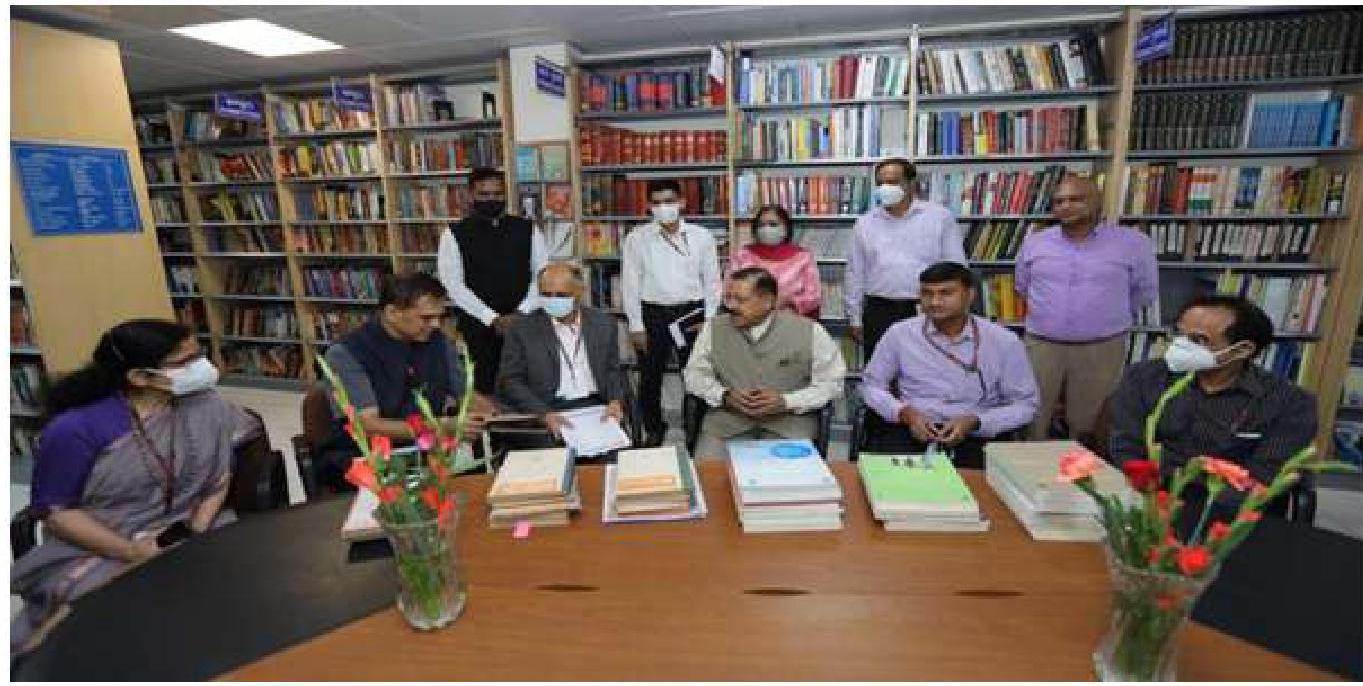
Vision India@2047
Vision India@2047 DARPG
The DARPG is amongst the Ministries/ Departments of Government that is formulating its Vision India@2047. The DARPG constituted an Advisory Group under the chairmanship of Minister of State for PMO, Personnel, PG and Pensions with 15 Sector Specialists with
National Experts from Senior Civil Servants, IIT’s, IIM’s Central and State Universities, and Public Policy Research Organizations. A working group under the chairmanship of Secretary DARPG was constituted for formulation of the Vision India@2047 under the overall supervision of the Advisory Group. The Indian Institute of Public Administration served as the Knowledge Partner of DARPG informulating its VisionIndia@2047.
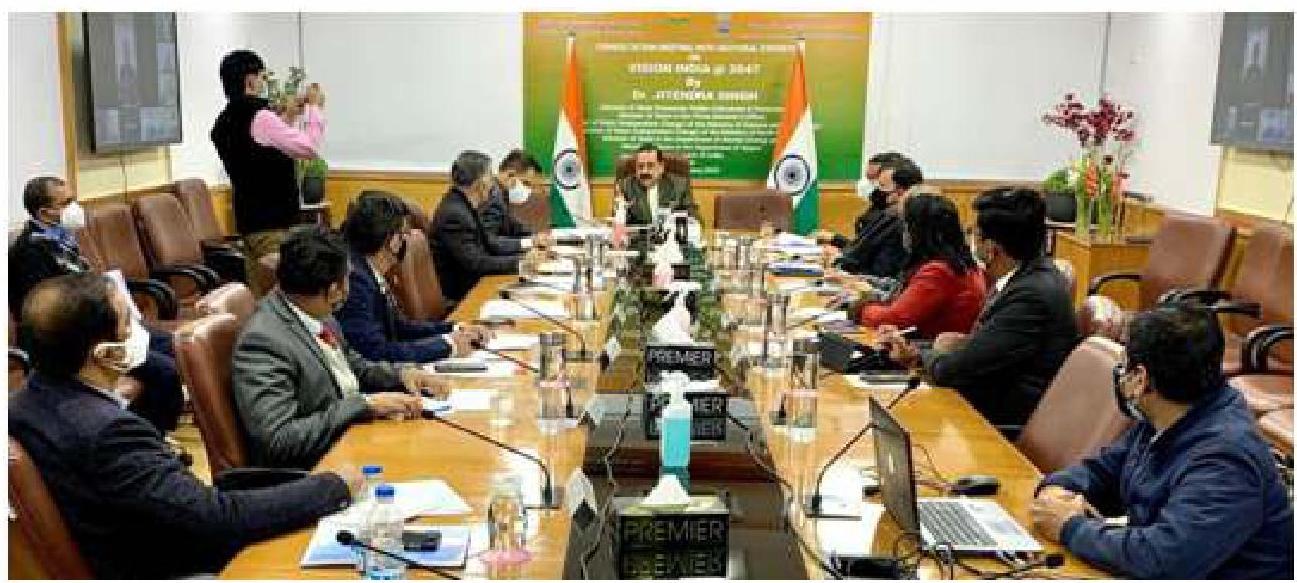
> The Consultation meetings of the Advisory Group formulated the broad contours of India’s futuristic governance plan. The consensus amongst the Sector Specialist swastha technology would play a critical part in the futuristic governance models of India redefining citizen and government relations where technology is an enabler and citizen is the master. Governance would also be data driven, in which evidence based futuristic indices for governance would be drawn up. The foundational and non-negotiable values of
ethics and integrity – a quest for Naitik Bharat would continue to be emphasised. The Advisory Group deliberated on the importance of interactions between young start-up innovators from private sector entrepreneurs and young technology experts with young innovators in government.
Based on deliberations of working group and Advisory group DARPG prepared a Vision India 2047 document with the theme of Bringing Citizens and Government together.
CHAPTER
e-GOVERNANCE
25.1 24th National Conference on eGovernance
The 24th National Conference on eGovernance was held on 07.01.2022 08.01.2022 in Hyderabad, Telangana. The theme of this Conference was “India’s Techade: Digital Governance in a Post Pandemic World”.
The Conference was inaugurated by the Chief Guest, Dr. Jitendra Singh, Union Minister of State (Independent Charge), Ministry of
Science and Technology, Ministry of Earth Sciences, Minister of State in the Prime Minister’s Office, Minister of State of Personnel, Public Grievances & Pensions, Department of Atomic Energy and Department of Space, Government of India and presided by Shri K. T. Rama Rao, Cabinet Minister for Municipal Administration and Urban Development, Industries, Information Technology Electronics and Communications, Government of Telangana.
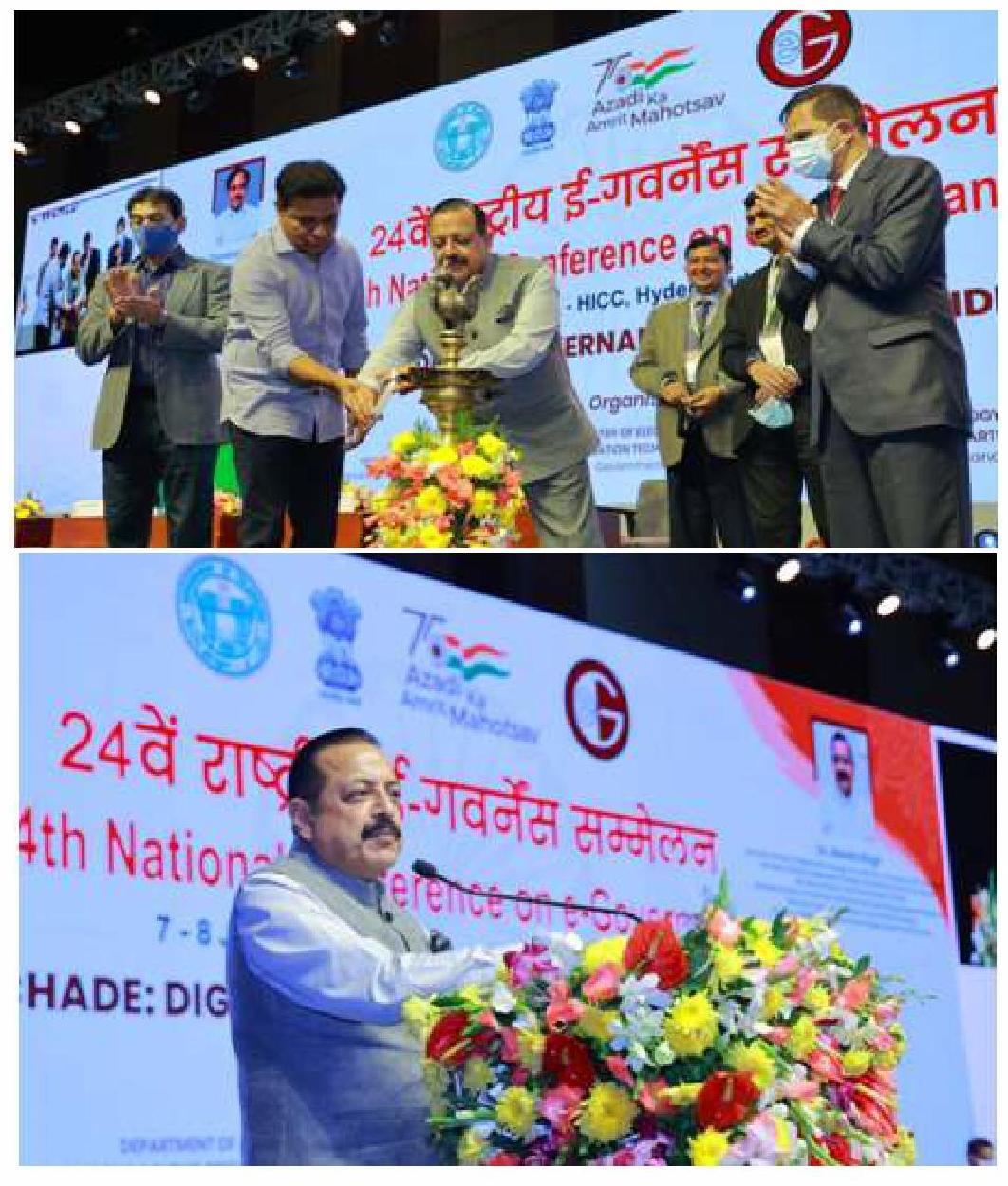
The Conference was attended by over 2000 delegates in semi-virtual mode which included delegates from Government of India, State/UT Governments, Industry, Academia, and
Private Sector. An Exhibition including Wall of Fame showcasing the awarded and other best practices of the country was also organized during the Conference.
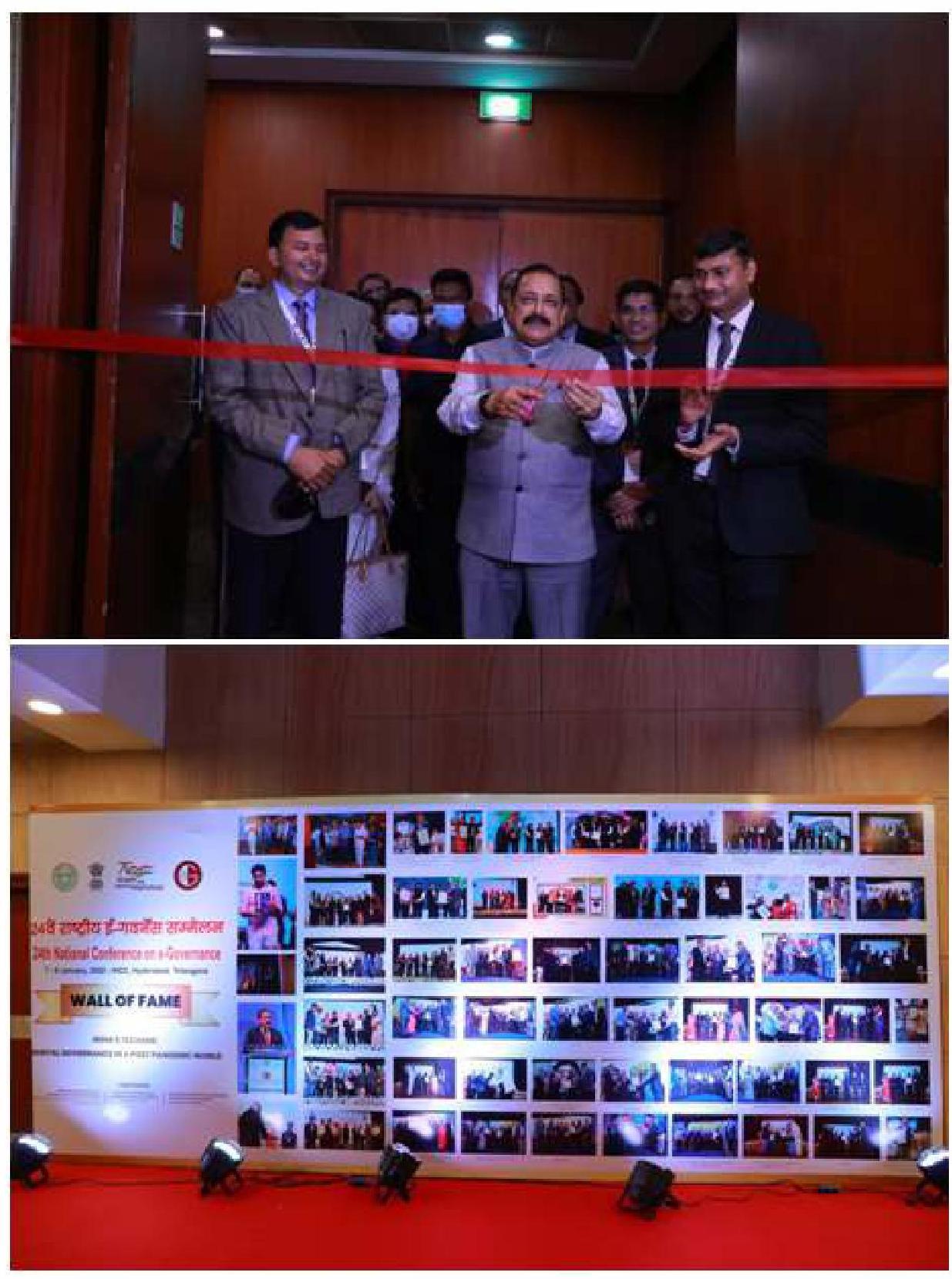
The 24th NCeG represented a platform for constructive exchange of ideas on some of the latest technologies for promoting eGovernance. More than 50 speakers presented their papers in semi-virtual mode. The Distinguished speakers invited for the Conference shared their knowledge and insights on the themes identified for the Conference. Discussions were held on the following themes in plenary sessions –
(i) Aatma Nirbhar Bharat: Universalization of Public Services
(ii) Innovation- Platformization, Emerging Technologies
(iii) Presentation by Gold Awardees (Centre/State)
(iv) Ease of living through Technology Interventions for Good Governance
(v) Government Process Re-engineering and Citizen’s participation in Government Processes
(vi) Replicability and sustainability in eGovernance – Best Practices
There were also parallel breakout sessions, where, apart from discussions on the following themes, the awardees of National eGovernance Awards 2021 from Centre, State and District showcased their award winning entries:
(i) Unicorns of 2021: Demonstrating Power of Innovation
(ii) Digital Excellence at District level
(iii) Creating a technology Innovation Ecosystem
(iv) Seamless, End to End service delivery without human interference through technological interventions
The 24th NCeG provided all participating State and UT Government teams with a detailed view of the latest concepts and technologies to
promote e-Governance and enable them to go back with useful takeaways for being implemented in their respective States and UTs. The focus of all the sessions was on learning by experience sharing as well as effective e-governance tools for benefits of the citizen and to achieve Prime Minister’s vision of ‘Minimum Government, Maximum Governance’ through “Sabka Saath, Sabka Vikas, Sabka Vishwas, Sabka Prayas”.
25.2 National Awards for e-Governance
To recognise the implementation of eGovernance initiatives, the National eGovernance Awards 2021 were presented during the Inaugural Session of the Conference. Total 26 awards were presented under the following 6 categories of the Award Scheme to Central Ministries/ Departments, State/UT Governments, Districts, Local Bodies, Public Sector Undertakings and Academic & Research Institutions:
(i) Excellence in Government Process Reengineering for Digital Transformation
(ii) Universalizing Access including eServices
(iii) Excellence in District level initiative in eGovernance
(iv) Outstanding research on Citizen Centric Services by Academic/Research Institutions
(v) Excellence in Adopting Emerging Technologies
(vi) Use of ICT in the Management of COVID 19
12 Gold, 13 Silver and 1 Jury Award were given during the 24th NCeG. The list of awardees is attached at Annexure-IV.
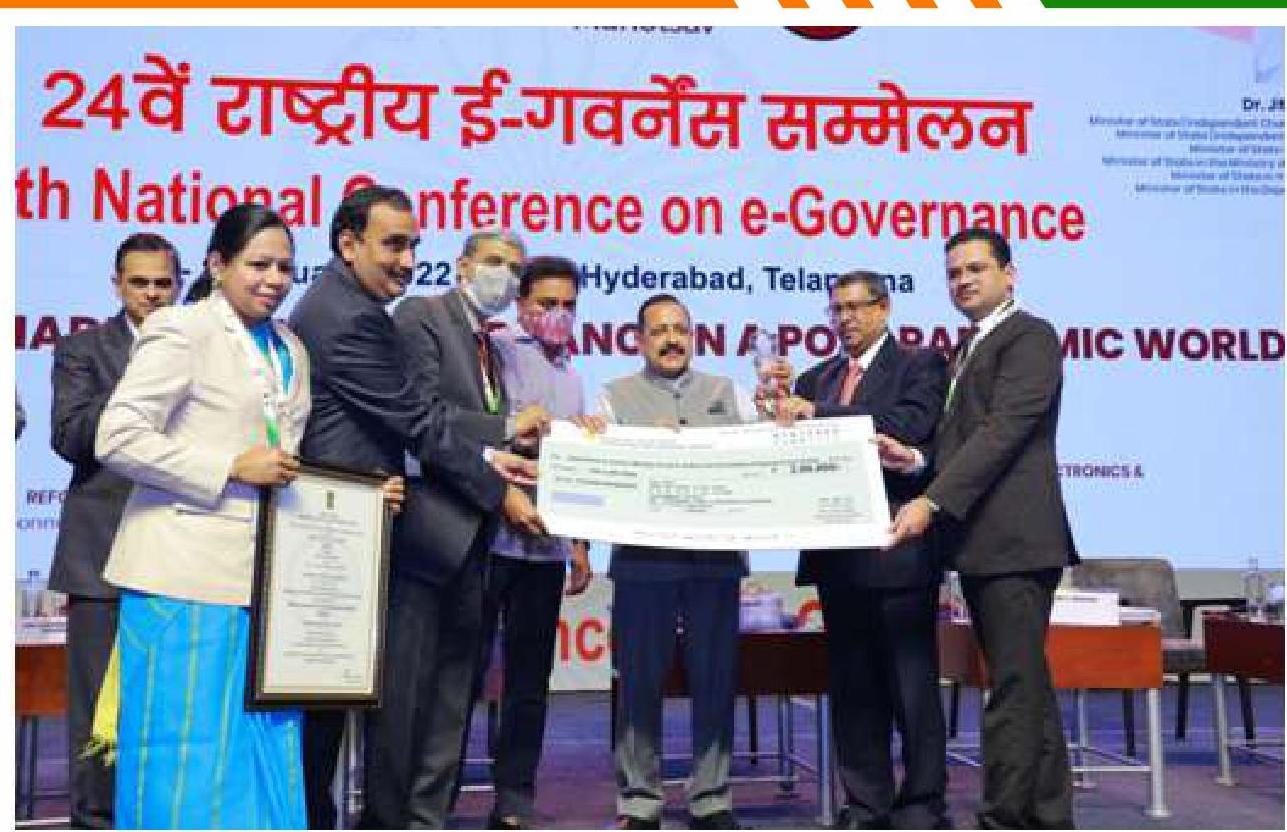
e-Courts Mission Mode Project team led by Shri Barun Mitra, Secretary, Department of Justice (Project Head) accepting the Gold award for category-I- Excellence in Government Process Re-engineering for Digital Transformation
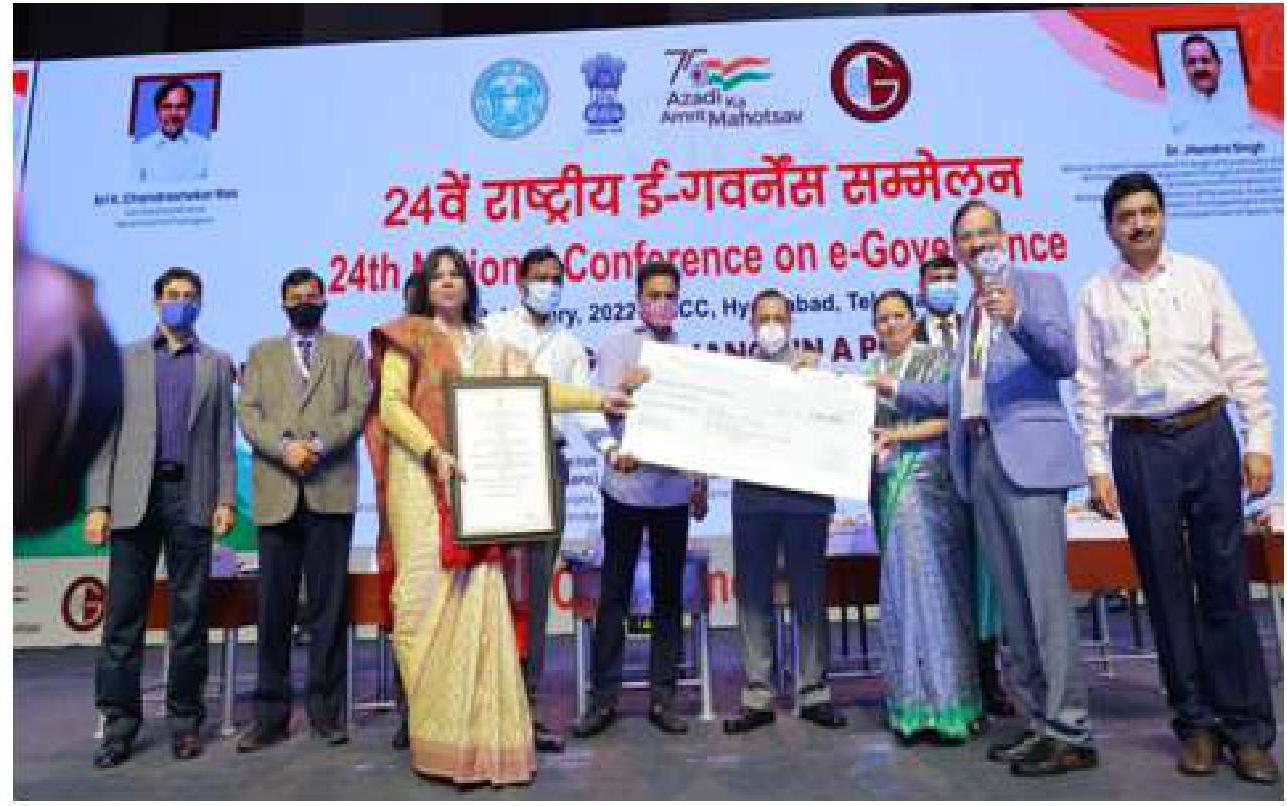
Telangana State Mana Isuka Vahanam (My Sand Vehicle) Project team led by Shri Rajendra Nimje, Director General, CGG (Project Head) accepting the Silver award for category-II-Universalizing Access including e-Service
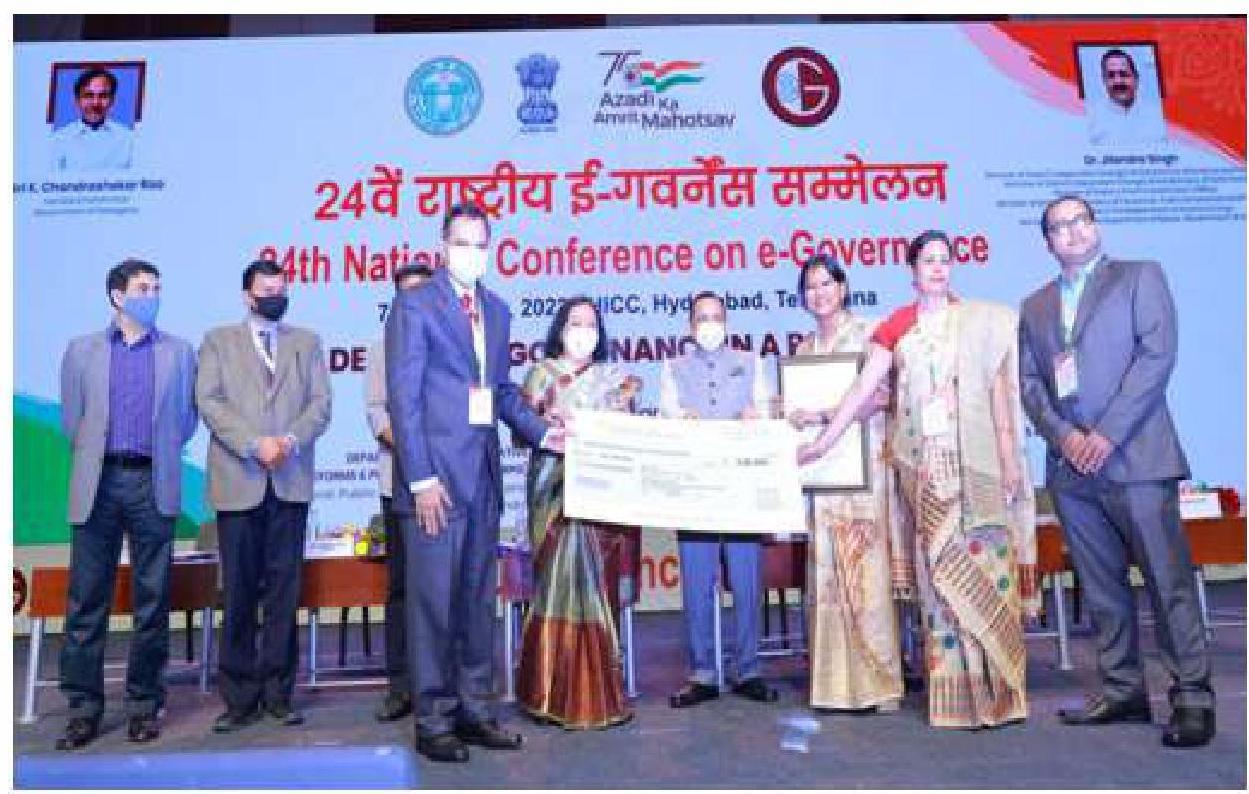
Goalmart Project team led by Smt. Varnali Deka, Former Deputy Commissioner, Goalpara (Project Head) accepting the Gold award for Category -I- Excellence in Government Process Re-engineering for Digital Transformation
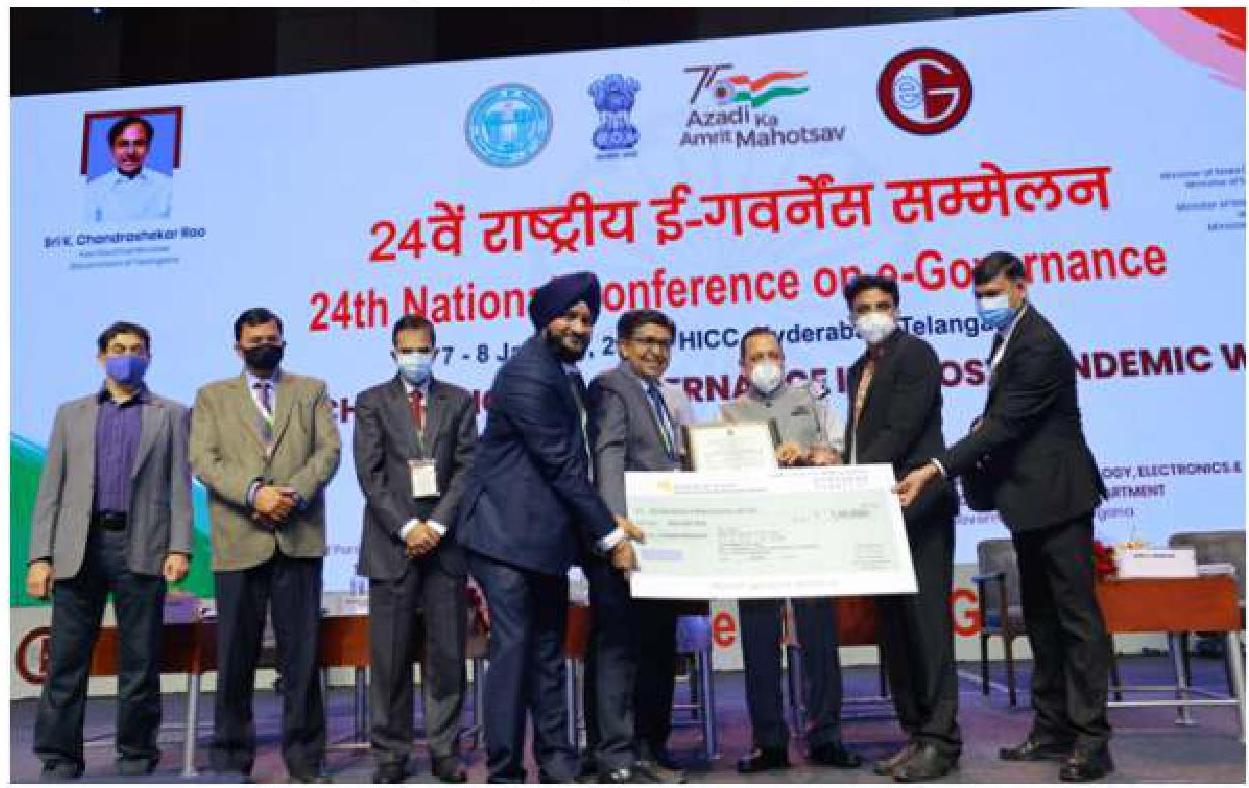
An RCT to compare the effectiveness of Mobile app based prescription vs. conventional prescription of analgesics and adjuvant ad Project team led by Dr. Gopichandran Lakshmanan, Associate Professor, AIIMS (Project Head) accepting the Silver award for Category IV – Outstanding Research on Citizen Centric Services by Academic/Research InstitutionsA film of 5 minutes duration on e-Governance was released during the event.
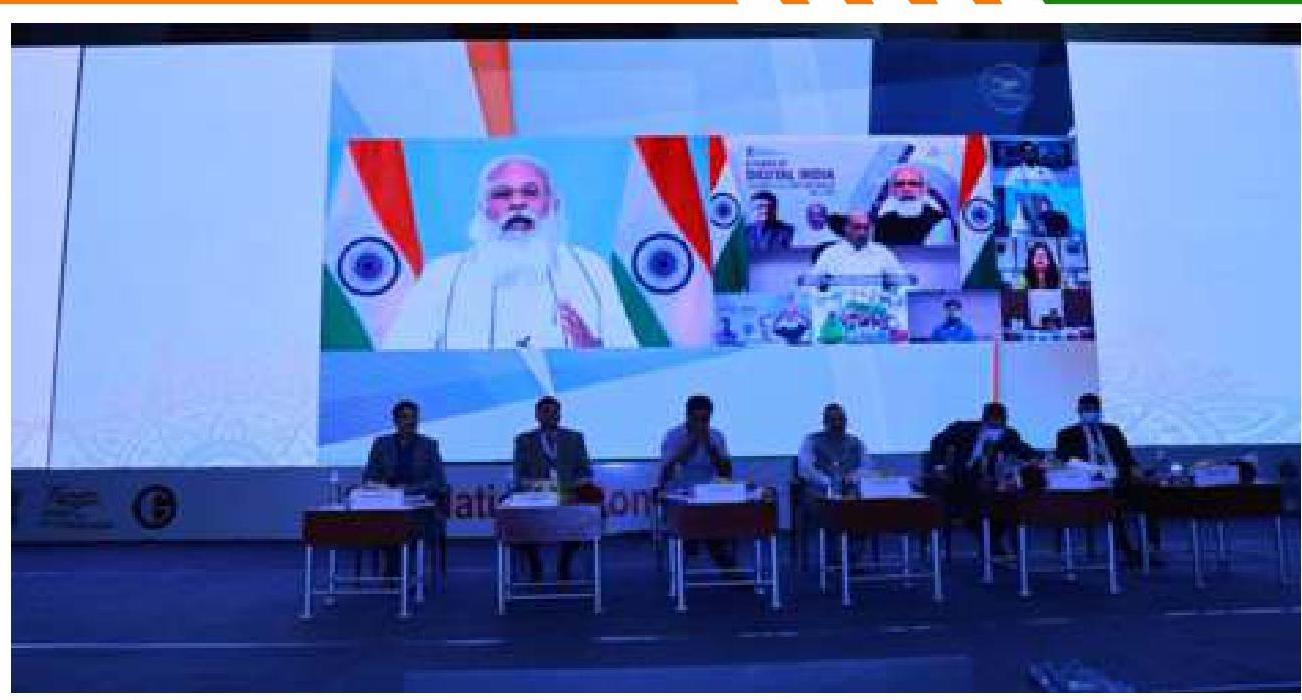
Three books were also released, viz. (i) Citations for National e-Governance Award Winners 2021, (ii) Excellence in e- Governance and (iii) India’s Techade: Digital Governance in a Post Pandemic World- Compendium of e-Governance Initiatives.
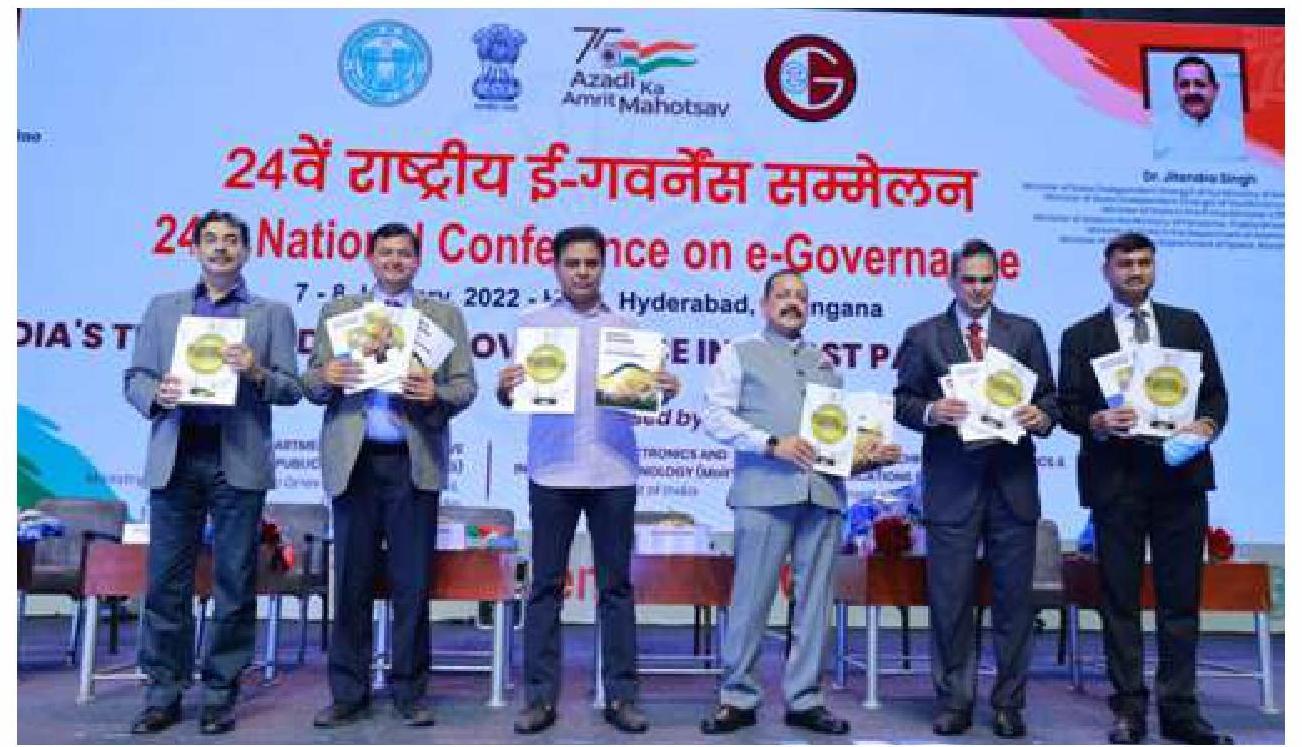
From left to right Shri Jayesh Ranjan, Pr. Secretary (IT), Govt. of Telangana, Shri S.N. Tripathi, DG, IIPA; Shri K.T. Rama Rao, Hon’ble Minister (IT), Govt. of Telangana, Dr. Jitendra Singh, Hon’ble MoS (PP), Govt. of India, Shri V. Srinivas, Secretary, DARPG, Govt. of India; Shri NBS Rajput, Joint Secretary, DARPG, Govt. of India
25.3 Hyderabad Declaration
As India celebrates 75th year of Independence as Azaadi ka Amrit Mahotsav, the Prime Minister’s clarion call for adoption of Next Generation Administrative Reforms for bringing citizens and government closer was the focus of the Conference deliberations. In the Valedictory Session of the Conference, ‘Hyderabad Declaration’ was unanimously adopted outlining the intensive deliberations held during various sessions over two days.
24वें राष्ट्रीय ई-गवर्नेंस सल्मोलन 24th National Conference on e-Governance
7 – 8 January, 2020 HICC, Hyderabad, Telangana
CHADE: DIGITAL GOVERNANCEIN ACOST PANDEMIC

From left to right Smt. L. Rama Devi, Director, Govt. of Telangana; Shri Jayesh Ranjan, Pr. Secretary (IT), Govt. of Telangana, Shri S.N. Tripathi, DG, IIPA; Shri V. Srinivas, Secretary, DARPG, Govt. of India; Shri NBS Rajput, Joint Secretary, DARPG, Govt. of India, Smt. Prisca Mathew, Deputy Secretary, DARPG, Govt. of India
The copy of Hyderabad Declaration is annexed at Annexure-V.
25.4 National e-Governance Service Delivery Assessment (NeSDA)
The first National e-Governance Service Delivery Assessment (NeSDA) Report, 2019 was released during the 23rd National Conference on e-Governance (NCeG) held in Mumbai on 07.02.2020 & 08.02.2020. NeSDA aims to benchmark States, UTs and Central Government Ministries on their e-Governance / e-Services delivery with the overall objective to improve the delivery of citizen centric services and replicate the best practices. The study identifies the areas of strength and the challenges being faced in the implementation
of e-Governance initiatives and outlines future policies and strategies in these areas. It is expected to give an impetus to Government’s objective of reducing Government-Citizen Interface through improved e-Governance delivery systems and reinforce the vision of Minimum Government and Maximum Governance. DARPG has launched the online survey portal for National e-Governance Service Delivery Assessment (NeSDA), 2021 on 09.06.2021 for assessing the States, UTs and Central Government Ministries.
Various project progress review meetings were held with 13 identified Central Ministries/Organizations and with all the States/UTs to review the status of NeSDA, 2021. Citizen Survey was also launched on NeSDA portal to determine the satisfaction levels of respondents based on their experience in availing e-services of their States/UTs. Citizen Survey is an integral part of National e-Governance Service Delivery
Assessment (NeSDA) and was launched to gain insight on citizens’ experience in availing e-services from their respective States/UTs. All the States/UTs were requested to publicize the survey among citizens of the state/UT and encourage them to participate in the survey. MeitY was also requested to host the survey on MyGov portal and to give ample publicity to the same. NeSDA 2021 Report is under preparation.
CHAPTER 26
26.1 The Department of Administrative Reforms & Public Grievances (DARPG) deals with matters relating to international exchange and cooperation in the field of Public Administration and Governance, which includes, among other things, organizing programmes and visits of Indian delegations to foreign countries and visits of foreign delegations to India as part of projects / bilateral measures in furtherance of activities included in the Memorandum of Understandings (MOUs) / Agreements signed between India and other countries (bilateral or multilateral).
26.2 The aim of international exchange and cooperation component is to share information, best practices and personnel across national governments. Presently bilateral MoUs in the areas of Public Administration and Governance have been signed with Portugal, United Kingdom, Singapore and Australia, The Gambia and trilateral MoU with Brazil and South Africa (IBSA).
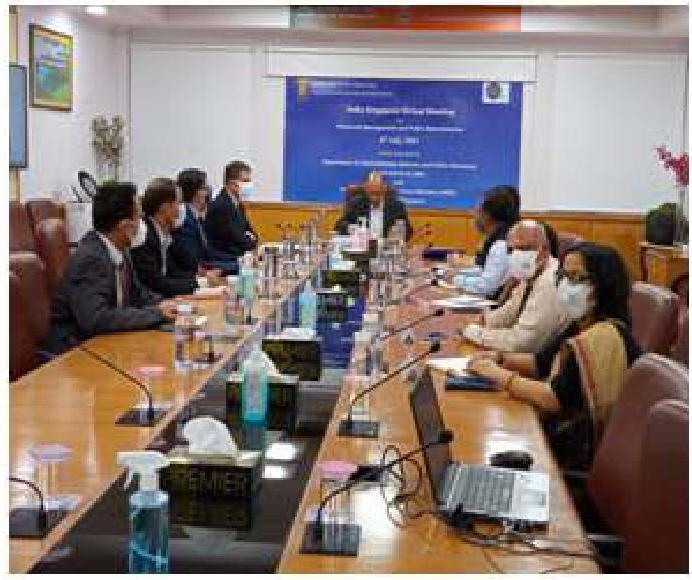
26.3.4 During the meeting, both sides shared experiences on Good Governance Practices in a Pandemic, Transforming Leaderships and Ethics, Capacity Building and Training of
The following activities were held during the year 2021-22:
26.3 India-Singapore Cooperation
26.3.1 The MoU for cooperation in the field of ‘Personnel Management and Public Administration’ was signed by the Department with the Public Service Division of the Republic of Singapore on 1st June, 2018.
26.3.2 The areas of cooperation under the MoU include (i) Workforce, Workplace and Jobs; (ii) Public Service Delivery; (iii) Human Resource Management; (iv) Public Sector Reform; (v) Leadership/Talent Development; and (vi) e-Governance/ Digital Government.
26.3.3 Both sides held a virtual bilateral meeting on “Personnel Management and Public Administration” on 6th July, 2021 under the aegis of MoU. The bilateral meeting was led by Shri Sanjay Singh, the then Secretary, DARPG from Indian side and Mr. LohKhum Yean, Permanent Secretary, PSD, Singapore from Singapore side.
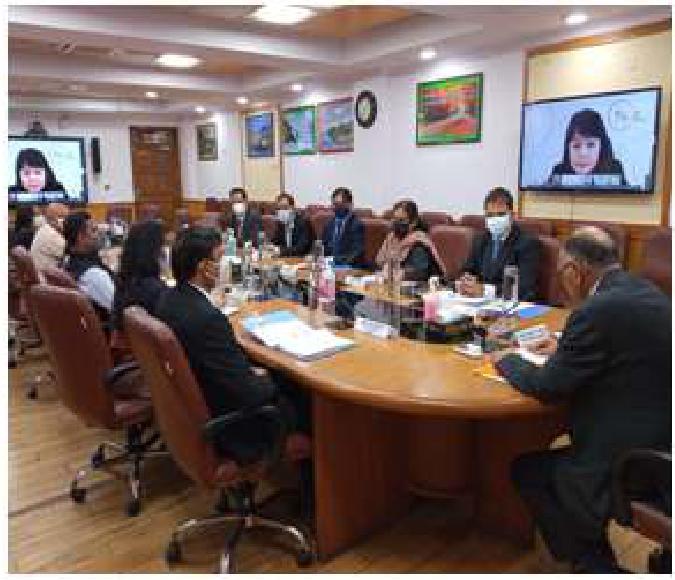
Leaders and Public Officers, Citizen Centric Governance and identified Citizen-centric service delivery and e-Governance as potential areas for future collaboration.
26.4 India Australia Cooperation
26.4.1 A Memorandum of Understanding (MoU) on cooperation in the field of Public Administration and Governance Reforms was signed by the Department with the Australian Public Service Commission (APSC) during India-Australia Virtual Summit held on 4th June, 2020 held between the Prime Ministers of both sides.
26.4.2 The areas of cooperation under the MoU include (i) Promoting transparency and accountability in delivery of public services; (ii) Building effective service delivery in the public service; (iii) Recruitment and promotion in the public service; (iv) Developing a framework for values and competencies; (v) Training and
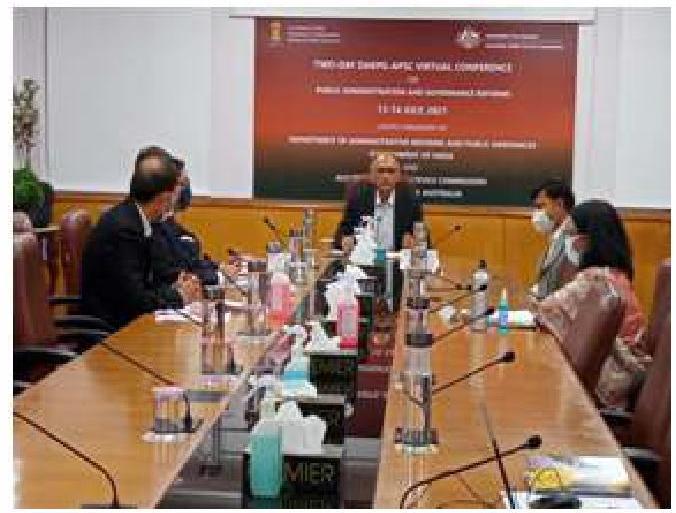
26.5 India-The Gambia Cooperation
A Memorandum of Understanding (MoU) between the Department and the Public Service Commission, Office of the President,
capacity building of the public service; (vi) Public Sector Management and Reform; (vii) Public Grievance Redress Mechanism; (viii) Facilitating short-term foreign training programmes for officers of Government of India or Australia; and (ix) Promoting and utilizing potential of retired government servants.
26.4.3 As part of implementation of the MoU, both sides jointly organized a two-day DARPG-APSC virtual conference on ‘Public Administration and Governance Reforms on 13th – 14th July, 2021. During the conference both sides shared information on areas including Integrity and Accountability, Service Delivery to the Citizens and Administrative Innovations through presentations.
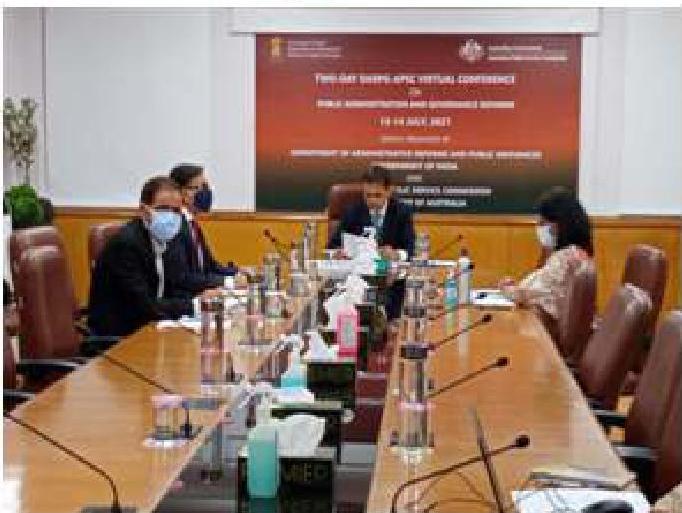
The Gambia was signed on 08th July, 2021 on ‘Refurbishing Personnel Administration and Governance Reforms’.
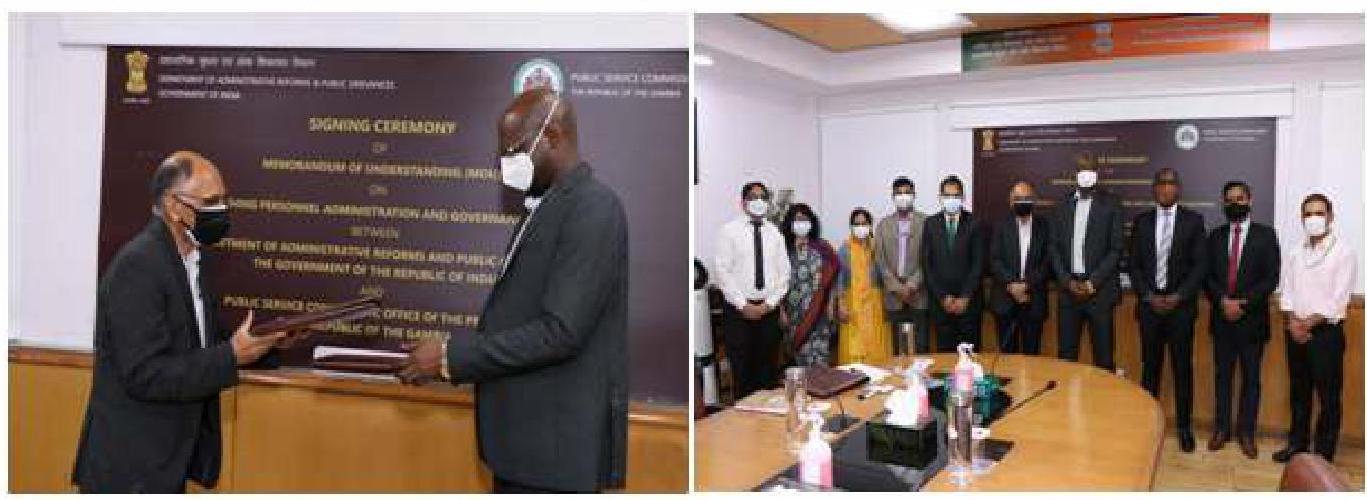
26.5.1 The First meeting of India-The Gambia Joint Working Group (JWG), formed under the MoU, was held virtually between the Department of Administrative Reforms &
Public Grievances and the Public Service Commission of The Gambia on 22nd November, 2021.
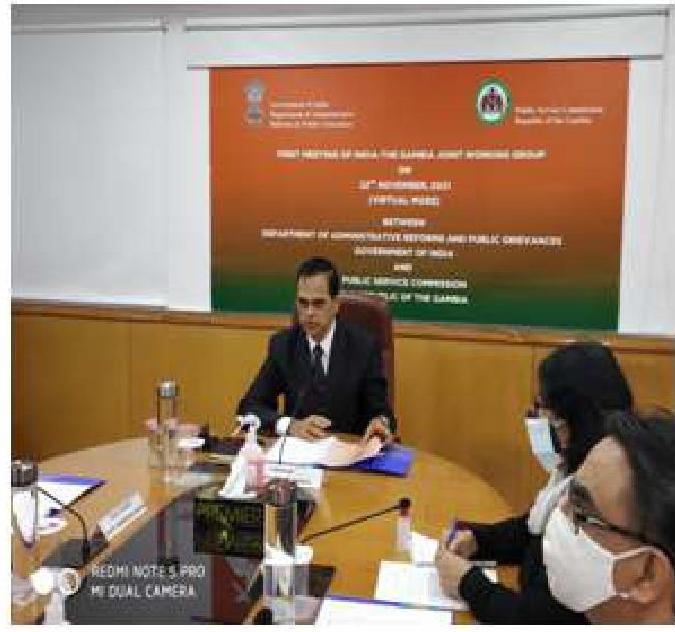
26.5.2 The meeting was co-chaired by Mr. V. Srinivas, Special Secretary, DARPG (now Secretary, DARPG) and Mr. Abdoulie Jafuneh, Secretary, PSC of The Gambia. During the meeting 6 presentations were made by experts from the Indian side on eHRMS, Mission Karamyogi, e-Office, eRecruitment, e-Examination and Pension Reforms including the New Pension Scheme. The wide coverage of the topics by the Indian side was appreciated by Mr. Abdoulie Jafuneh
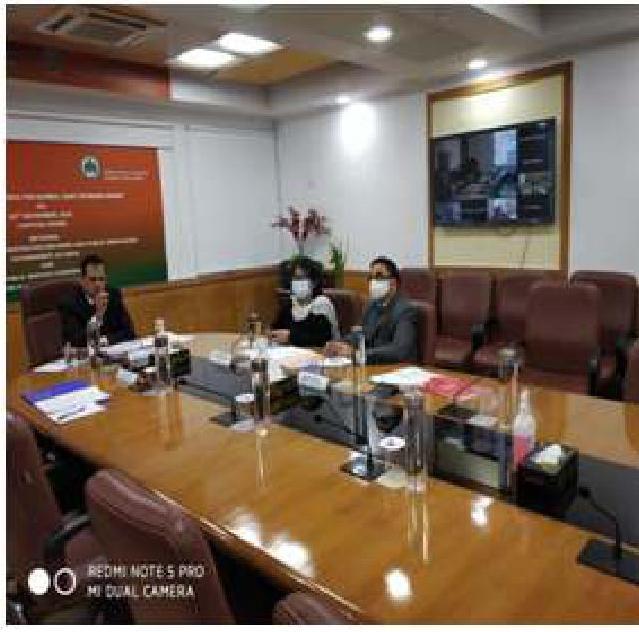
and conveyed that this would immensely benefit The Gambia.
26.6 Apart from the above engagements through the MoUs, an expert panel led by Shri V. Srinivas, Additional Secretary (now Secretary) participated in a webinar on ‘India’s Experience in e-Governance organized by Embassy of India, Khartoum in partnership with National Informatics Centre, Republic of Sudan.
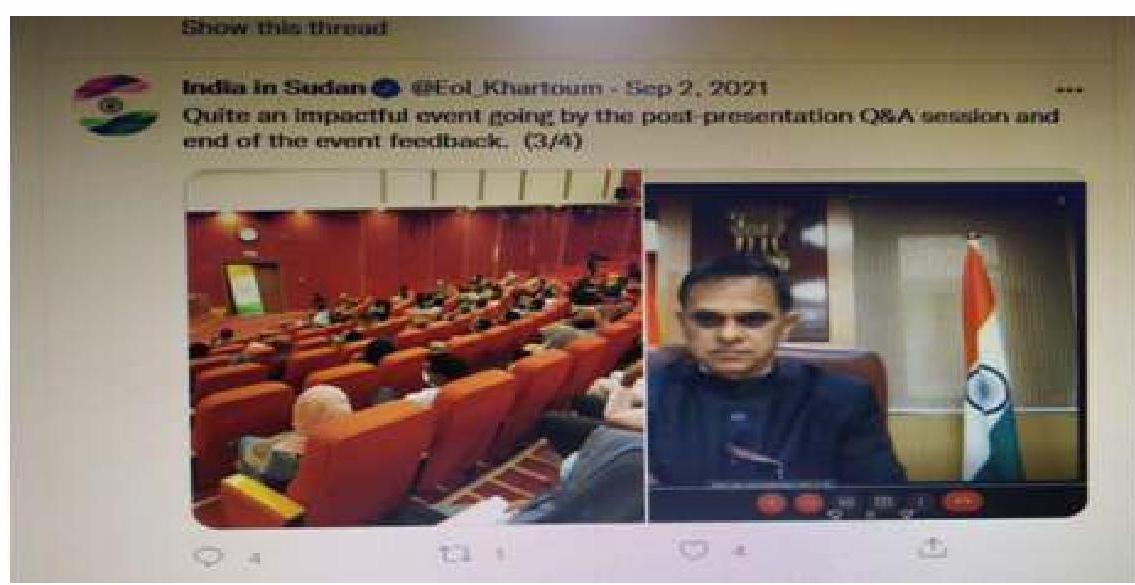
ASSOCIATION WITH MULTILATERAL ORGANIZATIONS IN THE FIELD OF PUBLIC ADMINISTRATION
26.7 Cooperation with International Institute of Administrative Sciences (IIAS)
26.7.1 The Department is an institutional member of the International Institute of Administrative Sciences (IIAS), Brussels, Belgium since 1998. IIAS was established for the purpose of promoting the development of Administrative Sciences, better organization and operation of public administrative agencies, improvement of administrative matters and techniques and for the progress of International Administration. Additional
Secretary (DARPG) is on the Council of Administration of IIAS. At present Shri V. Srinivas, Special Secretary (now Secretary) is member of Council of Administration of IIAS, the highest body in IIAS which ensures the management and direct control of the affairs of the Institute. He is also member of the Finance Committee of IIAS. He was elected for a period of 3 years during the meeting of the General Assembly of IIAS held in Singapore on 18th June, 2019. He has actively participated not only in the meetings of the CoA and the Finance Committee but also in the IIAS Conferences as and when held by IIAS.
CHAPTER 27
DOCUMENTATION AND DISSEMINATION DIVISION
27.1 The Documentation and Dissemination Division of the Department primarily carries out the activities of documentation and dissemination of good governance practices of Central and State Governments and Union Territory Administration with a view to facilitate sharing of experience with one another and replication elsewhere.
1.) Organization of Regional Conferences:
Regional Conferences are organized on specific themes in association with various State Governments with a view to bring National and State level organizations along with other stakeholders to share experiences in the formulation and implementation of good governance practices.
A two-day Regional Conference was organised in collaboration with Government of Jammu & Kashmir on “Replication of Good Governance Practices” at Srinagar, Jammu \& Kashmir on $01^{\text {st }}-02^{\text {nd }}$ July, 2021. Delegates from 10 States/Union Territories participated in the Conference and it was attended by 750 officers through semi-virtual mode, including 250 officials, who attended the conference physically. Conference unanimously adopted the Behtar Nizam-e-Hakumat Kashmir Aelamia after extensive deliberations during the sessions held over two days.
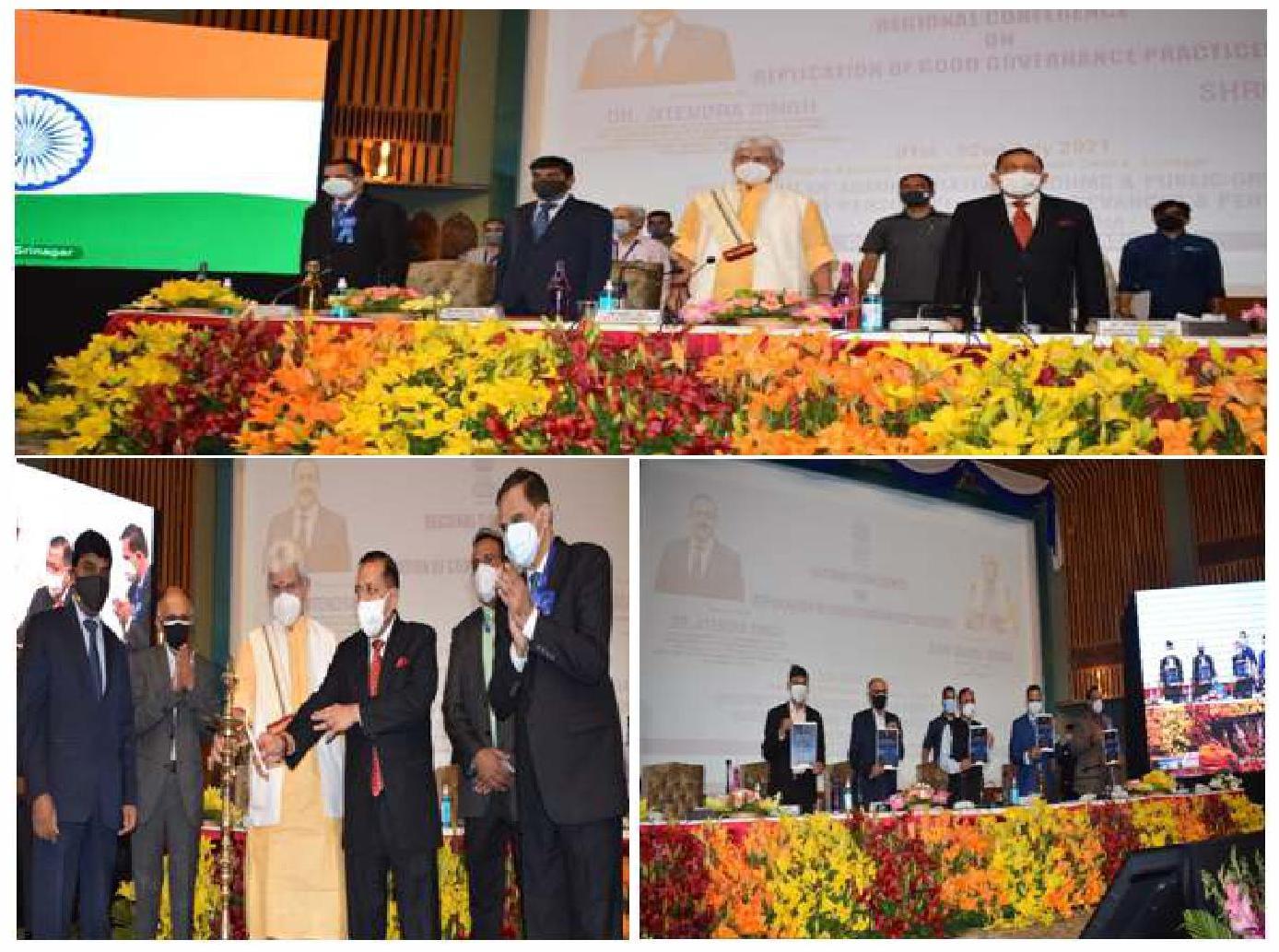
A two-day Regional Conference on “Strengthening of State Institutes of Public Administration” was organized in Lucknow in collaboration with the Govt. of U.P. on November 11th – 12th, 2021. About 95 Delegates from Central Training Institutes and State Institutes of Public Administration including Lal Bahadur, Shastri National Academy of Administration participated in the Conference. The conference was jointly inaugurated by the Hon’ble Chief Minister of Uttar Pradesh and MoS for Ministry of Personnel, Public Grievances & Pensions. The Conference adopted Lucknow Sandesh.
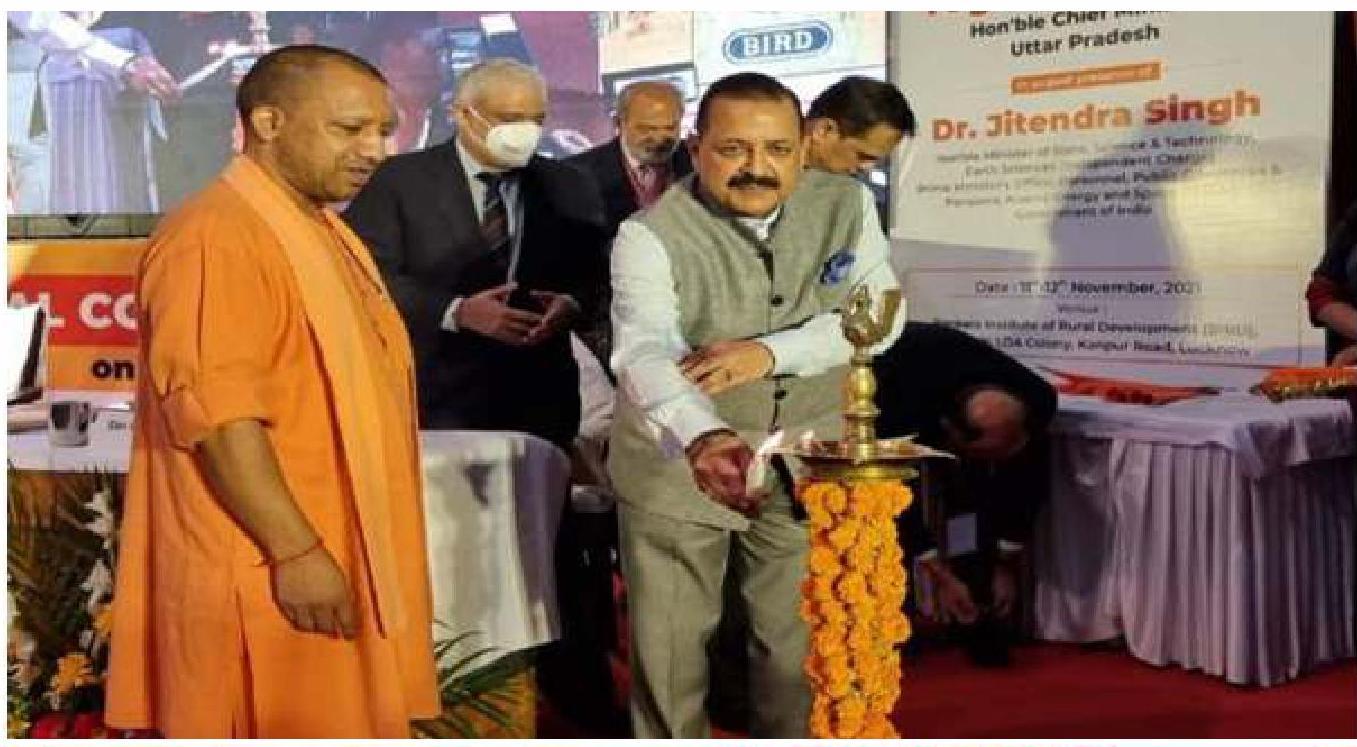
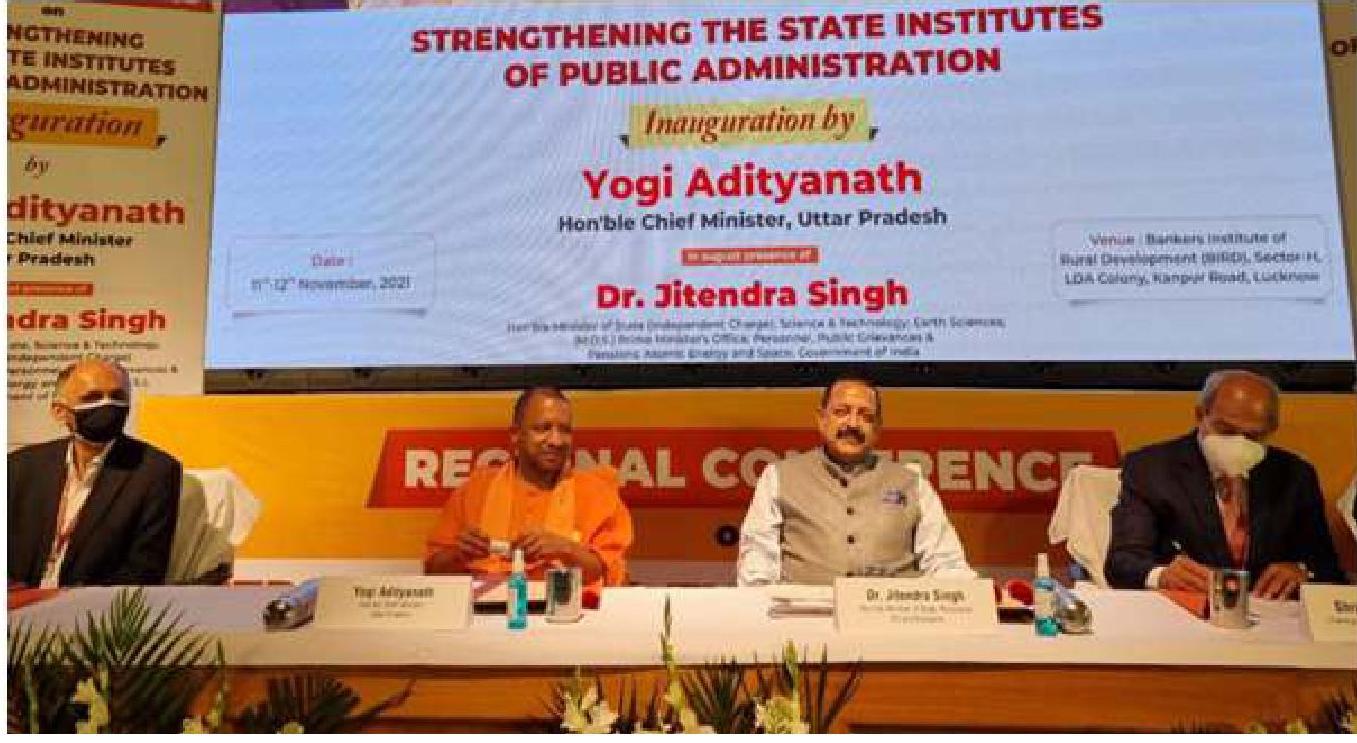
- Regional Conference on the theme ‘Replication of Good Governance Practices” in collaboration with Govt of Odisha at Bhubaneswar, Odisha was organised on December 03rd – 04th, 2021. 14 States of North-Eastern and Eastern Region of India (Arunachal Pradesh, Assam, Meghalaya, Manipur, Sikkim, Nagaland, Mizoram, Tripura, Jharkhand, Bihar, West Bengal, Chhattisgarh and Andhra Pradesh including Odisha) participated in the Conference in a semi-virtual mode.
Shri Navin Patnaik, Hon’ble Chief Minister of Odisha, and Dr. Jitendra Singh, Minister of State (Independent Charge) of the Ministry of Science and Technology; Minister of State (Independent Charge) of the Ministry of Earth Sciences; Minister of State in the Prime Minister’s Office; Minister of State in the Ministry of Personnel, Public Grievances and Pensions; Minister of State in the Department of Atomic Energy and Minister of State in the Department of Space, Government of India addressed the valedictory session.
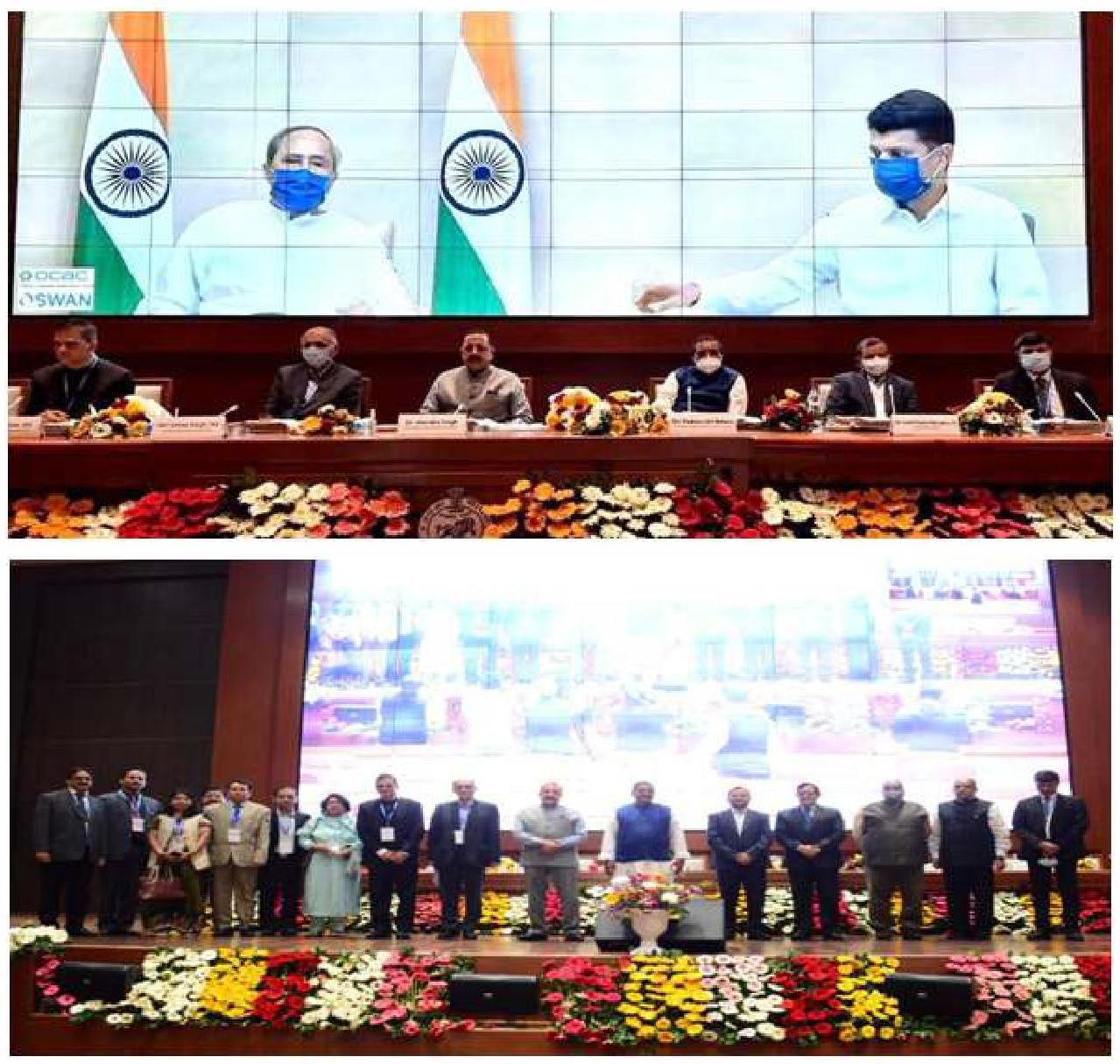
A Symposium on ‘Imagining India @2047 through Innovation’ at Research Park, Chennai was held in collaboration with IIT Madras on 7-9th MARCH, 2022. The symposium was an effort to bring the Government and Citizens together by use of digital technology pursuing next generation reforms and innovations with policy objective of “Maximum Governance, Minimum Government”, entailing Government process Re-Engineering, Universal access to e-services, excellence in digital initiatives at district level and excellence in adopting emerging technologies and use of ICT management. The Government of India is formulating “Vision India@2047” to identify long terms goals and corresponding
short term defined outcomes for this decade with timelines and milestones. The vision is being developed without being constrained by current institutional framework, and suggests appropriate structural and institutional reforms to attain the envisaged vision.
Around 200 participants were chosen for nucleus and cell teams comprising of one IAS officer and Dy. Secretary/Director of Central Ministries/Departments, a young faculty member and a young entrepreneur who sat together for discussion during the symposium. There were 10 such cells. This 4-member nucleus was the basic think-tank during the Symposium and thereafter next twenty years to figure out, how to take India forward.
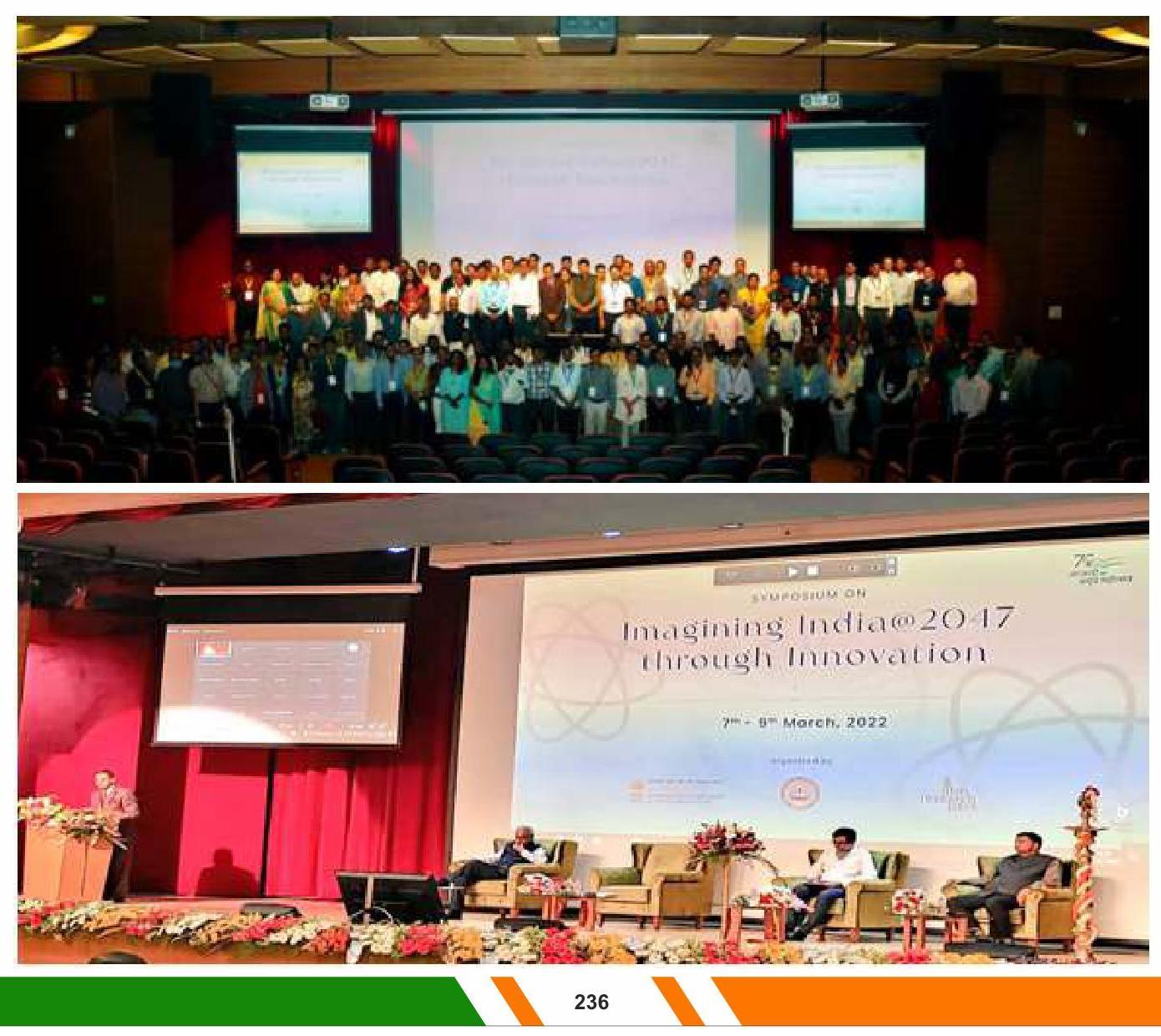
2. Publication of ‘Minimum Government Maximum Governance’ – A biannual eMagazine
The Department of Administrative Reforms and Public Grievances brings out its eMagazine titled ‘Minimum Government Maximum Governance’ (MGMG) as an eBook in its endeavors to document and disseminate successful good governance practices. In the e- Magazine, write-ups based on the shortlisted initiatives of PM Awards and National e- Governance Awards instituted by DARPG have been compiled. It is published on the website of the Department in e-Book form biannually.
- An e-book “Minimum Government
Maximum Governance” Special issue – (July December, 2020) on ‘Success Stories in disposal of Covid-19 Public Grievances and Best Practices in Handling of COVID – 19 Pandemic by Districts’ were released on the occasion of National Workshop / Webinar on Technology Platforms in Public Grievance Redressal held on 18.02.2021.
- Dr. Jitendra Singh, Hon’ble MoS (PP) released the DARPG’s e-book titled ‘Minimum Government Maximum Governance”, (Jan-Jun, 2021) comprising of write-ups on Administrative Innovations during the Inaugural session of Regional Conference held in Srinagar, J&K.
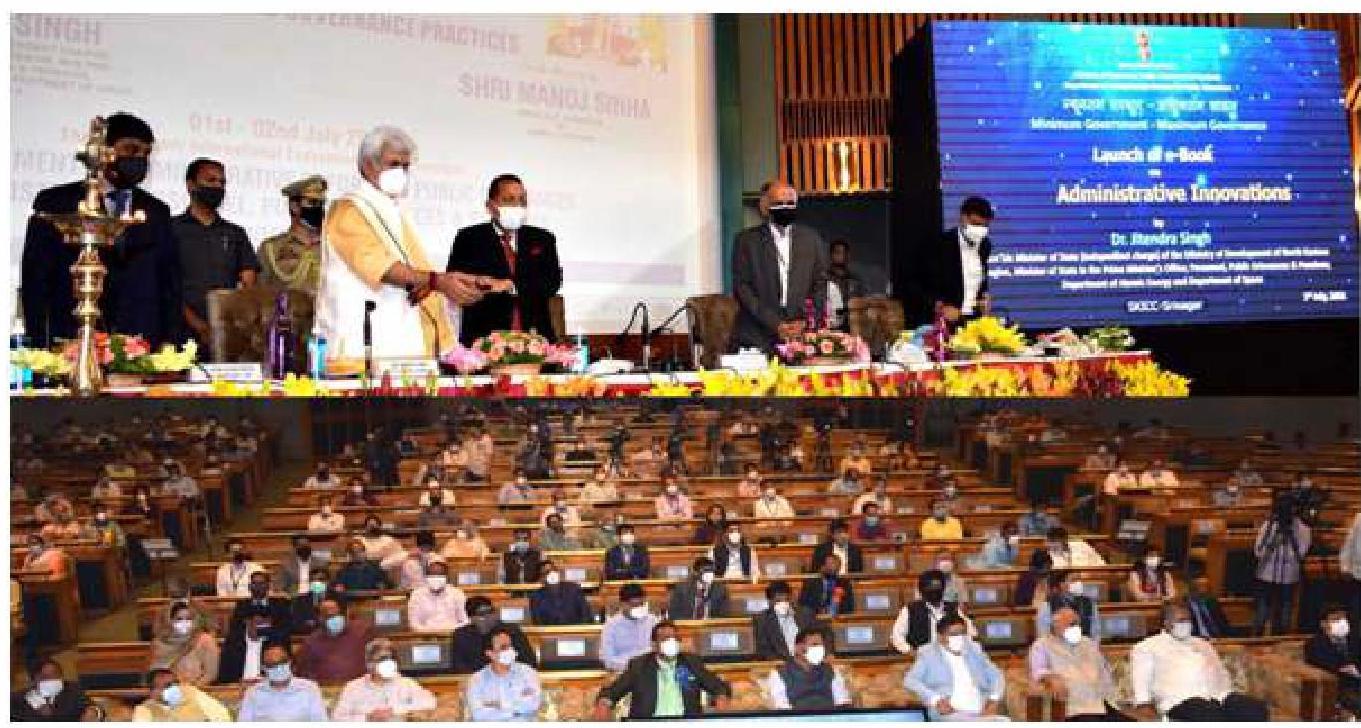
3. Publication of Books
This Division publishes books containing articles on select award winning good governance initiatives. These articles are on the initiatives which were either shortlisted or have been conferred Prime Minister’s Award or National e-Governance Awards. The Division has already published a series of books on the subject.
4. Production of Documentary Films on Best Practices
The Department is engaged in producing documentary films on best practices across the country. These films are immensely useful for the administrators as they facilitate dissemination of success stories and their replication. The films are available on the Department’s website, as well as social media platforms such as twitter and facebook.
5. Release of e-book on Two-Year Achievements of DARPG
Dr. Jitendra Singh, Ministry of Science and Technology; Minister of State
of the Ministry of Earth Sciences; Minister of State in the Prime Minister’s Office; Minister of State in the Ministry of Personnel, Public Grievances and Pensions; Minister of State in the Department of Atomic Energy and Minister of State in the Department of Space,
Government of India released the DARPG’s consolidated achievements from 30th May, 2019 to 30th May, 2021 on the inaugural session of Good Governance Week held on 20th December 2021.
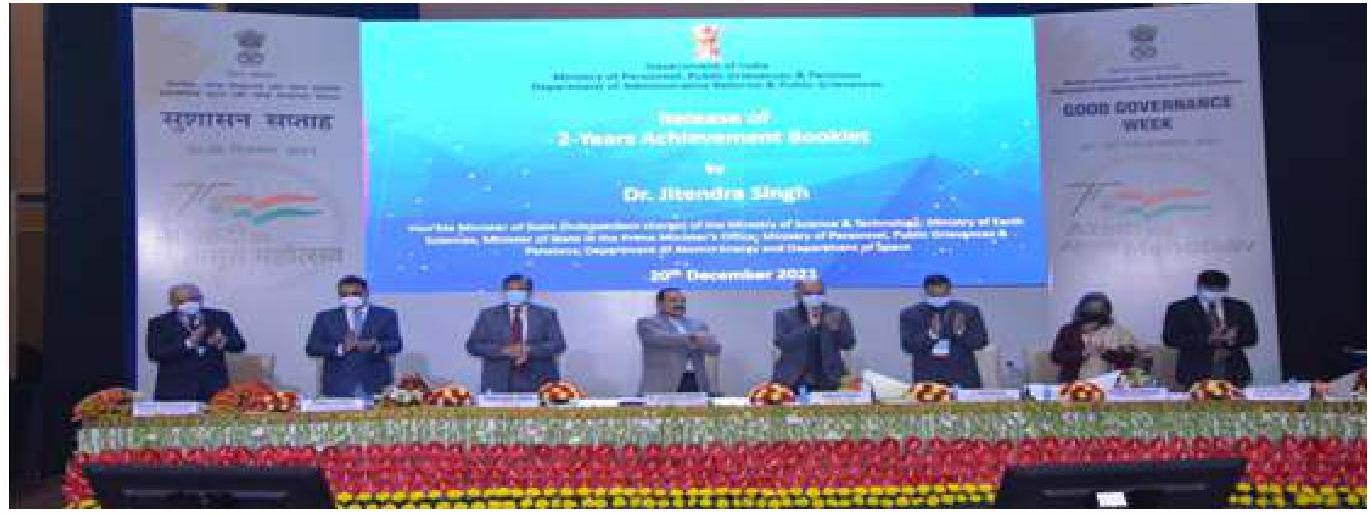
6) Good Governance Week-2021:
Government of India celebrated Good Governance Week (GGW) under the auspices of Azadi ka Amrit Mahotsav (AKAM) during December 20th – 25th, 2021. DARPG as the lead Department had conceived, conceptualized and implemented the programme in collaboration with all Central Ministries and all State Governments /UTs.
Hallmark event of GGW was a weeklong Nationwide campaign on “Prashashan Gaon ki Aur” aiming at resolving public grievances and deliver services to the people at their door step. All Districts in the country participated in
the campaign by holding camps at Tehsils and Panchayats. During the campaign from 20th 25th December 2021 total 380 citizen charters were updated, 621 new services have been added in Citizen Charters, 6.67 lakh public grievances were attended to and 2.89 cr . applications under service delivery were disposed of. The campaign was monitored centrally on a real time basis through a dashboard created for this purpose. All District Collectors and State Nodal Officers were given access to this portal through login credentials to input the information on daily basis.
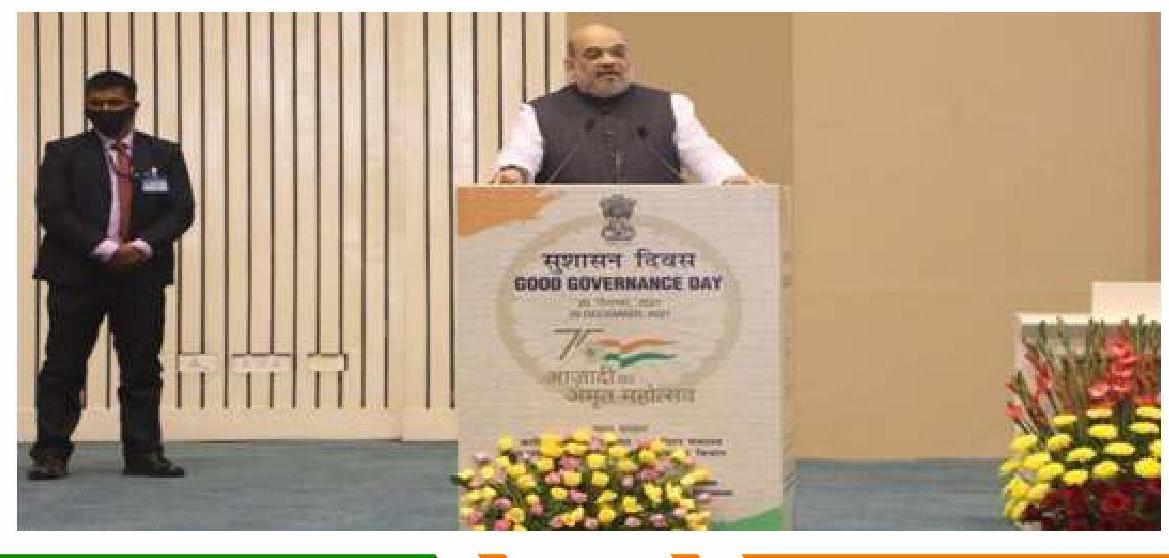
Besides this nationwide flagship campaign, other events were also organized in parallel at Dr. Ambedkar International Centre, New Delhi in collaboration with MEA, DPIIT and DoPT to discuss major governance initiatives. Union Minister for External Affairs Sh. S. Jai Shankar, Minister of Industry & Commerce Shri Piyush Goyal, MoS for the Ministry of Personnel, PG and Pensions, Dr. Jitendra Singh and the Cabinet Secretary attended
these events. An exhibition on the theme “Shasan ki Badalti Tasveer” was also organized to show case achievements of the Government in promoting good governance including achievements made during Special Campaign on the side-lines of events at Dr. Ambedkar International Centre, New Delhi.
CHAPTER
28.1 Hindi Section of the Department of Administrative Reforms and Public Grievance is committed to comply with various guidelines issued by the Department of Official Language to promote the usage of Hindi language in the office.
28.2 The main function of the Section is to render Hindi translation of the works relating to implementation of the official language Policy. These mainly pertain to collating of quarterly reports from various sections of the Department consolidating and furnishing to the D/o Official Language; translation and typing of Parliamentary related work Cabinet/CoS Notes etc. In addition, all the officers/sections are made aware of the guidelines issued from time to time by the D/o Official Language relating to promotion of usage of Hindi and ensure their compliance in the Department as and when required.
28.3 Hindi Pakhwara was organized during September 14th – 28th, 2021 in the Department. During this period, various
competitions on Essay writing, Noting drafting, Hindi Dictation etc. were conducted for which the winners were awarded cash prizes.
28.4 The Department has attended meetings organised by Department of Official Language, Ministry of Home Affairs on various topics regarding implementation of Official Language policy for Ministries/Departments.
28.5 The website of Department of Administrative Reforms and Public Grievances has been updated and made bilingual.
28.6 A meeting of Hindi Salahakar Samiti was organised by the Ministry of personnel, Public Grievances and Pensions on 25.11.2021 at Civil Services Officers Institute (CSOI), K.G. Marg, New Delhi under the chairmanship of Hon’ble MOS (PP) Dr. Jitendra Singh. Secretary, DARPG, Shri Sanjay Singh and then Special Secretary, DARPG, V. Srinivas participated in the meeting.
CHAPTER
29 DEPARTMENT OF PENSION AND PENSIONERS’ WELFARE
29.0 The Department of Pension & Pensioners’ Welfare was set up in 1985 as part of the Ministry of Personnel, Public Grievances and Pensions to formulate policy and coordination of matters relating to retirement benefits of Central Government employees. Being the nodal Department for pension and pension related matters, the Department receives a large number of references from Ministries/ Departments and also renders advice on interpretation of Pension Rules. In 2007, the Department initiated a web-based scheme entitled Pensioners’ Portal- which has now been expanded to run all pension welfare activities of Central Government Pensioners.
29.1 The Allocation of Business Rules broadly allocates the following areas of working to the Department:- Formulation of policy and co-ordination of matters relating to retirement benefits to Central Government employees. The Central Civil Services (Pension) Rules, 1972; the Central Civil Services (Pension) Rules, 2021; the Central Civil Services (Implementation of National
Pension System) Rules, 2021; the Central Civil Services (Payment of Gratuity under National Pension System) Rules, 2021; the Central Civil Services (Commutation of Pension) Rules, 1981; the Central Civil Services (Extraordinary Pension) Rules, 1939; any other scheme relating to Central Government pensioners, entrusted to the Department; pension structure and relief to pensioners; new facilities of fringe benefits to the Central Government pensioners; matters relating to amendment to or relaxation of Pension rules or any other rule concerning retirement benefits; Policy and co-ordination relating to welfare of Central Government Pensioners. Matters with financial implication shall be subject to the concurrence of Ministry of Finance. Action in respect of other matters involving recurring financial implications by way of relaxation or liberalisation of any rule shall be subject to guidelines as agreed to between the Department of Pension and Pensioners’ Welfare and the Ministry of Finance, Department of Expenditure.
29.2 The approximate number of Central Government Pensioners as on 31/03/2021 is as follows:
| S.No | Pensioner/Family Pensioner | Number of Pensioners including Family Pensioners |
|---|---|---|
| A. | Pensioners (incl Family Pensioners) of all Ministries/ Departments under the Accounting jurisdiction of Controller General of Account, M/O Finance. (Central Pension Accounting Office (CPAO), Department of Expenditure, Ministry of Finance is responsible for maintaining the pensioners’ data and incurring expenditure on accounts payment of pension/family pension. Civil Ministries include all the CAPFs viz. BSF, CRPF, Assam Rifles, SSB, CISF, ITBP under MHA as well.) |
11,06,000 $(3,50,000)$ |
| B. | Defence Pensioners (incl Family Pensioners) (The data and accounts etc. of these pensioners are maintained by Controller General of Defence Accounts (CGDA), Ministry of Defence |
$\begin{gathered} 34,10,567 \ (9,36,192) \end{gathered}$ |
|---|---|---|
| C. | Railway Pensioners (incl Family Pensioners) (The data and accounts etc. of these pensioners are maintained by Ministry of Railways) |
$\begin{gathered} 15,54,585 \ (6,59,483) \end{gathered}$ |
| D. | Telecom Pensioners (incl Family Pensioners) (The data and accounts etc. of these pensioners are maintained by Department of Telecommunication) |
$\begin{gathered} 4,67,751 \ (1,16,000) \end{gathered}$ |
| E. | Postal Pensioners (incl Family Pensioners) (The data and accounts etc. of these pensioners are maintained by Department of Posts) |
$\begin{gathered} 3,23,562 \ (99,133) \end{gathered}$ |
| GRAND TOTAL OF PENSIONERS (incl Family Pensioners) | 68,62,465 | |
| GRAND TOTAL OF FAMILY PENSIONERS ONLY | 21,60,808 |
- As per the data received from the CPAO, Defence, Railways, Telecom & Posts
29.3 Pensioners’ Portal:
The scheme, ‘Pensioners Portal’ was started with an objective to serve as a one stop information source for the pensioners of Government of India and also facilitate redressal of their grievances online. With the passage of time, new activities were added under the ‘Pensioners Portal’ which now includes CPENGRAM, Bhavishya, Anubhav and Sankalp etc. with an objective to create a single window system for civil pensioners. Pensioners’ Portal through its website provides pensioners with updated information on pension rules, personalized pension road
map, online calculator for calculation of pension/family pension and redressal of Pensioners’ grievances through CPENGRAM. With effect from 01.01.2017, for ensuring transparency and accurate and timely settlement of pension dues it was made mandatory for all Ministries/ Departments to process pension cases on Bhavishya. Experiences of retirees while working in the government are being preserved in Anubhav which has become a treasure-house of information pertaining to various departments. Sankalp aims to prepare employees for postretirement life.
29.4 BUDGET-
In the year 2021-22, Department has been allocated Rs 1198.00 Lakhs to meet its expenses.
| Secretariat General Service | RE (Rs. in lakhs) |
|---|---|
| Salaries | 650.00 |
| Wages | 1.00 |
| Over Time Allowances | 1.00 |
|---|---|
| Medical Treatment | 25.00 |
| Domestic Travel Expenses | 10.00 |
| Foreign Travel Expenses | 5.00 |
| Office Expenses | 135.00 |
| Publication | 7.00 |
| OtherAdministrative Expenses | 6.00 |
| Minor Works | 12.00 |
| Professional Services | 15.00 |
| TOTAL | $\mathbf{8 6 7 . 0 0}$ |
| Pensioners Portal (Scheme ) | RE (Rs. in lakhs) |
| Salaries | 1.00 |
| Domestic Travel Expenses | 5.00 |
| Office Expenses | 90.00 |
| Advertising &Publicity | 49.00 |
| Professional Services | 156.00 |
| Grants-in-Aid | 28.00 |
| Other Charges | 2.00 |
| Total | 331.00 |
29.5 Strengthening Pensioners’ Grievance Redressal Machinery (CPENGRAM)
- The Department of Pension \& Pensioners’ Welfare (DOPPW) being the nodal department for formulation of policies relating to pension also provides a platform to redress grievances pertaining to pensioners through CPENGRAMS which is an online grievance registration and redressal portal.
- On this portal the pensioners can register their pension related grievances pertaining to any of the Central Government Departments/Ministries, which is then forwarded to the concerned Ministry/Department for redressal within a time frame of 45 days. Time limit for cases pertains to family pensioner and Super Sr. Pensioner (80 years above) is 30days.
- Earlier, pensioners had the option to their grievances registered by sending a mail, post or getting it registered online in the CPENGRAMS Portal. In 2019, Pensioners’ grievance redressal system was expanded with the objective to provide easy access to pensioners in registering their grievances. For ease of lodging grievances, voice call was the simplest of options for many aged pensioners. Especially family pensioners
were not conversant with online technology. Therefore, an Integrated Grievance Cell & Call Centre was inaugurated on 20th June, 2019 for pensioners so that they could register their grievances by calling on the toll-free number 1800-11-1960. The Call Executives register the grievance on CPENGRAMS, after taking inputs from pensioners, and thereafter it is forwarded to the concerned Ministry/Department online for redressal.
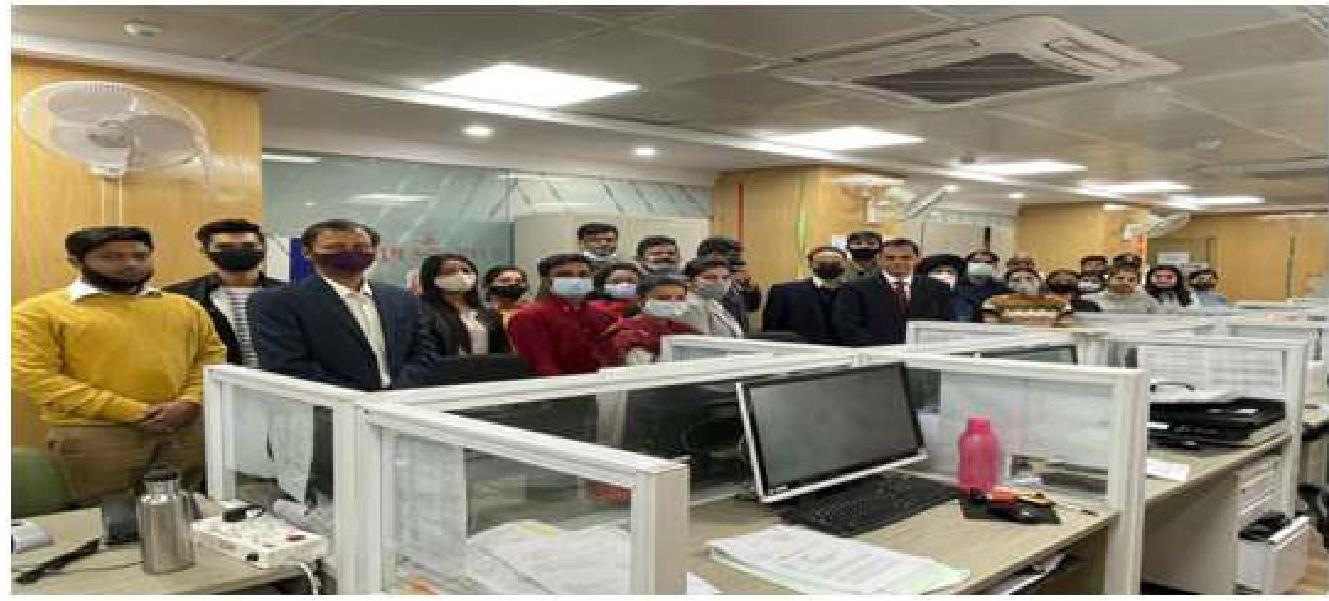
Visit of Secretary (Pension \& PW) to DoPPW Integrated Grievance Cell \& Call Centre at Janpath Bhawan, New Delhi
- This Centre also coordinates with different Ministries/Departments to resolve the problems of the elderly pensioners and keep the pensioners informed about the progress of their grievances.
- It is pertinent to mention that the DOPPW Toll free call center was functional from home during lockdown due to Covid-19 Pandemic. Although the inflow of pension grievances in physical form/postal mail now $6.83 %$ in overall receipts, the number of pensioners/family pensioners using the facility of Call-Centre is increasing continuously and as on 21-1-2022 more than 18400 grievances have been registered by Call Executives since its inception.
- Total number of grievances registered were 62874 from 01.04.2021 to 31.03.2022, out of which 59718 grievances were disposed of ( $94.9 \%$ ). During the period 01.04.2021 to $31.03 .2022,85.6 \%$ grievances were disposed of within 45 days. Out of total registered grievances $78.5 \%$ (approx.) were received online, $13.1 \%$ through call center via the toll free no of DOPPW 1800-11-1960 and $6.9 \%$ by post. Considering, the popularity of the toll-free number and ease of registering grievances, it was felt prudent to continue and expand this facility in future too.
29.6 Pension Adalat:
First ever on-line All India Pension Adalat held in last week of December 2020 and
first week of January 2021 by leveraging technology through Video Conferencing. While holding these Adalats, each Ministry/Department/Organisation were asked to ensure the presence of all concerned stake-holder vizHoD, DDO, PAO and official of concerned Banks at the Pension Adalat from their respective locations through Video Conferencing. Out of 3692 cases taken up, 2591 cases were resolved on the spot by the different Ministries/Departments/ Organisations which participated in this initiative.
29.7 Digitization of Pension Sanction and Payment Tracking System
- During the analysis of grievances registered at CPENGRAMS, it is found that around substantial number of grievances are received due to delay in release of first pension/family pension. Therefore, DoPPW took initiative to achieve complete digitalization of the pension payment process from start to finish, wherein the start is online filling of pension forms by the retiree and the finish is to issue of e-PPO which reaches the Digi-locker
of the Pensioner and credit of the first pension in pensioner’s account.
The ‘Bhavishya’ System
- To overcome the problems of delay & clerical errors in processing the pension cases, duplication as well as financial loss and harassment to the pensioners, the DOPPW introduced, on a pilot basis, a unique innovative centralized pension processing software called ‘Bhavishya’ for all central government Ministries /Departments.
- After a successful pilot, Bhavishya’ was made mandatory for all central civil Ministries and Departments w.e.f 01.01.2017. At present, 96 Ministries/ Departments, 813 Offices and 7751 DDOs are on Board. The ‘Bhavishya’ software was indigenously made by the Department of Pension \& Pensioners’ Welfare and was meant to be a common platform for processing of pension cases by all civil Ministries/Departments of Government of India.
- At a Glance (on 10.01.2022):
| S.no | Items | Numbers |
|---|---|---|
| 1. | No. of Ministries/Departments on-board | 96 |
| 2. | No. of Attached/Subordinate Offices on-board | 813 |
| 3. | No. of DDOs registered | 7751 |
| 4. | No. of pension cases under process | 36710 |
| 5. | No. of cases processed/PPO issued | 146035 |
| 6. | No. of Training programmes | 256 |
| 7. | No. of Participants attended the Training | 7253 |
- This software brought all the stakeholders who were till date decentralized on a single platform. The system laid down a common methodology incorporating all the rules and
regulations of CCS Pension Rules, 1972 (now, CCS (Pension) Rules, 2021) and automatic calculation of pension and other retirement dues.
- From the pay roll/EIS, the ‘Bhavishya’ software was integrated and would auto fill all the data of the retiring employees and at the beginning of the year provide the necessary MIS to the various departments as well as to the DOPPW the number of employees due to retire in the coming year.
- The software has laid down strict timelines for various stages of pension processing across all stakeholders involved. The process starts online 15 months prior to retirement and the pensioner has to fill up a single form once. The system on its own keeps throwing up alerts to the pensioner as well as to the stakeholder for meeting out the deadlines prescribed for various stages.
- Due to the system being digital, there is no duplication of entries and the retiring staff need not leave his office work and run from desk to desk chasing his case. The pension calculation cutting across all Ministries/Departments is accurate since it removes manual intervention. Through this system, any office can directly contact the DOPPW for any clarification, if necessary. It has resulted in saving of huge manpower and time cutting across all Ministries.
- Every department through this software can assess in the beginning of the year the number of retirees and this feature is also visible to DOPPW for all retiring central civil pensioners across Government of India. The system is capable of giving real time data of pension processing of central civil retirees up to the stage of first credit of pension in their respective bank’s accounts.
- The ‘Bhavishya’ process have also been integrated with the PFMS module of CGA and due to this it has now become possible to issue electronic PPOs (e-PPO). At
present, the Data from Bhavishya is being provided/ transferred to PFMS for 485 PAOs. 80199 e-PPOs have been issued till 09.01.2022. The e-PPO is transmitted by the concerned Ministry/Department’s PAO to CPAO from where it goes to the Bank. The paying branch can view e-PPO online. Intimation of credit of first Pension & subsequent monthly Pension is done electronically on real time basis and is also communicated to Pensioner via email/SMS alerts. A link has been incorporated in the Bhavishya system to download the e-PPO by the retirees as well as HOO. - Integration of Bhavishya with Digi Locker – Pensioners have to face innumerable hardship at various stages of their retired life due to misplacement of the original copies of their Pension Payment Order (PPO). Therefore, Bhavishya was upgraded to create a permanent record of PPO in DigiLocker of pensioners. This was a technological leap since now the Central Government Pensioners can store their PPOs in their Digi lockers as a permanent record. 3548 retirees have pushed their ePPOs in DigiLocker till 09.01.2022.
- The ‘Bhavishya’ system has also been made available on a Mobile App, thereby making it simple especially for those Para Military Forces who are out in the fields to keep track of their pension cases.
- As another step towards ‘Ease of Living’ for pensioners, D/o Pension and Pensioners’ Welfare has introduced the facility to download Electronic Special Seal authority (e-SSA). Now the Retiree as well as the Head of Office (HOO) can download the eSSA from the Bhavishya system. It will save Pensioners from undue hardship in getting a copy of their SSA at the time of retirement.
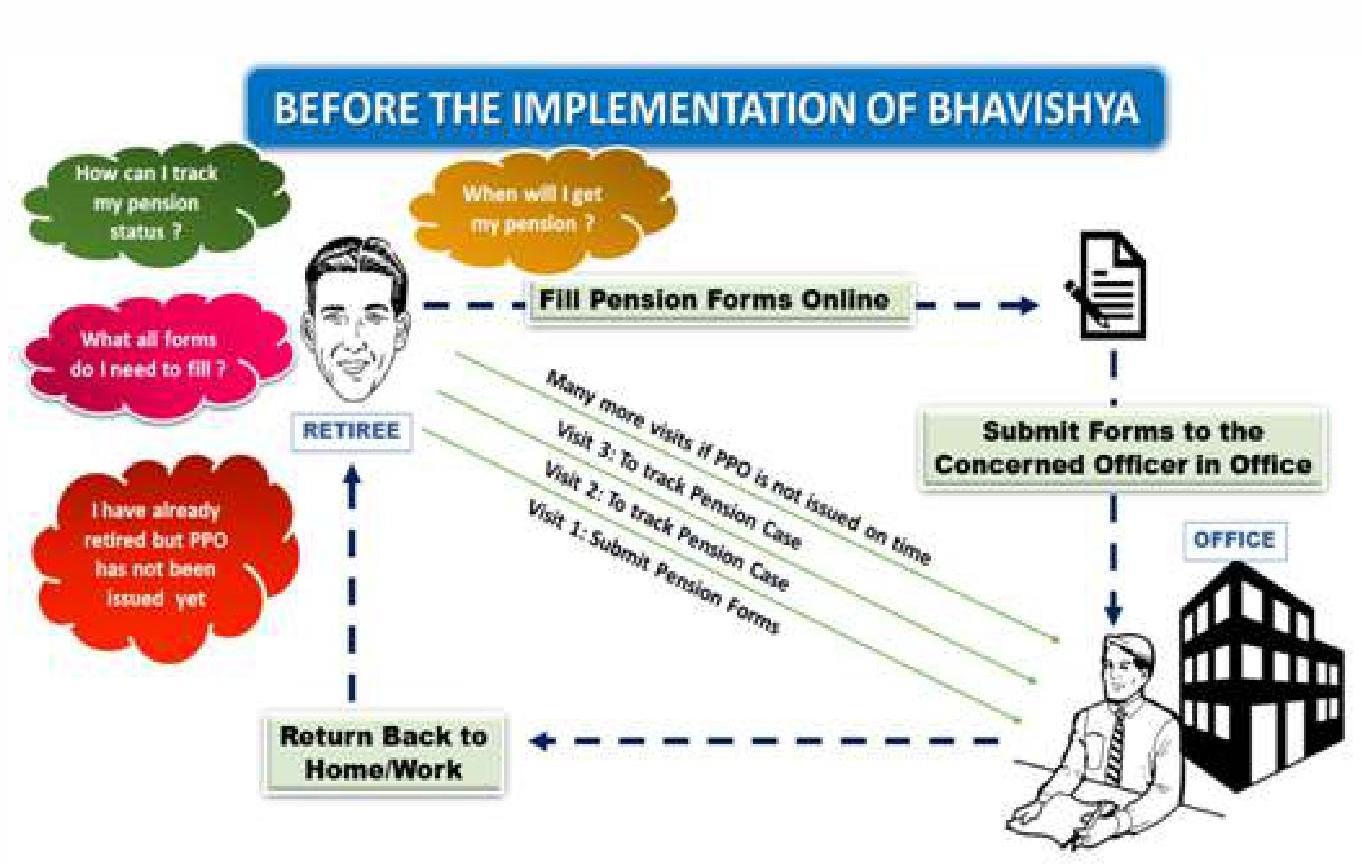
AFTER THE IMPLEMENTATION OF BHAVISHYA
How can I track my pension rates?
- Fill Pension Forms Online
- Submit Forms to the Concerned Officer in Office
Return Back to Home/Work
AFTER THE IMPLEMENTATION OF BHAVISHYA
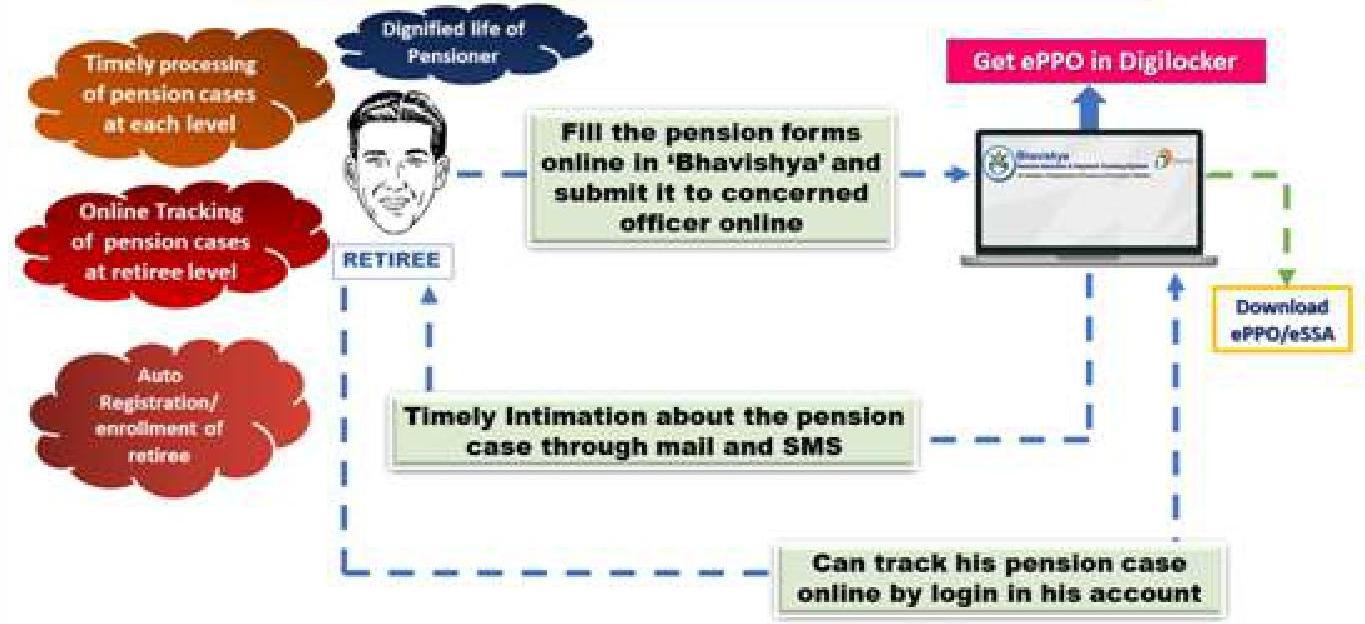
- Coordination with Defence, Railways, Post and Telecom to automate their Pension processing system on the lines of Bhavishya: As per directives of Parliamentary Standing Committee, DoPPW is regularly pursuing with Defence, Railways, Post and Telecom for getting their pension processing system digitized on the pattern of ‘Bhavishya. As of now, digitization has taken momentum in these establishments. M/o Defence after introduction of Suvigya Portal, DoT with SAMPANN Portal, Railways with ARPAN software and D/o Posts have made considerable headway in digitization of the pension settlement of their employees. DoPPW is also working towards bringing the Defence, Railways, Post and Telecom on the Department’s Dashboard in order to get regular updates on the number of retiring persons in their respective establishments.
- Real-time monitoring for settlement of family pension claim in CAPF: All the CAPFs viz. BSF, CRPF, CISF, ITBP, Assam Rifles and SSB come under MHA and CCS (Pension) Rules, 1972 (now, CCS (Pension) Rules, 2021) are applicable to them. With a view to curtail the time lag between the date of death in any CAPF and settlement of family pension, a real-time monitoring Dashboard was made functional w.e.f. February 2020 through
which the status of delay in family pension can be monitored and reminders sent to MHA to take action on expeditiously starting the family pension. - To the commemoration of Bharat ka Azadi ka Amrut Mahotsav India@75, the Department of Pension and Pensioners’ Welfare has imparted training on Bhavishya (online Pension Sanction Module) to 75 Government of India offices.
29.8 Creating awareness on pensioner’s entitlements and Rules:
Providing access to information is an important tool to empower the people, therefore, DoPPW has adopted a policy of spreading awareness amongst the targeted groups on instructions issued time to time and entitlements through workshop and various available medium such as electronic, print and social media. Since Social Media has emerged as a powerful participatory medium of communication in recent times, therefore, DoPPW has adopted a gradual shift towards spreading awareness amongst the targeted groups through social media such as Facebook, Twitter and Documentary films, YouTube etc. The Department has also been creating awareness through SMSs which are sent directly on the Mobile Phone of pensioners. This has resulted in creating greater awareness in the targeted group at minimal costs.
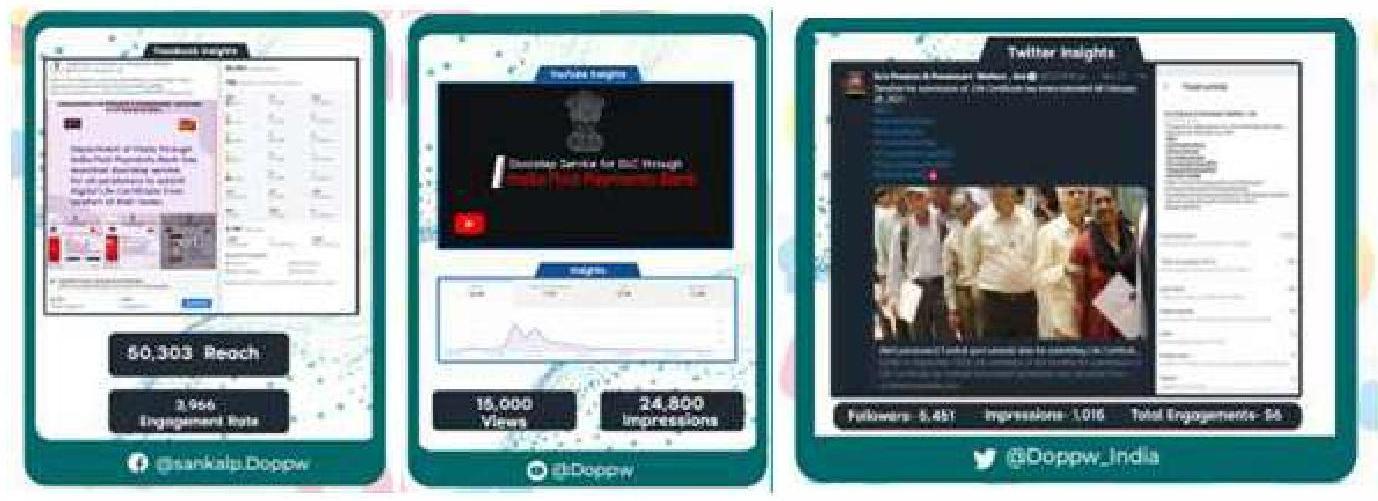
29.9 JEEVAN PRAMAAN:
- Every year in the month of November a pensioner is required to produce life certificate for further continuation of his pension. Pensioners can submit life certificate by physically presenting themselves before pension disbursing authority i.e banks or can send a certificate issued by gazetted officer or the other designated authorities.
- Due to infirmity or other ailing elements of pensioners in old age, this manual system needed improvements. Pensioners have to wait outside the bank branches in long queues for submission of Life certificate. Sometimes due to non -updating of Life Certificate record in the banking system by the concerned staff, the pension is stopped even though the pensioner had visited the bank branch or submitted Life Certificate. There was no mechanism for pensioners to get updated status and abruptly the pension stopped on account of non- receipt of Life Certificate. Keeping in view the concerns of senior pensioners and discomfort faced by them in the manual process, it was felt necessary to streamline the process and initiate Door Step Service for submission of Life Certificate.
- In November, 2014 an Aadhar based scheme for online submission of digital life certificate JeevanPramaan was launched by the Hon’ble Prime Minister with the object to facilitate pensioners to submit life certificate anytime and from anywhere.
- In 2018, DoPPW started a Pilot Programme DLC from home campaign with the assistance of Pensioners’ Associations. The objective of the campaign was to extend support to the aged and infirm pensioners in submission of Life certificate digitally from home. Around 2500 DLC were successfully created by pensioners Associations in 7 cities.
- In October-November 2019, this project was expanded to cover 24 cities i.e.Hyderabad, Ranchi, Bhuvneshwar, Jaipur, Thrissur, Kolkata, Cuttack, Chennai, Guwahati, Madurai, Balasore, Jalandhar, Ahmedabad, Prayagraj, Pune, Dehradun, Mumbai, Bengaluru, Vadodara, Trivandrum, Mysore, Chandigarh, Noida, Delhi. In year 2019, around 4100 DLCs have been collected from such pensioners by the above Pensioners Associations.
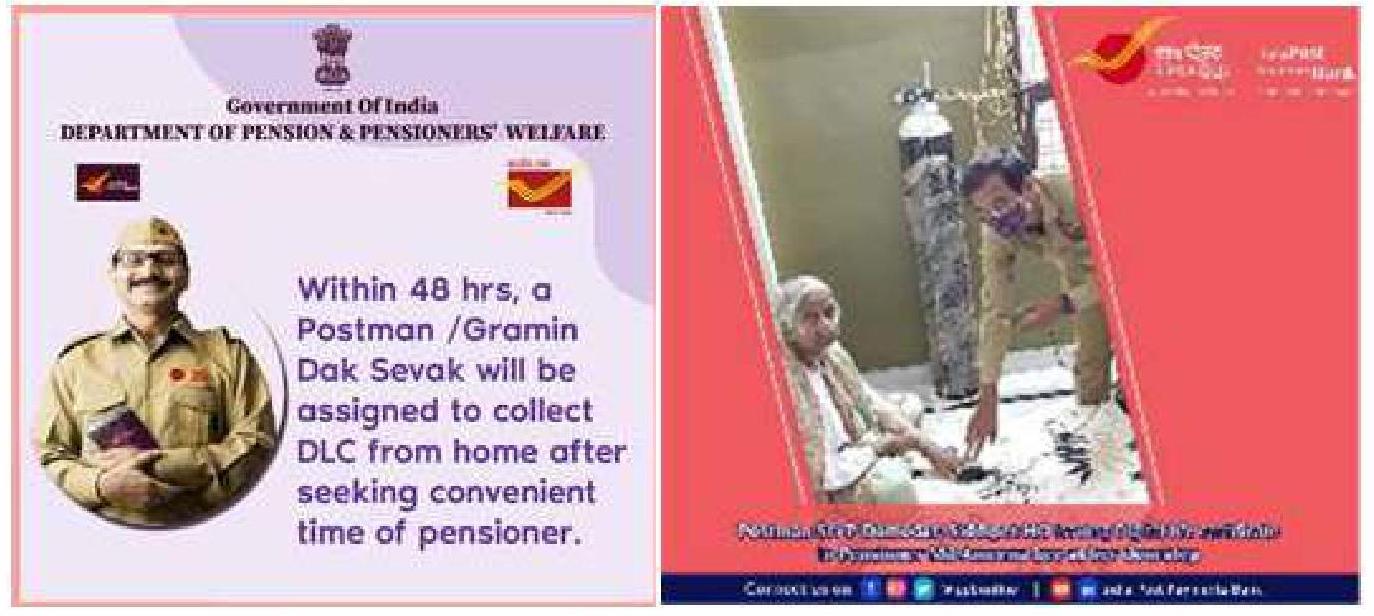
- With a view to make Doorstep Services for submission of Life Certificate available to all pensioners across the country, DoPPW roped in the India Posts and Payment Bank (IPPB) under the Department of Posts for Digital Life Certificate. The IPPB has started Doorstep Service in November, 2020 through its huge network of 1,89,000 Postmen &GraminDakSevaks. Thus the major initiative of DoPPW, viz. DLC from Home has reached every nook and corner of the country. This has come as a source of great comfort to Pensioners, especially those residing in rural areas.
- After the coordination with Public Sector Bank Alliance (PSB), the service for collection of Life Certificate has been brought under the umbrella of Doorstep Banking Service. Now pensioners can submit Life Certificate by calling Banking agents at their home. This facility is presently available in 100 cities.
- In order to address the inconvenience faced by senior pensioners in submission of Life Certificate digitally due to noncapturing of their finger bio-metrics, DoPPW issued OMs dated 11.09.2020 and 23.11.2020, DoPPW and advised all the Pension Disbursing Banks to adopt the Video based Customer Identification Process (V-CIP) as an additional facility for
obtaining a Life Certificate from the pensioners, within permissible RBI guidelines. UCO Bank has become a pioneer in this area and started video-based life certificate for their pensioners. Most of the Banks viz State Bank of India, Punjab National Bank have adopted video-based life certificate for their pensioners. - Face Authentication Technology has been launched by the Hon’ble Minister of State (PP) on 29th November 2021 with a view to enhance ease of submission of Digital Life Certificate by pensioners. Through this App any Pensioner can give a Digital Life Certificate from the comfort of home using any Android mobile without attaching any biometric device or other device. The above technology is a milestone in leveraging technology for the purpose of Life Certificate. As per this facility, the identity of a person will be established through face authentication technique. Pensioners can capture their live photo using any Android based smart phone and submit it online. It is authenticated by the UIDAI server, and the DLC will get generated. This Technology will reduce the dependence of pensioners on external bio-metric and make the process of LC submission more affordable by enabling pensioners to submit their LCs from the comfort of their homes.
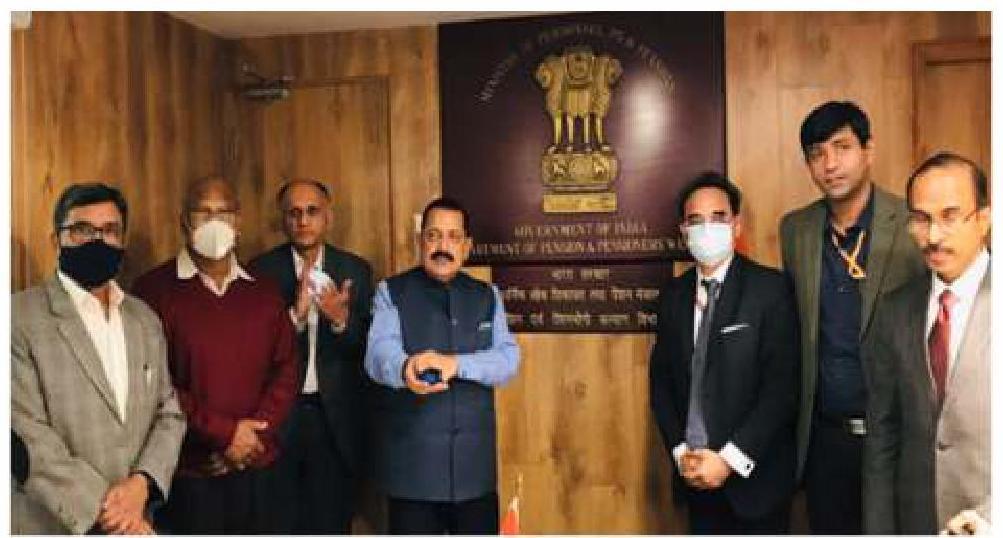
Face Authentication Technology – Launched by Hon’ble MoS(PP) at DoPPW, Lok Nayak Bhawan, New Delhi
- The Face Authentication Technology has been given wide publicity on social media viz. Youtube, Facebook, Twitter etc. Now, a proposal has been initiated to advertise this technology through print media in English, Hindi and Regional lanuates newspapers for the benefit of pensions especially for those who are residing in semi-urban and rural areas, the advertisement of this technology will be beneficial to them.
- In addition, the Department tackled a small but often neglected percentage of Pensioners living abroad and gave instructions to the Ministry of External Affairs, that all the Indian Embassies/High
Commissions/Consulates devise a methodology for endorsing Life Certificates and also to the International Banking Divisions of Pension Disbursing Banks to facilitate Life Certificate of such Pensioners.
- Keeping in view the difficulties faced by very senior citizens aged 80 years and above, an exclusive window from October 1 onwards, has been provided to them to avoid the major rush from 1st November onwards. In view of the pandemic and with the objective of avoiding crowds in the Pension Disbursing Banks, the timeline for submission of Life Certificate has been extended till February 28, 2022.
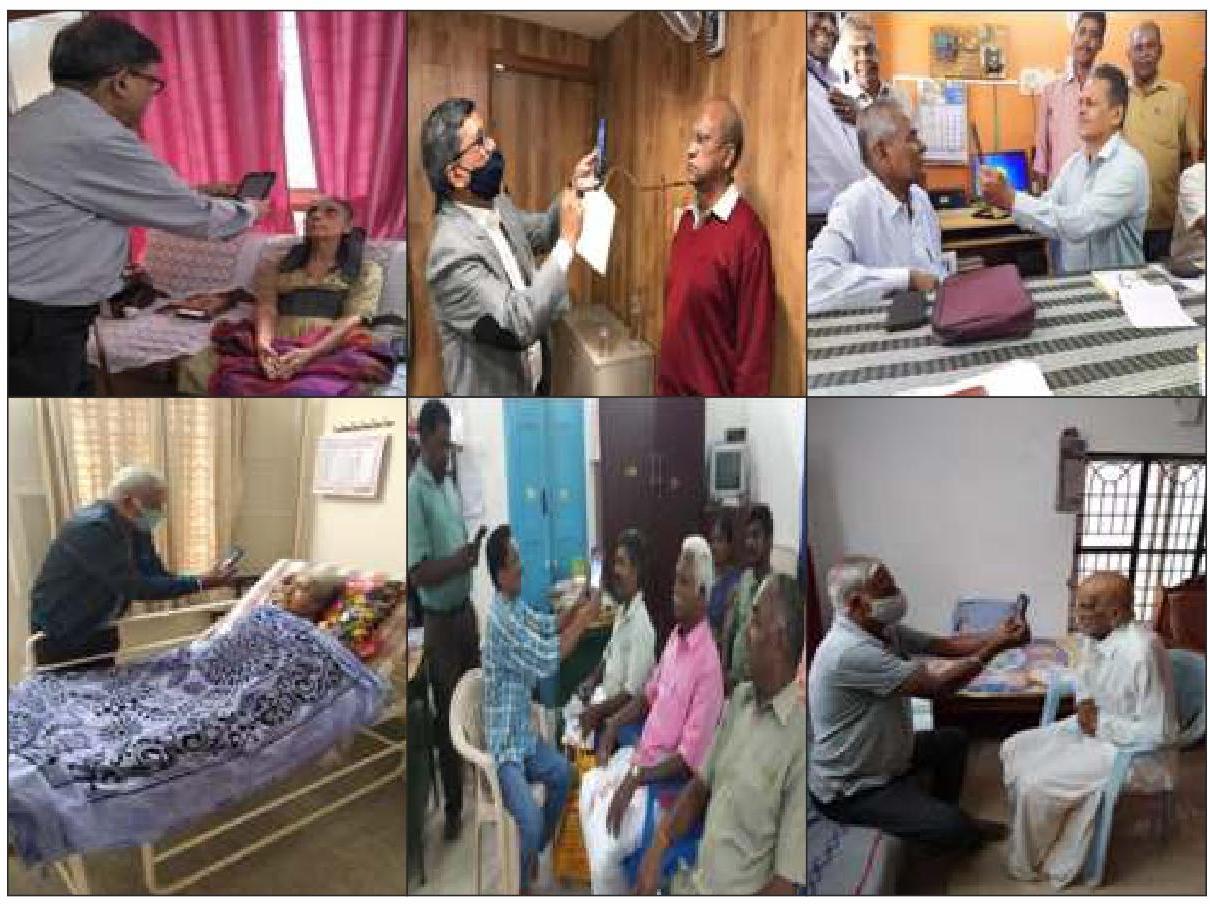
Pensioner’s Association facilitating DLC of Aged/Sick pensioners from their home.
29.10 Important Policy decisions.
Central Civil Services (Pension) Rules, 2021
The Central Civil Services (Pension) Rules, 1972 were notified around 50 years ago.
The pensionary benefits in respect of civil Central Government employees appointed before 1.1.2004 (which include pension and retirement gratuity on retirement and
family pension and death gratuity on death of a Government servant) were regulated by the Central Civil Services (Pension) Rules, 1972. The employees appointed on or after 1.1.2004 are covered by the National Pension System, a defined contribution based pension scheme administered by Department of Financial Services.
- During the last around 50 years, a number of amendments to these rules were notified and several Office Memoranda, instructions, etc. were issued from time to time, interpreting and clarifying different provisions of these Rules. Since such instructions and clarifications did not form part of the statutory rules, there was a lack of uniformity in their implementation by the various implementing authorities.
- The Government, therefore, decided to rationalise these rules and to bring out a revised version of the pension rules. The task of review and revision of the Central Civil Services (Pension) Rules was also included in the strategic initiatives undertaken on the recommendations of the Sectoral Group of Secretaries (SGoS), being monitored by the Cabinet Secretariat/ PMO.
- The draft of the revised Rules, along with a detailed statement bringing out justification for the changes proposed in the existing provisions was prepared for examination/ deliberation/ improvement by the Groups of officers constituted in the Department. The draft rules were further discussed, clause by clause, in various meetings held in the Department.
- The draft of the revised Rules, as finalised after detailed deliberations, was, thereafter, circulated to the concerned Departments i.e. Department of Personnel & Training, Department of Expenditure, Office of Controller General of Accounts and Ministry of Housing \& Urban Affairs. The inputs/comments received from these Departments, were suitably incorporated in the draft revised Rules and these Rules
were given a final shape. After vetting of the draft Central Civil Services (Pension) Rules in Hindi and English, the notification of the new Central Civil Services (Pension) Rules, 2021 has been issued in the Gazette of India vide GSR 868(E) dated 20.12.2021. These new rules have become operational on the date of publication in the Gazette of India i.e 20.12.2021. With the commencement of these Rules, the Central Civil Services (Pension) Rules, 1972 stand repealed.
National Pension System (NPS)
- National Pension System (NPS) was introduced for Central Government employees w.e.f. 01.01.2004 vide Ministry of Finance (Department of Economic Affairs) Notification No. 5/7/2003-ECB \& PR dated 22.12.2003 for all new recruits joining the Central Government service (except armed forces) from 01.01.2004. On introduction of the NPS, among others, the Central Civil Services (Pension) Rules, 1972 and the Central Civil Services (Extraordinary Pension) Rules were amended on 30.12.2003. Accordingly, the benefits of old pension scheme are not admissible to the Government servants appointed on or after 01.1.2004, under the amended rules.
- Instructions have been issued vide OM No. 57/4/2019-P\&PW(B) dated 17.02.2020 by Department of Pension and Pensioners’ Welfare providing that in all cases where the results for recruitment were declared before 01.01.2004 against vacancies occurring on or before 31.12.2003, the candidates declared successful for recruitment shall be eligible for coverage under the Central Civil Services (Pension) Rules, 1972. Accordingly, such Government servants who were declared successful for recruitment in the results declared on or before 31.12.2003 against vacancies occurring before 01.01.2004 and covered under the National Pension System on joining service on or after 01.01.2004, may be given a one-time
option to be covered under the Central Civil Services (Pension) Rules, 1972. Further, clarifications were issued vide OM dated 25.06.2020 to clarify major doubts raised by Ministries / Departments with respect to instructions issued in OM dated 17.02.2020.
- This OM stipulates time schedule for different activities to be undertaken in accordance with the instructions. All the procedure was to be completed by 01.11.2020. However, keeping in view the covid pandemic, these dates were extended vide OM dated 31.03.2021 for further one year.
- In compliance to the recommendation of the Committee constituted for suggesting measures for streamlining implementation of National Pension System, Department of Pension and Pensioners’ Welfare in consultation with other concerned Ministries / Departments notified Central Civil Services (Implementation of National Pension System ) Rules, 2021 on 31.03.2021 for regulating service related matters for Central Government employees covered under NPS. These rules includes, applicability of NPS, general conditions, emoluments, contribution, provision for interest on delayed contribution, provision for option to choose benefits under old pension scheme or National Pension System in the event of death of Government servant or his discharge from service on invalidation or disablement, provision for Voluntary retirement, treatment of resignation, removal/ dismissal from service, compulsory retirement and absorption in corporation or body etc.
- Department of Pension and Pensioners’ Welfare vide O.M. No. 7/5/2012P&PW(F/B) dated 26.08.2016 had extended the benefit of retirement gratuity and death gratuity to the Central Government employees covered under NPS on the same terms and conditions as are applicable under CCS(Pension) Rules, 1972.
- Further, vide DoPPWO.M. No.7/5/2012P\&PW(F/B) dated 12.02.2020 instructions had been issued for counting of service for the purpose of grant of gratuity or grant of pro-rata gratuity in case of mobility of a Central Government employee to other organizations through proper channel.
- Now, Department of Pension and Pensioners’ Welfare in consultation with other concerned Departments, have notified Central Civil Services (Payment of Gratuity under National Pension System) Rules, 2021 on 24.09.2021 for regulating grant of retirement gratuity and death gratuity to Central Government employees covered under NPS.
- Instructions have been issued in respect of Government employee appointed on or after 01.01.2004 and covered under NPS is disabled, he shall also be eligible to receive a lump sum compensation computed in terms of rule 9(3) of CCS (EOP) Rules, if the disablement is attributable to Government service and the Government employee is retained in service in spite of such disablement. (OM No 1/3/2019-P\&PW (F) dated 01.01.2021)
- Instructions have been issued regarding revising the income criteria for eligibility of family pension, keeping in view of special needs of a child suffering from a disability that the child of a deceased Government servant/pensioner, suffering from a mental or physical disability, shall be eligible for family pension for life, if his/her overall income from sources other than family pension is less than the entitled family pension at ordinary rate and the dearness relief admissible thereon, payable on death of the Government servant/pensioner concerned (OM No 1/17/2019-P\&PW (E) dated 08.02.2021).
- Instructions have been issued regarding person eligibility to receive family pension (e.g. spouse) on death of a Government servant/pensioner who is charged of murdering the Government servant/pensioner, the family pension was
suspended till the conclusion of criminal proceedings and the payment was not even made to other eligible family members (e.g. children). The Rule has been amended to allow payment of family pension to other eligible family members such as children in such cases, till the conclusion of criminal proceedings (OM No 1/24/2019-P&PW (E) dated 16.06.2021).
- Instructions have been issued for payment of ex-gratia lump sum compensation to a member or members of the family in whose favour a nomination is made by the Government servant during service in the Common Nomination Form (Form-1), on death of a Government servant in the performance of bonafide duty. Form-1 has been amended suitably to include nomination for ex-gratia lump sum along with nominations for gratuity, GPF and CGEGIS. (OM No 1/7/2017-P\&PW (F) dated 30.09.2021).
- Instructions have been issued for determination of Pay/Emolument for calculation of family pension and death gratuity where a Government servant dies during currency of a penalty on expiry of which he would have regained the same pay which he would have drawn if the penalty had not been imposed on him, the family pension and death gratuity in respect of such Government servant shall be determined based on the notional pay which he would have been entitled to on the date of death and such notional pay may be treated as emoluments for this purpose. (OM No 1/15/2020-P\&PW (E) dated 09.12.2021)
- Department of Pension \& Pensioners’ Welfare has issued instructions vide its OM No. 3(8)/2021 P\&PW (H) dated 16.06.2021 to the Pension Disbursing Banks bringing out the minimum essential details/documents (like death certificate, proof of age/date of birth of applicant) which are to be obtained by the Banks from the applicant for commencement of family pension on death of pensioners drawing
pension from those Banks. They have been advised not to ask for any details/documents, including the details of other members of the family, which are not relevant for commencement of family pension to the applicant. The Department has advised the Banks to conduct special awareness programmes for sensitizing the concerned officers and staff of the CPPC(s) and the branches of the Banks for a compassionate handling of the family pension cases and to submit a half-yearly statement on the progress of sanction of family pension, in the months of April and October every year. - Department of Pension \& Pensioners’ Welfare have issued instructions vide its OM No 1(4)/2021 P\&PW(H) dated 22.06.2021 to all Pension Disbursing Banks for issuing pension slip to pensioners after credit of pension on their registered mobile numbers through SMS and email (wherever available) also. Banks may also use social media apps WhatsApp etc. in addition to SMS and Email. The pension slip should provide complete details of monthly pension paid along with break-up of the amount credited and tax deductions etc.
- After the Third party evaluation done by Indian Institute of Public Administration (IIPA), DoPPW has issued O.M. No 20(1)/2020-P\&PW(H)-6884 dated 09.08.2021 for continuation of the scheme “Pensioners’ Portal” beyond 31st March, 2021 for next five years till 31st March, 2026.
- Keeping in view the onset of time to give Life Certificates this year, DoPPW reiterated instructions, vide its O.M. No. 1(8)/2021-P\&PW(H), dated 20.09.2021, to all Pension Disbursing Authorities and (PDAs) and for information of pensioners/family pensioners about various methods available to a pensioner for submission of Life Certificate.
- DoPPW issued instructions vide its O.M. No. 1(8)/2021-P\&PW(H), dated 22.09.2021, regarding various methods for
submission of life certificate by pensioners /family pensioners residing abroad.
29.11 Miscellaneous:
- A vaccination drive was conducted at Lok Nayak Bhawan, Khan Market New Delhi110003 on 05.06.2021 for the officers and staffs of DoPPW those aged 45 and above.
- A Special Covid-19 Vaccination Drive was also conducted at Civil Services Officers’ Institute (CSOI), Vinay Marg, Chankyapuri, New Delhi-110021 on June 17, 2021 in the presence of Hon’ble MoS(PP) for the officers, staff and their families of DoPPW and DARPG and (in the age group of 18-44 years).
- Regular sanitization of the Department was ensured so that no incident of COVID-19 happens in the Department with special emphasis on toilets and common areas. Sanitization machines were installed in the Department.
– Dearness Relief to Pensioners/Family Pensioners:
Revised rates of Dearness Relief (DR) to Central Government Pensioners/Family pensioners on implementation of decision taken on recommendation of 7th CPC are admissible at following rates:-
| Date from which payable | Rate of Dearness Relief per month |
|---|---|
| From 01.07 .2021 | $31 %$ of Basic Pension/Family Pension |
- Dearness Relief for the period from 01.01.2020 to 30.06 .2021 shall remain at $17 \%$.
- For the convenience of all Ministries /Departments and Banks/Treasuries/Post Offices, orders are hosted on the website of this Department. This facilitates faster payment of enhanced DR by Pension Disbursing Authorities.
The process has been streamlined to ensure that enhanced DR orders are issued with a minimum time lag with reference to the orders for enhancement of DA. - Standing Committee of Voluntary Agencies (SCOVA)
Standing Committee of Voluntary Agencies (SCOVA) has been reconstituted vide this Department’s Resolution dated 25.01.2021. - Posters of Do’s and Don’ts and effective implementation of slogan “Do gaj ki duri aur mask hai Zaroori” have been pasted at several places in the office premises.
- Guidelines of Ministry of Home Affairs and Ministry of Health and Family Welfare were also given vide publicity in order to avoid any incident of COVID-19 in this Department.
- Gloves, Masks, sanitizers are also distributed from time to time to save staff from COVID-19.PPE kits are being distributed to the house-keeping staff in order to protect them from COVID-19. Office vehicles are also sanitized on a regular basis.
- A committee is set-up in the Department to help staff, if he/she has symptoms of COVID-19. List of COVID-19 hospitals has also been circulated among the staff.
- This Department vide OM No. 4/05/2019P&PW(D) dated 23.03.2022 has issued Instructions to Banks and the Ministries/ Departments provided for detailed procedure for change of option by Pensioners/ Family Pensioners from FMA to CGHS and vice-versa.
- This Department has adopted the latest eoffice version 7.2.1 with latest tools, technologies with several new features and functionalities. In this regard an online training session had also conducted on 14.01.2022 and 17.01.2022 for D/o P\&PW officials in which all D/o P\&PW officials were participated to get familiar for new features and functionalities of e-office version 7.2.1.
29.12 राजभाषा अनुभाग
हिंदी संघ की राजभाषा होने के कारण पेंशन और पेंशनभोगी कल्याण विभाग सरकारी कामकाज में हिंदी के प्रगामी प्रयोग को बढ़ावा देने के लिए सक्रिय रूप से भूमिका निभा रहा है। पेंशन और पेंशनभोगी कल्याण विभाग का राजभाषा अनुभाग हिंदी अनुवाद का कार्य करने के साथ राजभाषा नीति तथा राजभाषा अधिनियम के कार्यान्वयन संबंधी कार्य देखता है। विभाग के सभी अनुभागों में राजभाषा नीति के कार्यान्वयन की स्थिति की निगरानी के लिए विभाग में राजभाषा कार्यान्वयन समिति का गठन किया गया है। राजभाषा नीति के कार्यान्वयन की स्थिति की निगरानी के लिए संयुक्त सचिव महोदय की अध्यक्षता में प्रत्येक तिमाही में नियमित रूप से बैठक आयोजित की जाती है और बैठक में लिए गए निर्णयों पर की गई कार्यवाही, विभाग के सभी अनुभागों से प्राप्त तिमाही प्रगति रिपोर्ट की समीक्षा की जाती है तथा सरकारी कामकाज में हिंदी के प्रयोग को बढ़ाने की दिशा में प्रयास करने हेतु मार्गदर्शन किया जाता है।
गृह मंत्रालय राजभाषा विभाग द्वारा समय-समय पर जारी किए गए आदेशों / अनुदेशों के अनुसरण में तथा वर्तमान कोविड-19 महामारी के परिप्रेक्ष्य में केंद्र सरकार द्वारा समय-समय पर जारी दिशा-निर्देशों, मानक प्रचालन प्रक्रिया को ध्यान में रखते हुए राजभाषा हिन्दी के प्रगामी प्रयोग (पी. ओ.एस.) को बढ़ावा देने के लिए पेंशन और पेंशनभोगी कल्याण विभाग में 1 सितम्बर से 15 सितम्बर, 2021 तक की अवधि के दौरान हिंदी पखवाड़े का आयोजन किया गया जिसके दौरान आयोजित प्रतियोगिताओं में अधिकारी / कर्मचारियों ने उत्साहपूर्वक भाग लिया।
राजभाषा अनुभाग,पेंशन और पेंशनभोगी कल्याण द्वारा वर्ष 2021 के दौरान राजभाषा हिंदी से संबंधित किए गए कुछ विशेष उल्लेखनीय कार्य है-
- पेंशन और पेंशनभोगी कल्याण विभाग को राजभाषा नियम 1976 के नियम 10(4) के तहत दिनांक 03.08 .2021 को अधिसूचित किया गया।
- केन्द्रीय सिविल सेवा (राष्ट्रीय पेंशन प्रणाली का कार्यान्वयन) नियमावली, 2021 (द्विभाषी) दिनांक 31.03 .2021 को अधिसूचित की गई।
- केंद्रीय सिविल सेवा (राष्ट्रीय पेंशन प्रणाली के अंतर्गत उपदान का संदाय) नियमावली, 2021 (द्विभाषी) दिनांक 23.09 .2021 को अधिसूचित की गई।
- यूट्यूब वीडियो के लिए राजभाषा अनुभाग द्वारा हिंदी अनुवाद के साथ-साथ हिंदी व्वासओवर (Voiceover) भी दिया गया।
- पेंशनभोगियों के जीवन को सुविधाजनक बनाने हेतु निरंतर किए जाने वाले सुधारों के क्रम में जीवन प्रमाण संबंधी नए सुधारों के बारे में जागरूकता फैलाने के लिए रिफॉर्म बुकलेट अक्तूबर, 2021 हिंदी में भी तैयार की गई।
- कोविड महामारी के मद्देनजर इस विभाग में’पेंशनभोगियों के लिए सुविधापूर्ण जीवन-डिजिटल जीवन प्रमाणपत्र’ नामक ई-बुकलेट हिंदी में जारी की गई।
- भारत का अमृत-महोत्सव (India/75) के अंतर्गत पेंशन और पेंशनभोगी कल्याण विभाग ने वृद्ध पेंशनभोगियों में जागरूकता लाने के लिए “कुटुंब पेंशन से संबंधित 75 महत्वपूर्ण नियम” विषय पर द्विभाषी ट्विट की एक श्रृंखला शुरु की।
- केंद्रीय सिविल सेवा (पेंशन) नियमावली, 2021 (द्विभाषी) दिनांक 20.12 .2021 को अधिसूचित की गई।
ANNEXURES
.
Department of Personnel and Training
Annexure – I
Incumbency Position of Group ‘A’ Officers in D/o Personnel and Training as on 31.03.2020
| Post | Name of Incumbent |
|---|---|
| Secretary(Personnel) | Shri P. K. Tripathi |
| Additional Secretary | 1. Ms. Deepti Umashankar |
| 2. Ms. Rashmi Chowdhary | |
| Joint Secretary | 1. Shri Asheesh Sharma |
| 2. Shri Rahul Singh | |
| 3. Shri Satyajit Mishra | |
| 4. Ms Varsha Sinha | |
| Director | 1. Shri Ashok Kumar Jain |
| 2. Shri A.N. Narayanan | |
| 3. Shri Juglal Singh | |
| 4. Shri J Ashok Kumar | |
| 5. Ms Jayanthi Angayarkanni G. D. | |
| 6. Shri Kailash Dan Ratnoo | |
| 7. Ms Nila Mohanan | |
| 8. Ms Rajul Bhatt | |
| 9. Shri Ranjit Kumar | |
| Principal Staff Officer | 1. Shri Neeraj Sagar |
| 2. Shri Satish Kumar Thakur | |
| Joint Director (OL) | 1. Smt Urmila Harit |
| Deputy Secretary | 1. Shri Anindya Bhattacharya |
| 2. Shri Harmit Singh Pahuja | |
| 3. Shri I.P.Nagpal | |
| 4. Shri Kartik V. Hegadekatti | |
| 5. Shri Murali Bhavaraju | |
| 6. Ms. Manmeet Kaur | |
| 7. Ms Nidhi Srivastava | |
| 8. Ms Pallavi Singh Prakash | |
| 9. Shri P.B. Sahu | |
| 10. Shri Sandeep Kumar Singh | |
| 11. Shri Sandeep Saxena | |
| 12. Shri S. G. Mulchandaney | |
| 13. Shri S.P. Pant | |
| 14. Shri Syed Imran Ahmed | |
| 15.Shri Umashankar Thakur | |
| 16. Shri Umesh Kumar Bhatia | |
| 17. Ms Vanita Sood | |
| Senior Principal Private Secretary | 1. Shri Harish Kumar Chawla |
| 2. Shri P. Suresh |
Principal Private Secretary
- Shri Amit Munjal
- Shri Arvind Bhardwaj
- Shri Deepak Chandra Upreti
- Shri Dilip Kandulna
- Shri Jaipal Singh
- Shri Jay Prakash Singh
- Shri Kartika Chandra Sahoo
- Shri Lalit Kumar
- Shri Laxmi Narain
- Shri Rajinder Parshad
- Shri R.K. Malhotra
- Shri Sarada Behera
- Ms Savita Sen
- Shri Sanjeev Kapoor
- ShriYati Raj Sehgal
- Shri Zahid Hussain
- Shri Abhay Kumar
- Shri Ajay Kumar Singh
- Shri Alok Suman
- Shri Ambrish Kumar Gopal
- Shri Amit Srivastava
- Shri Amit Srivastava
- Smt Anita Bilung
- Shri Anshuman Mishra
- Shri Arun Kumar Singh
- Shri Arvind Thakur
- Shri Bhagirath Jha
- Shri Biswajit Banerjee
- Shri Dasari Ramesh Babu
- Shri Debabrata Das
- Shri Deepak Sharma
- Shri Devendra Kumar
- Shri Ganga Kumar Sinha
- Shri George Deepak Toppo
- Shri J Sriram Murty
- Ms Jayashree Chellamani
- Shri Kulbhushan Malhotra
- Shri Kuldeep Chaudhary
- Shri Kundan Nath
- Shri Mahesh Chandra
- Ms Manjula Juneja
- Shri Manoj Gupta
| Under Secretary | 27. Shri Mukesh Kumar |
|---|---|
| 28. Shri Nilesh Chandra Srivastava | |
| 29. Shri Pawan Kumar | |
| 30. Shri Pawan Kumar | |
| 31. Shri Pankaj Gangwar | |
| 32. Shri Pradeep Kumar | |
| 33. Shri Praveen Pal Singh | |
| 34. Shri Prem Kumar Mandal | |
| 35. Shri Ravi Vazirani | |
| 36. Shri R. Chakrapani | |
| 37. Shri R. Venkatesan | |
| 38. Shri Raj Kishan Vatsa | |
| 39. Shri Rajbir Singh | |
| 40. Shri Rajesh Sharma | |
| 41. Shri Rajeev Bahree | |
| 42. Shri Rajeev Lochan | |
| 43. Shri Rakesh Kumar | |
| 44. Shri Rakesh Kumar Gupta | |
| 45. Shri Rakesh Kumar Sinha | |
| 46. Shri Randhir Kumar | |
| 47. Shri Rishi Pal | |
| 48. Shri Rupesh Kumar | |
| 49. Shri Sandeep Kumar Sinha | |
| 50. Shri Sanjay Kumar | |
| 51. Shri Sanjay Kumar | |
| 52. Shri Sanjay Kumar Chaurasia | |
| 53. Shri Satish Kumar | |
| 54. Shri Subandhu Basu | |
| 55. Shri Subir Kumar | |
| 56. Shri Sunil Kumar | |
| 57. Shri Sunil Kumar Mandi | |
| 58. Shri Sushil Kumar Mishra | |
| 59. Shri Shukdeo Sah | |
| 60. Shri Surya Narayan Jha | |
| 61. Shri Surya Prakash | |
| 62. Shri Udai Bhan Singh | |
| 63. Shri Zachariah Thomas |
Incumbency Position of Group ‘A’ Officers in Public Enterprises Selection Board as on 31.03.2022
| Chairman | Mallika Srinivasan |
| — | — |
| Member | 1. Shri Amarjeet Sinha
2. Shri Sailesh
3. Rear Admiral Shekhar Mital |
| Secretary | 1. Ms Kimbuong Kipgen |
| Director | 1. Shri M.S. Subramanya Rao
2. Shri Girish Chandra |
| Principal Staff Officer | 1. Shri Rajender Singh
2. Shri Virendar Aggarwal |
| Principal Private Secretary | 1. Shri Girish Kumar Ahuja
2. Shri Raman Kumar
3. Shri Rajneesh Jain |
| Under Secretary | Shri Ajit Kumar |
DISPOSED DP CASES-2021
| S. No | Case | File No | Received Date | Present Status |
|---|---|---|---|---|
| 1. | Disagreement between Disciplinary Authority(Ministry of Finance) and CVC in the matter of disciplinary proceeding case against Shri Praveen Shekhar, ACIT |
119/5/2019 -AVD-III |
03.01.2019 | Hon’ble Prime Minister has decided to resolve the disagreement between CVC and DA (CBDT), by agreeing with the advice of DA that the reconsidered advice of CVC regarding initiation of major penalty proceedings against Shri Praveen Shekhar, the then ACIT, may be disagreed with.Date 08.02.2021 |
| 2. | Disagreement between DA (CBDT) and CVC in the matter of disciplinary proceeding against Shri Artabandhu Patra, the then Addl. CIT, Chennai | 119/5/2020 – AVD-III |
30.09.2020 | Hon’ble Prime Minister has decided to resolve the disagreement between CVC and DA (CBDT), by agreeing with the advice of DA by closing the DP against Shri Artabandhu Patra, the then Addl. CIT, Chennai on 02.06.2021. |
DISPOSED SOP CASES-2021
| S. No | Case | File No | Received Date | Present Status |
|---|---|---|---|---|
| 1. | Disagreement between DA (Union Bank of India) and CVC regarding SOP against Shri B. Krishna Prasad, the then Chief Manager, E-Andhra Bank. | $\begin{aligned} & 118 / 2 / 2021- \ & \text {-AVD-III } \end{aligned}$ | 09.04.2021 | Competent Authority (MOS-PP) resolved the disagreement by agreeing the advice of CVC for granting Sanction for prosecution-27.05.2021 |
| 2. | Disagreement between DA and CVC regarding Sanction for Prosecution against Shri P. Vinay Kumar, the then Manager (presently Sr. Manager), eAndhra Bank(now Union Bank of India) | $\begin{aligned} & 118 / 3 / 2021 \ & \text {- AVD-III } \end{aligned}$ | May, 2021 | Competent Authority (MOS-PP) resolved the disagreement by agreeing with the advice of CVC for granting Sanction for prosecution-24.06.2021 |
| 3. | Disagreement between DA (PNB) and CVC regarding SOP against Shri Virendra Aglecha, Manager, PNB, Bhopal. [M/s Pary Enterprises] (RC8A2018/0007) | $\begin{aligned} & 118 / 5 / 2021 \ & \text {-AVD-III } \end{aligned}$ | 20.06.2021 | Competent Authority (MOS-PP) resolved the disagreement by agreeing with the advice of CVC for granting Sanction for prosecution-02.07.2021 |
| 4. | Disagreement between DA (PNB) and CVC regarding SOP against Shri Virendra Aglecha, Manager, PNB, Bhopal. [M/s Sahyog Coal India Pvt Ltd] (0014) | $\begin{aligned} & 118 / 6 / 2021 \ & \text {-AVD-III } \end{aligned}$ | 20.06.2021 | Competent Authority (MOS-PP) resolved the disagreement by agreeing with the advice of CVC for granting Sanction for prosecution-06.07.2021 |
| 5. | Disagreement btw DA in PNB & CVC – against Shri Virendra Aglecha, ExManager (Credit) PNB [M/s Mahatwa Enterprises] (0008) | $\begin{aligned} & 118 / 7 / 2021 \ & \text {-AVD-III } \end{aligned}$ | 08.06.2021 | Competent Authority (MOS-PP) resolved the disagreement by agreeing with the advice of CVC for granting Sanction for prosecution-12.07.2021 |
| 6 | Disagreement between DA and CVC regarding SOP against Shri Ramesah Kalia, Ex-Dy. Manager, PNB (0025) | $\begin{aligned} & 118 / 4 / 2021 \ & \text {-AVD-III } \end{aligned}$ | 16.06.2021 | Competent Authority (MOS-PP) resolved the disagreement by agreeing with the advice of CVC for granting Sanction for prosecution-20.07.2021 |
|---|---|---|---|---|
| 7. | Disagreement btw DA in BOI & CVC – against Shri Gopabandhu Mohapatra, Ex- AGM and Shri P J Uthayakumar, ExRelationship Manger, BOI Bangalore | $\begin{aligned} & 118 / 8 / 2021 \ & \text {-AVD-III } \end{aligned}$ | 16.06.2021 | Competent Authority (MOS-PP) resolved the disagreement by agreeing with the advice of CVC for granting Sanction for prosecution-20.07.2021 |
| 8 . | Disagreement btw DA in PNB \& CVC – against Shri Ramesh Kalia, Ex- Dy. Manager, PNB, Delhi (RC21920170024) | $\begin{aligned} & 118 / 12 / 2021 \ & \text {-AVD-III } \end{aligned}$ | 16.06.2021 | Competent Authority (MOS-PP) resolved the disagreement by agreeing with the advice of CVC for granting Sanction for prosecution-20.07.2021 |
| 9 . | Disagreement btw DA in PNB \& CVC – against Shri Ramesh Kalia, Ex- Dy. Manager, PNB, Delhi (Case No. RC-219-217-E0020 dt. 13.09.2017) | $\begin{aligned} & 118 / 9 / 2021 \ & \text {-AVD-III } \end{aligned}$ | 16.06.2021 | Competent Authority (MOS-PP) resolved the disagreement by agreeing with the advice of CVC for granting Sanction for prosecution-26.07.2021 |
| 10 | Disagreement between DA in UBI and CVC for grant of Sanction for Prosecution in respect of Shri K Bala Krishna Murthy, the then AGM, e-Corporation Bank (now UBI), Shimoga Branch in CBI case No. RC25(A)/2017/CBI/ACB/BL R dated 18.12.2017 – reg. | $\begin{aligned} & 118 / 15 / 2021 \ & \text {-AVD-III } \end{aligned}$ | 15.07.2021 | Competent Authority (MOS-PP) resolved the disagreement by agreeing with the advice of CVC for granting Sanction for prosecution-03.08.2021 |
| 11. | Disagreement btw DA in PNB \& CVC – against Shri Pravesh Maheshwari, ExManager, PNB, Bhopal [Accnt of M/s Shrinath Trading Company] | $\begin{aligned} & 118 / 10 / 2021 \ & \text {-AVD-III } \end{aligned}$ | 16.06.2021 | Competent Authority (MOS-PP) resolved the disagreement by agreeing with the advice of CVC for granting Sanction for prosecution-05.08.2021 |
| 12. | Disagreement btw DA in PNB & CVC – against Shri Pravesh Maheshwari, ExManager, PNB, Bhopal [Accnt of M/s Divyansh Industries] | $\begin{gathered} 118 / 18 / 2021 \text {-AVD-III } \end{gathered}$ | 16.06.2021 | Competent Authority (MOS-PP) resolved the disagreement by agreeing with the advice of CVC for granting Sanction for prosecution-05.08.2021 |
|---|---|---|---|---|
| RC0082018A0006 dated 16.01.2018 | ||||
| 13. | Disagreement btw DA in PNB \& CVC – against Shri Govind Singh Lodhi, ExManager, Credit, Ujjain [M/s Jai Jinendra Industries] RC0082018A0015 | $\begin{gathered} 118 / 11 / 2021 \text {-AVD-III } \end{gathered}$ | 16.06.2021 | Competent Authority (MOS-PP) resolved the disagreement by agreeing with the advice of CVC for granting Sanction for prosecution-11.08.2021 |
| 14 | Disagreement btw DA in BOI and CVC – against Shri Sreeramulu Naidu Bandi, Ex-AGM, BOI (No. RC7/E/2018/CBI/BSFC/BL R dated 23.03.2018) | $\begin{gathered} 118 / 17 / 2021 \text {-AVD-III } \end{gathered}$ | 08.06.2021 | Competent Authority (MOS-PP) resolved the disagreement by agreeing with the advice of CVC for granting Sanction for prosecution-11.08.2021 |
| 15 | Disagreement btw DA in PNB \& CVC – against Shri Robin Davis, Ex- Sr. manager, e-Corporation bank, New Delhi (RCDST2017/A/0014 dated 21.06.2017) | $\begin{gathered} 118 / 16 / 2021 \text {-AVD-III } \end{gathered}$ | 16.06.2021 | Competent Authority (MOS-PP) resolved the disagreement by agreeing with the advice of CVC for granting Sanction for prosecution-11.08.2021 |
| 16. | Disagreement btw DA in PNB \& CVC – against Shri Govind Singh Lodhi, ExManager, Credit, Ujjain [M/s Jai Jinendra Industries] RC 0082018A0016 dated 16.01.2018 | $\begin{gathered} 118 / 14 / 2021 \text {-AVD-III } \end{gathered}$ | 16.06.2021 | Competent Authority (MOS-PP) resolved the disagreement by agreeing with the advice of CVC for granting Sanction for prosecution-17.08.2021 |
| 17. | Disagreement btw DA in PNB \& CVC – against Shri Prabhat Shukla and Smt. Adeline Maria | $\begin{gathered} 118 / 13 / 2021 \text {-AVD-III } \end{gathered}$ | 08.06.2021 | Competent Authority (MOS-PP) resolved the disagreement by agreeing with the advice of CVC for granting Sanction for prosecution-17.08.2021 |
| 18. | Disagreement between DA (i.e. Punjab National Bank) and CVC regarding sanction for prosecution against Shri Virendra Aglecha, the then Manager-Credit, PNB, Bhopal. (RCPUNE2019A0006 dt. 30.06.2019) | 118/20/2021 -AVD-III | 28.07.2019 | Competent Authority (MOS-PP) resolved the disagreement by agreeing with the advice of CVC for granting Sanction for prosecution- 02.09.2021 |
|---|---|---|---|---|
| 19. | Disagreement between DA (BPCL) and CVC regarding sanction for prosecution against Shri Amit Gunjan, the then Territory Manager, BPCL | 118/19/2021 -AVD-III | 23.07.2021 | Competent Authority MOS-PP) resolved the disagreement by agreeing with the advice of CVC for granting Sanction for prosecution-13.09.2021 |
| 20. | Disagreement b/w DA (PNB) and CVC regarding SOP against Shri M. Nanda Kumar, CM and Shri Kamal Bhati, the then Manager-credit, PNB (RC BDI 2017/E/0004 dt 29.05.2017 | 118/23/2021 -AVD-III | 12.08.2021 | Competent Authority (MOS-PP) resolved the disagreement by agreeing with the advice of CVC for granting Sanction for prosecution-11.08.2021 |
| 21. | Disagreement b/w DA (IOB) and CVC regarding SOP against Shri Nandkishore Badsiwal, CM and Shri Anil Kumar, the then Manager, IOB (RC 5/ 2017 dt. 19.04.2018) | 118/24/2021 -AVD-III | 19.08.2021 | Competent Authority (MOS-PP) resolved the disagreement by agreeing with the advice of CVC for granting Sanction for prosecution-21.09.2021 |
| 22. | Disagreement between DA (Corporation Bank) and CVC regarding SOP against Shri A.R.K. Prasad, DGM (Dismissed) CBI case No. RC/DA1/2016/A/0017 dated 23.05.2016 | 118/21/2021 -AVD-III | 28.07.2021 | Competent Authority (MOS-PP) resolved the disagreement by agreeing with the advice of CVC for granting Sanction for prosecution-30.09.2021 |
| 23. | Disagreement b/w DA (PNB) and CVC regarding SOP against Shri Harbans Lal Mann, the then Sr. Manager (Retd.) | 118/22/2021 -AVD-III | 12.08.2021 | Competent Authority (MOS-PP) resolved the disagreement by agreeing with the advice of CVC for granting Sanction for prosecution-18.11.2021 |
|---|---|---|---|---|
| 24. | Disagreement b/w DA(Oriental Insurance Company Ltd.) and CVC regarding SOP against Shri Neeraj kalra and 5 Other Officers | 118/25/2021 -AVD-III | 17.09.2021 | Competent Authority (MOS-PP) resolved the disagreement by agreeing with the advice of CVC for granting Sanction for prosecution-09.11.2021 |
ANNEXURE – IV
National Awards for e-Governance 2020-21
| S.N | Category | Project Name | Dept./Orgn./State/District | Award |
|---|---|---|---|---|
| Category I – Excellence in Government Process Re-engineering for Digital Transformation (i) Central level initiatives; (ii) State/UT level initiatives; (iii) District level initiatives | ||||
| 1. | (i) Central level initiatives | e-Courts Mission Mode Project | Department of Justice, Ministry of Law & Justice and eCommittee of Supreme Court of India | GOLD |
| 2. | e-MARG-Electronic Maintenance of Rural Roads under PMGSY | Ministry of Rural Development, Government of India | SILVER | |
| 3. | (ii) State/UT level initiatives | mSeva | Punjab Municipal Infrastructure Development Company | GOLD |
| 4. | Smart GannaKisan | Cane Commissioner Office, Uttar Pradesh | SILVER | |
| 5. | (iii) District level initiatives | GOALMART | Office of the Deputy Commissioner, Goalpara, Assam | GOLD |
| 6. | Silicosis CARE | District Administration, Nagaur, Rajasthan | SILVER |
| Category II – Universalizing Access including e-Services (i) Central level initiatives; (ii) State/UT level initiatives; (iii) District level initiatives | ||||
|---|---|---|---|---|
| 7 | (i) Central level initiatives | Unified District Information System for Education (UDISE) + ecosystem | Department of School Education & Literacy, Ministry of Education | SILVER |
| 8. | (ii) State/UT level initiatives | e-Shramiksewa | Labour Department, Government of Chhattisgarh | GOLD |
| 9 . | Telangana State ManalsukaVahanam (“My Sand Vehicle”) | Centre for Good Governance, Telangana | SILVER | |
| Category III – Excellence in District level initiative in e-Governance (i) North-East States + Hilly States; (ii) UTs (including Delhi); (iii) Other States | ||||
| 10 | (i) North-East States + Hilly States | Doon Integrated Command \& Control Center | District Dehradun, Uttarakhand | GOLD |
| 11. | Third Eye: Evidence Based Policing/ Governance with CCTV Surveillance Matrix in Industrial Hub BBN, District Solan, HP | District Solan, Himachal Pradesh | SILVER | |
| 12 | (ii) UTs (including Delhi) | Silvassa Citizen Connect Project | Silvassa Municipal Council, Dadra \& Nagar Haveli | GOLD |
| 13. | Panchayat Development Index | District Bandipora, Jammu and Kashmir | SILVER | |
| 14 | (iii) Other States | Indore-311 Application | District Indore, Madhya Pradesh | GOLD |
| 15. | Gyanodaya, Godda a digital learning program | District Godda, Jharkhand | SILVER |
Category IV-Outstanding research on Citizen Centric Services by Academic/Research
| Institutions | ||||
|---|---|---|---|---|
| 16. | Category IV | Development of e-Waste based Microwave Absorbing Material for EM shielding and Stealth Applications | Indian Institute of Technology, Roorkee | GOLD |
| 17 | Category IV | An RCT to compare the effectiveness of mobile app based prescription vs. conventional prescription of analgesics and adjuvant ad | All India Institute of Medical Sciences, New Delhi | SILVER |
| Category V – Excellence in adopting emerging technologies | ||||
| 18. | Category V | Bhubaneswar Land Use Intelligence System (BLUIS) | General Administration & Public Grievance Department, Government of Odisha | GOLD |
| 19. | Category V | e-PIC (e-Platform for Indian Oil Customers) | Indian Oil Corporation Ltd. | SILVER |
| Category VI – Use of ICT in the Management of COVID 19 (i) Central level initiatives; (ii) State/UT level initiatives; (iii) District level initiatives |
||||
| 20. | (i) Central level initiatives | COVID19 INDIA PORTAL | Center for Health Informatics, Ministry of Health and Family Welfare | GOLD |
| 21. | COVID ManagementInformation Dissemination and Awareness | MyGov | SILVER | |
| 22. | (ii) State/ UT level initiatives | Social Media Cell Covid Initiatives | Kerala Police Social Media Cell | GOLD |
| 23. | ICMS -(Integrated COVID Management System) DNH\&DD | Department of Information Technology, Daman \& Diu | SILVER | |
| 24. | Karnataka State COVID19 War Room | Karnataka State COVID War Room | JURY | |
| 25. | (iii) District level initiatives | Covid Call Centre and Management System | District Srinagar, Jammu and Kashmir Government | GOLD |
| 26. | Technology in Aid to Administration (TIIA) | District Administration Mon, Nagaland | SILVER |
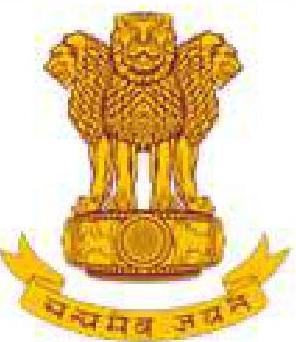
24th National e-Governance Conference, 2022 Jointly organised by
Department of Administrative Reforms & Public Grievances (DARPG), Ministry of Personnel, Public Grievances \& Pensions, Government of India
Government of
Telangana
Ministry of Electronics And Information Technology (MeitY), Government of India
HYDERABAD DECLARATION
India’s Techade: Digital Governance in a Post Pandemic World
7-8 January 2022
Hyderabad, Telangana
Hyderabad Declaration
The Department of Administrative Reforms & Public Grievances (DAPRG), Ministry of Personnel, Public Grievances \& Pensions and Ministry of Electronics \& Information Technology (MeitY), Government of India in collaboration with the Government of Telangana organized the 24th National Conference one-Governance at Hyderabad during 7th-8th January 2022.
Under the visionary leadership of the Prime Minister, thee-Governance landscape of India has radically changed in scale, scope and learning paradigms. As India celebrates 75th year of Independence as Azaadi ka Amrit Mahotsav, the Prime Minister’s clarion call for adoption of Next Generation Administrative Reforms for bringing citizens and government closer was the focus of the Conference deliberations. Secretariat Reforms, Swachhta Campaign, Redressal of Public Grievances and Improving Service Delivery which form the core of India’s good governance model were deliberated. During the pandemic, the widespread adoption of e-Office helped create paperless offices in the central secretariat and enabled smooth governance functioning. CPGRAMS helped redress 20 lac public grievances in 2021. The National eGovernance Awards were conferred in the Inaugural Session. The Two-day Conference held exchanges of views between the Award winners and Unicorns.
The Conference has unanimously adopted the Hyderabad Declaration outlined below after intensive deliberations during the sessions held over two days.
The Conference resolved that Government of India and State Governments shall collaborate to:
- To bring citizens and government closer through digital platforms.
- Transform citizen services through use of technology by leveraging the artifacts of India Stack that include Aadhaar, UPI, DigiLocker, UMANG, eSign and consent framework.
- Fast track the implementation of the national level public digital platforms in key social sectors viz. Health, Education, Agriculture, etc by adopting open interoperable architecture for joined up connected services.
- Operationalize the data governance framework to facilitate data sharing within Government entities as also make available all data on data.gov.in except for a negative list. Enable protocols for data collection, data harvesting, data privacy, data anonymization, data security, and data preservation that can help build a data economy.
- Foster responsible use of emerging technology such as Artificial Intelligence, Machine Learning, Block chain, 5G, Augmented Reality, Virtual Reality, etc for Social Empowerment
- Make India the global hub for emerging technology through creation of large pool of skilled resources on futuristic technologies.
- Ensure resilient Government Infrastructure with robust technological solutions to with stand pandemic like disruptions.
- Foster a spirit of research and development and process re engineering in ongoing government services.
- Uplift good governance to higher level through healthy competition among States and UTs and among Central Ministries by benchmarking services.
- NeSDA 2021 to be adopted in collaboration with MeITY for improvingeGovernance landscape.
- Integration of all State/District portals with CPGRAMS for seamless Redressal of Public Grievances
- Replication of awarded projects under National Awards for e-Governance 2020 – 21 and their nomination for dissemination of best practices through Regional conferences.
- Adoption of e-office version 7.0 in all ministries and departments.
- Use technology for propagating end to end service delivery without human
interference to the citizen at the grassroot level. - Make “digital” the primary aspect of government service design and delivery and provide requisite infrastructure to achieve that.
Annexure – VI
ORGANIZATION CHART OF DEPARTMENT OF ADMINISTRATIVE REFORMS AND PUBLIC GRIEVANCES
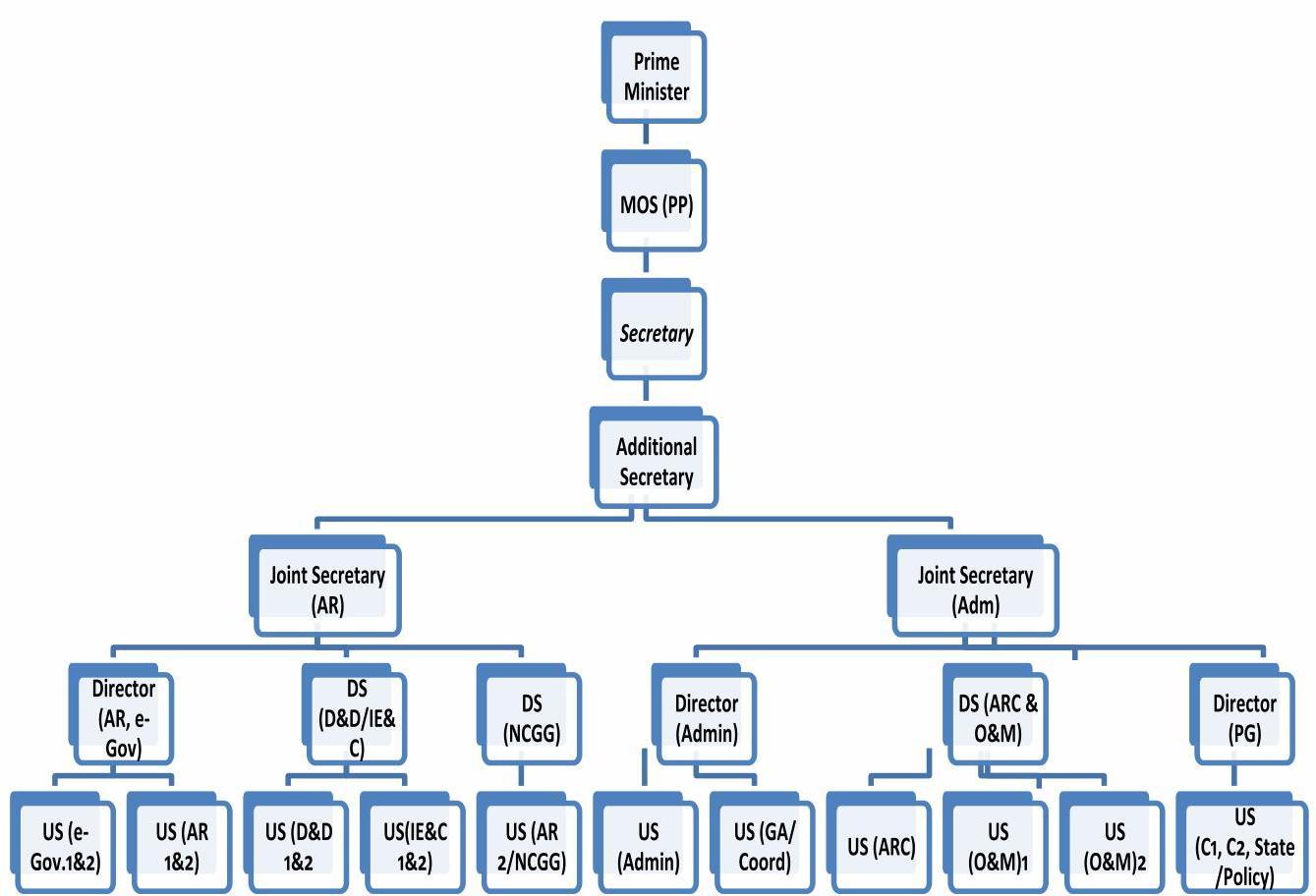
Annexure – VII
Department of Administrative Reforms and Public Grievances
Incumbency Position of Under Secretary and above level Officers in D/o AR&PG as on 31.12.2021
| Post | Name of Incumbent |
|---|---|
| Secretary | Shri V. Srinivas |
| Additional Secretary | |
| Joint Secretary | 1. Ms. Jaya Dubey 2. Shri NBS Rajput |
| Director | 1. Shri Narendra Kumar Meena 2. Shri Satish Kerba Jadhav |
| Deputy Secretary | 1. Smt. Renu Arora 2. Smt. Prisca Mathew 3. Shri Ajit Kumar Sah 4. Shri Sandesh Saxena |
| Sr. PPS | 1. Shri M P Varadharajan |
| Under Secretary | 1. Shri Balbir Singh 2. Shri Dharam Pal Arora 3. Smt. Sunila Bagga 4. Smt. Sarita Taneja 5. Shri Tirth Ram 6. Shri Sanjeev Shrivastava 7. Shri Khamchin Naulak 8. Shri Gya Prasad 9. Smt. Vibhuti Panjiyar 10. Shri Kamal Kumar Thakur 11. Shri Rakesh Chandra 12. Shri Sunil Kumar Singh 13. Shri Santosh Kumar 14. Smt. Namrata Kumari 15. Shri Ravi Kosuri 16. Shri Pramod Bhardwaj |
| PPS | Shri Sudhir |
Annexure-VIII
Department of Administrative Reforms and Public Grievances
Prevention of sexual harassment of women at work place
An Internal Complaint Committee has been constituted in Department of Administrative Reforms and Public Grievances for prevention of sexual harassment of women at work place comprising of following members:
(i) Ms. Jaya Dubey, Joint Secretary – Chairperson
(ii) Shri Ajit Kumar Sah, Deputy Secretary – Member
(iii) Ms. Vibhuti Panjiyar, Under Secretary – Member
(iv) Dr. Sonajharia Minz, representative sponsored by YWCA – Member
Women employees are being made aware of existence of said Committee from time to time through circulars, display on notice boards and interactions. A meeting of the Internal Complaints Committee was held on 20.04.2021. Many employees of the Department also attended an online workshop on Sexual Harassment of Women at Workplace to commemorate the Day of notification of Sexual Harassment of Women at Workplace (Prevention, Prohibition and Redressal), Act 2013 organized by DOPT on 09.12.2021. No complaint of sexual harassment from any of the women employees has been received during the year.
Department of Administrative Reforms and Public Grievances
Welfare of SC, ST, OBC and Persons with Disability (PWD)
As on 31.12.2021, the incumbency position of SC, ST, OBC and Persons with Disability (PWD) in the Group A, B and C category of officials of Department of Administrative Reforms and Public Grievances is as under:
| Category | Total | SC | ST | OBC | PWD |
|---|---|---|---|---|---|
| Group – A | 25 | 3 | 3 | 6 | — |
| Group – B | 31 | 2 | 1 | 7 | 1(OH) 1(OH) |
| Group – C | 15 | 4 | – | 3 | 1(OH) |
| Total | 71 | 9 | 4 | 16 | 3 |
The Department has appointed a Nodal Officer to look into the complaints/ representations, if any, received from SC, ST and OBC officials and as also to watch their welfare.
Department of Pension and Pensioner’s Welfare ORGANISATIONAL CHART
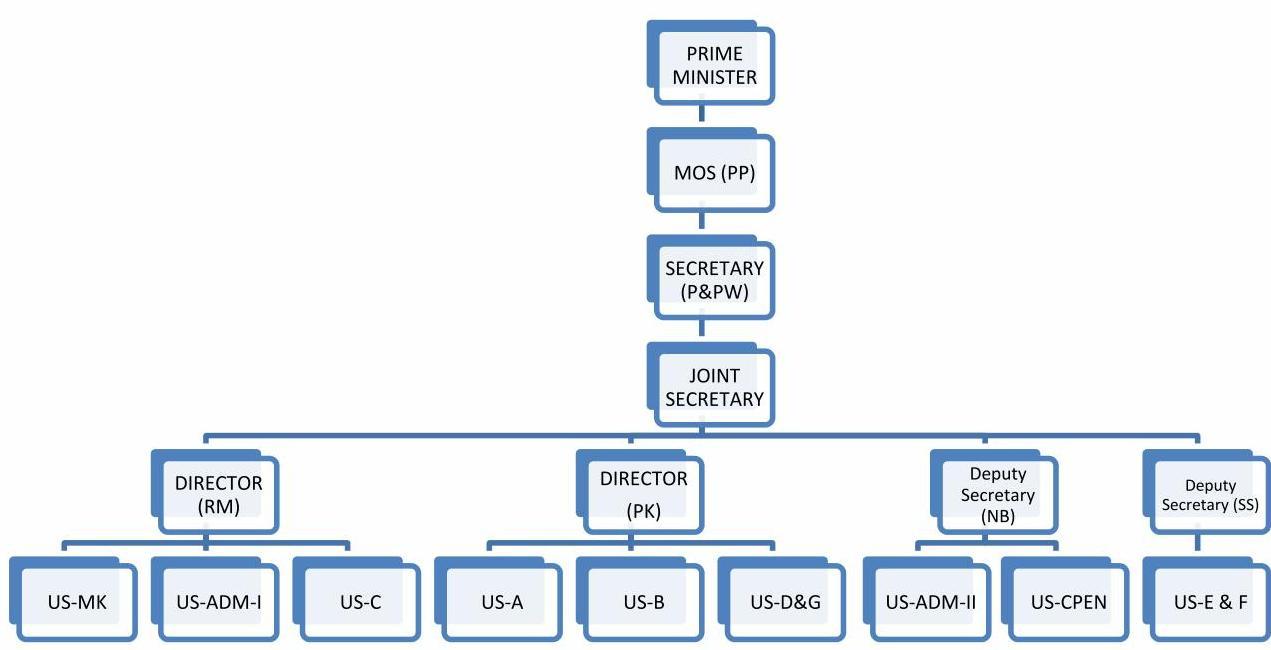
Incumbency position of Officers
Annexure-XI in D/o Pension & Pensioner’s Welfare as on 31/03/2022
| Post | Name of the Incumbent |
|---|---|
| Secretary | Shri V. Srinivas |
| Joint Secretary | Shri Sanjiv Narain Mathur |
| Director | Shri Ruchir Mittal Shri Pramod Kumar |
| Deputy Secretary | Shri Naresh Bhardwaj Shri Sanjoy Shankar |
| Under Secretary | Shri Ramesh Chandra Sethi Shri Charanjit Taneja Shri Manoj Kumar Shri S. Chakrabarti Shri Ashok Kumar Singh Shri Rajendra Kumar Dutta Shri Subhash Chander Shri Rajesh Kumar Shri Dhananjay Prasad Singh |
| Assistant Director(OL) | Ms Manju Gupta |
| Section Officers | Shri Vishal Kumar Shri Hemant Shri Deepak Gupta |
.
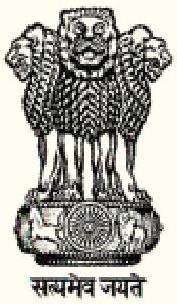
Ministry of Personnel, Public Grievances and Pensions Government of India
-
- Mandatory objectives